
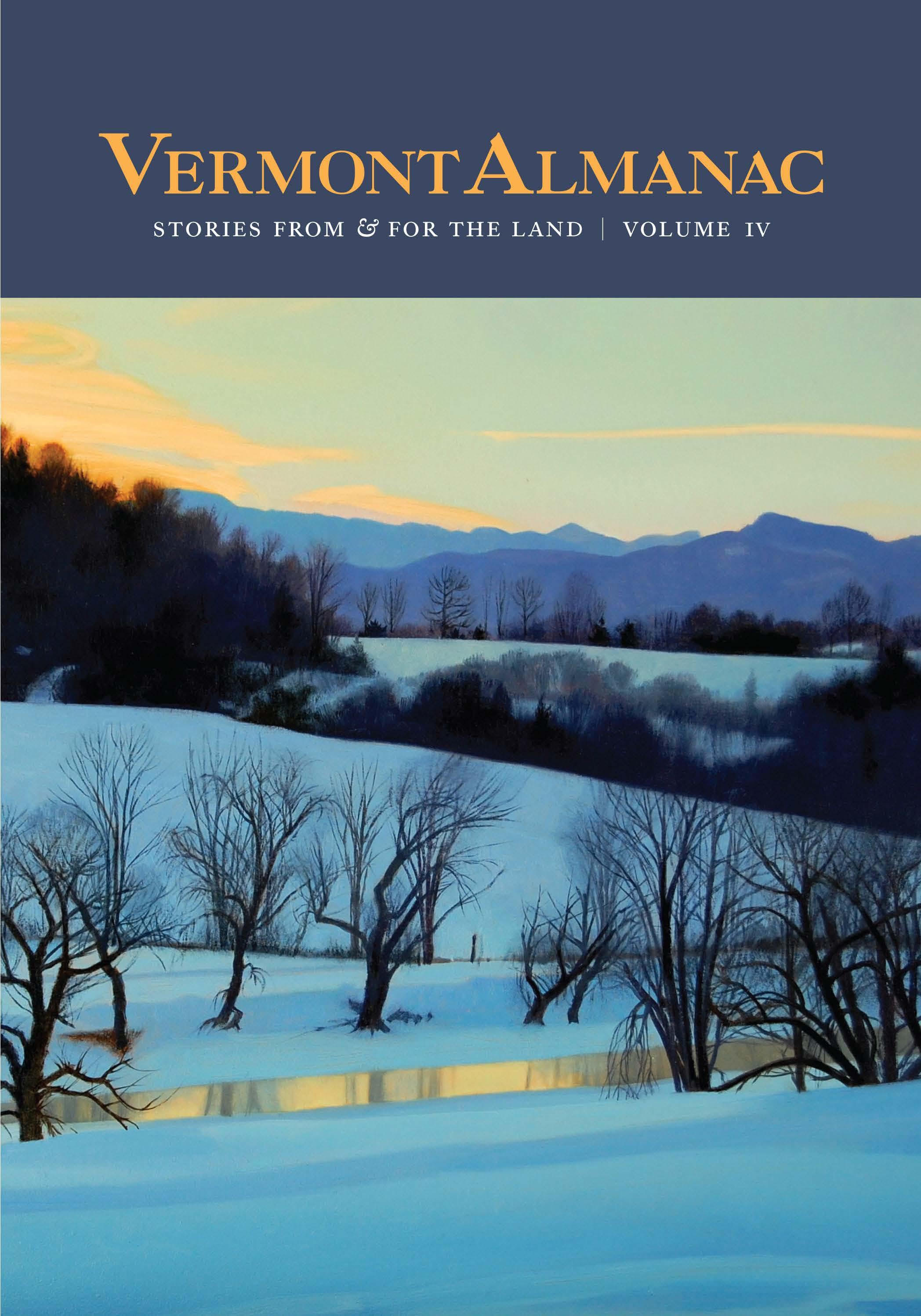

Tis time, like all times, is a very good one if we but know what to do with it.
RALPH WALDO EMERSON
WE ARE :
Sugarmaker & Editor
DAVE MANCE III
Christmas Tree Grower & Editor
PATRICK WHITE
Business Manager
AMY PEBERDY
Designer
LISA CADIEUX / LIQUID STUDIO
FOR THE LAND PUBLISHING BOARD OF DIRECTORS
Marjorie Ryerson, President
Trevor Mance, Vice President
Chuck Wooster, Secretary
Kate Whelley McCabe
Lora Marchand
Jack Michael
Very special thanks to Virginia Barlow and Brett Ann Stanciu, whose fngerprints are all over this book.
BEHIND THE SCENES
John Douglas, Chris Doyle, Marian Cawley, Giom, John K. Tiholiz, Tamara White
Volume iv: Copyright 2023 For the Land Publishing, Inc., PO Box 514, Corinth, Vermont 05039 For purchase inquiries, or to sponsor our work, please contact amy@vermontalmanac.org. Direct all editorial correspondence to dave@vermontalmanac.org.
For the Land Publishing, Inc., is a 501 (c) (3) public beneft educational organization. Printed in Milton, Vermont.
COVER PAINTING
Kathleen Kolb
Te beauty of snow, what it does to how we see the landscape, is really moving to me. Snow simplifes what we see by hiding so many smaller things, reducing them to soft bumps of blue or white. In this way it gets us closer to the essential, the transcendent, which is my goal in making all my work. Painting snow involves working with a lot of blue, perhaps my favorite color, but I also love the challenge of looking deeply into snow to see what colors are there in addition to white and blue. Tere is so much there to see and appreciate!
MONTHLY PAINTINGS
Mary Simpson
I make relief prints using blocks of vinyl and linoleum that are carved, inked, then pressed onto paper. Tis manual method of creating pictures suits me. I grew up on a family dairy farm with plenty of people and animals and enough work to go around. It was a hands-on life, and I am still doing it by creating these rural tributes, block by block.
WWW
. VERMONTALMANAC . ORG

CHAD ABRAMOVICH is a native

MICHELLE ACCIAVATTI , MS, is a nationally recognized natural deathcare worker and educator who operates Vermont Forest Cemetery and Green Mountain Funeral Alternatives with her husband and partner, Paul. She lives in Montpelier and her spare time is spent outdoors.
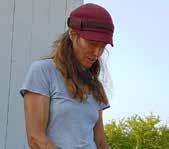
HEIDI ALBRIGHT grew up in southern Vermont as a free-range kid. After earning a master’s degree in Biology from UVM, she became a farmer-artist in the mountains of central Vermont with her family. She can be found outside in all types of weather.
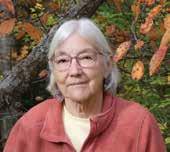

JOYCE AMSDEN is a homesteader, therapeutic horticulturist, and UVM Extension Master Gardener. While working the Central Vermont subsistence farm where she was raised, she teaches homesteading skills and presents nurturing and restorative nature-based activities.
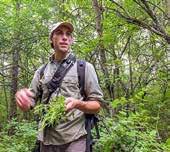
SEAN BECKETT is the Program Director at North Branch Nature Center where he arranges and leads nature-based outings and classes ranging from birding to geology to naturalist adventures abroad. For more about NBNC’s programs, visit northbranchnaturecenter.org.
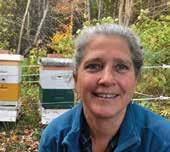
TANIA AEBI lives in Corinth and is excited about having had one bee hive survive two winters and going into its third. She is very attached to the bees and their honey and hopes they’ll stick around for many more winters. And summers, falls, and springs.

BETZY BANCROFT has been learning, teaching, and practicing herbal medicine for decades, notably cofounding and serving as a faculty member of the Vermont Center for Integrative Herbalism. Besides the forest, her favorite place to be is her kitchen.

JANE BROWN grew up on a farm in Cabot and has co-authored an oral history titled Cabot, Vermont, Memories of the Century Past, and West Danville, Vermont, Ten and Now, 1721-2021. She publishes a popular blog, Joe’s Pond Refections.
stories from & for the land 3
Vermonter, local weird worker, photographer, raconteur, and explorer.
VIRGINIA BARLOW has worked as a forester, writer, and editor in Corinth, Vermont.
contributors

LISA CADIEUX was born and raised in Swanton and spent her childhood in the woods creating imaginary wildlife habitats. As an adult, her creative work includes book design, interior design, metalsmithing, and cooking.
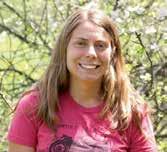
DR . HEATHER DARBY is a Professor of Agronomy at the University of Vermont. She has been conducting outreach and research on industrial hemp since 2016. More information about Dr. Darby’s research can be found at www.uvm.edu/extension/nwcrops.

H .
a

LUCY CLARK is a full-time stay-athome-mom and a part-time freelance writer. A former editor at EatingWell magazine, she has a passion for writing about food and farming.

JANE DORNEY is a geographer and writer who does project-based work on Vermont’s cultural landscape patterns and their connections to the natural landscape. She also writes a newspaper column called Connect the Dots for the Vermont Community Newspaper Group.
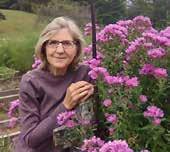

and science communicator. She teaches at Williams College and lives in Bennington.

BILL DRISLANE is a board member of Sundog Poetry, lives in Jericho, earns a livelihood in his solo law practice, and enjoys and works with people, and the mix of words, song, and the natural world.

MEGAN DURLING is the head of school and a liberal arts and sciences teacher at East Burke School. When not exploring great books and the great outdoors with her students, she enjoys spending time with her family at home in Newark.
4 vermont almanac | volume 1 v contributors
KERRY DEWOLFE is an almost retired attorney who lives in Corinth with her partner Fritz, Border Terrier Elsie, horses, chickens and accordions.
STEPHEN
DEVOTO is
Dutch American, he was a scientist, and is now a farmer. He and his wife Joyce are restoring a diversifed farm in Corinth.
PHOEBE A . COHEN is a paleontologist

MELANIE FINN is the author of four novels including Te Hare, winner of the Vermont Book Award. She lives in Kirby, with her family, various animals, and mismatched socks.
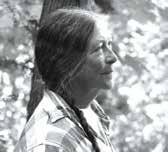
SHIRLY HOOK grew up on West Hill in Chelsea. She’s a citizen of the Koasek Traditional Band of the Koas Abenaki Nation and serves on the Council of Chiefs. Her frst book, called My Bring Up, was published in 2020
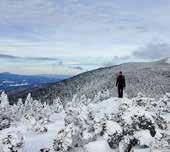
ROWAN JACOBSEN is the author of nine books on nature, agriculture, and ecology, including Fruitless Fall and Apples of Uncommon Character. He lives in Calais.

LAURA HARDIE is a marketing and communications professional and owns a business called Te Red Barn Writer. Specializing in food and agriculture, she provides copywriting and content strategy to her clients and has a lavender farm in Waterbury.

JIM HORST grew up on a dairy farm in Bennington and has been planting Christmas trees for more than 50 years. For the past 23 years, he has also served as executive director of the NH-VT Christmas Tree Association.

Born in Bennington and raised in Manchester, PHILIP R . JORDAN is the retired editor of Vermont Magazine and lives with his wife Edie in a quirky old schoolhouse in Sunderland. His crime novel, As Crooked as Tey Come, was published in 2021.
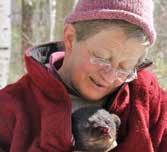
MARY HOLLAND is a naturalist/ environmental educator/writer/ nature photographer. She spends much of her time with her lab Greta looking for interesting fnds to photograph and put on her Naturally Curious blog.

MARK ISSELHARDT leads the UVM Extension Maple Program and is based out of the Proctor Maple Research Center. He draws on degrees in forest management, plant biology, and 26 years of experience in maple to provide research-based education.

STEVE JOSLIN is a Waitsfeld native and a UVM graduate (class of 1965). He’s been a Sergeant in the US Army, based in Germany, and a claims manager for Vermont Mutual.
stories from & for the land 5 contributors
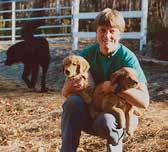
NATALIE KINSEY is the author of 21 children’s books, and is currently working on 2 books about Amanda, one a historical novel, and the other a non-fction account of her life. Natalie lives in Vermont’s Northeast Kingdom.

Te author of the best-seller, In the Fall, and fve other novels, JEFFREY LENT was raised in Vermont and New York State on small dairy and sheep farms, powered by draft horses. He lives in central Vermont with his wife Marion.

DAVE MANCE III learned to love the natural world through hunting, fshing, trapping, logging, sugaring, gardening – through the pursuits and the associated mentors. Now he’s trying to pay it forward.

PHILIP LAMY , Ph.D., is a professor of sociology and anthropology and the Director of the Cannabis Studies Certifcate Program at Vermont State University, Castleton.

DEBORAH LEE LUSKIN hunts and writes in southern Vermont and blogs about Living in Place. Learn more at www.deborahleeluskin.com

KERRIN MCCADDEN received the 2022 Herb Lockwood Prize in the Arts and is the author of the poetry collection American Wake (Black Sparrow Press, 2021), a fnalist for the New England Book Award. She teaches at Te Center for Technology and lives in South Burlington.
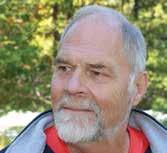
SYDNEY LEA , author of 23 books, is the 2021 recipient of Vermont’s Governor’s Award for Excellence in the Arts. A Pulitzer fnalist and winner of the Poet’s Prize, he was the founding editor of New England Review and Vermont’s Poet Laureate from 2011 to 2015

CHARLOTTE LYONS (House Wren Studio) is a textile artist and teacher inspired by the humble simplicity of traditional art and craft and the inventive use of repurposed materials.
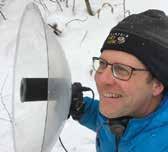
A co-founder of the Vermont Center for Ecostudies, KENT MCFARLAND is a conservation biologist, photographer, writer, and naturalist.
6 vermont almanac | volume 1 v contributors

SARAH MERRIMAN is the elected Town Clerk of Middlesex, as well as an author (under the name Sarah Strohmeyer) of mysteries published by HarperCollins.

BRYAN PFEIFFER is a writer, educator, and consulting feld naturalist specializing in birds and insects. He lives with his partner Ruth and their English shepherd Odin on a hillside in Montpelier. www.bryanpfeifer.com.

SEAN PRENTISS is a poet and memoirist who lives with his wife and daughter on a lake in northern Vermont. His books include Finding Abbey and Crosscut: Poems www.seanprentiss.com

MARGOT PAGE is the author of several non-fction books and a former contributor to Te New York Times and other national publications. For nearly 40 years,

OLIVIA PIEPMEIER used to be a librarian but now she’s an artist (and she uses those other skills quite often). She is delighted to live somewhere that values and celebrates art, food, land, and community.
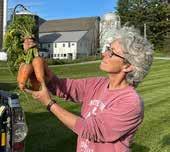
MARIA BUTEUX READE spent 27 years as a boarding school teacher and then became a writer, farmer, and cook. She serves as managing editor of Edible Vermont magazine. Maria lives along the Battenkill River with her artist husband, Ned.

CAROLYN W . PARTRIDGE served in the Vermont Legislature for 24 years. She is a self-employed farmer, seamstress, and a Windham County Assistant Judge. She is a Windham Regional Commissioner and a member of the Windham Community Organization.

VERANDAH PORCHE is a cultural worker: poet, songwriter, mentor, scribe, and selectboard member, based in Guilford. Hear songs and poems on www.patreon. com/pattyandverandah and verandahporche.com. A new album is in the works.

CHELSEA CLARKE SAWYER is an artist and naturalist, and the Communications Coordinator at North Branch Nature Center. She holds a master’s degree from the University of Vermont’s Field Naturalist Program and a bachelor’s degree from Maine College of Art.
stories from & for the land 7 contributors

JODY SCHADE is a devoted gardener and canner with more than 25 years practice. She works as a landscaper in the Northeast Kingdom and lives in Barton.

BRETT ANN STANCIU is the author of Unstitched: My Journey to Understand Opioid Addiction and How People and Communities Can Heal and Hidden View. Her writing has appeared in many publications. She lives in Hardwick.

ALLAN THOMPSON is the President of Vermont Woodlands Association, a Vermont licensed consulting forester, and certifed wildlife biologist.

SARAH SHAW is the co-owner and co-president of Hillside Botanicals, a certifed organic medicinal herb farm and apothecary in West Brookfeld. She is a clinical herbalist and educator and works as a consultant in the natural products industry.

DON STEVENS is Chief of the Nulhegan Band of the CoosukAbenaki Nation. He helped obtain legal recognition, acquire land, and federal settlement agreements for the Abenaki People. Don served in the US Army and holds several Honorary Doctorate Degrees.

LIZ THOMPSON is an ecologist with an abiding passion for wild places, plants, and patterns in nature. With Eric Sorenson and Bob Zaino, she wrote Wetland, Woodland, Wildland: A Guide to the Natural Communities of Vermont

After more than three decades as part-timers, JON STABLEFORD and his wife moved into their South Straford home in 2010 as permanent residents. He is a retired teacher.

LAURA SULLIVAN is a fber artist and farmer living and working in Vermont. She will be pursuing hemp fber research further this winter as she embarks on her MFA degree at Vermont College of Fine Art.
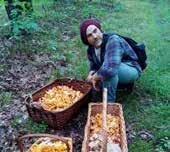
IAN VAIR sells mushrooms and tinctures at farmer’s markets and through his website (greenmountainfungi.com), leads mushroom foraging workshops, and gives lectures. Tose in the Rutland area probably know him from his local cable-television cooking show.
8 vermont almanac | volume 1 v contributors

THOMAS DURANT VISSER has worked with historic barns since he was a teenager. A professor at the University of Vermont History Department and Historic Preservation Program, he is the author of Field Guide to New England Barns and Farm Buildings

MIKE WHITE lives in Bennington County, is a licensed forester, and helps manage a cross country ski area.

JOAN WALTERMIRE was in her frst of many years as Curator of Exhibits at the Montshire Museum of Science when she wrote her most important poem – about opossum reproduction. Tis attracted her longtime mate. Tey live in Vershire.

WHITE is currently teaching himself how to weld. He is proving to be a poor teacher.
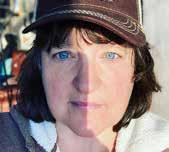
JESS WEITZ is a multidisciplinary artist and writer living on a mountain, in a feld, in Marlboro, Vermont. She facilitates art and meditation classes and can be contacted through www.jessweitz.com
stories from & for the land 9 contributors
PATRICK
October 2022 - September 2023
In some traditional cultures, the year begins with the harvest. Larders are full; things are at their peak in the natural world. Next comes seven months of decline, and then fve months of renewal. Vermont Almanac marks a year’s time in the same manner.
contrib utors 3
preamble 11
october 13
november 39
december 61
january 85
february 107
march 133
april 155
may 177
june 199
july 221
august 245
september 267
A content index of the many people, places, and topics covered in Volume I, Volume II , and Volume III is avilable online at vermontalmanac.org. A similar index for Volume IV is in the works.
10 vermont almanac | volume 1 v
Among other things, this book is a celebration of rural culture. Tat word, culture, is often employed in an empty way, its power diminished by overuse in a million non-proft fundraising letters. Other times, culture is wielded sharply, as in the “culture wars.” Tere can be a jingoistic tint to it all: Are you in or out? Whose side are you on?
Tis baggage trailing an otherwise deeply meaningful word suggests a need for us to clarify: What, specifcally, are some of the elements of rural culture worth celebrating?
A culture of doing, for one. Of self sufciency. Each fall we celebrate turning wood into fuel, and plants and animals into nourishment for the winter months ahead. Tese natural rhythms carry over into the next season and then the next – around and around. Te repetition is key, as the high calling of culture comes from long-nurtured habits. Lots of cultures celebrate doing. Tech culture is racing madly to put a new iPhone in your pocket and develop a machine that makes thinking obsolete. Urban culture builds and then tears down and then builds again, monuments to and of a human-centered existence. Te doing in rural culture, on the other hand, is closely linked to the natural world. And those of us who appreciate this are endlessly grateful for the connection.
Te rural culture worth celebrating is a free-thinking one. Tere’s a story about a Vermont teacher from the 1950s on page 166, told through the words of his students 70 years later. Te teacher was a young idealist from away, a man “who pursued what pleased him;” the students were rural Vermonters in the tiny town of Guilford who, as their reminiscences bare out, pursued what pleased them. Who were the free thinkers in the story – the teacher who followed his dreams and ideals to Vermont, or the provincial kids who would go on to spend their entire lives in a tiny town, ignoring the “Oh the Places You’ll Go” commencement speeches and the push to uproot, earn, and consume? Tey all were. And this free-thinking spirit goes hand in hand with Vermont’s spirit of live and let live, which people here are rightly proud of.
Te rural culture that’s worth celebrating is generous, which was clearly seen this summer when parts of the state were decimated by food waters and neighbors dropped everything to pitch in. We see it in the way people are proud to support local businesses. We see it in a million little transfers of knowledge about our Vermont ecosystems – both human and natural – from person to person, from generation to generation. Te self-sufciency described above does not come at the expense of community.
Tis book exists because its contributors are driven to dig in – sometimes fguratively and sometimes with a tool in hand. It exists because our free-thinking readers are drawn to our subject matter and are willing to pay for home-grown content. It exists because of the generosity of these contributors, as well as our readers, and sponsors, and donors. Tank you all.
stories from & for the land 11
PREAMBLE
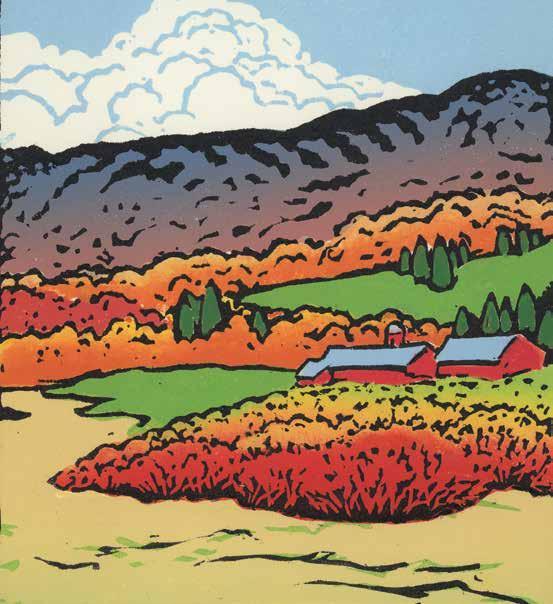
OCTOBER
stories from & for the land 13

For the past 45 years, years, Lyman Orton, best known as the proprietor of the Vermont Country Store, has been collecting Vermont artwork. Tis year, the Bennington Museum and Southern Vermont Arts Center staged a joint art exhibition and displayed over 200 pieces from his collection, including this oil painting by John Lillie (1867-1942), a mason, builder, farmer, and self-taught painter from Dorset. You’ll fnd other pieces from the collection scattered throughout the book.
14 vermont almanac | volume 1 v october
BLUE AND GOLD ( 1915 )
OF THE LYMAN ORTON COLLECTION OF THE ART OF VERMONT
COURTESY
THE YELLOW LEAF
Tis morning races in, low clouds fying, leaves scattering to the wings where just yesterday in quiet light the gold and burnt oranges, the burnished greens, were all in company draped in a broad October stillness like a curtain behind a stage.
Te players had come out, a mechanic in his yard, a young man and woman staring at their pickup’s broken gate, a neighbor hauling out her horse’s bale of hay, a man walking the narrow shoulder of the road, a pair of cyclists abreast, talking, all intent in their myriad of purpose below a sun flled sky and a quiet proscenium of colors.
But, look now – one from among them returns today, kneeling in this wildness of wind, holding back her hair as she would like it, to reach for a yellow leaf October just blew into the brindled grasses.
—Bill Drislane
stories from & for the land 15
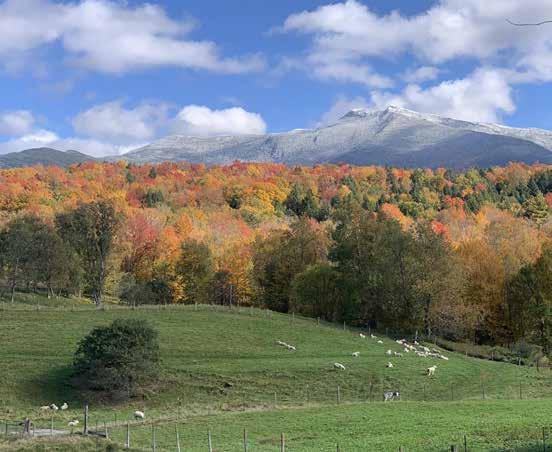
RLargely Lovely
According to the National Weather Service, the average frst frost date for Montpelier between 1991 and 2020 was October 3. In 2022, the frst frost in Montpelier occurred on October 3. After a year that featured an ice storm and notable drought, a year where a third of the months featured heat that ranked among the top ten warmest ever, there was something reassuring in that mundane glimpse of “normal.”
Te by-the-book weather continued through the frst part of the month – it was October in Vermont as you might see it in a movie. A beautiful stretch of seasonal weather culminated in parts of the Green Mountains on Columbus Day weekend in a snowliage event – that rare occurrence when the valleys are at peak foliage and the mountains covered in fresh snow.
Te state monitors fall color on Mount Mansfeld at three elevations, and peak color at 2,600 feet
16 vermont almanac | volume 1 v october
WEATHER
MATT
SUTKOSKI
Matt Sutkoski captured this beautiful shot of “snowliage” on October 8, 2022.
was slightly earlier than the long-term average, but similar to the long-term average at other elevations (1,400 feet and 2,200 feet). Maples at every elevation dropped their leaves slightly earlier than usual. Tings started to trend warmer than normal towards the end of the month. Te last week of the month featured record highs – on the 25th it was 78 degrees in Burlington and 70 in Saint Johnsbury. Te nighttime low temperature in Montpelier – 62 – was 9 degrees warmer than the previous record. Dew points during the warm spell were in the 60s, which is August-like. Trappers who wandered afeld on the fourth Saturday of the month – the traditional season opener – were in t-shirts by mid-morning. And gardeners hoped their garlic bulbs wouldn’t be tricked into sprouting as they tucked them into
garden beds for the winter. Te warmth extended through Halloween and into early November. When all was said and done, the monthly average was 2.8 degrees warmer than the 20th century average and 1 2 degrees above the 21st century average. We’re relying on data from the National Oceanic and Atmospheric Information Center for our temperature averages this year. One of the cool things about their data set (nClimDiv, which is based on the Global Historical Climatological Network Daily database) is that it provides us a glimpse of both recent temperature averages and a 128-year average covering the entire 20th century. Most of the averages you hear reported by meteorologists are 30year averages, which underreports how dramatically things have changed since our grandparents’ day.
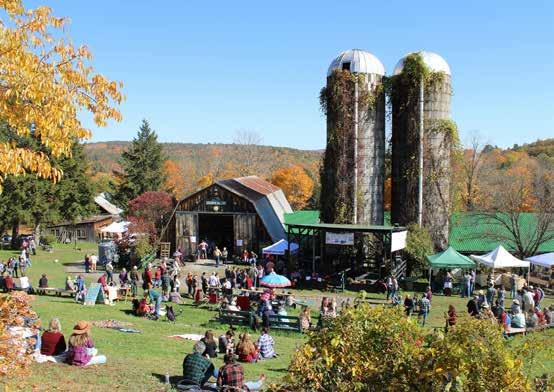
October 15, 2022: Te weather for the Southern Vermont Flannel Festival at Rockingham Hill Farm in Bellows Falls was more crispy than crisp. Will we need fannel t-shirts in the future?
We looked back at our weather summaries from the past three volumes of Vermont Almanac and saw that October 2021 was the fourth-warmest October on record and was signifcantly wetter than normal. October 2020 was a relatively average month for both temperature and precipitation. October 201 9 was exceedingly wet, with 8 5 inches of rain recorded in Burlington. Statewide, it was the sixth-wettest month on record.
stories from & for the land 17 ROCKINGHAM HILL FARM
EVER WONDERED WHAT AN UNDERGROUND YELLOW JACKETS NEST LOOKS LIKE ? Here’s one we dug out of the backyard once a killing frost had killed the wasps. Female wasps create the paper by chewing up dead wood and plant stems and mixing it with their saliva to make pulp.
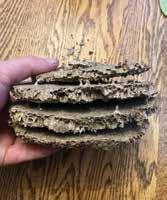
WHILE VERMONT IS NOT KNOWN for its charismatic fossils, they do exist. Fly-fshing guide Emily Murphy found this one along a creek in Bennington County in October 2022 – it’s an olenellid trilobite, which is probably more than 500 million years old.
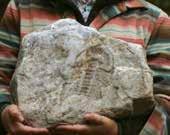
eAsters Change Colors
For a diferent fall color show, take a close look at the fowers of New England aster when the plant is in bloom in late fall. Te fowers have violet-purple to pink “petals” (really sterile fowers), and contrasting central disks made up of fertile fowers. Tis is where the real business happens – where pollination results in the production of fruits and seeds. Some fowers in the disk are yellow, but in others the disk may be purple or a mix of both colors… Has something gone awry here?
Not at all.
Each disk fower changes color from yellow to reddish when it is pollinated, a change that leads to greater success for both the fower and for its visitors. Pollinators, especially visual animals like insects and birds, have learned to read the color change as a signal that a fower has already been visited and given up its nectar or pollen. Tey avoid these fowers, saving time and energy by concentrating on fowers with a greater reward. Tis also benefts the plants through more efcient pollinator visits.
—Joan Waltermire
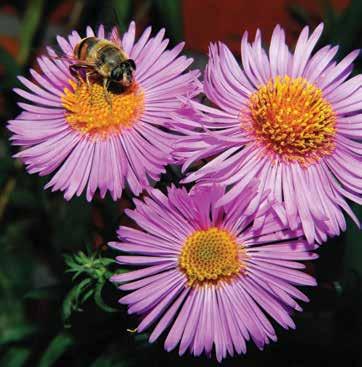
18 vermont almanac | volume 1 v october NATURE NOTES
HOWARD WEISS-TISMAN

Crowd-sourcing
On Oct. 12, 2022, photographer Craig Hunt took a series of photographs of a peregrine falcon in Brattleboro, which he later posted on Vermont iNaturalist. Hunt noted that the bird was banded, but couldn’t make out the number. Sharpeyed viewers helped inspect the bands and narrowed down a possible number; they also shared that the placement of color bands on the left leg indicated that this bird was a female, and the combination of black over green color bands indicated that this was a bird banded in eastern North America. Craig sent this info, along with the photos, to the USGS Bird Banding Lab and learned that this peregrine falcon was banded as a hatchling alongside three siblings in Lewiston, Maine – roughly 200 miles away – in May of 2021. Te lab even sent a picture from the Maine Department of Inland Fisheries and Wildlife of the same peregrine falcon on the day she was banded.
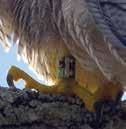
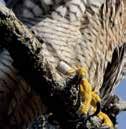
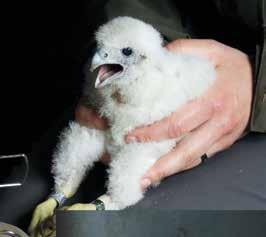
stories from & for the land 19 MAINE DIFW CRAIG HUNT CRAIG HUNT
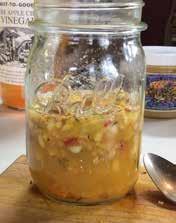
BETZY ’ S RECIPE FOR FIRE CIDER Fill a wide-mouth quart canning jar about halfway with chopped onion, garlic, ginger, horseradish root, and chili peppers, in whatever proportion you like and have on hand. If you’d prefer it not to be so spicy, leave out the chilies. You can also include other favorful medicinal herbs like turmeric, black pepper, rosemary, thyme, or sage leaves; mustard seeds; lemon or other citrus fruits, with peels; pine, spruce, or balsam fr needles – anything you like. Add enough apple cider vinegar to cover the herbs. Ideally there should be one to two inches of vinegar over the chopped herbs. Add a couple tablespoons of honey, and give it all a good shake or stir to mix the honey and other ingredients well. Cover the jar with a plastic or a non-metal lid (vinegar corrodes metal lids), and leave it in a warm place for a few weeks to a month, shaking occasionally. Strain out the solids using a kitchen strainer or cheesecloth, and bottle it. Enjoy!
FFire Cider
ire Cider is an oxymel, a mixture of honey and apple cider vinegar, infused with the favors and goodness of spicy herbs. Te recipe was developed from older traditional tonic recipes in the 1980s by Rosemary Gladstar, a beloved herbal elder and resident of Vermont. It’s a delicious way to get the benefts of stimulating herbs in our diet. I love to splash it on cooked greens, add it to dressings and sauces, and incorporate it into beverages like an after-ski or -snowshoe toddy. Use it like hot sauce.
If you take it by itself, the “dose” of fre cider is just a light shot –about half or a full ounce. It can be taken without diluting it, but fre cider is often mixed with water. Just be careful – fre cider can be very spicy if you include chilies, and it can be quite stimulating, making a fery person feel fushed and sweaty. Herbalists call this a diaphoretic efect – it chases of chills, colds, and some fevers by opening the pores and moving energy outward. Fire cider also improves circulation, which has many benefts, from warming chilly hands and feet to promoting better cognitive function. It also stimulates digestion and helps clear the sinuses. Te benefts will vary somewhat depending on the herbs you include in your recipe. —Betzy Bancroft
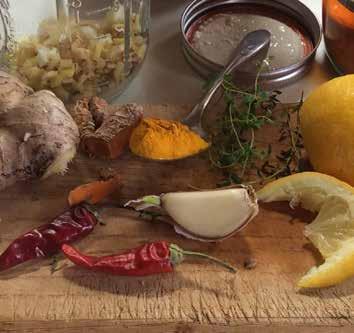
20 vermont almanac | volume 1 v october
AT HOME •
PHOTOS BY BETZY BANCROFT
Wild Cider
Well over a century ago, cider making came to be dominated by industrial production. Sameness meant greater ease in mechanized harvesting and predictability in outcome. But anyone who has made their own apple cider knows that the best apples for fresh-eating are often not the best for pressing. Simply put, perfection and homogeneity are boring. Te best cider has a complex favor, not a uniform and bland one.
Te best cider I ever had was made from wild apples by students at the brave little school where I have the pleasure of teaching. Cidering is one of East Burke School’s most beloved traditions, and the hours we spend each fall harvesting, grinding, pressing, and pasteurizing hold many lessons beyond the practical.
Our secret ingredient is variety: we get added, interesting favors by sourcing from crabapples and wild apple trees growing along Vermont’s roadways. Some of these apples are perfectly good for fresh-eating, but others are varieties that you wouldn’t necessarily choose on their own: they may be excessively tart, perhaps even bitter. But throw these into a grinder with the sweet, and you end up with a much more memorable glass of cider than you’d have if you’d stuck with a single, eminently marketable apple variety.
Making cider with wild apples serves as a reminder that we grow when we look beyond the narrow realms of our favorite things. Tat’s a lesson that can be applied to friendships, to politics, to learning in general. We need crabapples in life, just as we need them in our cider. —Megan Durling
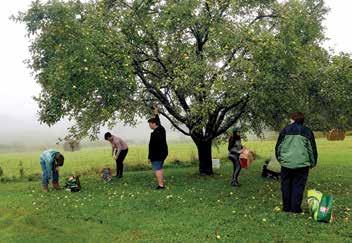


stories from & for the land 21
PHOTOS BY MEGAN
DURLING
Te Steamboat “Barnet”
In the early settlement days, towns throughout the Connecticut River Valley depended heavily on their namesake river. Te Connecticut begins as a narrow stream out of high-elevation lakes, then after some meandering fows south along the 238mile border of Vermont and New Hampshire. It is reinforced by tributaries and becomes a broad, swift river by the time it empties into Long Island Sound, some 400 miles south.
Only a few hundred residents lived along the river north of the Massachusetts border in the 1760s, and river trafc was mostly Native Americans or trappers with canoes or dugouts loaded with animal hides and furs. However, by 1791, about 44,000 people lived in the Vermont counties of Windham, Windsor, and Orange on the west side of the river, and at least twice that many east of the river in New Hampshire. All of them needed better transportation methods than dugouts and canoes.
To meet this need, fatboats were built, typically 70-75 feet long and 12-14 feet wide. Fully loaded, they could carry some 30 tons and drew only about 12-18 inches of water, making them perfectly adapted for travel into the shallow reaches of the upper Connecticut River. According to Lyman Hayes, who wrote a detailed history of the Connecticut River in the early 20th century, the river was navigable as far north as Wells River in the early 1800s.
Flatboats depended on either wind or manpower. Most had a tall mast in the middle of the deck with one large sail and six men (three men working on either side) with poles that were about 20 feet long with a spike on one end. Te men planted the spiked end of the poles on the river bottom, placed the other end against their shoulder, and walked towards the stern of the boat, moving the boat ahead. Each man would then return forward in a constant rotation, often for long hours at a stretch and in all kinds of
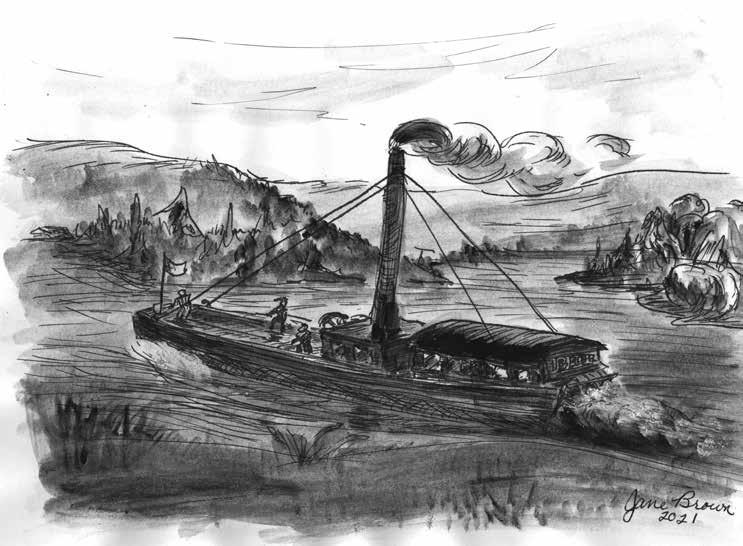
22 vermont almanac | volume 1 v october
A
•
LOOK BACK
weather. A pilot who knew the river well guided the boat with a rudder that was operated from the roof of a cabin at the rear of the boat.
At falls and rapids along the Vermont/New Hampshire route, cargo had to be unloaded and transported overland by teams of oxen or horses to boats on the other side of trouble spots. Between 1800 and 1829, canals or locks were built around these hindrances. Te improvements made of-loading cargo unnecessary, which substantially reduced the cost and efciency of transporting goods.
Even with the canals, navigation was still difcult. Te riverbed changed with every rainstorm, and after spring runof, previously unseen boulders and new sandbars appeared. Dry years and foods added to the ever-changing conditions that challenged even the most experienced riverboat pilots.
In the early 1800s, there were opposing views about how best to transport goods to the northern region’s growing towns. One proposed solution was to build canals and locks to connect major lakes and streams throughout Vermont. Tese people were called Canalites. Tey explored possibilities for a series of canals to connect Lake Champlain on Vermont’s western border with the Connecticut River on the eastern border. Another group, called Riverites, felt it was better to spend money to improve the existing waterways by dredging and building locks at trouble spots.
After a bad food in 1824 took out dams and bridges, a representative group of Riverites met to discuss how to make the river more navigable. Tey raised money for dredging and canals, envisioning boats reaching as far north as the town of Barnet, north of McIndoe Falls. To prove their point, they engaged the Connecticut River Company of New York City to build a small steamboat, specially designed to navigate the rugged upper Connecticut River.
Te little steamer was 75 feet long, 14 5 feet wide, and drew 22 inches of water. It had a fat bottom and walled sides, with a cabin and a paddle wheel at the stern. Finished in 1826, the craft was named the Barnet to honor the town it was expected to reach.
On November 24, 1826, the Barnet left Hartford, Connecticut, and proceeded north. A river boat captain named Palmer took her as far as Northampton, Massachusetts, about 40 miles south of the Vermont border. From there, Captain Strong, a noted river man who knew the upper Connecticut River well, took command. When the Barnet reached “Warehouse
Point” in Brattleboro, it was greeted by bonfres and bell ringing as well-wishers followed along the riverbank in celebration. However, at the rapids called “ Te Tunnel,” the little steamer came to a standstill. Hayes described how Captain Strong pushed the boat hard until, “with fre blazing from the smoke-stack” he grabbed a spiked pole and “punch[ed] against the bed of the river,” trying to move the vessel forward himself. Strong lost his balance and tumbled into the rapids but was quickly rescued. At that point, he admitted defeat. A few days later the Barnet tried again, and that time, with the assistance of a winch, made it through.
Festivities welcomed the steamer at Bellows Falls, and Captain Strong proudly showed of her speed and power by taking a few turns around the eddy. Several dignitaries were present that day and ofcers of the Association for Improving the Connecticut River boarded the boat, along with ofcials of the steamboat company that built the Barnet. Te celebration lasted for two days, with plenty of food and many barrels of whiskey consumed. Te general merriment continued as the boat departed north, and a joyful toast was ofered: “To the town of Barnet – may she be speedily gratifed by the sight of her frst-born.”
However, it turned out that the Barnet was too large to go through the locks north of the Bellows Falls. Disappointed at the obvious error in calculations by the steamer’s designers, and some 80 miles short of its intended destination, there was nothing to do but give up the quest and return downstream. As the little steamer left, a cannon discharged 124 rounds (possibly representing the distance back to Hartford) to bid her farewell. Some 200 people followed along the banks of the river as far south as Westminster where they watched her retreat down the river. She pulled into Hartford a few days later and never sailed that far north again.
Almost exactly a year later, the Barnet came to an unfortunate end near Milford, Connecticut, when her boiler blew up and a river pilot was killed.
Te need for better transportation of freight remained, and other steamers such as the Vermont and the John Ledyard successfully plied the lower Connecticut River until the mid-1800s when locomotives were introduced and proved to be a far more efcient and cost-efective method of moving goods and passengers. But the little steamer Barnet deserves to be remembered for her valiant efort to go where none like her had gone before. —Jane Brown
stories from & for the land 23
History of Vermont Barns

24 vermont almanac | volume 1 v october INDUSTRY f
English barn, Worcester
Barns are ubiquitous across the rural Vermont landscape. Teir presence tells us where farms are, where they were, and – more hopefully – where they might be again. Teir architecture can also tell us a lot about when the barn was built and what it was likely used for. Learning to recognize these seven distinct types of historic barns can help you trace our state’s agricultural heritage.
ENGLISH BARNS ( CIRCA 1770 s TO CIRCA 1840 s ) were commonly built by Vermont settlers who migrated into former Native American lands after the Revolutionary War. Identifying features include a wide doorway on the eaves side, unpainted vertical sheathing boards, and hand-hewn timber frames. Typically measuring about 30x40 feet with sills set close to the ground, many of these gable-roofed barns served Vermont families who were sustaining themselves through subsistence farming. English barns feature a central drive foor fanked by a large hay mow extending to the roof on one side; on the other side there’s an enclosed space for sheltering animals with additional hay storage above. As soil fertility waned and the importance
of returning animal manure to nourish croplands became recognized, some farmers had their barns built on sloped sites with basements beneath for collecting manure.
GABLE FRONT BARNS ( CIRCA 1840 s TO CIRCA 1880 s ) By the 1840s, people were leaving rural Vermont for opportunities out West. Tis also coincided with a shift to dairy farming in Vermont, as the prior “sheep boom” waned due to global competition. As farm labor shortages were compounded by the American Civil War, various “model barn” design innovations were encouraged in agricultural periodicals. Rotating the plan of the barn by shifting the main entrance to the gable end provided important advantages. With a center drive foor running lengthwise beneath a ridge line, these barns could be made larger by adding bays, thus supporting larger dairy herds. Typically constructed on sloping sites, gable front “bank barns” also typically featured manure basements. Sheathing barn walls with shingles or painted clapboards were other innovations prompted by the theory that if stabled cows could be kept warmer in “tight barns” during the winter, they would need less feed, thus dairy herds could be increased without more acreage.
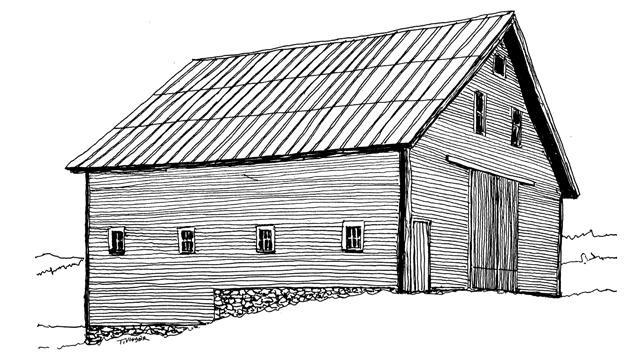
stories from & for the land 25
English barn
DRAWINGS BY THOMAS DURANT VISSER
Gable front barn
CUPOLA BARNS ( CIRCA 1860 TO CIRCA 1890 s ) Many dairy farmers soon discovered that the shift to “tight barns” brought an undesirable problem – poor air quality. Indeed, with eye-watering fumes rising from manure basements, and moldy dampness rotting wooden walls and roofs, it became clear that better ventilation was needed. At frst, simple boxy wooden ventilators were added to barn roofs to vent moist air. Tese evolved into Victorianera cupolas featuring large louvers and brightly painted decorative trim and brackets associated with the Italianate and Queen Anne styles of architecture.
Often capped by gold-leafed weathervanes, fancy cupola barns soon became symbols of farming success during the railroad era. At summer estate farms, these barns were trophies of the wealthy.
HIGH DRIVE BARNS ( CIRCA 1880 s TO CIRCA 1900 s ) are a distinctive type of Vermont barn that feature open ramps or covered bridges that lead to the hay lofts. Tese multi-story “gravity fow” bank barns were designed to reduce labor as hay could be easily dropped down chutes to feed cows in stalls on the foor below.
ROUND BARNS ( CIRCA 1890 s TO CIRCA 1910 s ) that combine a circular or multi-sided plan with features of the previous model “gravity fow” barn designs are another rare, but noteworthy late-Victorian era design variation found in Vermont. Some were constructed with 8, 12, or 16 sides.
26 vermont almanac | volume 1 v october
Cupola barn
High drive barn
Round barn
GROUND - LEVEL STABLE BARNS ( CIRCA 1901 s TO CIRCA 1940 s ) A harsh reality destroyed the optimism and fortunes of many dairy farmers in Vermont in the early 1900s as it became understood that devastating diseases like tuberculosis were spread by milk contaminated by airborne bacteria from the dusty manure in gravity fow barns. Entire herds were culled, and soon milk markets refused to accept milk from barns with wood-foored dairy stables. To address the problem, new dairy barn designs were developed with concretefoored dairy stables located on the ground level that could be regularly cleaned by washing manure into gutters. Also, to reduce the spread of diseases, cow stables were lined with windows to increase the level of ultraviolet sunlight; ceilings and walls were whitewashed with lime; separate milking parlors were added; and sophisticated ventilation systems were installed with air ducts leading up to manufactured steel ventilators on the roofs. Designs for these
ground-level stable barns become standardized through much of the dairy farming areas of the United States and Canada. Many featured engineered trusses with double-pitched gambrel or Gothic-arched roofs that sheltered the upper story haylofts. Large wooden stave, tile, or cement silos for storing fermented chopped corn stalk fodder also became common features of Vermont dairy barns during the frst half of the 20th century.
SURFACE BARNS ( 1950 s TO PRESENT )
As advances in medical research led to the development of pharmaceuticals able to control such infectious diseases as bovine tuberculosis, single story dairy barns became common by the early 1950s. Some operated as free stall barns with the cattle moving in and out freely. Many current large Vermont dairy farms now keep their dairy herds stabled inside large single-story, concrete-foored surface barns throughout the year and rely on outdoor bunker silos to store fermented corn silage. Tomas Durant Visser
PRESERVING HISTORY
If you have a historic barn in need of restoration, there are two grant programs that might be able to provide fnancial assistance. Te Preservation Trust of Vermont (ptvermont.org) has a grant program to ofset the cost of a professional assessment of the barn’s needs, and the Vermont Division for Historic Preservation (https://accd. vermont.gov/historic-preservation/funding) ofers matching grants for the preservation of historic agricultural buildings.
stories from & for the land 27
Ground-level stable barn
Surface barn
New Life for Old Barns
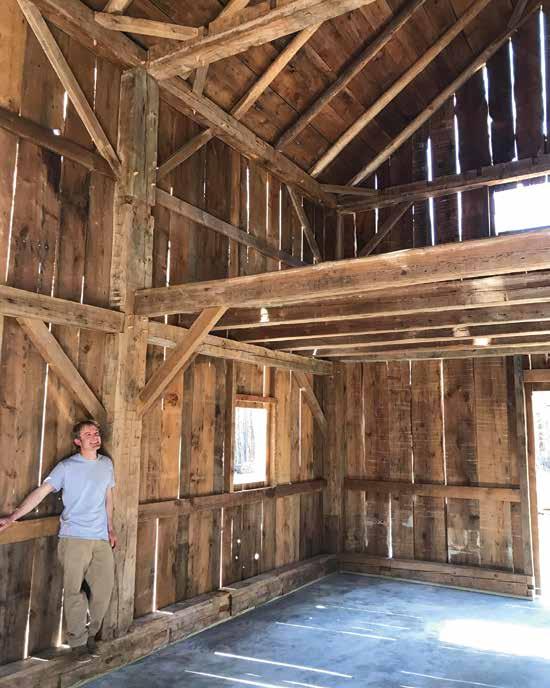
For Luke Larson, restoring a barn is a journey into history – the wood used and the axe and chisel marks tell a story.
f 28 vermont almanac | volume 1 v october
We step out of the sunlight and into the cavernous main barn at Green Mountain Timber Frames’ headquarters in Middletown Springs. Its roof soars stories above us. Te warmth of centuries-old beams and boards surrounds us as sun pours in through the wavy glass of restored windows. It’s the kind of space that just feels welcoming. “We believe it was built around 1780 – certainly pre-1800. It’s a pretty classic Englishstyle threshing barn,” explains owner Luke Larson, pointing to the three-bay layout with large doors accessing the center bay from each side.
Larson has made restoring old barns his life’s calling. He’s interested not just in the bones but also the history of these structures – what the barns were used for, when they were built, and who built them. “We try to learn as much history on the barns as we can, so we go back to old land deeds and often meet with the local historical society,” he says. Tis barn came from just over the New York border in Saratoga County, and the builder was a farmer named Reuben Wait, who would have been born before the United States.
Larson grew up on a dairy farm in Wells and as a high schooler he started working for Dan McKeen, a master timber-framer who started Green Mountain Timber Frames in 1983. At that time, the focus was exclusively on building homes with milled timbers. But after one client asked for a timber frame addition made from old barn timbers, a new passion was ignited. After college, Larson decided this was the career path for him and he purchased the company in 2015 when McKeen retired. Since that time, Larson and his team – including his wife Sara Young and three to fve employees – have restored (“saved, really,” he says) more than 50 historic barns.
“I am passionate about timber framing as a practice. I love chiseling. I really geek out on joinery,” says Larson. “But I’m equally passionate about keeping the stories alive – the history that these barns embody. Standing inside a barn like this one, built around 1780, you think some of these larger trees were at least 200, if not 300 years old when they were cut down, so we’re standing inside a structure built with trees that predate Columbus. I spend quite a bit of time thinking about that, starting with the trees, and then through the individuals who built the barn, hardy souls. I just can’t imagine walking out into the woods with an axe and just starting to clear a space for a 32-foot barn.”
Larson has a special appreciation for the wood
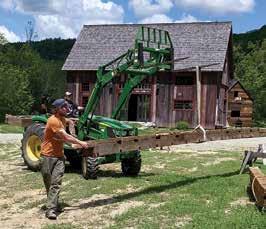
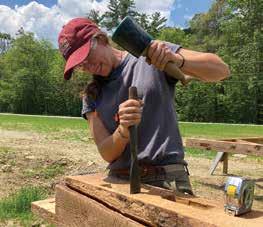

In June 2023, Jack Snyder guides a beam while Issac Yackel moves it with a tractor (top) and Jamie Austin chisels out a mortise. By late July they had re-erected the restored structure in Dorset.
stories from & for the land 29
– dense, straight – used to build early barns. “We’re standing inside ash trees in this barn,” he says. “Beech is another common species that was used in this area. Some red oak; we have a little bit more red oak here than white. Not as much chestnut right here. So hardwoods, and then the upper system of the barns is usually pine, because that’s what they could get the longest, straightest piece out of. Tis barn that we’re in right now has fve beams that are 42 feet long.”
In the late 1700s and early 1800s, when many of the barns that Larson works with were frst built, there were few traveling carpenters. Te majority of
these barns were put up by the family, with help from neighbors, using layouts and construction techniques common in their European homelands. “I’ve been fortunate enough to take down and restore some barns, 10 or 20 miles apart, that I’m quite confdent were built by the same person, or at least the same advisor,” he explains. “Sometimes the measurements are exactly the same. Or they used the same system of marriage marks to label each piece of the frame.”
Larson points to a barn he restored some years back in North Hero, where he found the remains of a rudimentary living structure beside the barn, as
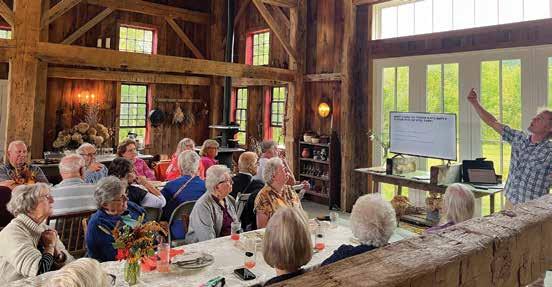
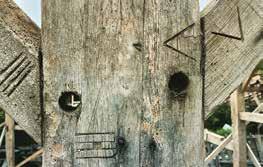
Clockwise from top: Te restored pre-1800 Reuben Wait barn that now serves as home to Green Mountain Timber Frames, as well as a place for educational events and community gatherings. Nearly all work is done with hand tools, using techniques that are centuries old. Te original builder’s “marriage marks” on the frame of a barn.
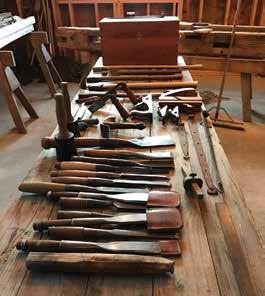
30 vermont almanac | volume 1 v october
PHOTOS
COURTESY OF GREEN
MOUNTAIN TIMBER FRAMES
typical of how things were done. Often the settlers would arrive, erect a rough log cabin to live in, and then get to work on building a barn – which was often constructed with much more precision than the living structure. “ Te builders put such care into those barns because they were relying on them to house the animals and store the food they’d need to survive the coming winter,” says Larson.
He also fnds huge appeal in the communal nature of building a timber frame, even today. “A timber frame is really designed to be crafted and assembled as a community,” he explains. “For the farmers who had to start by clearing the land, I imagine it would often take months if not a couple of years to hew out all the timber. And then they would probably do a lot of the joinery in the winter. And then on the barnraising day, the whole town would come together. It was a work day, and then at the end of the day there was often a celebration.” Tat’s still the case when his team erects a barn frame for a client.
Larson focuses exclusively on pre-1900 barns. In some cases, like a 2022 project in Pittsford, the barns are restored to be returned to agricultural use. In others, they are relocated and used as outbuildings or homes. Te restored Reuben Wait barn showcases the versatility of these old structures. From the inside, it appears much as it might have originally. Te interior holds some secrets that have been uncovered: grooves in the posts on each side of the door, for instance, into which a board could be inserted during threshing to prevent the loss of grain. “ Tat’s where the term threshold comes from,” Larson explains. But the outside holds some modern secrets of its own: Larson has added an exterior shell around the barn, which along with invisible insulation panels in the roof, allow the old structure to meet modern energyefciency standards.
For budget-driven projects, or where the barn is critical to an ongoing farming operation, Larson and his team will show up to prioritize and make repairs onsite. He credits barn grant programs in Vermont for playing an important role in helping owners to preserve historic barns and keep them structurally sound. Tat challenge is never-ending as the ravages of time continue to wear on old barns. “Wood is a living thing – even 300 years after it was cut. Te strength of wood is its fexibility,” says Larson, who marvels at how barns hold together even as they sink into the ground, slide downhill, or partially collapse.
While in-place repairs are important, Green Mountain Timber Frames’ niche is really complete restorations. “What my team and I specialize in is barns that are kind of beyond shoring up. We take the barns down completely. We label every board. We pop out the old wooden pegs, separate the joinery. Label every piece. Bring it back here to our facility. Wash it, pull a gazillion nails, which we save if they’re old.”
Larson uses the word label a lot. When you’re disassembling and reassembling a 250-year-old structure board by board, beam by beam (the process actually happens twice, as a dry run reassembly is done at the shop before fnal reassembly on site), organization is critical. In some cases the structure has been altered over the centuries, so they need to fgure out how the original timber frame was assembled and what parts might be missing. All of the wooden pegs are replaced when reassembling a frame, the new ones custom-made to ft holes that are rarely standardized.
Te goal is always to use as many of the original posts, beams, and boards as possible. Te company has built up a boneyard of old timbers to pick from when rot or other defects have damaged a particular piece beyond repair. Te work of ftting any new pieces is all done by hand, the only nod to modern efciency is a small chainsaw mortiser used to speed the rough-cutting of new mortise pockets before they are hand-fnished with a chisel.
Because of the size of the frames, the team works mostly outside, year-round. Many of the barns they work on are purchased from owners who don’t have either the desire or the fnances to restore them, but don’t want this important part of Vermont’s history to be lost. Tis day they’re working to reassemble a barn that will be re-erected at a new home in Dorset.
Te Green Mountain Timber Frames property is home to a few permanent structures. Te most notable is the main barn building, which moonlights as a space for community music nights, author talks, and more. An old blacksmith shop was just moved, piece by piece, from Benson and now sits just behind the main barn. Tere’s also a 1860s sheep barn at the site – it’s much longer than the early English barns, with an open lower level for the sheep and a large enclosed upper level for storing hay.
Larson says people are drawn to these old barn structures because they can sense their history. “I think it’s really important that we look back and learn from it and appreciate it,” he says. —Patrick White
stories from & for the land 31
A Vermonter in Paris
Will Wallace-Gusakov, who owns and operates Goosewing Timberworks in Lincoln, spent the frst six months of 2023 in France. Instead of crafting custom timber frame homes and outbuildings as he does in Vermont, Gusakov was working as part of the team charged with rebuilding the wooden roof frame of the grand Notre Dame Cathedral in Paris, which burned in 2019 as the world watched. We asked the mostly self-taught timber frame carpenter about the once-in-alifetime experience…
WAS REBUILDING NOTRE DAME , AMONG THE MOST FAMOUS BUILDINGS IN THE WORLD , SOMETHING YOU HAD EVER ENVISIONED ?
No, no way. I never, ever would have been so presumptuous as to think that could happen. When Notre Dame burned, folks around here who knew I do historic timber framing work and knew that I’d lived and worked in Paris about 10 years ago, asked, “Are you going to work on the rebuilding?” And I said, “ Tere’s no way. Tat job will go to some huge company.”
SO HOW DID YOU END UP INVOLVED ?
After the fre, a narrative was being promulgated by those who wanted to modernize Notre Dame that it wasn’t possible to rebuild the timber frame as it had been, because supposedly there weren’t enough big oak trees in French forests, and supposedly there were no longer carpenters with the skills to do it. Both of these ideas were patently false. So a group that I belong to called Charpentiers sans Frontières, (Carpenters Without Borders), which does hand-tool restoration work on historic buildings around the world, started a public campaign
to help educate the public and the decision-makers that, in fact, both the material and the knowhow were available. In 2020 they even created a full-scale replica of one of the large timber trusses of the nave roof, using only hand tools, in just nine days. Tey
helped to make it impossible to deny that Notre Dame could be rebuilt as it had been, and it was decided to recreate the original medieval framing. A small French company run by a friend of mine was awarded the job of rebuilding the nave roof (the
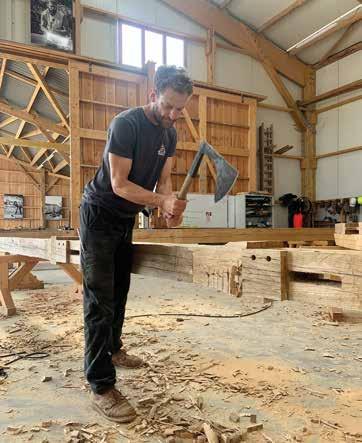
Will Wallace-Gusakov at work hewing a nave timber for the reconstruction of Notre Dame Cathedral.
32 vermont almanac | volume 1 v october
f
COURTESY OF WILL WALLACE-GUSAKOV
PHOTOS
central large open space of the cathedral where worship services took place). I met him in France through Carpenters Without Borders about six years ago, and we’ve worked together on several projects since then, in France, Italy, Maine.… he’s also come to stay with us and see our shop in Vermont. He reached out and asked if I would be interested in being a part of his team.
IT SOUNDS LIKE THE DECISION WAS MADE TO RESTORE THE STRUCTURE NOT ONLY IN A HISTORIC WAY , BUT IN A HYPERHISTORIC WAY . Yes, that’s true, particularly with the nave and choir. Te transept and spire were largely redone about 1850 by a famous architect, Eugène Viollet-leDuc, and it was decided to rebuild that whole section to that 19th-century state since Viollet-le-Duc’s creations have become iconic and beloved. Tose sections are being painstakingly rebuilt exactly as they were in about 1850, following Violletle-Duc’s original drawings. For the nave and choir roofs, it was decided to recreate the original medieval design. Te Notre Dame cathedral was built in phases between 1180 and 1260, and the original medieval roof framing of the nave and choir had survived 850 years, until the fre in 2019. Te architects had to do a huge amount of work to analyze not only what had been there at the time of the fre, but which of those parts had been added or repaired over the centuries. Te goal was to go back to the original framework.

HOW HARD WAS IT TO TRY TO UNDERSTAND AND REBUILD A STRUCTURE THIS LARGE THAT WAS BUILT MORE THAN 800 YEARS AGO ?
After the fre, very little remained of the timbers, basically just a pile of charred rubble. Fortunately, the structure of Notre Dame had been very well documented, just 10 years earlier, by some architecture grad students as their thesis. Tey documented the nave and choir roof system very well, and those detailed measured drawings are what enabled it to be rebuilt faithfully.
AND THAT WAS THE PORTION OF THE PROJECT THAT YOU WORKED ON ? Exactly. Te nave and choir roofs are the two big medieval sections.
Te site of Notre Dame in Paris – a massive construction project. Te wood nave roof structure will eventually sit atop the stone walls of the cathedral.
Our partner company did the choir and our little company of 20 people (Ateliers Desmonts) did the nave. We worked mostly in Normandy, about two hours outside Paris, but had a chance to visit the site of the Notre Dame rebuilding and it was incredible. It’s a huge project.
HOW COMPLEX WAS THE WORK COMPARED TO A NORMAL PROJECT YOU COMPLETE ?
It was much more complicated. First of all, the top of the masonry walls where the roof framing sits aren’t level, or straight, or parallel,
stories from & for the land 33
or regular. Te frame we were building was irregular in just about every possible dimension! Every roof truss was diferent from every other one (there are a total of 57 trusses in the nave). And then, we had loads of various documentation to study and compare: we had computer-drafted plans from an engineering frm to follow, but then we had those hand-drawn architectural studies. And we were told to compare the two. And then we also had historical photographs – whole huge reams of fles on tablets and computers. Plus, we were always getting more photos from various sources and adding them to the trove. And we also needed to consult images from a 3D point-cloud scan that had been done before the fre. Basically, we were creating a replica of something that wasn’t standardized when it was built. Even the same type of piece could vary quite a lot from one truss to the next. And some of the sculpting details, the swells around joinery, varied quite a bit from piece to piece. If there was historical evidence then we would recreate it, and if there wasn’t, then we – together with the architects who were very involved in this kind of stuf – came up with methods and standards and a logic so that the details we made were harmonious with the frame as a whole.
DID THAT TAKE AWAY SOME OF THE ARTISTRY OF THE HAND - WORK AND THE MORTISE AND TENON JOINERY ?
No, there was still plenty of room for artistry. In most cases the approach we decided on was to try to get into the mind of the Gothic
carpenter and do something that would have made sense with the tools they had. Te architects were really down to earth and very interested in what we carpenters had to say and in our take on why certain things look a certain way. Tat was something really cool for all of us, who are pretty passionate about this type of thing – getting to think about these things, discuss them with the architects, and then actually create them.
WHAT TOOLS DID YOU USE ?
Tere were certain tools that needed to be period appropriate. And most of those had to do with the look of the fnished product. Most important were the hewing axes – the broad axes. Carpenters Without Borders visited a diferent building in Paris that is also from the twelfth century and has some similarities with Notre Dame. Tey researched the joinery and the tool marks – especially the traces of axe marks. Tey saw, for example, that the axe blades from that time period were of a certain size range, and that they all had a curved “bit” (cutting edge). Together with the architects they came up with certain “spec” for the broad-axes that were approved for work on the cathedral. A friend of mine did some design work with a group of French blacksmiths, and designed a couple diferent types of joggling and hewing axes. And this group of really great blacksmiths got together and collectively made 60 axes on commission, specifcally for this project. Te fact that all of the timber is being hand-hewn is a really huge deal in France – it’s the frst time that a signifcant historic building has been restored
this way. Hand-hewing was pretty much a lost art in France 30 years ago, and a few groups (Carpenters Without Borders chief among them) has done a lot to help revive the technique. But it’s still quite a rare niche skill, and so it is very signifcant that the Notre Dame timber frame is being hewn. And there was a lot of hewing – it took our crew of 20 from November through April full-time to hew the nave timbers – it was a ludicrous amount of work.
WHAT ABOUT THE TIMBERS YOU WERE HEWING ?
All the timber is Quercus robur, aka European oak, and the logs were donated from both public and private forests all across France. A whole army of foresters was mobilized to select and supply the logs for all of the roof framing –in all, several thousand very high quality and large oaks. Often, carpenters would go out into the forest with the foresters and the two trades would share their knowledge about the intersection between forestry and carpentry –two trades that have always been very closely linked until modern industrial times. Te biggest timbers that we had in the nave were the tie beams, which were 14 meters long and as large as 22 x 33 cm (about 9 inches x 13 inches x 46 feet). Not as massive as people might think. (Te very biggest timbers are part of the base for the spire – those were massive.) But there was a lot of big timber in the frame. Te 57 nave trusses (11 of them principal trusses and 46 secondaries) all had two rafters each at 12 meters long. So we had hundreds of extremely straight and
34 vermont almanac | volume 1 v october
beautiful oak logs coming in, and there were really strict tolerances for knot size, sweep, slope of grain etc.
WHAT ABOUT THE LOGISTICS OF WORKING OVER IN FRANCE FOR SIX MONTHS ?
It took about eight months of preparation before the trip, fguring out what type of work permissions and visas might be required, getting through all the paperwork and immigration stuf, etc. A huge part of the experience for me was that my wife and our two toddler boys came over for fve out of the six months, which was wonderful. I could never have taken part in the project without the support of my wife, and I’m so grateful to her for making it happen for our family. It did add some extra planning on our end though, to fgure out accommodations, health care, vehicle, etc., for the family. I also put my business on hold while I was gone, although I was able to bring one of my employees over to work on the cathedral, and there were actually a few other Vermonters involved on the team, as well.
YOU HAD TO RETURN BEFORE THE NEW FRAME WAS ACTUALLY RAISED , STARTING IN AUGUST . WAS THAT BITTERSWEET ?
Yes, I had to get back to Vermont because of work commitments. It was hard to leave, because I’ve been so invested and had such a great time, and I would have loved to see it through to the end. But I’m very grateful to have been part of it for six months! And it’s been great to jump back to work in Vermont on projects that clients had been very graciously waiting for.

A six-month stay in France gave Wallace-Gusakov a chance to be inside Notre Dame (a UNESCO World Heritage Site) during reconstruction.
DID YOU SEE OR LEARN ANYTHING IN FRANCE THAT MIGHT BE APPLICABLE TO YOUR TIMBER FRAMING IN VERMONT ?
I’ve been thinking about that a lot, and I think the infuences I picked up will come out over time. Te styles and typology of French historic timber framing are quite diferent from the New England tradition, and I’m excited to incorporate more historic European infuences in my designs. It’s so cool to be able to design and create frames that can pull from various traditions – French, British, New England, medieval, contemporary…
NOW THAT YOU ’ VE CHECKED WORKING ON A WORLD - FAMOUS CATHEDRAL OFF YOUR LIST , ANY FUTURE SPECIAL PROJECTS YOU ’ D LIKE TO TAKE ON ?
I’d love to build what’s called a tithe barn, which is a type of large barn that was built across western Europe in the medieval period, often by abbeys or churches, to store taxes in the form of agricultural crops. It’s a really gorgeous iconic form of barn seen in France and in the UK. So if any Vermont Almanac readers want a tithe barn built, call me up!
stories from & for the land 35


36 vermont almanac | volume 1 v sponsor
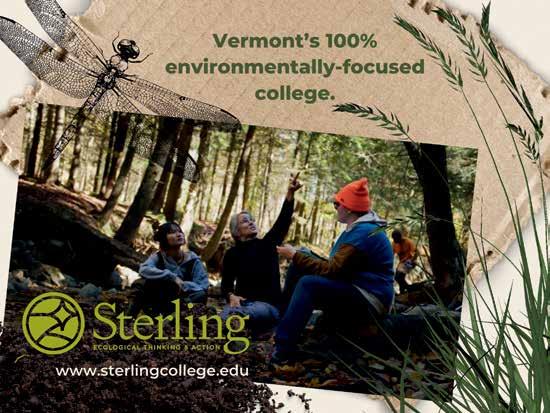
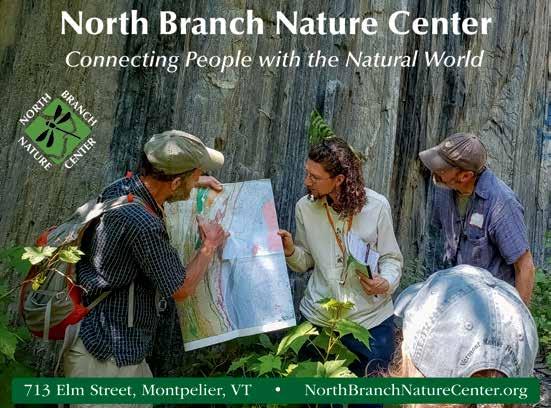
stories from & for the land 37 sponsor

NOVEMBER
stories from & for the land 39

THE TROPHY
Tis watercolor by Paul Starett Sample (1896-1974), an artist from Norwich, is part of the Orton Collection. Te paintings, and the stories behind them, are collected in a lovely book, written by Anita Rafael, entitled For the Love of Vermont, available through the Vermont Country Store. In it we learn that Lyman Orton was able to buy this painting at a low price because “who else besides a Vermonter would want it hanging in their home?”
40 vermont almanac | volume 1 v november
COURTESY OF THE LYMAN ORTON COLLECTION OF THE ART OF VERMONT
Even for non-hunters, November means deer season – an explosion of orange clothing, pickups pulled over on roadsides and hayfelds, and spontaneous gatherings at the scale outside the general store when a hunter shows up to register a kill. Count me among the ambivalent – not a hunter but unable to resist creeping forward for a look. My rational side believes in hunting, both for food to feed families and for wildlife management; and who am I to question the traditional values of native Vermonters? Since we signed our deed in 1976, we have never posted our land; most of the hunters who enter our woods come from families who have been hunting here since long before we arrived. My emotional side veers in another direction because the death of an animal is dispiriting to witness. Once as a young boy visiting my grandmother’s farm, I unwisely insisted on watching the slaughter of a goose. I walked away in a daze, and the next day when the goose appeared on the dinner table, I felt for a second time the nausea of remorse. I have a small rife and will use it to defend my garden and my dog, but any relief I feel from the elimination of a groundhog or porcupine is soon eroded by the stark reality of its corpse.
For many years this battle between my rational and emotional sides has intensifed each November with the daily sightings of deer on our land, sometimes just a few feet from our door. Deer are elegant creatures, each with its own markings and foibles, and when one stares back at you with a wild apple in its mouth, it looks thoughtful. Does show up with fawns that will grow up before our eyes like household pets.
Six years ago my ambivalence began to evolve when my son and his family moved from Brooklyn to a house just a ten-minute walk from us on a trail through a woods flled with deer. My son knew these woods as a boy, and after two decades as a city-dweller and the arrival of his frst daughter, he decided he was ready to take up hunting. He began slowly and methodically, buying a deer rife and taking a course in hunter safety; and for the next few years he spent many hours in the woods each November without taking a shot. He saw plenty of deer but never the right one. I admired his patience. I also reminded him over and over not to ask for my help when the time came to dress and butcher a deer.
We want our children to be happy, to be successful at what they set out to do, but I never anticipated how far my feelings on this matter would move. Tis past November I wanted my son to get a deer, and as the days of the season slipped by, I felt something like urgency on his behalf. On the fnal day of rife season he killed a fve-point buck. I could hear the single shot from our house. After dressing his deer, he texted a photo, not the typical trophy shot of a head and antlers, but a picture of the heart and the hole his shot made passing through.
My wife’s feelings about hunting hadn’t migrated quite as far as mine. She’s a mother, and she worries about guns; when I showed her the picture, she winced. But she also loves a good story, and soon she was texting the news to her twin sister, whose children live in suburbs where no one hunts, and to our daughter, who eats no red meat but who is squeamish about nothing. One afternoon nearly a week later my wife saw the dressed deer. We were driving our granddaughter home after dark, and it hung from a post just inside the barn door, wreathed in a nimbus of soft light from a bare bulb. I held my breath while our granddaughter gathered her things.
“It looks nice,” my wife said as I turned the car around, “homey and rural.”
—Jonathan Stableford
stories from & for the land 41
The warmth continued in early November to an exceptional degree. On the sixth, the high temperature in Burlington was 76 and the low was 62. On the 10th, someone sent us a picture of a wreath display cooking on the asphalt in front of the Bennington Hannaford supermarket, the needles already falling. “ Tese will last until Christmas, right?” the note read. Ten out of the frst 12 days of the month were above 65 degrees in Brattleboro.
Te warmth ran right up until opening day of deer season, and then, as if the prayers of Vermont’s 79,664 hunters were answered, the weather turned on a dime.
Te two-week, three-weekend rife season, which ran from the 12th to the 27th, was about perfect temperature-wise. “Hanging weather,” as the old-timers say. When you shoot a deer, there’s a grace period as the animal’s heat leaves the body, but within roughly 24 hours you’ll want to get the carcass chilled. Forty degrees is something of a magic number –beneath that you’re golden. Above that, you’re playing with fre. With
R
Answered Prayers
daytime highs averaging in the 30s, the outside was as good as a walk-in cooler through much of rife season. It gave hunters time to relax, savor their success, chip away at processing their venison throughout the week in the hours after work. We don’t always have this luxury.
Tere was some snow – we’ll call it an average amount. No big storms, but the mountains had a trace to a few inches throughout much of the season. Fourteen of the pictures of giant bucks that were posted on the Vermont Biggest Buck Club Facebook page had snow in them, 10 did not. Tat seems like a pretty normal representation of a typical rife season. Snow helps hunters because it allows them to see deer better. Cold also prompts deer to move during daylight hours.
By the end of the month, temperatures moderated again. Tanksgiving weekend is the unofcial start of Christmas tree selling season, and opening weekend started by looking, if not feeling, a bit like Christmas, as many farms had at least
a ground-covering of snow. However, the sun came out and temperatures climbed into the 40s, dropping only into the upper 30s at night; the snow quickly melted, leaving behind muddy conditions. For the many tree farms that use their felds for customer parking, frozen ground is critical, and in this regard the 2022 season did not cooperate. When all was said and done, the average November temperatures were 5 4 degrees above the 20th century mean and 3 4 degrees above the 21st century mean.
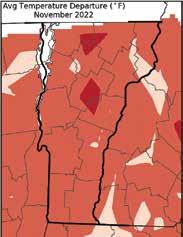
We looked back at our weather summaries from the past three volumes of the Vermont Almanac and saw that November 2021 was a bit colder than average, with good tracking snow on the third weekend of deer season. November 2020 was a deer season dud, with record-breaking warmth; it was six degrees warmer than the 30-year mean. November 2019 featured record-breaking cold. At 6.6 degrees below the 30-year mean, it was the coldest November on record in much of the state.
42 vermont almanac | volume 1 v WEATHER
november
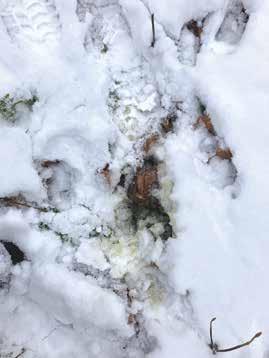

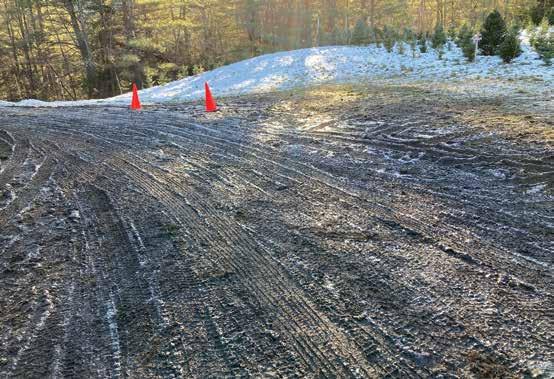
Early November warmth made for an enjoyable extended fall; a bit of snow in mid- to late-November helped hunters track deer; opening weekend of Christmas tree season came with warm temperatures that melted the snow, softened the ground and left many farms a muddy mess.
stories from & for the land 43
 BY
BY
MID - NOVEMBER , most eastern chipmunks have gone or will shortly disappear into their tunnels where they have gathered and stored their winter food supply. Up to half a bushel of nuts and seeds can be stored here. Tey will visit this chamber every two or three weeks throughout the winter, grabbing a bite to eat between their long naps.
In order to minimize the number of trips taken to fll their storage chamber, chipmunks cram their cheek pouches as full as possible. A review of the chipmunk literature fnds that they can carry an astounding amount of food in their mouths at one time. Researchers have documented a chipmunk carrying 31 kernels of corn in its mouth; also, 13 prune pits, 70 sunfower seeds, 32 beechnuts, 6 acorns. — Mary Holland
eWinter Wrapping for Beehives
All winter, even on the coldest nights, the core of the cluster of bees inside a beehive is kept above 90 degrees. Fueled by stored honey, the bees generate heat by shivering their indirect wing muscles.
When winter weather sets in for keeps in November, most beekeepers in Vermont wrap their hives with insulating covers to slow the loss of heat. A recent study of 43 hives in Illinois has confrmed that this is a wise practice. Covered hives had a 22 5 percent higher winter survival rate than the uncovered ones, although all the hives were equal in weight and had the same level of mite infestation at the start. In addition, bees in the covered hives consumed less of their winter stores than the uncovered controls.
Before about 2000, nationwide winter colony loss was thought to have been around 20 percent. But more recently the combination of new pests, parasites, and pathogens – and exposure to pesticides – has resulted in winters being more deadly, averaging 39.6 percent over the past 12 years – despite the fact that winters have become warmer.
Te hive covering study was carried out in a warmer place than Vermont, so it may be that covers here are even more benefcial. Colony losses here for the whole year – from April 1, 2022 to April 1, 2023 – were 48 2 percent, almost as bad as in 2020-2021, our worst year, when 50 8 percent of bee hives perished. —Virginia Barlow
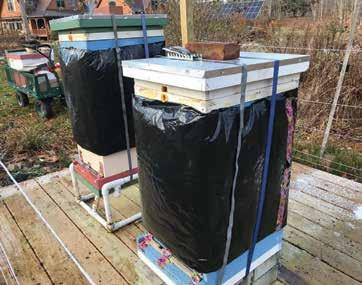
44 vermont almanac | volume 1 v november NATURE NOTES
MICHELLE PARSONS RAUCH
MARY HOLLAND

Covid Rates Low in our Wildlife
One of the many unsettling things about the Covid virus is that it’s constantly mutating and evolving. It does this as a matter of course, but the risk of mutation rises when the virus is passed from one species to another and then back again. And so it behooves us to understand where it’s present in wild animals.
For the past two years, Vermont Fish and Wildlife partnered with UVM to test wild mammals that were harvested by hunters and trappers in the state. In all they tested 487 deer, 19 foxes, 77 fshers, 43 otters, 32 coyotes, 79 bobcats, and 2 black bears. Somewhat surprisingly, none of them tested positive, though they were only collecting nasal swabs, which only detect active infections.
Additional samples from deer went to USDA Wildlife Services, where they tested blood in addition
to the nasal swabs. From these blood tests they could see if the deer had been infected with Covid in the past. Final results aren’t in at the time of this writing, but preliminary results found 27 samples, or 5 7 percent of the total samples, tested positive.
Te take home, said Nick Fortin, Vermont’s Deer Project Leader, “is that some of our deer have been infected with SARS-CoV-2, just like deer pretty much everywhere else in the country. Prevalence in our deer population is fairly low, and a lot lower than some of the early reports of Covid in deer that came from more densely human-populated areas. Tere are still many, many unknowns in all of this, including how exactly deer are (repeatedly) contracting the virus from humans. Fortunately, USDA funding came through in mid-summer, so Covid testing will be conducted on deer again this fall.”
PURPLE CROWBERRY , a diminutive alpine plant that grows low to the ground in rocky habitats above tree line, was documented on Mount Mansfeld in 1908. Vermont botanists have searched for the plant since then and never found it, even going so far as to list it as “no longer present in the state” on rare plant lists. Tat is until the fall of 2022, when Liam Ebner, a trained summit steward for the Adirondack Mountain Club, spotted a clump.
“ Tis is an extraordinary fnd,” said Bob Popp, a botanist with the Vermont Fish and Wildlife Department. “ Tis discovery emphasizes the beneft of having a community of keen botanical observers on the ground.”
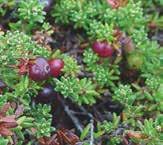
stories from & for the land 45
GLEN MITTELHAUSER
Putting Your Lawn in Perspective
Lawns are getting a lot of negative press these days, and there’s good reason for this. As pollinators struggle, and as Lake Champlain and other water bodies bloom with algae that’s fed, in part, by fertilizer from lawns, and as we all try to cut down on fossil fuel emissions, the Scotts Lawn ideal is due for an update. Te problem is that many of the
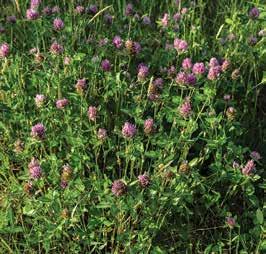
Tsolutions being sold are just impractical. Te idea that you might – or you might hire someone to – tear up your sod and replace it with a pollinator garden that you’ll have to maintain or pay someone to maintain is just not going to work for most people.
A more passive and realistic approach is to diversify your lawn and then mow it less, and if this sounds appealing, now’s the time to get started. Mow the section of lawn that you’re looking to diversify low during the last mow of the season in October, after the soil has become too cold for seed germination. Ten broadcast dutch white clover, self heal, and creeping thyme seed over the area. Te freeze/thaw cycles in winter will passively work the seed down into the soil and it will germinate the following spring when it’s ready. It may take a few years, but eventually you’ll have a diversifed lawn with a heavy foral component – no sod removal necessary.
By mowing less the following summer, you’ll have a lawn with more blossoms helping more bees. And by leaving the grass clippings to decompose, you’ll be adding organic matter back into the soil and improving your lawn’s health without fertilizer.
PLANT FOREST BOTANICALS NOW
he lawn’s not the only place to be broadcasting seed in the fall. If you’re interested in growing forest herbs like black cohosh, goldenseal, or ramps from seed, now’s a great time to get started.
Ideally you would have picked a shaded, rich-soil forest site in summer, using indicator species like sugar maple and basswood and wild ginger to guide you. After the growing season is over, return to the site and scrape back the leaf litter a bit, agitating the soil only slightly. Broadcast the seed by hand, aiming for a spacing of roughly four seeds per square foot. Lightly walk over
the seeded area to ensure good seed/soil contact, then cover the area back up with the fallen leaves. Mark the spot, then come back in spring to see what comes up.
To learn more about growing forest herbs, check out the Northeast Forest Farmers Coalition – a partnership of individuals, farms, universities, nonprofts, businesses, and other organizations with the shared goal of growing forest farming opportunities and education in the Northeast. Te group published a Forest Farmers Handbook in 2023 that has a lot of great tips – it’s available for free online at northeastforestfarmers.org.

46 vermont almanac | volume 1 v november AT HOME •
Winter squash is so versatile and plentiful, I imagine many aren’t unsure what to do with it. But perhaps you have an overabundance, or you’re getting bored of your usuals. If so, I invite you to roast the hell out of it, mix it with caramelized onions, and put it on toast with a tangy cheese. I’d wager that about once a month during winter squash season, the following recipe is made in my house, and you can hear excited chants of “SQUASH TOAST! SQUASH TOAST!” coming from inside.
Tere are two big takeaways from this recipe. First, the amount of squash really doesn’t matter, but you’ll be happier with more. Second, don’t put this on regular old grocery-store bread. Squash toast needs a sturdy bread to hold up the weight of
INGREDIENTS
Squash Toast
the roasted onion-gourd mixture. Lucky for you, this is easy to fnd, if you don’t make it yourself. A great visual clue is a dark crust on a round (often called boule) or oval (often called bâtard) loaf. Vermont is full of small bakeries and a couple of well-known bigger ones, like Red Hen and King Arthur, which seem to
deliver all over the state. I trust you can fnd what you need. Tis recipe is truly delicious. Te toasty squash is a vehicle for the little bit of onion jam, which is complemented by the tart cheese and the bright fresh herbs – all held up by some hearty toast. Hello, cozy season! —Olivia Piepmeier
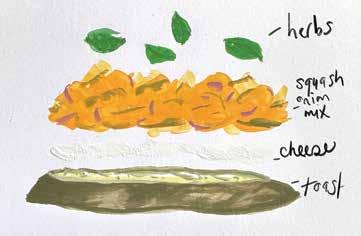
1–3 pounds of winter squash (butternut, honeynut, kabocha, or candy roaster) peeled, seeded, and cut into pieces ⅛- to ¼-inch thick.
olive oil
red pepper fakes, to preference salt, to preference onions, to preference, peeled and thinly sliced
¼ cup apple cider vinegar
¼ cup maple syrup
toasted, crusty, non-enriched bread some tart, spreadable cheese (I usually use mascarpone, but cream cheese or goat cheese would be good) chopped fresh mint, to preference (fresh sage or rosemary would also work)
METHOD
Preheat the oven to 450. Combine the squash, oil, red pepper fakes, and salt in a roasting pan. Cook until tender and slightly toasty, 15 to 20 minutes or more depending on how much squash you have.
Meanwhile, heat a little oil over medium-high heat in a frying pan. Add the onions and some salt, then cook at least 15 minutes, stirring frequently, until the onions are getting caramelized. You’ll probably need to turn the temperature down to low at some point to not burn them. Add the vinegar and syrup, stir, and reduce until syrupy and broken down – again, at least 15 minutes; the mixture should be jammy. Tis is a great time to get your bread toasty!
Combine squash and onions in a bowl (or the roasting pan, if it’s big enough) and smash with a fork until combined. Taste for seasoning. Assemble on the toast!
stories from & for the land 47
SQUASH TOAST RECIPE
OLIVIA
PIEPMEIER
When Vermont Ran Out of Deer
In 1876, Vermont ran out of deer. Deer had been in Vermont for approximately 9,000 years prior to European contact, and were still in “great store” in 1584, according to an early European account. But by 1876, the deer population had been wiped out, save for a few in the far northeast corner of the state.
A group of men from the Rutland area found the lack of deer untenable. Tese activists convinced the Vermont legislature to prohibit deer hunting throughout the state from November 22, 1876, until September 1, 1880 Tis was an extraordinary measure for the frst state in the nation to guarantee its citizens a constitutional right to hunt.
Not only did the law prohibit deer hunting for four years, it also imposed stif penalties on anyone caught pursuing, killing, or possessing meat, hide or “any part thereof of any wild deer,” and allowed any dog, “while in the actual pursuit of deer,” to be killed. Te Association, as the group called itself in public relations fyers, “paid a large sum of money for the purpose of restocking our mountains with this beautiful and valuable game animal.” Tey assured the public that their efort was a “purely private enterprise, the persons engaged in it claim no ownership of the deer, but their undertaking is solely for the public good.” Tey then acquired 17 deer: 14 purchased in New York State and 3 as a gift from one of the Governors Fairbanks, but whether Erastus or Horace is unclear.
In addition to advocating for
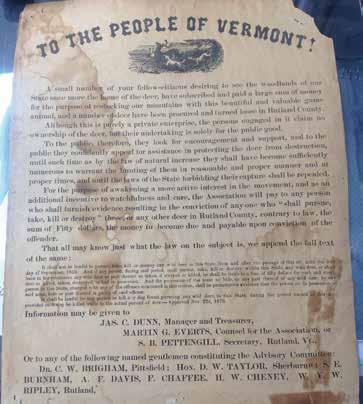
the legislation prohibiting and penalizing taking deer during this period, the Association also incentivized the public to help protect its eforts by ofering a reward of $50 paid upon conviction.
Te restoration of the herd worked, but it took two decades rather than four years. As the herd increased, so did pressure for an open season. Farmers complained of increasing crop damage; sportsmen exaggerated the size of the herd; and public sentiment turned against the law. Te law also proved difcult to enforce, especially in remote Essex County, where neighbors didn’t turn in neighbors who shared their venison.
In 1896, the Committee on Game and Fisheries supported a regulated season for the month of October the following year, allowing only antlered deer to be hunted without dogs. One hundred and three bucks were reported, though it’s believed closer to 150 were taken.
Vermont’s deer herd is currently estimated at 133,000 animals. While a few may have wandered here from away, the vast majority of Vermont’s deer are descended from the 17 imported from New York State and the few still alive in the Northeast Kingdom in the second half of the nineteenth century, when Vermont ran out of deer. —Deborah Lee Luskin
48 vermont almanac | volume 1 v november
Moon Phase and the Rut
Deer hunters, like professional athletes, are always looking for an edge – it’s the nature of the pursuit. And so we’re susceptible to superstition, alluring gadgets, marketing campaigns. A classic genre that combines all three of those elements is the moon table – a chart that tells you when the best hunting days are based on the moon phase. In the print world, these charts have largely gone the way of the Marlboro Man, but you can now buy an app that uses the moon to tell you when to take your hunting vacation.
Whether deer movement is afected by moonlight is an intriguing question. But because it’s hard to isolate the moon from all the other phenomena that afect deer behavior, I can’t imagine how you’d go about proving or disproving any particular theory.
What’s more certain is that the idea that the moon triggers the rut – a subset of the deer/moon genre –doesn’t really hold up under scrutiny. Mammologists have long held that the rut is triggered by declining daylight in the autumn, which has nothing to do with the moon phase. Several studies over the past decade – one in Pennsylvania, one in Illinois, one in New Brunswick – all reafrmed the idea by aging fetuses extracted from road-killed does over the course of multiple years. Since we know a whitetail has a gestation period that’s pretty close to 200 days, and fetuses by and large have consistent growth rates, they can be measured and you can count backwards to determine the date of conception. What the researchers found was remarkable consistency in the date of the average peak of the rut from year to year, regardless of the weather conditions or the moon.
Tis idea that day length triggers the breeding cycle makes sense in a northern climate: if a fawn comes too early, the doe won’t have adequate nutrition. If it comes too late, the fawn won’t be able to accumulate enough body weight to make it through winter. Having said that, it’s important to view the idea of photoperiod as a general rule. Budbreak in trees is another natural phenomenon based partly on photoperiod, but as the spring of 2023 showed us, trees take a cue from temperature, too.
Hard and fast rules are so much more
satisfying than general rules, and yet nature is full of the latter. Tis provides an opening through which one can cast doubt. Looking at the New Brunswick deer fetal study, which ran for nine years, the average peak of breeding fell within a seven-day period every single year. But a few outliers were breeding from mid-October through mid-December all nine years, so somewhere an astute hunter was watching a doe in heat in October and wondering what gives. In such a case it’s human nature to seek alternative explanations.
I asked Rod Cumberland, who was the New Brunswick deer project leader at the time of the study, why some does came into heat early or late, and he told me that “reproductive readiness is governed by nutritional plane.” It’s conjecture, but his thought was that the early-breeding does were ones that were not impregnated the previous year and did not lactate all summer. Because they were in better physical condition, they were ready to breed earlier. Te late breeders were a combination of females that missed connecting with a buck in late November during the frst estrus, and also doe fawns that had reached 65 pounds and became receptive in December. —Dave
Mance III
stories from & for the land 49
f Christmas Trees
An estimated 200 or so farms in Vermont are engaged, to varying degrees, in the growing and selling of Christmas trees. Some are larger wholesale farms that sell several thousand trees a year – trees are cut, wrapped, and shipped to the ultimate retailer. But the segment of the industry that has experienced the most growth in recent years is the cut-your-own segment, where people are invited to the farm to select and cut their own trees. Cut-yourown farms generally open for business the Friday after Tanksgiving and remain open for about a month. Depending on their size, some of these farms are open daily while others are open just on weekends.
Te demand for Christmas trees is currently strong. Tere has been competition from artifcial trees for many years, but of late this has leveled of. Increasingly, people – maybe especially in Vermont – value the experience of visiting a farm, selecting a natural tree, and having a fun family outing at the same time.
Tere is opportunity for more Christmas tree growers within Vermont. Tis could be someone who plants trees on a small bit of land they already own, someone who buys or leases land specifcally for Christmas tree production, or farmers who want to add Christmas trees to their other crops.
Christmas tree farming can be proftable, though it is certainly not a way to get rich quick. As economists say, there are barriers to entry – most notably the seven- to nine-year investment of time and money before a crop can be sold, and the need for suitable land. Fortunately, the type of high quality, fat land required for vegetable production is not needed for Christmas trees. Unused pasture or other rolling land that is relatively well-drained can work. Depending on spacing, 1,000-1,200 trees can be grown per acre.
Very few farms grow Christmas trees from seed –most buy 3- to 4-year-old seedlings from specialized nurseries and then plant them on the farm. (See Christmas Tree ID on the following page for more
on the common varieties being grown.) During the past 30 years or so, the 10-year or longer period once required to grow a marketable 6- to 8-foot Christmas tree has been shortened to as few as seven years, thanks to improved genetics. A farmer still needs to pay careful attention to insect/disease problems, weed/grass control, and soil fertility.
Most current Vermont growers belong to the New Hampshire-Vermont Christmas Tree Association, which helps both new and experienced growers gather and share information. For anyone considering Christmas trees as a potential crop, the association meetings are a good place to start. —Jim Horst
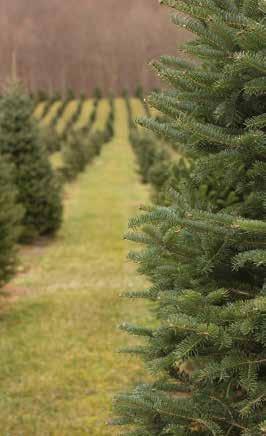
50 vermont almanac | volume 1 v november INDUSTRY
VERMONT AGENCY OF AGRICULTURE
Christmas Tree ID
If you head out to a farm for your Christmas tree this year, chances are you’ll bring home either a balsam fr (Abies balsamea) or a Fraser fr (Abies fraseri) – these are the two species most commonly grown commercially in Vermont.
Balsam fr, with its longer, elegant needles, is native to our state and is best known for its aroma – when people say they want a tree that smells like Christmas, they’re talking about a balsam. Fraser fr, native to the Appalachian mountains, doesn’t have the same trademark scent, but it does have a little more visual fourish in the form of shorter blue-green needles with silvery-white undersides, and a bit stronger branches for supporting heavy decorations.
For those who might be interested in growing Christmas trees, the appearance of these two trees isn’t the only way they difer. Balsam tends to do a little better on wetter sites – especially the Canaan fr (pronounced “ka-NAIN,” with emphasis on the last syllable) variety of balsam, which originated in the Canaan Valley of West Virginia and is being planted by many growers in Vermont these days because it tolerates wetter soils and breaks bud later than our native balsams. Tis helps it survive better in our new, less-predictable climate, which features more moisture and sporadic late frosts than can kill tender new foliage that has broken out of the bud.
Fraser fr likes well-drained soil (it is more prone to root diseases like phytophthora, which thrive in wet sites), typically requires more fertilization than balsam fr, and usually is a little slower-growing, taking maybe an extra year in the feld to reach seven or eight feet in height. Tose lifting them onto the roof of a car, or onto the harvest wagon, will notice that Frasers tend to be a little heavier. But they also have a reputation for longer needle retention once they’re put up at home.
Many Christmas tree nurseries, like Asack & Son in Barton, are now ofering balsam/Fraser hybrid transplants; by naturally cross-pollinating, the resulting hybrids ofer some of the best appearance and growing characteristics of each tree. Growers in Vermont have been planting more and more of these hybrids in recent years, while also experimenting with “exotic” species, like Korean fr, in hopes of fnding new tree varieties that might be resistant to
some of the disease, insect, and weather problems that are becoming more common.
One thing you can be thankful for is that the industry has come a long way from where it was decades ago, when common Christmas tree varieties being grown in Vermont included white spruce, with its painfully sharp needles and an aroma that smells not so much like Christmas as cat urine, and Scotch (or Scots) pine, an import from Eurasia that’s beautiful over there, but for some reason grows so gangly over here that it was likely Charles Schulz’s inspiration for the original Charlie Brown Christmas tree.
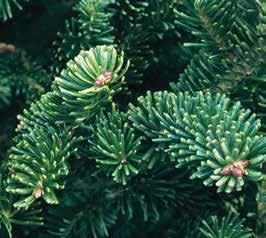
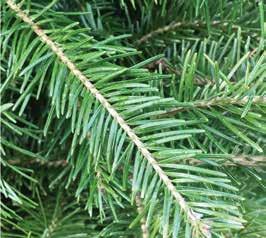
stories from & for the land 51
Fraser fr
Balsam fr
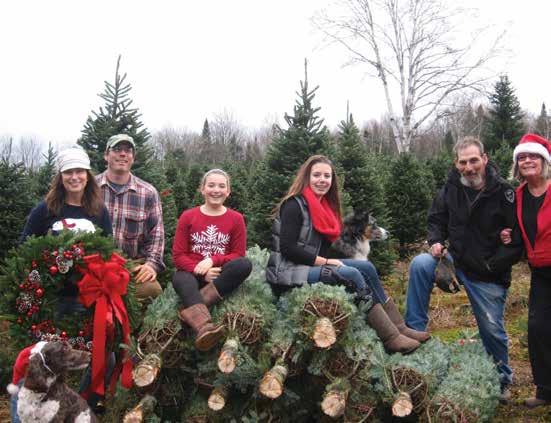
Heading South for the Holidays
Most of the larger Christmas tree farms in Vermont can be found in the northern reaches of the state, where land is plentiful, but people are not. Without a sizable local customer base, most of these farms choose to go the wholesale route – growing and selling in larger quantities but for a lower price. For more than four decades, though, D’Aiello’s Christmas Tree Farm has found a way to grow up north but still sell retail: they bring the trees to where the people are. Te farm is set on the Canadian border in Canaan, population 896; they sell on Long Island, New York, population 7.56 million.
Te unique arrangement has its challenges, but is incredibly exciting at the same time, explains Sage D’Aiello, whose parents, Richard and Christine, started the farm and the practice of selling Christmas trees on Long Island in the late 1970s. “ Tey actually were living on Long Island before that,” he says. “My father would go on annual trips to the Adirondacks as a kid, and that inspired a love of the country. When my parents were in their 20s, the back-to-the-earth movement was going on, and they decided to move out of the city environment.”
Initially, they rented a parcel in New Hampshire,
52 vermont almanac | volume 1 v november f
PHOTOS COURTESY OF
D’AIELLO FAMILY
Te D’Aiello family at home in Canaan, preparing to bring their Vermont-grown trees to their sales lot on Long Island, New York. From left: Pepper, April, Sage, Amelia, Ayva, Milo, Richard, and Christine.
where they built an of-the-grid cabin. “My dad did odd jobs for local farmers and my mother waitressed,” Sage says. “ Tey were still looking for land of their own, and found this site in Canaan. It was 150 acres and had been an old dairy farm up on a hill, but in the 1920s and 1930s it had been planted into Christmas trees that were neglected, so the trees had essentially grown up into a forest.”
Tey purchased the farm and moved in when Sage was just two years old. His father started the long process of clearing the land and selling the brush for wreaths, while harvesting smaller fr trees that had begun to regenerate in the openings. Tat clearing went on for “many, many” years, says Sage, who was part of the operation during his childhood.
Te family would still return to New York for Tanksgiving and Christmas, and began the tradition of bringing a few Vermont Christmas trees with them for family and friends. “A local farmer knew what we were up to and said to my dad, ‘Hey, maybe you should take a few Christmas trees with you to sell
down there. He thought that was a good idea, so we just took 10 or 20 trees at frst in an old 1960s GMC one-ton fatbed; the trees were on the back and we’d all pile in the front seat. Tere were no seatbelts or anything – I think I would sit on my dad’s lap and pretend to drive.”
Te humble experiment proved successful, and the following year they loaded on 30 or 40 trees. “ Tey were all hand-tied, and my mother began making wreaths that we’d bring with us,” recalls Sage.
As sales continued to grow on Long Island, back in Vermont, the Christmas tree farm was beginning to take shape, from a wild, overgrown forest to organized rows of manicured trees. “Our goal was not to get it too big; we wanted it to be manageable, where we could do a lot of work ourselves. And by retailing, you’re able to do that, because you get a little bit higher price for your trees. So it’s not volume, necessarily, that you’re looking for,” Sage explains. After college, he returned to the farm and eventually started his own family.
Over the decades, the annual month-long trip to
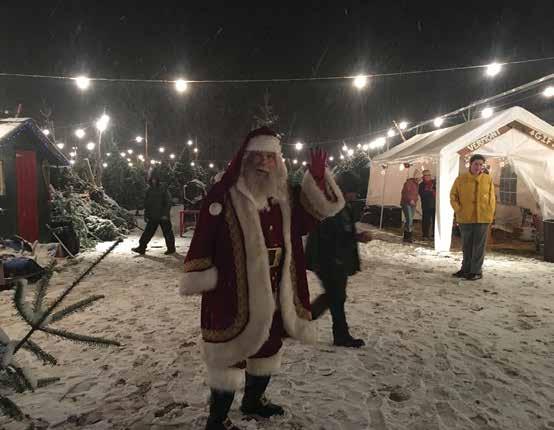
stories from & for the land 53
Bright lights, big city: Santa pays a visit to the D’Aiello’s bustling tree lot in St. James, on Long Island.
Long Island to sell trees became a D’Aiello family tradition, says Sage: “Basically, we spend from Tanksgiving until Christmas in New York. For many years we would stay with my aunt, but then my father bought an old school bus and converted it into an RV. I think the people down there were thinking, ‘Well, what else would you expect – here comes the rural Vermont family in a school bus!’” More recently, they have upgraded to an actual RV for their time on Long Island, but Sage says that his father, ever the woodsman, never took to the modern conveniences and, for this year, he’s built him a rustic “tiny house” that will be towed down to Long Island separately. Gone too are the days when they could load all the trees they sell on the back of a pickup. Now, multiple
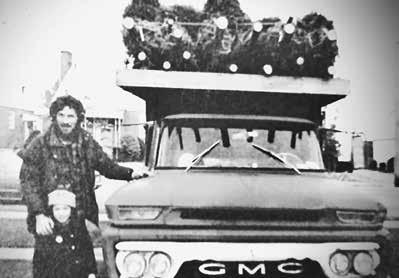
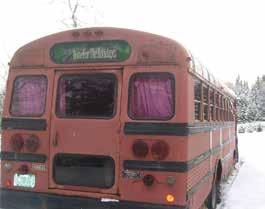
Sage and Richard on an early trip south, with all the trees they could load on their old fatbed GMC. Today, the trees are moved by tractor trailer. For many years, the family spent the month in New York in a converted school bus. Te bus has now been retired on the farm in Vermont, and these days the family calls an RV (and, for Richard, a rustic tiny house) home for the month.
tractor trailer loads of trees are shipped down to their New York site. All this makes for a busy time of the year; in addition to selling their retail trees, D’Aiello’s Christmas Tree Farms also sells some wholesale trees, which must be cut and loaded before the family leaves for New York.
In the past, “My father would go down about the middle of November and start setting things up, and then we would join him for Tanksgiving in time to open the Saturday after that,” recalls Sage. Now, as my parents are in their 70s, I need to be here loading wholesale trees and then get to New York as soon as possible, because it takes a week to set up our sales area down there. It’s tough to be in two places at the same time.”
Still, he says, after a year spent planting, fertilizing, mowing, shearing, and harvesting Christmas trees, the stress fnally starts to come of once they start selling. “As a kid, it was magical,” recalls Sage. “What an environment to spend so much time in, with the trees and the lights and the city and all of the really good food down there.” He also missed school for a month, so his teachers would send schoolwork with him. His own two girls, now both in college, had a similar experience during their childhoods. “ Tey’re still excited to go down there.”
After decades of making the journey south, Sage and his parents still enjoy the experience. “Selling trees is fun – it’s a great time of year, and everybody is in great spirits – it’s Christmas time,” he says. “It’s such a diferent world from home, where you’re by yourself in the woods, you’re working alone a lot, and then, all of a sudden, for a month, you and your trees are the center of attention, in this glamorous Christmas setting. You’re telling all the customers about the trees, and everyone is excited to see you.”
Building relationships with their customers in New York has been tremendously important to the D’Aiello’s from the beginning. “As you’re selling this product, you’re listening to customers talk about the trees as a family; for a few minutes you become part of this process,” says Sage. “And you engage in conversations with these people. You can develop friendships with these people. We’ve had customers that have been coming to us since the beginning, 40year customers.”
Te relationships they’ve developed have paid of beyond just building a loyal customer base. After their frst few years of selling out of Sage’s aunt’s property, a
54 vermont almanac | volume 1 v november

customer ofered their site down the road, which was bigger, with more parking. “ Tat allowed us to have a little exposure and increased sales,” he says. Some years later, another customer suggested they move to a site that they owned. “We still sell there today,” he notes. “It’s an old farm – a really nice setting.”
Having a natural setting in a densely populated area makes for the perfect tree-selling environment, he says, adding that they do everything they can to accentuate that. All of the signs and tree racks they set up are made with wood from their farm in Vermont. And they set the trees up in rows, which helps give the look of the way they grow on the farm. “It’s also important because we’ve found that trees sell best when they’re standing upright, rather than in piles or leaning on something,” he explains.
Te farm has built up a reputation among Long Islanders. Residents search out their trees, knowing that they’re fresh from Vermont, and grown by the same family who is selling them. Tat is a big selling
point over those who just buy in trees to run a lot for a few weeks a year. Plus, Sage notes, “Vermont is like no other state in New England or the country – the power behind a Vermont product is very strong in the marketplace.”
Tese days, the D’Aiello’s try to shut down their sales and get back to Vermont just in time to spend Christmas at home. Ten they have a few months to recover before the work of growing the trees starts over again. Today the farm consists of about 40 acres of plantation – most of this is Fraser fr, and another 20 acres of “wild” balsam fr trees that seed themselves. “ Ten we have another 30 acres of plantation trees that is just in the frst stage of development – young trees,” says Sage. “I’ve been doing that in case our girls might want to come back to the farm someday. Tat’s what my parents did for me. Right now, the farm supports two families, mine and my parents; the expansion would help the farm support another family – at least that’s my vision.” —Patrick White
stories from & for the land 55
Sage D’Aiello, during the busy harvest season, when trees are being cut for both wholesale customers and for the family to bring south to Long Island.
Wreath-Making as a Small-Scale Industry

56 vermont almanac | volume 1 v november
BY DESIGN f
NATURE
Beginning in October, notices appear in local newspapers looking for wreath-makers. Want ads are posted for specifc varieties of tree brush, like balsam and cedar. And wreath-making supplies – spools of Kelco wire, metal frames in diferent sizes, rolls of holiday-themed ribbon and boxes of other decorating materials – appear in large displays at the farm and garden stores, much like canning supplies do in the spring.
In 2022, as the winter season loomed and ads for cutters and makers appeared once again, I became curious about what this kind of job would entail. With two teenage boys in high school, and the eldest now able to drive them both, I found myself with free time.
I had no idea what I was getting into when I applied for the job as a cutter at Nature…By Design, a local nursery and landscaping business in Barton. A young man was carrying large bundles of tree trimmings from huge piles outside into the attached shed of a large barn. I approached him and asked if I could speak to the owner, Peter LeBlanc. Te young man disappeared inside, and a few moments later, Peter came out.
We spoke briefy. He asked if I’d ever done this kind of work before. I hadn’t. “But I’m a quick study,” I added. Could I start tomorrow? Yes. Could I be here at 7:45 a.m.? Yes. Tat was that.
Peter then asked me to step inside and observe two young women working at a table together to get an idea of what I would be doing.
One woman – the “maker” – stood at the bottom of a long, T-shaped table. Embedded in the tabletop was a spinning metal wheel strung with dark green wire that was controlled by a foot pedal on the foor. A section of the wheel would open so that a metal frame could be taken in and out as wreaths were fnished and new ones started. As the wheel spun, the woman held pieces of clipped brush, called fans, in place while the wire attached them to the metal frame.
Tere were stacks of wreaths on the foor. Each wreath took less than eight minutes to make.
Te other woman was the “cutter.” She would pull a branch of the top of a pile, lay it on the table in front of her, and clip the best greenery, using as much of each branch as possible. Te pace was frenzied. I asked her what the key to cutting was. “Be fast.” An experienced maker can move pretty quickly, and it is the cutter’s job to keep up.
When I started at the wreath-making shop it had
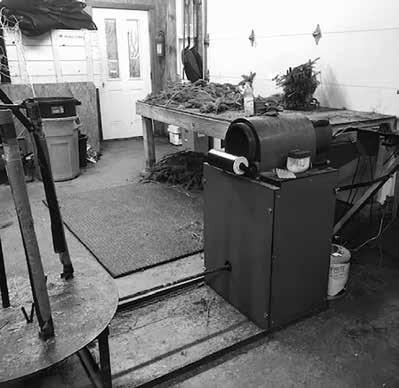

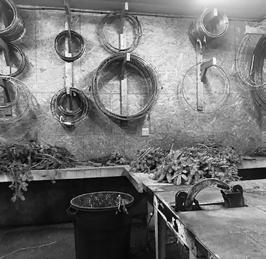
BY JODY
stories from & for the land 57
PHOTOS
SCHADE
been in full swing for a little over a week. I soon learned that there was added pressure because Tanksgiving was coming and wholesale clients wanted their orders before then. Te urgency was exacerbated by the fact that brush was in short supply; for wreaths to hold up, it’s best if the brush is harvested after a few hard frosts, and 2022 saw record-setting warm temperatures in the fall.
Tose frst couple of days after I joined the wreathmaking crew were some of the hardest I’ve ever experienced in my working life. Having never done factory work before, I was uninitiated in any of it.
And a factory it was.
Tere were a total of four workstations: three wheels making wreaths and one garland station. In addition to four makers working at a time, there were generally four or fve cutters on any given day, sometimes more. Each wreath made was recorded on the maker’s daily tally sheet and counted against the orders we needed to fll. At our fastest pace, we were producing approximately 150 wreaths a day. During the nearly six-week season, we produced more than 2,600 wreaths.
At such a pace, we needed a constant fow of brush. Te huge piles that I saw when I frst arrived grew and shrank constantly, and for several weeks we received daily or near-daily deliveries of brush. Local Christmas tree farmers, trimming their own stock for the upcoming season, delivered bundles of coveted fraser fr, whose blue-tinted branches with superior needle retention were highly sought after for Peter’s specialty wreaths.
Other brush deliveries came from area loggers, who were clearing woodlots, and made additional income from the small trees that couldn’t be sold to the lumber mill. Other brush suppliers were simply locals with acreage looking to supplement income by clipping the ends of native balsam, cedar, or white pine on their property. Peter knew many of them well and had been buying brush from them for years. And he bought a lot. Over the course of the season, we cut through 19,768 pounds of brush, nearly 10 tons.
Other folks brought him special species for wreath décor, like dogwood and witch hazel. One woman spent days tramping through area wetlands for things like horsetail. He also used a number of plants and trees from around his nursery. I was often sent out to clip blue spruce, yellow cedar, juniper, and pine
from trees on the property, as well as several diferent varieties of ground cover.
As Tanksgiving approached, stacks of wreaths were piled up outside the barn by the hundreds. Ten wholesale clients began to arrive to load their orders onto trailers and in the backs of trucks. Our wreaths found their way to shops and nurseries across the state, including Glebe Mountain Nursery, located in Londonderry. I learned on the day they came to pick up their order that the wreaths that decorated Hildene, Robert Todd Lincoln’s home, in Manchester, were provided by Glebe Mountain, and, by proxy, us. Mostly though, the wreaths would be hung on the entry doors and barns and sheds of regular Vermont homes.
Once the wholesale frenzy subsided, the retail and mail order push began. Te pace inside the wreath barn became slightly more relaxed, but not by much. Our daily production went into cold storage, awaiting online orders, or they were decorated and put out for retail sale at Nature…By Design’s own shop. Monday would bring new pressure, as the retail stock often disappeared over the weekend. FedEx came several times a week to collect dozens of boxed wreaths being shipped to all corners of the country.
Tere were several other wreath shops in the area, though none of them produced more than a few hundred in the time we produced several thousand. When Peter was a kid, he started making wreaths at the age of 11 Tere were lots more wreath-makers then. Today, it seems that the small-scale wreath making is a dying industry. Tis is not due to a lack of demand, but rather a lack of supply. Peter’s operation used to be able to make 10,000 wreaths in a season. He had double the number of people involved, working in two shifts. But it’s hard work. Tough on the body. And nobody wants to do it. Te ad for the job I applied for had been in the local paper for a month. I was the only person who responded.
But despite the difculty in fnding more workers, the wreath shop hummed along. Te hardy makers and cutters fell into a groove, hurried along by the whir of the wreath machines and the banter and laughter of those of us who continued to show up day after day, week after week. Despite how hard the job was, I loved it. I came to understand so much more about the community I live in, and was reminded yet again how interconnected lives and livelihoods are in rural areas. —Jody Schade
58 vermont almanac | volume 1 v november

stories from & for the land 59 sponsor

DECEMBER
stories from & for the land 61
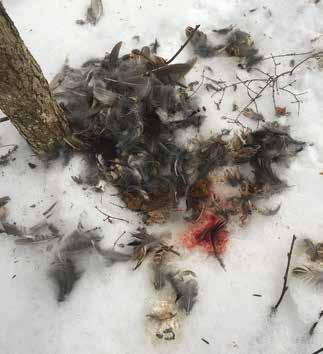
Wild Kill
Near the end of a backcountry ski across Wild Goose Knob, I stumble upon a fresh kill in the woods – strewn gray feathers and sprays of crimson blood on white snow. As soon as I spot this kill, I think about this being an opportunity to teach my daughter about wildlife tracking and life and death in the wilds. I study the scene just enough so my daughter maybe thinks her dad knows what he is talking about. Ten, I ski home a few hundred yards to my daughter who is having a playdate with her best friend. Tey build a soon-to-tumble snowman.
As sunshine warms us, I ask the fve-year-olds, “Do you want to see something I found in the woods?”
Te girls excitedly yell, “Yes!”
After putting on cross-country skis, we glide into the woods. Balsam fr, red and sugar maple, white ash, and beech swallow us. Te light dims.
When we near the kill site, we take of our skis. “What do you notice?” I ask as we skulk toward thrashed snow, as predators might.
My daughter’s friend says, “Look, Mr. Sean, feathers,” pointing at scattered partridge feathers.
My daughter asks, “Is that blood?”
“It sure is,” I say. As I look at blood speckled across snow like red rain drops, my mind wanders to the deer I’ve shown my daughter after I’ve shot them while bow hunting. Deer dead in the back of my pickup or hung from garage rafters.
62 vermont almanac | volume 1 v december
I return to this wild kill. “What could have made these tracks?” A set of tracks leads to blood and feathers. Te tracks show four symmetrical toe pads shaped like a diamond.
“A bear?” one of them asks.
“Bear tracks would be bigger. But it might be a fox or a coyote.” I’m not practiced enough to distinguish between the two, but I know these prints are canine. Te three of us follow the tracks to a small crater in the snow. I say, “So, a fox or a coyote crept this way, and then we have this crater. What created it?” Te girls puzzle long enough that I ask, “Where did these feathers come from?”
“A bird!” they shout.
“Exactly,” I say. “A partridge plunged into the snow last night to stay warm, but this fox or coyote found it.” I think about the shock of death, whether from a canine pouncing, the sting of an arrow, or sufocating from Covid. Nearly four years ago, my brother caught Covid. Being an athlete, we expected him to breeze through.
“How, Mr. Sean?” my daughter’s friend asks, wondering how foxes and coyotes fnd a partridge hidden beneath snow.
“At night, when the fox or coyote was hunting,” I say, “it smelled the partridge under the snow, and it pounced. Te partridge tried to fy away, and it almost made it. But, see right here,” I say, pointing to a rupture of feathers in snow that is speckled with blood. “ Tis is where the fox or coyote bit into the partridge.”
As the three of us follow the story etched upon snow, I return to the memory of my brother. Multiple times, he went to the emergency room because he felt as if he was drowning. Doctors told him to go home and only return if he turned blue or passed out. Many nights, my brother recorded video messages for his son in case he died in his sleep.
In front of us, the girls and I see a patch of pristine snow where the partridge nearly escaped. Ten we come to another patch of trampled snow, festooned with gray feathers and blood. “Right here is where the fox or coyote killed the partridge,” I say.
“And then what happened?” the girls ask.
“ Te fox or coyote took the partridge away to eat elsewhere,” I answer.
As we gaze at blood and feathers, at a speculated death, I wonder what these girls think of this kill scene. Luckily, as of today, neither girl has experienced the death of a loved one. But our daughter has heard her mother and me whisper uncle, will he live or die, I’m scared. Te girls also have three grandparents between the two of them fghting cancer and our daughter has grandparents who recently lost their home in a fre. And we’ve all been witness to and part of a series of climate challenges and weather disasters. With all of this fear and devastation blizzarding around us, I wonder if I bring death too close, if I should protect these girls for another day or week or year.
“What do you think? Are you glad we visited?” I ask.
My daughter’s friend yells, in the way only fve-year-olds can, “ Tat was cool, Mr. Sean!”
With this partridge kill shared, its mystery unraveled, we click into skis and glide toward home. I am happy these girls want to spend time with this old man in those old woods. But as we ski out of the forest and with January’s sun returned upon us, I pray death stays there – in the shadows – that there are no tracks leading toward any of us or our loved ones for many years.
When we reach home, my daughter sighs and says, “Our snowman fell over.” Te two girls click out of their skis and work to rebuild him. —Sean Prentiss
stories from & for the land 63
RLooking Out for One Another
December continued warm. Statewide temperatures for the month averaged 7 1 degrees above the 20th century mean, and the 30year average wasn’t far behind that. Montpelier came in at 6 9 degrees above normal – on December 30th it was 61 degrees in the middle of the night. It was the third December in a row that Burlington cracked the top-ten-warmest-ever list, and they’ve been keeping records for more than a century.
Te big weather story of the month was an unforgettable storm on the 23rd that unfolded in acts.
Te frst act featured more than two inches of rain, which in mountainous areas fell on a fairly heavy snowpack. (A storm on the 17th had dumped more than 20 inches in some areas.) Te rain was accompanied by ferocious winds. One gust in Burlington topped 70 miles an hour, the second-highest gust ever recorded
there. On the top of Mount Mansfeld wind speeds hit 130 mph.
Temperatures at the beginning of the storm were in the high 50s, but in a mere four hours they plunged 30 degrees. Rain turned to snow and a blizzard warning was issued in northern Vermont. Even when it stopped snowing, the wind howled and the temperature kept dropping, down into the single digits. Windchill values were between 5 and 20 below zero in much of the state. 98,000 people lost power, many for days and some for nearly a week, meaning Christmas was celebrated by candlelight. Or, for the line crews working tirelessly to restore electricity, in a bucket truck.
Te Times Argus published an eloquent editorial on the day after Christmas memorializing the event, which is excerpted here:

WHILE THE HOLIDAY STORM OF 2022 brought out the worst in Mother Nature, it brought out the best in Vermonters.
Te imminent danger of the storm was of grave concern. Te hype and harbingers proved to be painfully accurate. (A woman died in Vermont when a tree fell on her as a result of the high winds; there was signifcant property damage.) Governor Phil Scott, while concerned about the wind damage and outages, was more concerned at the time with the cold snap that was to follow. He acknowledged that the arctic blast was the thing that was “keeping me up at night.”
Te storm became the great leveler – literally and
64 vermont almanac | volume 1 v december
WEATHER
A sign of hope in Middlebury after the pre-Christmas storm.
GREEN MOUNTAIN POWER
metaphorically. Te wind stripped away our electricity, but it also blew away our pretentiousness, our politics and our pettiness. It made the season of giving signifcant, because what was being shared in many cases were acts of kindness and generosity. On back roads on Friday, as drivers were trying to get to safety, or get out to help others, strangers were clearing trees and debris blocking the way. Tere were lawyers and teenagers and mechanics clearing blowdowns together. Tey all were asking the right questions: “Is there anybody farther up this road we should check on?” or “Do you know if they have a wood stove or backup heat?”
Roadside meetings were not discussing last-minute Christmas shopping, but rather who knew someone with a chainsaw or a generator. Te race was on to beat the frigid weather.
During the widespread power outages, texts could sometimes eke through. Smartphones proved their worth in relaying assurances, urging calm, or asking for help. Te holiday became very inwardly focused, as families – many who had to abandon grandiose plans – hunkered down in candlelight and shared time without screens. Our focus became on patience. (Non-stop holiday songs on a portable radio have a completely diferent “feel” in the dark.)
Tat’s not to say it was idyllic by any stretch of the imagination. It was (and is) not
easy. It is about making do. Media reports (including ours) suggest a violence from this storm. Tousands of Vermonters are still without power. Homes will have been damaged (and potentially ruined) by this storm and the ensuing cold weather. It will take weeks to tally the damage.
While memories were made, so is the self-refection on what storm preparedness looks like for the next time. What did we learn? What is our plan? Where can I get a generator (and the corresponding electrician to make the back-up system work)? At one point, there were more than 75,000 Vermonters without power. (As of noon on Monday, there were still several thousand homes across the state without power – mostly in Central Vermont; and in some cases it may not be restored until closer to the end of the week or the weekend.)
Te truth of the matter is that Mother Nature’s gift this year is one that will keep on giving. Tese strong storm cycles are not random. Tey are not fukes of nature. Tey are a result of changing weather patterns – cycles whose root causes are changes to our climate. (Te reasons for those changes are likely the topic of many “around the wood stove” conversations this week.)
Leafng through the latest Vermont Almanac, a collection of articles, commentaries and data compiled – now for a third consecutive year – about
all things Vermonty, there are monthly examinations of our region’s weather. In 2021, there were either temperature shifts or weather events that were referred to as “unusual” or “extreme” or “uncharacteristic.” (Part of Volume 4 basically wrote itself, and its authors are going to need a thesaurus to accurately explain this storm and its efects across the state.)
It will happen again. Some forecasters would say what is happening to Bufalo, New York, coupled with the storm this weekend, is the frst sign of a shift in weather patterns across North America. As one commentator on Vermont Public noted, “It’s out of our control.” Perhaps. Tere is comfort, though, in knowing we still can fall back on each other.
Largely, we are grateful we live in a state where neighbors look out for one another. Tose connections are not always made in the rush of our overcomplicated lives. But we saw that we did not need a screen to manifest our interaction and connectivity. In recent days, we problem-solved for one another in order to ensure safety. We were (and are) willing to go the extra mile to move the tree, open our homes, or deliver provisions.
For all of the anxiety the storm provided, we hope the governor rested better in the days since knowing that Vermonters were (and are) looking out for one another in this year’s darkest hours. — Steven M. Pappas
We looked back at our weather summaries from the past three volumes of the Vermont Almanac and saw that December 2021 was atypically warm – the fourth-warmest on record. December 2020 was also unusually warm – the sixthwarmest on record. December 2019 was an average year in terms of both temperature and snowfall.
stories from & for the land 65
Bear Blood
People sometimes develop excessive blood clots – uncomfortable and potentially dangerous – if they are immobile for just a few hours on an airplane. Hibernating bears, though nearly motionless for months at a time, need have no fear of such an outcome. By comparing summer blood with winter blood from 13 wild bears, scientists recently identifed a protein, HSP47, that helps blood clots to form. Platelets that lack this protein don’t stick together, and hibernating bears have only one-fftieth as much of it as active animals. Tis discovery may lead the way to developing a drug that reduces the danger of blood clots without causing excess bleeding. Other hibernating animals, as well as people who have long-term immobility, also have low levels of HSP47. —Virginia Barlow
Snowshoe Hares and Climate Change


In my 15 years living in northern New England, I’ve never seen a snowshoe hare (Lepus americanus), despite spending plenty of time in their boreal habitat, and seeing lots of tracks, scat, and browse. Tere’s a good reason for this: snowshoe hares’ speckled brown summer coats blend into the shadowy conifer forests they call home, while their white winter coats are perfectly camoufaged against snow. Tere’s only one problem –winter snow cover is becoming less reliable, and a white hare against a brown landscape is about as un-camoufaged as you can get. While this contrast increases my chances of fnally spotting this elusive critter, it’s bad news for the hares, which are preferred prey for everything
from bobcats, coyotes, and lynx, to martens, fshers, and owls. Tis type of mismatch is known as a phenological asynchrony. Asynchronies are better known between species, such as plants and their pollinators, but, as with hares, they also happen between animals and their physical environment.
Tis asynchrony can make a real diference. Studies have shown decreased hare survival in years when snow cover comes late and animals stand out. Snow cover is based on climate and weather, whereas snowshoe color change is linked to day length. Historically, decreasing day length more reliably signaled that snow was on the way and that it was time to shed the brown summer coat. But with climate
CHELSEA CLARKE SAWYER 66 vermont almanac | volume 1 v december NATURE NOTES e
ADELAIDE MURPHY TYROL
HEADLINES LIKE
: “
POSSIBLE PLAN TO CUT OLD TREES
IN GREEN MOUNTAINS SPARKS DEBATE ” ricocheted through the news cycle this December – the stories under the headlines related to timber harvesting proposals in the Green Mountain National Forest. People who don’t want trees cut on public land described the 80-year-old trees slated for harvest as “old trees” and “mature trees.” Some in the media adopted the terms.
Of course “old” is a relative term when it comes to forest time, and is stand dependent. An 80-year-old fre cherry or gray birch, two pioneer species that quickly colonize disturbed areas, would in fact be old. On average, neither of those species lives much beyond 50, and neither are commercially valuable.
Te trees we typically associate with Vermont’s established forests have decidedly longer lives. Te average lifespans of yellow birch, beech, and sugar maple – the foundational hardwood species in much of the North Woods – are 150, 300, and 300 years respectively. (Tese averages are from the Canadian Journal of Forest Research.) Te average lifespan of hemlock, a major softwood component in these woods, is 450 years. If we were to express the age of an 80-year-old hemlock in human-lifespan terms, the tree would be 21
change often leaving bare ground even during the shortest days, bright white hares are spending more time in an increasingly brown world.
Tere is hope, though. Since seasonal day length won’t change and molt timing is genetic, hares and other winter-white animals like weasels will need to evolve to start their molts at shorter day lengths. Tat may not sound very hopeful since evolution usually happens over many, many generations, but it turns out hares already have the tools to do it.
First, hares are great at producing many generations very quickly – it’s what they and their rabbit cousins are known for. And with intense selective pressure by predators, evolution towards better camoufage can
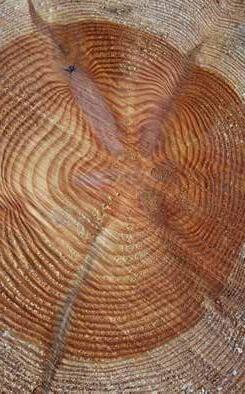
happen very quickly, too. We know this because diferent populations of snowshoe hare have diferent molt timing that corresponds to the local snow conditions. Tis means the hares on Camel’s Hump could molt days or even weeks apart from those in the Northeast Kingdom or those on Mount Snow, each population precisely matching the historical local conditions. Tis timing is genetic – a hare moved from one area to another will stick with its inherited molting schedule, not change to match the local population.
But what if snow cover doesn’t just start later and end earlier in the future? What if, as most models suggest, it’s just entirely less predictable, with more months of thin, patchy
snow and more epic snowstorms? It turns out the hares might have an answer for that, too. In some areas with unpredictable snow cover, like the Pacifc Northwest, hare populations contain a mix of individuals, some that turn white, and others that stay patchy or stay brown in winter. Each year, predators eat more hares that are poorly matched to that winter’s snowpack, while the better-matched individuals survive to reproduce, changing the balance of white, brown, and patchy hares over time to match the changing climate. Will we start seeing patchy hares in New England in the coming decades? Who knows, but I like knowing that snowshoe hares are ready to adapt, even if it might take a while. —Chelsea Clarke Sawyer
stories from & for the land 67
As the days grow shorter, it seems the “to do” list grows longer. Of all the dreaded get-ready-for-winter chores, it seems the one most shunned till the last minute is, quite naturally, the dirtiest one of all: cleaning the wood stove and its stove pipes.
Whether you do it yourself or hire a professional to clean your chimney, disassembly and cleaning of stove pipes is essential to remove ash, soot, and any creosote. It’s a flthy job, and in case you’ve ever wondered what a 19th -century boilermaker looked like after a 10-hour workday, cleaning the black carbon goop out of the pipes will aford you a chance to fnd out frst-hand, in about 10 short minutes.
You’ll fnd that some cleanliness is essential, though it’s the secondary goal in this game. Why? Because leaving your carbon footprint behind on the carpet can put you in the penalty box for an afternoon or an entire evening. All the grub work is best done outside, after carefully lugging the clinking, clanging collection of cantankerous pipes outdoors in garbage bags. Tere, you can get dirtied-up to your heart’s content, marvel at
•
Stove Pipe Blues
the fall colors (if you didn’t wait until December), and even enjoy a Vermont craft beer while you toil. Te tools required are simple: a face mask, paint scrapers, steel wool, wire brushes, and a powered drill ftted with a wire brush. Te rest is all elbow grease, black grime, and mufed curses.
Once you’ve cleaned the pipes, the rest is easy – or is it? Te frst attempt at reassembly may have the pipes on your stove looking as be jiggered as the Tin Man in Te Wizard of Oz after the fying monkeys got done with him. But you’ll fgure it out – eventually –and wash your hands in triumph. But, wait… Tere’s more! Te job won’t be complete without steel-wooling away any rust on
the stove and pipes, and applying and bufng-out some good oldfashioned stove black, which is actually a sort of wax. Tis fnal step will leave you looking (and perhaps feeling) like a coal miner who’s just clawed his way out of a cave-in.
So, after all, what’s the beneft in this ritualistic, oftprocrastinated fall stove pipe cleaning? For one thing, fre safety. For another (if your spouse or partner relies on a wood-fred cook stove) it will assure you of the continuation of stove-top cooking (read: hot meals to eat without interruption). Consider, if you will, that getting sooty and grubby in this arduous job is a Vermont tradition; for anecdotal proof, look no further than the Norman Rockwell painting “A Helping Hand – Te Coal Sessions,” which shows an old-time storekeeper and his apprentice tackling the dreaded annual cleaning chore. And also, this, if you’ll permit me (with apologies to Mark Twain): Clean the pipes for your wood stove frst thing in the fall and get it over with, and nothing else will make you flthier the rest of the day.—Philip R. Jordan
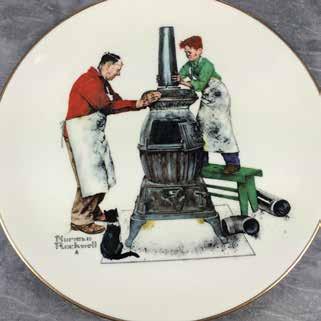
68 vermont almanac | volume 1 v december AT HOME
Te Shoulders We Stand On
As we pull together this book, we often think of the people who started this work that we do, showing and telling people that a rural life, full of dirty hands and communion with the natural world, is a meaningful life. We all know names like Wendell Berry and Helen and Scott Nearing from the late 20th century, and that these writers and thinkers stood on the shoulders of people like Aldo Leopold and John Muir from the early part of the 20th century, who in turn stood on the shoulders of Toreau and other proto-environmentalists from the 19th century.
But we just learned about this passage in Faust, by Goethe, which was probably written around 1773 – so 250 years ago. Faust is a depressed, aging intellectual who makes a deal with a truth-telling devil named Mephisto, who brings him to a witch’s lair to drink a nauseating potion that will make him young again. Te potion and scene are revolting, and Faust asks: isn’t there an easier way? Here’s the dialogue that follows:
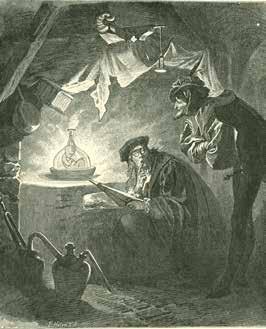
MEPHISTO
Once more, my friend, thou talkest sensibly. Tere is, to make thee young, a simpler mode and apter . . . . . . Betake thyself to yonder feld, Tere hoe and dig, as thy condition; Restrain thyself, thy sense and will Within a narrow sphere to fourish; With unmixed food thy body nourish; Live with the ox as ox, and think it not a theft Tat thou manur'st the acre which thou reapest;— Tat, trust me, is the best mode left, Whereby for eighty years thy youth thou keepest!
FAUST
I am not used to that; I cannot stoop to try it— To take the spade in hand, and ply it. Te narrow being suits me not at all.
MEPHISTO
Ten to thine aid the witch must call.
Isn’t that wild? Tat 250 years ago there was an awareness of what we lose when we abandon rural ways? And Goethe himself perhaps would have told us that the theme predated him by yet another 250 years.
stories from & for the land 69
An Appreciation
One bright early spring morning 55 years ago, I broke my way through the thin ice of a local marsh in central Vermont to check two traps and was thrilled to fnd my frst muskrat. As the icy water poured in over the tops of my cheap rubber boots, I paid little attention to my feet rapidly turning numb while proudly holding the furry rodent aloft for my buddy standing on shore to see. Tis one event would change the course of my life, helping to launch a career in wildlife conservation. All these decades later, I cannot hear the song of a red-winged black bird perched on a cattail without reliving this transformative moment in my life.
I took my brother and the neighborhood kids trapping. I watched them catch their frst muskrat and labor over skinning and stretching the pelt. Together we roasted muskrat meat skewered on sticks over a campfre. On the trapline they learned about life and death, honed their woods skills and experienced a unique connection with the natural world and wildlife that simply can’t be experienced any other way. Tese are memories they carry with them as adults today.
Will Staats, in a 2023 op/ed that ran in VT Digger
If you know Victory, Vermont, at all, you probably know, or at least know of, Will Staats. His house, near Gallup Mills, has barrels full of moose sheds out front. His blue Toyota with the kennel in the back is a fxture on the bog road each fall. Even if you’re not from Vermont, you might know of him, thanks to a Boston Herald story last spring in which the author called him the greatest athlete that ever lived. (We learned, in that story, that in his pursuit of moose sheds each spring he walks 10 to 15 miles a day.)
If you follow politics in
Vermont, you know that a special interest group has been lobbying legislators to ban trapping in Vermont for at least fve years, and Staats has emerged as an eloquent defender of the pursuit. Te attention he pays to the cultural elements shines. Trapping is often defended on practical grounds: Isn’t the status quo, where trappers work within scientifcally determined seasons to keep furbearer populations stable, better than an unchecked cycle of boom and then rabies- or mangedriven bust? Isn’t the status quo, where a trapper removes the

nuisance beavers that are fooding a homeowner’s driveway for free and uses the fur and meat, better than the proposed alternative of hiring this work out to a licensed exterminator?
Tese are all persuasive points, but Staats takes a diferent approach:
Vermont prides itself on its inclusivity, welcoming and respecting a diversity of people who share our tiny state. Why, then, would anyone attempt to erase our trapping and hunting culture, which has been practiced in this state since Indigenous people stalked through Vermont’s virgin forests?
We caught up with Staats to talk about meat and other uses of furbearing animals. Most of his recipes for game refect his on-themove lifestyle – he spoke of stews he could come home to, protein over a backwoods campfre with trapping mentor Barry Forbes, or a braised beaver dish that was thin-sliced the next morning and eaten on the trail like a roast beef sandwich. We went a little more savory with this recipe, perfect for a night by the woodstove after a long, cold day afeld.
—Dave Mance III
70 vermont almanac | volume 1 v december
Will Staats at home in Victory.
Beaver Cheesesteak
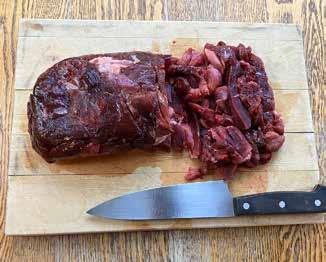


INGREDIENTS
beaver meat water salt peppers and onions
nice cheese
nice bread
METHOD
Te key to this recipe is the meat preparation. Skin the beaver, remove the castor and anal glands, and then wash or swap out your knife. Tese glands are large and pungent, and you don’t want any of that to come in contact with the meat. (Note that it’s a taste hazard, not a health hazard.) Once the glands have been removed, butcher the carcass by focusing on the hams, shoulders, and backstraps. Freeze the meat all together in a lump, then when you’re ready to cook, just partially thaw it. You want ice in it so that it slices thinly and cleanly.
Prepare a brine using the ratio of 2 tablespoons of salt and 2 tablespoons of maple syrup to one quart of water. Add the thinly sliced beaver meat and let it soak for an hour or so.
Tin-slice the peppers and onions to roughly the same thickness as the beaver meat and then saute the vegetables in a frying pan. When the onions are translucent, move the pan so only the front half is over direct heat. Move the vegetables to the cool side of the pan, add the beaver meat to the hot side. Cook it well – beavers can carry trichinosis even though they’re vegetarians – but because the meat’s thin-sliced, this won’t take long. Moisture will come out of the meat, and by the time it’s gone, the meat should be thoroughly cooked. Add the cheese of your choice, and when it’s melted, fold the cheesy meat and veg together.
Serve over good bread.
stories from & for the land 71
A LOOK BACK
Mad River Glen and the Natives
My brother David and I were born and raised in Waitsfeld. I remember riding to the mountain in 1947 and 1948 with my dad to watch the construction of Mad River Glen ski area, which opened in 1949. My late ex-father-in-law, Howard Moody, was the frst manager there. Howard had been a ski instructor at Stowe for a number of years, so he knew Roland Palmedo, part-owner of Stowe, well. Roland became disenchanted with the way skiing was being commercialized, and so he left Stowe, founded Mad River, and then hired Howard to manage it. “Moody’s,” formerly Moody’s Creek, is named after Howard, who supposedly skied into the small brook on a day when the ice wasn’t quite as frozen as it looked.
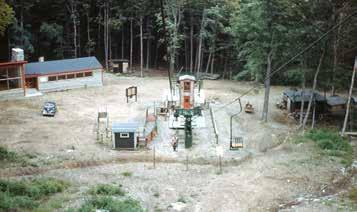
Te Mad River Glen “base box” (or main lodge) in 1948, just before the ski area opened.
boiler room to keep the coal-fred boiler stoked to maintain heat for the skiers.
My dad, Riford S. Joslin, worked in Sig Buchmayr’s frst ski shop, which was in the basement of the base box, which is what they’ve always called the main lodge. On his way to work he’d bring pies and cakes that my mom and Martha Moody baked on Friday nights and Saturdays to supply hungry skiers at the snack bar.
Palmedo’s vision for Mad River was an area where the skiing was the focus. Because of this, lodging was never a priority, and in the early days there was insufcient housing for the infux of skiers who focked there. Many Mad River Valley natives would rent out empty beds every weekend to the visitors. Even then, there were not enough beds to accommodate the skiers. Many Friday and Saturday nights the assembly room on the second foor of the old Waitsfeld High School became a ski dorm. Folding Army cots were set up in the assembly room and probably on the stage too. My dad was one of the villagers who would volunteer to sleep on a cot in the
David and I learned to ski at Mad River Glen on Franny Martin’s rope tow, which was powered by a Model A engine. We went through many pairs of mittens and at least one jacket each year. I started working at the mountain during the 8th grade on the packing crew. Back then they didn’t have any Sno-Cats, so high school kids would ride to the top, stagger themselves across a trail, and then sidestep on skis down the mountain to pack the trails. Raymond Weston, one of two adults who supervised matters, always tried to sneak us in some vertical skiing without being caught by Roland or Ken.
In high school and college I worked every weekend and vacation at mid-station, most always with Bover Graves. I vividly recall the lack of restroom facilities at mid-station. By working on the single chairlift, David and I got to know most of the skiers and their children by name. During the summer of 1961, I mowed trails by hand and helped pour the concrete tower bases for the frst double with a gas-powered, hand-fed cement mixer. Te gravel for the concrete was shoveled into burlap bags, fve shovels per bag, and then taken to the
72 vermont almanac | volume 1 v december
COURTESY OF STEVE JOSLIN
•
loading deck of the single. A single bag of gravel was then put onto each chair and taken up to mid-station. Tere, each bag was unloaded by hand and put on a trailer pulled by a dozer and transported across to the new lift line where it was shoveled into the mixer. David also worked through his school career, and two winters after college, sanding the parking lot, packing trails with Billy Stearns, running the lifts, mowing trails, pouring concrete for the new Birdland lift, and driving a Sno-Cat with Jack Larrow. He also ran the snack sled at time, which was a snack-flled box on skis that would be pushed around the base area.
I remember the great bands that played at Birchluf every weekend – this was the frst place in the Valley where you could go for this sort of entertainment. Also, sneaking libation at the Dipsy Doodle, an old horse barn that a bunch of ski patrol guys had turned into a bring-your-own-bottle club. I was not 21 at the time.
David and I, along with most of the other Valley kids who worked at Mad River, have fond memories of the place, particularly regarding those incidents when we did not get caught doing the sorts of things that kids do. Tey would make another essay.
We smile now, recollecting our run-ins with boss George Neil – King George as he was known – on the single. It was his kingdom.
I remember spending one night in the Starks Nest, shoveling out the chairs at the top in the morning after a heavy storm so that the chairs would not drag in the snow and pull the cable of the bull wheel.
Occasionally a mechanical failure would mean we could not ride down the lift at the end of the day. We would ride a barn shovel, the handle out in front, down the Porky to the bottom. God forbid that the handle got stuck in a mogul.
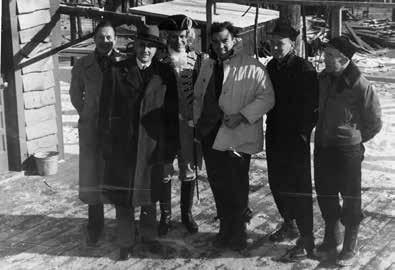

Te author’s mother, Betty Joslin, with his brother David, being loaded to come down by George “King George” Neil in 1948
I was asked only once to help change a pulley assembly, and it was on tower #10. I was afraid of heights and used both feet and both hands to hold onto the top of the tower; I was not much help. We would swing into the tower from the moving chair and climb to the top and jump onto a moving chair coming down to leave.
When I and several other Valley boys came home from the Army in 1967, Ken Quackenbush, then manager of Mad River, ofered each of us a season’s pass in exchange for occasional help with ski races. During the frst Iraq War I suggested the same to the current ownership, and they quickly adopted the policy.
When Mad River became a co-op, owned by shareholders, I became an owner and later passed my ownership share on to my daughter, Cara, granddaughter of the frst manager of Mad River. She and my son, Seth, have both skied Mad River Glen. David’s sons and their children continue to squeeze in an occasional run. Te place was and is a small ski area, used mostly by families. It holds a special place in my heart. —Steve Joslin
stories from & for the land 73
Opening day in 1949, including Howard Moody, third from right.
Northeast Slopes
Many Vermonters know they live in a state that thrives on community. Almost every town has folks who will tell you all about local history, the sights to see, the accomplishments of their neighbors. Tese towns are like big families, with all the nitpicking, internal disagreements, and ultimately, contentment with having a united sense of place and belonging.
Corinthians, as the people of Corinth are called, will bring up Northeast Slopes as a singular point of pride for them. On Route 25, between Bradford and West Topsham, this hill has pulled together more local efort and goodwill, has given more kids afordable starts to lifetimes of skiing, and has seen
more sustained action over the decades, than any other hill in New England. To be sure, along the way, there have been squabbles, resentments, and disillusions. But something about this north-facing feld on a slope has transcended all that and kept the small-town treasure going for almost 90 years.
As the story goes, back in 1936, within 20 years after the world’s frst ski resort opened in France for the growing numbers of people practicing the relatively new wintertime activity of alpine skiing, the Bradford Winter Sports Club was established.
Rural Vermonters appeared to be enthusiastically receptive to an outdoor occupation that was about enjoying winter, not just surviving it, and a hill in

For nearly nine decades Northeast Slopes has been a local ski area that brings the community together.
BY
74 vermont almanac | volume 1 v december
PHOTOS
BRIAN CARROLL
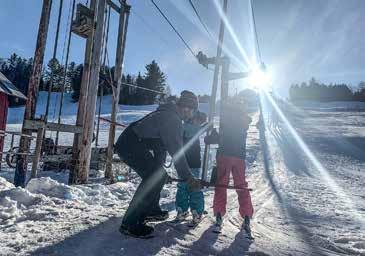
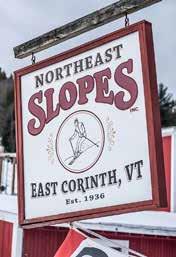
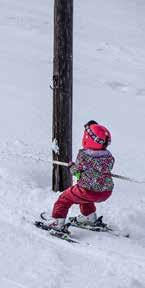

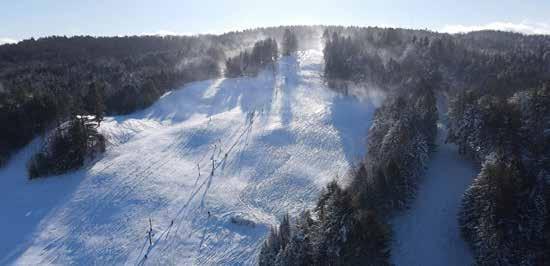
stories from & for the land 75

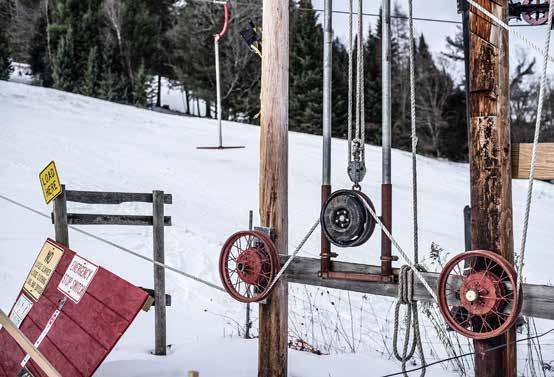
Not exactly the latest in lift technology, but Northeast Slopes’ auto-powered tows get the skiers up the mountain with ingenuity.
76 vermont almanac | volume 1 v december
Bradford was donated to the cause. Tat winter’s snowfall proved to be uncooperative. By December, the hill hadn’t yet turned white. On a trip to Montpelier, George Eaton, the club’s president, drove up Route 25, and saw that the Eastman Farm hill in East Corinth was blanketed by six inches of snow. Perfect. If the mountain wouldn’t come to Mohammed….
He stopped, met with Eugene Eastman, the property owner, and a handshake agreement got the club on skis that very winter. Tings happened much more quickly back then: no studies, committees, or fundraising required. All you needed was a piece of land, a couple of guys with an idea and the energy to put their shoulders to the wheel, and the idea turned into reality.
By the end of January 1937, the Bradford club had brought Mohammed to the mountain, overseeing the relocation of its 750-foot-long tow, allegedly run with an old REO station wagon, a bunch of rope, and Model-T wheels. Parallel to the Big Tow, a smaller 400-foot-long Small Tow was erected. In early February of 1937, skiers were driving up from as far as New York City in pursuit of the combination of lift service and snow. At one point, it was said, 175 people were being pulled up to schuss down with a similar number of spectators watching from the road.
Tis keen reception inspired the crew to install a 1,400-foot-long tow with 360 feet of vertical gain by the following season, powered by a Buick engine running skiers up the hill at 15 miles per hour. A 150-foot-shorter version of this same Big Tow is still running today, 85 years later, as is the Small Tow.
In 1962, Eugene Eastman and Weston Blake –the brains and muscle behind the hill – were ready to retire, so an organization of other locals and devotees formed Northeast Ski Slopes Tows, Inc., and the frst gas-powered groomer was purchased, replacing the horse-drawn harrow. But rope tows are notoriously tough on gloves, coats, and arm muscles. Couple that with the exponential growth of commercial ski areas and their lifts attracting the elite mobs from afar, and Northeast Slopes struggled as a business working with an afordability model on a local level. It was a hard way to not make money.
In 1972, the frst plans for a T-bar were drawn up, though the idea couldn’t get of the ground. Te 70s challenged the Vermont economy, and the Slopes limped along until 1986, when fnally, to survive, it became a not-for-proft organization, totally
dependent on the free labor of volunteers, from top down. Parents of kids who skied there, kids who had grown up on the slopes and remained connected to the place, locals who recognized this was a community gem – all came together with a grass roots energy, which also galvanized a renewed T-bar efort. In 2009, donations, fundraising, and more vigorous volunteer support made the needed upgrade a reality.
Reports on the kinds of engines used to power the lifts have varied, but one form or another of a USmade car or truck continued to be used and serviced by the local gearheads who love the simplicity and eccentricity of a system that repurposes the function of a drive train. Nowadays, a 1973 Dodge Dart runs the Small Tow, a Ford farm truck runs the Big Tow, and electricity runs the T-bar.
In 2023, volunteers continue to run the whole show. Every summer and fall, when cows aren’t grazing the Slopes, volunteers weed whack, bushhog, and get the trails in shape, maintaining and preparing the tows and T-bar for another season. Volunteers coordinate ski sales and arrange the loaner equipment, clean and sweep the buildings and sheds, update the website, answer emails, and tend to myriad more granular details.
All winter long, volunteers open the lodge and groom the trails for every skiable Wednesday afternoon and weekend for the public, and Fridays for the after-school program for local children. Tey teach, cook, and serve hot meals, beverages, and snacks, and also organize box races and music festivals. Te whole crew does snow dances, and children pray for snow. Te lifts keep skiing accessible and real for everyone. It has become what is considered to be the longest-running rope tow ski area in the USA.
Nowadays, the generosity of so many characters donating their precious time keeps Northeast Slopes going. Te president of the board earns the same salary as the Small Tow operator: nothing. Each pair of giving hands shares credit for turning out legions of skiers for whom the big ski resorts have been, and still are, out of fnancial reach.
Generations worth of kids have grown into adults with the warmest memories of Northeast Slopes, where community still comes together to make healthy, wholesome, outdoor recreation happen. And if the concept of volunteering doesn’t go the way of the dodo, Northeast Slopes will keep churning out skiers for generations to come. —Tania Aebi
stories from & for the land 77
Vermont’s Lost Ski Areas
Downhill skiing in Vermont began as early as the mid-1800s, when enthusiasts frst climbed uphill before sliding down. Te state was mostly unforested then, so there were plenty of open, rolling hills to choose from. Te sport became more formalized in 1934 with the installation of the frst ski lift in the country, a rope tow powered by a Ford Model T engine, built on Gilbert’s Hill in Woodstock. Te popularity of skiing boomed after World War II as 10th Mountain Division soldiers returned home and began developing and marketing dedicated ski areas across the country and starting companies that ofered improved ski equipment and apparel.
Vermont became a prime ski destination, easily accessible from metropolitan areas by regularly scheduled ski trains. Ski tourism in Vermont began in earnest.
At one time there were more than 200 ski areas operating in Vermont, from small community tows to bigger areas with multiple lifts. Today only 12 survive. For over 20 years, the Vermont Ski and Snowboard Museum in Stowe has been compiling historical information about Vermont’s now defunct lift-served ski areas.
In December 2023 the Museum opened a new exhibit called “Searching for Vermont’s Lost Ski Areas,” featuring 195 of these venues and highlighting the unique character of ski hills where lifts are no longer spinning, with many now overgrown. A wall-sized map accurately pinpoints the location of each lost area, and accompanying information and artifacts are on display. Learning about Vermont’s lost ski areas is an ongoing project and the Museum (vtssm.org) hopes to garner new information as more people become engaged with the exhibit and programs. Four of these “lost” ski areas are profled here – information and photographs provided by the Vermont Ski and Snowboard Museum.
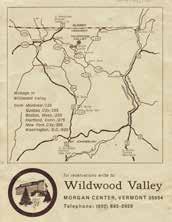
WILDWOOD VALLEY , MORGAN CENTER
Morgan Center may not seem a likely place to develop a ski area. Located near the Canadian border, no major roads run through it, and the nearest population center of any size is Newport. Still, the Yoder family decided to develop a ski area
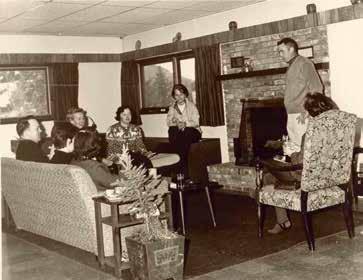
in the late 1960s to capitalize on the tourist-driven economy.
Wildwood Valley opened in 1967 with a 550-foot rope tow, a 1,082-foot T-bar, a base lodge, and two trails. An advertisement for the area states that it had ski rentals, a snack bar, a lounge with a cocktail hour, and also served dinner by reservation. A bus service brought people to the area from local lodging facilities. Season passes were $65 for adults and $45 for children under 12
Te area ran a school ski program for Brighton School. Students in 6th through 12th grades were bussed from school in Island Pond to Wildwood Valley on Tursday afternoons. Wildwood Valley closed in 1970 after just three seasons.
Après ski at Wildwood Valley.
78 vermont almanac | volume 1 v december
In the 1930s, the Underhill Winter Sports Club saw an opportunity to develop skiing on the western fank of Mount Mansfeld, much like what was happening in Stowe on the eastern side. Te Civilian Conservation Corps developed a road up to the Halfway House and cut the Tear Drop ski trail, designed by Charlie Lord, from the Mansfeld ridge down to the Halfway House. Te Tear Drop trail still exists today. A 30-meter ski jump was also built nearby, but lift-served skiing was never developed around the Halfway House.
In 1937, the ski club enlisted Sepp Ruschp (that’s an Austrian name if you’re wondering) from Stowe to help plan and build a rope tow. Ruschp had built the frst rope tow on the Stowe side the season before. Te chosen location was the Eagan Farm, which was located at the base of Mansfeld, near the village of Underhill Center. Unlike the steep, tree-lined trails being cut higher on the mountain, the Eagan Farm was a 75-acre open slope with 300 feet of vertical. An 800-foot rope tow was built and opened for the 1937-38 season.
While it never became a tourist destination like Stowe, the Underhill Ski Bowl became popular with local communities in the greater Burlington area. Tis included UVM, which hosted intercollegiate ski meets at the Bowl in the years before WWII.
Te Durbrow family acquired the Bowl in 1946 and made many improvements through the years,

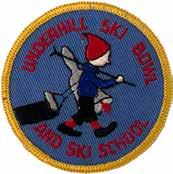
including the frst night skiing in northern Vermont. In 1965, they installed a Stabil Disc Lift, which is very similar to a Poma lift. Under Bill and Em Durbrow’s leadership, the Underhill Ski Bowl was a popular family area catering to kids. Often they
hosted 200 to 300 skiers a day. In 1973, the Underhill Ski Bowl cut back operations to weekends and school vacations due to the increased competition of large nearby ski areas and rising operational costs. Te expense of insuring the area forced it to close for the 197879 and 1979-80 seasons. Te Underhill Ski Bowl reopened again for weekends and holidays for two more seasons, but closed for good in the spring of 1982.
stories from & for the land 79
Ski bunnies at the Underhill Ski Bowl, an area popular with families.
UNDERHILL SKI BOWL , UNDERHILL CENTER
NORWICH UNIVERSITY SKI AREA , NORTHFIELD
Starting in the 1930s, as many as eight small ski areas popped up around Northfeld. Most were short-lived, but what became known as the Norwich University Ski Area survived into the 1990s.
In 1936, Northfeld locals organized a Ski and Outing Club, and close study of the Woodstock rope tow led them to build one of their own on what was originally known as Ski Tow Hill. Tis was the third rope tow built in Vermont. Eventually, a 40-meter ski jump was added at that location.
At some point, Norwich University acquired Ski Tow Hill and the name morphed into the Norwich University Tow. Some accounts claim this happened as early as 1939, but certainly by the end of World War II the area was owned and operated by Norwich University.
In 1962, Norwich added a 1,000-foot Poma lift to the area, which expanded the skiable acreage. Te University then invested $200,000 in 1970 to build a 3,000-foot-long Hall double chairlift. Tis extended the vertical to over 900 feet.
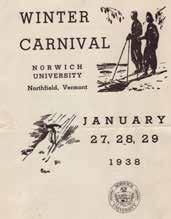
Operations were expanded to seven days a week, and the area ofered rentals, repairs, a snack bar, a National Ski Patrol chapter, a ski school, and grooming equipment. Norwich University was ofcially in the ski area business.
In addition to providing an easily accessible skiing venue for its students, the area provided locals with a family ski experience
in the 1980s when the area added a child-friendly Mighty Mite lift.
Lack of snowmaking and increased expenses, particularly the cost of insurance, led to Norwich University closing the area in 1993 Te chairlift was sold to Pat’s Peak in New Hampshire, where it still serves as the “Vortex Double.”
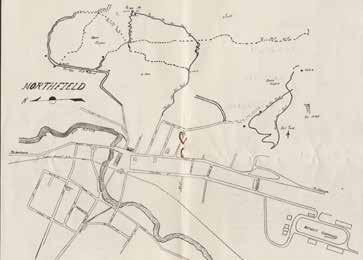
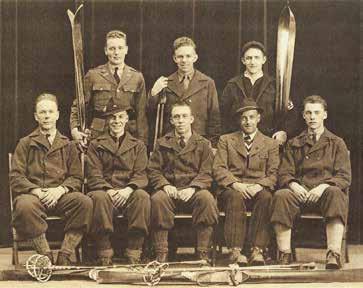
80 vermont almanac | volume 1 v december
Te Norwich University ski team in the 1930s.
DUTCH HILL , HEARTWELLVILLE
In the 1930s, skiing in the Massachusetts Berkshires became popular and formal ski areas started to pop up even before liftservice was ofered. By the early 1940 ’ s, Webster Ottman, a leader of the North Adams Ski Club, was looking for new skiing terrain to handle the growing demand. His search brought him just across the border into Vermont, where he found a hill in Heartwellville, part of Readsboro, that showed promise. Called Dutch Hill, it was named for the Dutch who settled the area in the 1700s. Ottman purchased 46 acres in 1943 and cleared some trails. Te following season, a 1,000-foot rope tow was added and the area opened on December 22, 1944. A base lodge warming hut, eventually known as “ Te Boot,” was built for the 1945-46 season. Te area boasted 570 vertical feet of skiing.
Te area grew in popularity and eventually acquired a total of 380 acres. A 2,000-foot T-bar opened on January 1, 1947 More base facilities were added, including equipment rentals, and a ski school was established.
Te 1950s were Dutch Hill’s “hey day.” Ski trains brought city skiers to North Adams, and
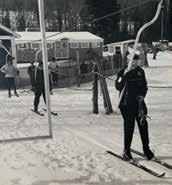
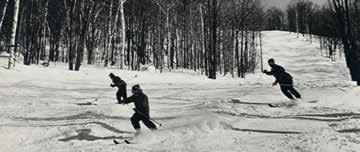
Dutch Hill’s proximity (just fve miles away) made it a popular destination. Dutch Hill was ahead of its time in promoting ski vacations; it provided marketing flms of the area to ski clubs and distributed brochures to ski shops throughout the Northeast. In 1955, a New Jersey journalist dubbed Dutch Hill “Little Stowe.” Celebrities such as Lowell Tomas, actress Celeste Holm, and Doris Day came to Dutch Hill. Its popularity forced the
State of Vermont to extend Route 100 to provide better access to it. By the late 1960s, Dutch Hill’s popularity began to wane as skiers moved toward bigger and more challenging areas. Te Ottman’s sold the area in 1968 and the buyers subsequently operated the area on weekends and holidays only. In 1977, the name was changed to Dutch Mountain. A bad snow year in 1979 and a lack of snowmaking forced Dutch Hill/Mountain to close in 1980
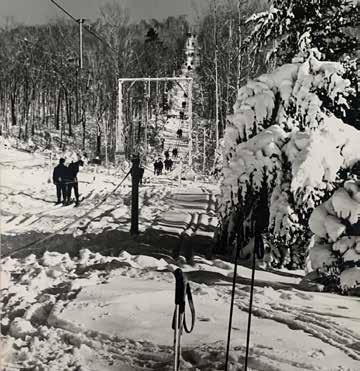
stories from & for the land 81


82 vermont almanac | volume 1 v sponsor
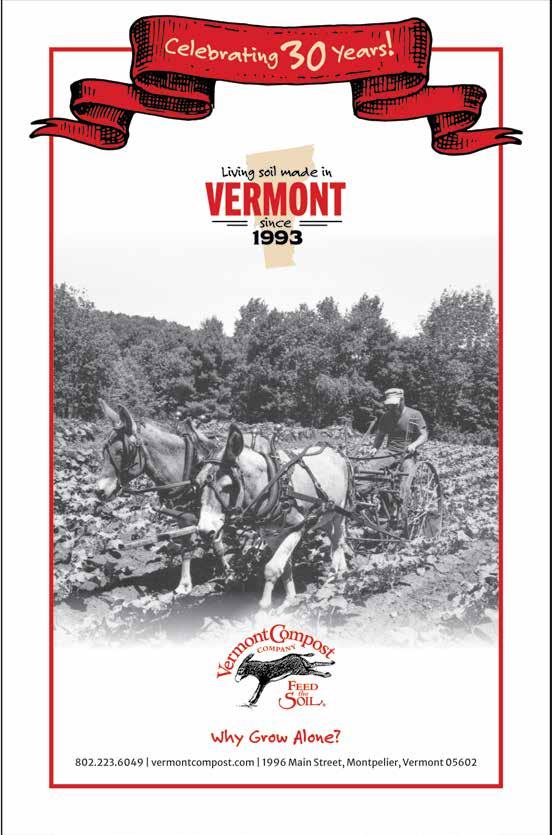
stories from & for the land 83 sponsor
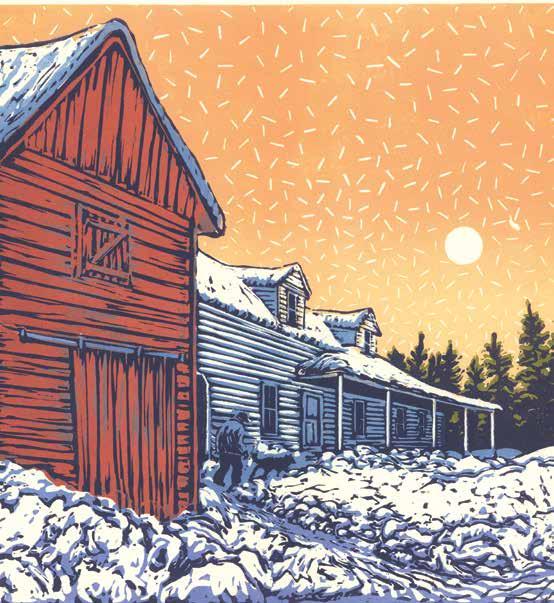
JANUARY
stories from & for the land 85
Just Tat Much
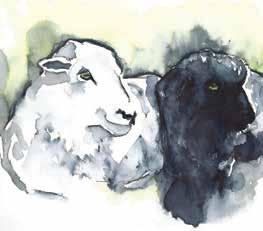
NOW : SOMETIME AROUND MIDWINTER
Te sheep gaze steadily at me with their pale, moonscape eyes. A gray wool phalanx faces me like a living stone wall, their purple tongues fickering out nervously to lick their split lips. Te temperature is fve degrees and windy, and they are ready to run. Catching them is not going to be easy.
THEN : THIRTY YEARS AGO , LATE SUMMER AND THE FOLLOWING SPRING
Eleanor lives down the hill in an old red farmhouse set back from the road. Her long driveway is framed by sturdy sheep fence, black-eyed Susans, and Queen Anne’s lace. I walk slowly through the summer heat, knowing it will be cool inside her kitchen. Pausing, I watch the sheep grazing on the uphill slope of her little farm, where they stay to the deep shade of the forest edge. I feel hesitant, as I always do, when I drop by to visit her. She lives alone. I am never sure if my visits alleviate her loneliness or interrupt her solitude.
I pass through the gate between the barn and house, move beyond her small yard and tidy garden with its abundant herb beds. I enter the mudroom, with its many coat hooks, wood rack, and lots of space for barn boots. A small sink for washing up is of to one side. I breathe in the mudroom’s distinctive scent – musky lanolin, fresh-cut wood, sweet, grassy manure – a mixture that anchors me to the earth somehow, even now. On the other side of the door I hear Lizzy, her border terrier, bravely and fercely announcing my arrival.
Eleanor answers my knock and smiles broadly, gesturing me inside. Lizzy’s tail wags perfunctorily, and she licks my hand once before she turns away, her duty done.
Te inside of Eleanor’s house is rustic, plain, and purely functional. A large soapstone sink, set at a slant for drainage, sits under the kitchen window with a view of the barn and driveway. Te foor is unfnished wide pine boards, and the wood stove at the center will pulse with heat when winter comes. Her chair by the fre, the living-room furniture, are all crafted of warm wood, polished by use. Te honey spinner stands in the hall like a shiny steel chalice. Light flls the back room on the south side where her piano rests in a corner.
Eleanor is tall and thin, with long limbs and
86 vermont almanac | volume 1 v january
ART BY HEIDI ALBRIGHT
gnarled, knobby hands. Her fne white hair, cut short, is often windblown and resembling a tuft of thistle caught on a hedge. Her face is deeply lined from either a life spent laughing or squinting in bright sunlight. Likely both, or perhaps an unspoken loss in her past. Despite being wiry, she has a solidity to her, as if gravity operates diferently in her presence. I don’t think I ever saw her rush to do any task. She usually dresses in jeans or corduroys, a wool sweater over a button-down shirt, and a hat with earfaps in winter.
I give her wool socks every Christmas, and she always delights at the practicality, the warmth, of my gift.
“Tea?” she asks as I take my place at the table. It is our habit to visit at her round kitchen table, with its generous pot of honey, a butter keeper, and an assortment of jams. We share a common love for toast, tea, and conversation, and this has become our ritual. She pulls out her camp toaster, a four-sided contraption that sits over the burner on her cook stove, and loads it with slices of bread. Lizzy settles at her feet, and I think to myself: I have found the center of the world
While we have only known each other a short time, Eleanor has become my mentor and a dear friend. She is 75, certain and centered. I am 19, unsure of my place in the world, who I am becoming.
We talk. And over many cups of tea, many slices of toast and honey, she tells me her story. She turns the pages of her life: as a single mother, bookstore owner, sheep farmer. She asks me what I dream of, how I want to live my life, who I am becoming. Silence sits with us on some days, balanced between us, not uncomfortable. Often our visits take us out to her garden, where she divides herbs for me to take and plant in my own garden, and I leave with gifts of thyme, tarragon, and sage.
Tat winter she invites me to help with lambing season. In March, in Vermont, the snow still lies heavy on the ground. I pack my toothbrush and pajamas, walking downhill in the twilight to her house tucked into the blanket of the mountain. We share a dinner of soup and thick-cut slices of wheat bread slathered in butter. Scottish oat cakes and chamomile tea send us to bed early.
She shows me to her guest room on the second foor, a room I had never seen before, up under the sloping ceiling of the old cape house, with wide cracks in the foorboards to let the heat upstairs. A bright,
heavy quilt on the bed promises deep restfulness. Eleanor’s room is across the top of the stairs, and I am too shy to peek in and see how she sleeps, to see her most personal space.
I hear her get up in the night – we have agreed to take turns checking on the ewes – and then return shortly. No lambs yet. Ten, in the early morning, I slip to the barn to fnd a ewe in her lambing pen breathing hard, a breech birth. She is exhausted, and the lamb nearly out.
I feel panic rising, and hear Eleanor’s calm voice telling me earlier, “If someone needs help, you look to what they need, and what they can do for themselves. Ten you help just that much,” as she held her crooked fngers apart a few inches.
I crouch beside the ewe and, as she pushes, I grasp the lamb’s hind leg and pull just that much, helping it slide from one world to another. Outside, the sky is wheeling past the stars to emerge in newborn translucence, the dark folds of the mountains defning earth and sky.
THE TIME BETWEEN THEN AND NOW
Te seasons pass. I move to coastal Maine, seeking the vast, steady horizon of the ocean. At frst, I keep in touch with Eleanor and we exchange regular letters. A few years later, when I go to college, the technological age begins. Email becomes the new way to communicate. Of course, Eleanor doesn’t have email. She doesn’t even have an electric toaster!
When visiting my parents, I sometimes call to say hello, but even that tapers of. I manage to visit Eleanor a few times, but with longer and longer gaps. One visit I realize Lizzy is gone. Another time I drop by while my infant son sleeps in the car, no time for tea. I am not sure when she stops keeping the sheep, but I notice the felds are now overgrown with burdock and thistle, the barn empty.
I send photos and cards every year around the holidays, and a few more pairs of socks. Her letters in return are brief, her handwriting growing even shakier.
Ten more years go by. My kids are no longer babies. After his father’s passing, we move to my husband’s childhood home, a hill farm in central Vermont. Remembering the lanolin smell of her mudroom, the
stories from & for the land 87
gaze of the sheep from the shadowed pasture, I decide to get my own small fock. Four sheep come to live on the farm, for fber and pasture improvement, and to fll a hollow space in my chest. I feel unbearable happiness to look at them, like small clouds nestled up against the mountains encircling our lives.
On one trip home to see my parents, I decide to call Eleanor. She answers after many rings (no answering machine either), and when she hears me say I am in town, she says, “Well, get over here and visit!”
I drive over slowly, embarrassed by my decadelong lapse in attention.
At 99, Eleanor sits in a wheelchair now, no longer striding to the barn on long legs. She has become nearly translucent, balanced between two states of being. Her friends and neighbors helped move her bed to the sun-flled room on the frst foor and prepare all her meals on a rotating schedule. She still has her solitude but is not alone.
Te light is dimming, she tells me. She is slowly going blind. Her red-rimmed eyes shine for a moment though, when I tell her I have my own fock of sheep now. “ Ten I have a gift for you! It is out in the barn, hanging from the loft ladder. You’ll know what it’s for.”
She confdes that she feels herself fading away, and she knows it’s her time to go.
Eleanor is not a demonstrative or sentimental person. But I know I have to tell her how important she is to me, how much she helped to orient me in this world, how much she helped me begin my own story. So when I hug her goodbye, I look into her otherworldly eyes and tell her I love her. I say it the way her little border terrier Lizzy would have: bravely, fercely.
She only nods, and reminds me of the gift in the barn, to make sure I take it on my way out.
As I leave, I see photos of my family, my handmade cards still decorating her fridge, all held by magnets that haven’t shifted in years. Before driving away, I step into the dark barn and fnd only one thing hanging from the loft ladder, exactly where she left it – a smooth and worn shepherd’s crook. Eleanor passed a few weeks later.
NOW : SOMETIME AROUND MIDWINTER
It is a frigid day, and the biggest ewe was limping this morning. To examine her foot, I will need to
catch all of them in a small holding pen. I hold the shepherd’s crook in my hand, the smooth, bent ashwood polished by Eleanor’s callouses, years of hard work, and sheep lanolin. A small splinter catches my glove and reminds me that I haven’t caught enough sheep yet to keep it greased and limber. Te sheep know it too. Tey know the crook means capture, and also that I am not very quick with it. Perhaps they have a chance to escape?
I enter the enclosure, shifting the crook between my hands. It is a matter of catching them as they run past, then push-pulling them into the holding pen. Sometimes it goes well, sometimes it takes a few rounds and we all end up breathing hard, uncertain.
I start by trying to move them with my eyes, giving them a hard stare, as a dog would. Tey watch me warily while stamping their feet to bolster courage. As I advance to press them into the pen, the young wether bolts past. All but one follow him to the far side, heads up, indignant.
Te oldest ewe, Abbi, remains behind, evaluating the situation. Seeing the crook, the holding pen behind her, and her friends on the far side of the enclosure, she weighs the options. I give a small wave of the crook, and, amazingly, she turns to walk calmly into the pen. Good girl, I whisper. Smart girl. She knows there will be grain.
I turn toward the others and take a step. Tey bolt again, circling wide around me to follow old Abbi into the pen. I shut the gate behind them and exhale into the winter sky. Just that much.
One of my favorite things about sheep are their honest faces, their keen eyes that can read your intentions before you realize you even made them. Abbi is nearing the end of her days, and on another farm she would have been culled years ago. But each time I look at Abbi, I see Eleanor’s fading eyes and her unwavering grace at the end of her life, already seeing what lies beyond the edge of this lifetime. She held her ground, and also knew when to go. Until Abbi’s eyes tell me otherwise, I’ll bury my hands in her feece, spin and knit her wool into warm things to give away.
Rolling a sheep on its back or rump is the easiest way to shear them or check their feet. I have been told they hold still in this position because, without a horizon to run toward, they are profoundly disoriented. Perhaps it is like hypnotizing chickens, laying them on their backs and stroking their breasts while their primitive claws grasp the sky, the very opposite of scratching
88 vermont almanac | volume 1 v january
the solid earth. It is a pause, a place where everything is turned around, where the world they know has vanished and they are thrown to an unknown cosmos. Surprisingly, they are grounded there, knowing that even though everything is spinning around them, they remain in the center of it all.
I don’t know if it is relaxation, an altered state, hypnosis or paralysis, but once I manage to position the lame ewe onto her rump, I am grateful to check her foot without more of a struggle. She has become astonishingly solid and immovable, a great gray boulder generating more gravity than a small planet. I can fnd nothing amiss with her leg, so I trim her hoof to be sure and step away. Just that much. She rights herself, shakes her woolly feece to regain her horizon, and runs toward it.
NOW
What is the horizon that sustains our equilibrium? Te baseline balance of up and down, sky and earth, vapor and solidity? Tese last few years have turned us all on our rumps, forced us to pause and contemplate an unknowable time. It has made us ask, who am I? And: where is the center of things?
I’m not sure I’ve ever known anyone as centered as Eleanor, or someone who lived so bravely, so fercely. It has taken me all these years to realize her solitude was not alone-ness, but living (and dying) at home with who she was, where she was. Tat authenticity has become my compass, the anchor or horizon line that orients me when I am most confused.
Many of us strive to live our lives without regret, so that when death comes we are ready – there is nothing we would change about how we lived. I will never know if Eleanor had regrets, because we never talked about that part, the ending of the story. We only talked of the living, the being, the becoming. But when I last saw her, as she was slipping from our world to another, there were no doubts about how she lived.
Her memorial announcement contained one of her poems. It could have been the last poem she wrote, or the frst, or one centered in that bright and heavy quilt that was her life. It embodies her surety, her knowledge of where her own horizon lay. She gave me just that much, enough to fnd my own unshakable horizon. —Heidi Albright
SILENCES
Consider the turtle, traveling with grave optimism
Trough vast seas; in every saline molecule a memory of the forgotten shore that awaits her eggs.
Undertake your own journey through immensity, Not impatient, needing to be nowhere else.
In the void, what flaments of healing kinship appear, what intimations of the cosmic braid?
To transcend our separateness – that is the art of living, beyond confusion, composed.
Eleanor Trowbridge Adams 1916-2016

stories from & for the land 89
Warm on a Scale Never Seen
Even by the extreme standards of the past few years, January was an extraordinarily warm month. According to NOAA data, the statewide average was 12.1 degrees above the 20th century mean, and 9.9 degrees above the 21st century mean. It was easily the warmest January in recorded history. January 2023 was, on average, 15 6 degrees warmer than January 2022. Te Norwich Historical Society published side-byside weather journals, one written by Ebenezer Brown in 1873, the other written by Alan Berolzheimer (director of book publishing at the Vermont Historical Society) in 2023. Here’s a taste of the January entries, which show just how radically diferent the weather in Vermont has become. As Berolzheimer’s diary suggests, January 2023 was essentially one big thaw.


Average morning temperatures: what a diference 150 years has made.
We looked back at our weather summaries from the past three volumes of the Vermont Almanac and saw that January 2022 was a rare colder-than-normal month. Temperatures averaged 6.9 degrees below “normal.” January 2021 was warm – more than 3 degrees above the 20th century mean. January 2020 was also warm – more than 6 degrees above the 21st century mean.
90 vermont almanac | volume 1 v
WEATHER R
january
EBENEZER BROWN , JANUARY 1873
1 We hail thee new year, new and loving friend. A pleasant day for cold winter. Ter. 4 below 0 in the morning and 10 at night
2 Ter. 10 below am and at 8 pm 19 above the sky overcast. I carried Ellen and Wm wife to their Aunt Ellen Hs. Charles & Wm thrashed the rye at Israel barn.
3 Warmer. A January thaw has begun, a little misty rain part of the day and fog. Ter. has stood at 40 a part of the day.
5 Sunday a very stormy day. Ter. 26 to 36 above 0. A sort of hail snow. about 6 inches deep.
10 Very pleasant cold day. Ter. 10 below at morn & 10 below at 9 p.m. C & Wm getting up wood.
13 Ter. 13 below at sunrise, grows moderate at 9 pm, 23 above 0, wind south. C & Wm getting up wood and pm they helped GM Slaughter a beef.
16 Warmer, quite a thaw, warm overnight.
17 Taw continues…brooks cleared of ice. Cold at night.
20 Cold morning. I went to mill with corn. C & Wm chopping at the door
29 Cold clear day. Wind N. Ter. 20 below 0, not rising to 0 at any time. Very cold eve. Ter. 20 below at 9 pm… the coldest day and night of the season. GML & wife called this eve.
30 Very cold morning. Ter. 31 below overcast. Moderates p.m. Ter. at 9pm 5 above. Charles & William went to Hanover, got a new globe for the lantern to replace the one that I broke a few nights ago at 75 cents.
31 Cold weather continues but not as severe. I am mending shoes. Charles & Wm chopping at the door.
1873 TEMPERATURES :
Average morning: 0. Average evening: 3.
Low morning temperature: -31. High morning temperature: 26
ALAN BEROLZHEIMER , JANUARY 2023
1 Wet morning. I’m up with granddaughter Selah at 6 am. 43 degrees, lots of dark, fastmoving clouds. High of 47 degrees; 37 degrees at 8:30 pm.
2 Cloudy and 34 degrees at 8:30 am. Nice sun from mid-morning through mid-afternoon, up to 48 degrees. More bluebirds visit today, and a furry of other small songbirds. 38 degrees at 9:30 pm.
6 Lightly snowing, 35 degrees at 8 am. We get an inch over the course of the day. Temperature holds pretty steady. 35 degrees at 10 pm.
7 Overcast and 2 degrees at 7:30 am. Aviva, Mark, Selah, and the dogs return to Philadelphia after 2+ weeks. High today of 38 degrees. At 8 pm it’s 29 degrees. We got a little snow, big fakes, but it didn’t last long.
13 Light rain, a little fog, 36 degrees at 9 am. High today was 41. At 8 pm. it’s 33 degrees. Turkeys here again today.
17 Sunny at 27 degrees at 7:30 a.m. Turkeys are here this afternoon – now 27 of them! High of 49 degrees in the sun. Still 35 degrees at 9 pm. I’ll note that the Connecticut River has been open most of the month, very little icing; also true of December.
18 Overcast and 35 degrees at 7:30. Slight dripping mid-morning. Not much rain, mild, high of 43 degrees. 38 at 10:30 pm.
20 2 to 3 inches of snow overnight. Light snow and 31 degrees at 8 am. Light snow all day, not much accumulation. Approximately 4 inches total. High 35 degrees. 33 degrees at 11 pm.
22 Gray, overcast, 29 degrees at 9 am. Another day with little variation, high at 31 Snow starts early evening. Snowing and 31 degrees at 10 pm.
23 A couple more inches of snow overnight. Light snow and 31 degrees at 8 am. By the end of the day we have close to a foot of snow. High at 34 degrees. At 10:30 it’s 29 degrees.
24 Overnight low of 24 29 degrees at 8:30. Turkeys here for the frst time in a week. High at 35. At 10:30 pm. it’s 33 degrees.
2023 TEMPERATURES :
Average morning: 28. Average evening: 31
Low morning temperature: 2. High morning temperature: 43
stories from & for the land 91
e
Wildfowers in Winter
From stick season through winter to early spring, one’s attention to plants may shift toward the hardwood trees that become starkly beautiful without their leaves and the conifers with their contrasting green foliage. But many smaller plants remain in sight all winter, too, in winter garb that may seem less spectacular but nevertheless has a stunning beauty when we look closely.
Some wildfowers are completely invisible in winter, having done all their fowering, fruiting, and seed dispersal in the warm months. Others remain conspicuous. Teir stems provide habitat for a variety of insects. Teir fruits continue to disperse all winter, sometimes on the wind, sometimes on the fur of passing
QUEEN ANNE ’ S LACE
Wild carrot is another name for Queen Anne’s Lace (Daucus carota), and in fact it is the closest wild relative of the domesticated and edible carrot. Carrots were frst domesticated in Asia in the 10th century and have become a dietary staple worldwide.
Te wild plant is now found worldwide in all but the coldest and most arid climates. It is common on Vermont roadsides and in other open places.
Te umbrella-shaped fower clusters, characteristics of the whole carrot or parsley family, curl up after fowering, and bear spiny seed-like fruits that remain on the plant in that curled up state, to be dispersed gradually through the winter by latching on to the fur of passing mammals. 1
animals, sometimes as nutritious berries consumed and so moved around by birds and mammals.
A few plants are especially easy to identify in winter. Queen Anne’s lace and evening primrose are commonly seen along roadsides and in open places. Goldenrod and milkweed grace open meadows. Enchanter’s nightshade might be encountered on a walk in the woods. A walk on the beach or shoreline might fnd you brushing past poison ivy or gathering a cocklebur fruit on your socks. Te vines of virgin’s bower and bur cucumber vines might be seen on a moist feld edge. A visit to a bog or other wetland ofers winterberry holly and evergreen heath shrubs, among many other plants. —Liz Tompson
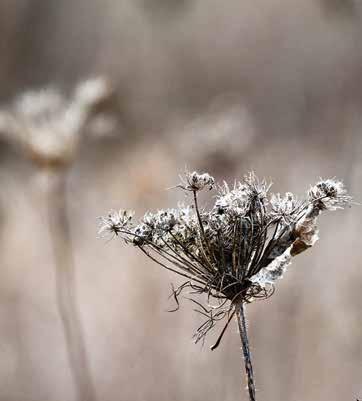
92 vermont almanac | volume 1 v january NATURE NOTES
1
BY LIZ THOMPSON
PHOTOS

EVENING PRIMROSE
Common evening primrose (Oenothera biennis) is a native plant that grows in the most inhospitable-seeming places – roadsides, powerlines, and gravelly soils. Related to freweed and willow-herbs, it has four fower parts – four sepals, four petals, and a four-lobed fruit. Te dry fruits of evening primrose persist through the winter, making the plant easy to spot and identify on roadsides and feld edges. 2
GOLDENROD
Vermont is home to dozens of diferent kinds of goldenrods, and as a group they are among the most obvious and most easily identifed of the wildfowers in winter meadows. Teir tiny fower heads often have plumed fruits remaining long into the winter, to be gradually dispersed on the wind. 3

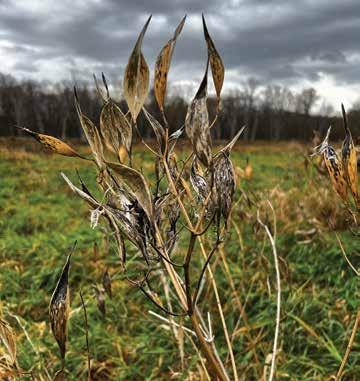
MILKWEED
Common milkweed (Asclepias syriaca) is easily recognized in winter by the persistent pods that slowly shed their tufted seeds starting in late summer, leaving the empty husks as reminders of the pale pink summer fowers and the butterfies that fed on them. Other milkweeds that occur in Vermont include swamp milkweed on shores and in wetlands, four-leaved milkweed in dry upland woods, and butterfy weed, a very rare plant of open places. 4
stories from & for the land 93
4 3 2
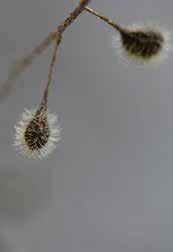
ENCHANTER ’ S NIGHTSHADE
Te tiny fruits of enchanter’s nightshade (Circaea alpina), an ankle-high herb of hardwood forests, can come home with you on your socks and fnd their way into your garden if there is a moist and shady spot. Tey are related to the evening primrose but don’t resemble it in obvious ways. In midsummer you will see tiny, white, two-petaled fowers on the delicate plants. 5
POISON IVY
Poison ivy is not always noticeable in winter, but the yellowish berries are distinctive when they are present. Tis plant was growing on a high bank along the Winooski River, where it was thriving in the sandy soil and full sun.
Tere are two species of poison ivy in Vermont. Tis is western poison ivy (Toxicodendron rydbergii), which has shiny berries and grows as a shrub. Te other one, common poison ivy (Toxicodenron radicans), has fuzzy berries and grows as a vine. Both contain a chemical called

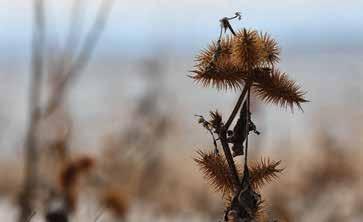
urushiol, which can cause a severe rash in humans. All parts of the plant are toxic, even in the dead of winter. Interestingly, animals can eat the berries without any problem, and many birds do. 6
COCKLEBUR
Cocklebur (Xanthium strumarium) is a low, stout plant of sand beaches that is reminiscent of burdock and is
related to it. Te fruits of both cocklebur and burdock are designed to stick to mammals to be moved from place to place. Cocklebur is related to sunfower; both are members of the aster family. Its fowers are tiny and almost invisible inside the bur. When the fruits are mature in late summer, inside the bur can be found two seed-like fruits that look just like sunfower seeds. 7
94 vermont almanac | volume 1 v january
5 6 7
VIRGIN ’ S BOWER
Virgin’s bower (Clematis virginiana), a native clematis, also goes by the names devil’s darning needles, devil’s hair, love vine, and traveler’s joy. It trails over other hedges, shrubs, and fences in moist places throughout eastern North America.
In late summer, clouds of fragrant white fowers can be seen from a distance on the twining vines. As the fowers mature, each tiny, dry fruit develops a long, tufted tail. Tese wispy fruits remain on the climbing vines through the winter, gradually letting go of the plumed seeds as winter winds blow through. 8
WINTERBERRY HOLLY
Winterberry holly (Ilex verticillata) is a native shrub that grows commonly in swamps and other low, wet places. It is a true holly, but unlike the holly we use in winter decorations (a more southern plant), the leaves of winterberry are deciduous.
Winterberries are cultivated as ornamental shrubs and some of the cultivated varieties have larger fruits than the native plants, but they are the same species. Male and female fowers occur on separate shrubs, so a planting needs to include at least one male plant so that the females can be pollinated by bees and other insects. 9
SHEEP LAUREL AND OTHER HEATH SHRUBS
Sheep laurel (Kalmia angustifolia) is an evergreen shrub in the heath family, the family that includes blueberries, huckleberries, cranberries, and rhododendrons.
Tese plants share an uncommon trait for Vermont plants – they grow best in acidic or nutrientpoor environments.
Sheep laurel is found in upland woods, especially sandy woods where nutrients are limited, but also in bogs and fens, acidic or otherwise. Several other
evergreen heath shrubs are found alongside sheep laurel in bogs and fens, and are easily seen and identifed throughout the winter. Bog laurel has shiny leaves that sometimes turn crimson, and leatherleaf has spotted leaves that get smaller as one moves up the stem. 10

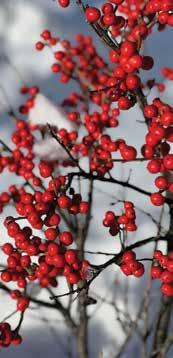

stories from & for the land 95
8 10 9

All in for Alliums
Iam in love with onions, enamored of garlic, and worship the shallot. Leeks rock, and scallions are pretty cool, too.
As cooks, we tend to take these culinary workhorses for granted. Peel of the papery skin, then chop, dice, mince, or sauté. Strip the leek’s outermost layer and slice the baton into half-moons. Dinner is underway as the heady aromatics permeate the kitchen.
In my last 15 years as a farmer, I’ve developed a deeper appreciation for these humble and varied members of the allium family. Once you nurture a plant
from seed, you form an intense relationship that starts the moment you tear open the seed packet on a cold winter day and ends months (and months) later when you reach for a baseball-sized onion, a fat head of garlic, or a conjoined shallot bulb, and build a meal around that earthly treasure.
My onions’ journey to table begins each winter, when in January we scour the seed catalogs and prepare my orders. In February, I drop the frst tiny black seeds into cells in a soil-flled fat. Te temperature outside the greenhouse is well
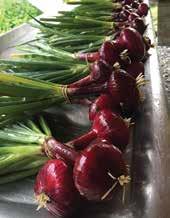
below freezing, but in my soul, the march to summer harvest has begun. Over the coming weeks, the seeds germinate and send up wispy shoots that grow taller, thicker, and stronger as March morphs into April. At our farm in Dorset, we grow multiple
BY
96 vermont almanac | volume 1 v january AT HOME •
PHOTOS
MARIA BUTEUX
READE
varieties of onions, shallots, and leeks. Come early May, we spend several days transplanting thousands and thousands of these alliums. Te sun shines strong on our backs as we nestle each tiny rooted bulb into the rich soil.
I’ll devote endless sweaty hours “ass up, elbows down” weeding those allium rows through June and July. My eforts are rewarded come high summer as we begin to harvest the frst onions, about the size of billiard balls. We hold of pulling the sturdier storage onions until August, waiting for their green necks to fop over, a sign that their growing is done. After feld-trimming the tubular tops and soil-caked rooted bottoms, we spread the yellow and purple-red onions on the dark, cool barn foor to cure and paper over. Slowergrowing shallots remain in the soil until September. Te leeks sweeten and thicken straight through November into early December. Bundled in a wool sweater, I use a turning fork to gently nudge the fat broomsticks from the chilly soil, their dramatic fronds tickling my nose as I carry armloads to my truck. Which reminds me: please honor the entire leek and use the darker green tops! Tey are deeply favorful and should never be wasted! Te same holds true for scallions.
And how about the stinking rose, aka garlic? Garlic follows its own cycle. When we harvest the waist-high plants at the end of July, we put aside the biggest bulbs and save them as our seed garlic. Te bulbs cure for the next two months. In the second week of October, we break them into cloves, keeping the papery skin intact. We plant each clove a few
inches deep in the soil bed. After lying dormant all winter under thick mulch, each clove will become a garlic head. Te bigger the October clove, the bigger the July bulb.
In early May, just as the onions in our fridge send out green shoots in their quest to grow anew, and garlic heads on our countertop become desiccated and hollow, wild onion chives emerge from the damp spring soil. Later that month, we’re on the prowl for ramps, which we harvest judiciously to preserve the coveted patches for future years. Garlic chives, scallions, and slender bunching onions appear at farmers markets in early June, followed closely by curlicue garlic scapes, which farmers lop of to concentrate the bulbs’ growth below the soil. Nature provides all of these fragrant seasonings, whether wild-grown or lovingly cultivated by human hands. So let us revere these humble and miraculous alliums! —Maria Buteux Reade
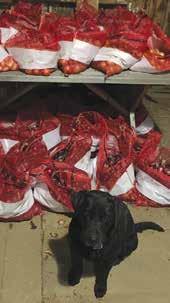

CREAMED LEEK TOPS
I don’t know about you, but it pains me to see those gorgeous dark green leek tops get pitched or composted. I thumb my nose at recipes that call for using just the white and pale green portions. Here, I treat dark green leek tops like a more favorful cousin of spinach.
INGREDIENTS
Makes 6 servings.
3 tablespoons butter
2 ½ cups leek tops, sliced thin
2 tablespoons all-purpose four ¾ cup heavy cream ¾ cup chicken or vegetable stock salt and freshly ground pepper
METHOD
Melt the butter over low heat. Add leek tops and braise gently for about 8 minutes. Sprinkle four over the top of the leeks and stir together, cooking for another 10 minutes, stirring occasionally to prevent any browning. Slowly add the cream and stock and stir well. Allow the mixture to boil gently and thicken, approximately 15 minutes. Season to taste with salt and pepper. Serve immediately. Delicious with grilled beef, roasted chicken, and baked or grilled fsh.
stories from & for the land 97 WHEREISMYSPOON.CO
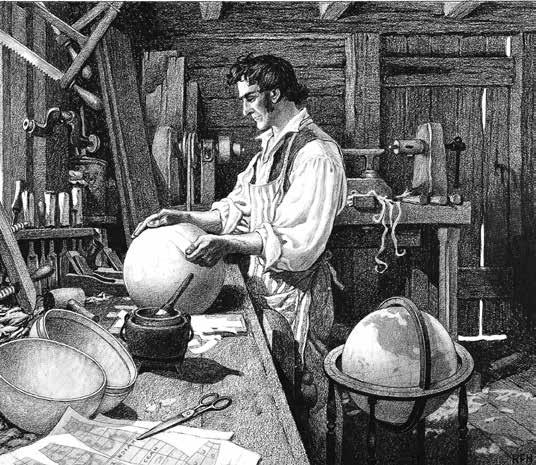
It’s a Small World
Tis story was excerpted from the Proceedings of the Vermont Historical Society, October 1959
In Bradford, Vermont, in 1796, in a community then only a generation removed from a wilderness marked with Indian trails, James Wilson completed his frst globe with scarcely any formal education, without beneft of the encouragement and example of learned neighbors, without the inspiration and challenge of an area steeped in the traditions of educational and scientifc achievement. What he did, he did from within.
Wilson was born on March 15, 1763, in Londonderry, New Hampshire, whence his great-grandfather, Alexander, had migrated in 1719 from Ireland. He worked on his father’s farm until he was seventeen years old, and then added to his knowledge of farming a profciency in blacksmithing which later served him well.
How this abiding passion for globes came into being, we can only surmise. Tat the political and
economic events of the day may have infuenced him has been suggested. Te Napoleonic wars were raging; England and France were locked in a bitter struggle; the so-called Louisiana Territory was engaging the active interest of France, Spain, Britain, and our Federal Union. As geography was a popular topic of conversation, we do not wonder that James Wilson became interested in world afairs.
In 1795 he set out from his New Hampshire home for Bradford, Vermont, there to visit his cousin and former blacksmith mate, James McDufee. On the way he stopped at Dartmouth College to visit a friend who was a student there. At Dartmouth he is said to have seen, probably for the frst time in his life, a pair of European-made globes.
Pushing on the remaining twenty-fve miles to Bradford, Vermont, he was struck by the beauty and fertility of the Coos meadows in this garden of New
98 vermont almanac | volume 1 v january A LOOK BACK •
ROY FREDERIC HEINRICH / LIBRARY OF CONGRESS
England at the confuence of the Connecticut and Waits Rivers. Here the parallel ranges of the White Mountains to the east and the Green Mountains to the west united to work their spell on him, and on July 27, 1795, he bought a lot of land in Bradford. Here the frst globe in America was made.
To help pay for this newly acquired land, James Wilson and his cousin made axes that winter. Settling on a new farm in a new town in a new state did not wholly interfere with the project nearest his heart, for within the year 1796, he completed his frst globe. It was a large, solid, wooden ball, covered with paper, with the continents and countries drawn in with pen and ink.
It was a long way from being a practical, satisfactory product. Many problems needed to be solved before James Wilson could hope to make a globe that would compete with those being imported from England for sale in this country. Problem one was his limited knowledge of geography, astronomy, and natural science. Attendance at winter school as a boy at such times as he could spare or be spared from the work at home was little preparation for the job at hand.. He solved problem one in a wholly typical manner. With one hundred and thirty dollars in cash, realized apparently from the sale of farm produce and stock, he went to Ryegate, Vermont, and purchased from Hugh Somers the third edition of the Encyclopaedia Britannica Te 18 volumes (14,579 pages; 541 plates) which he brought back to Bradford with him must have been his almost constant companions in his “leisure” hours.
Problem two involved the technique of engraving on copper. Trough his own eforts he had acquired considerable knowledge of this art, but realizing his need of greater skill and mastery, he made a journey to Newburyport, Massachusetts, for instruction. Tere John Akin of South Carolina, one of the best known of the early American engravers, asked him $100 for the service, an amount which Wilson did not have. Te mission had not succeeded. He returned to Bradford, and after a series of unsuccessful starts, went on foot to visit engraver Amos Doolittle in New Haven, Connecticut. Doolittle taught Wilson the basic things to be known about the process of engraving on copper, and the farmer-pupil trudged back to the Vermont banks of the Connecticut and got to work.
Te young mechanic did everything for himself. He made his own tools, his lathes, and his presses.
He did his own printing, made his own ink, glue and varnish, and cast and turned his own meridians. He designed all his own maps and labored with great trouble in connecting hair lines. It is said he worked a total of three hundred days on his frst large copper plate, and meeting with difculties in the problem of getting a true proportion of meridian upon a globular surface, went to see Jedediah Morse in Charlestown, Massachusetts. Morse told Wilson the remedies could not be made on the same plate, and the latter went back to his blacksmithing-globe-manufactory and started over again on some new copper which was obtained at great sacrifce on the part of all members of the family. Tis time he was successful, and James Wilson was on his way to fame and modest fortune
Te demand for these “made-in-America” globes seems to have been considerable and the merchandising of them successful within reasonable limits, at least. It is likely that globes bearing the name of James Wilson were sold in 1809, but the earliest sale that can be clearly identifed as to date is: “Jan. 18, 1810, sold Mr. Wellman 1 globe.” By 1813 or shortly thereafter, the globes had been introduced to Boston in a “perfected edition.”
Great care was taken not only in the making of the globes but also in the mounting of them and in the shipping of them. Te frames were of ash. Each globe was furnished with a brass quadrant and the screw at the bottom could easily be turned with the fngers without a screwdriver. Each globe was packed in a pine box of material half an inch in thickness, planed and dovetailed, with hinges and clasp.
In a very few years the Bradford shop was unable to keep up with the growing demand for the globes, and James Wilson, sensing the strategic location of Albany, New York as a sales center, formed a partnership with his sons and opened a manufacturing plant in Albany under the name of J. Wilson & Sons.
Te successful Albany venture was pretty much the responsibility of the sons. Bradford continued to be the home of the globe maker despite the developments in Albany; from his frst settlement it was home to him. It is said that he made frequent visits to the manufactory and encouraged the boys in their undertaking, returning to Bradford at the frst opportunity.
James Wilson died in Bradford, Vermont, on March 26, 1855, at the age of ninety-two years and twelve days. —Harold Webb Haskins
stories from & for the land 99
Timber Year in Review
The high spirits of Summer 2022, fueled by dry weather and high timber prices, started to wane during the fall, setting the tone for the last 12 months. Even those familiar with the fckle nature of the forest industry were dismayed by the dramatic swings taken by both the weather and the markets.
Entering September 2022, most of the state was considered to be in moderate drought. By the end of that rainy and cold month, an average of just under 6 inches of rainy relief had swamped most of the state, at the cost of operable logging conditions. Fall rains are a common and expected occurrence, but the soaking efects of these heavy fall rains lingered and tamped harvest productivity, shuttering many logging operations.
For loggers, late fall is a time for equipment maintenance, and there’s often a greater focus on hunting than logging. Landowners and foresters are prepping for winter harvests, which means painting trees to cut, fagging skid roads and harvest boundaries, and coordinating with loggers. We were all waiting for the right winter conditions to initiate projects. And wait we did.
Winter has traditionally been the ideal time for timber harvests, because when the ground is frozen, heavy logging equipment won’t break the soil surface. Te weather conditions required for that are an increasingly elusive combination of cold temperature
High and dry and snowy sites were in high demand during the winter. Here, Mark Foster Logging and Custom Cutting in Washington prepares a load of logs on January 15, 2023
and snow: optimally, nighttime temperatures below 15 degrees and daytime temperatures below 25 degrees. Wet soils don’t freeze nearly as readily as dry soils. Plus, deep snow insulates unfrozen ground, wet or dry, and delays freezing substantially. Consistent light snow is desirable, mostly to aid in traction but also to initiate a cold, packable frozen layer.
Logging operations are planned according to what should be a reasonable assumption about a Vermont winter: that it’s gonna be cold. Well, not during the winter of 2023. Warm, rainy periods continued through January and frozen conditions were elusive for most of the winter throughout much of the state. Loggers and foresters with multiple logging options in their quivers quickly realized that the only way to work was to pivot to higher (colder) and drier (easier to freeze) jobs. In central Vermont, I had to shift a logger from a typical upland hardwood project that wouldn’t freeze so that he could work on a dry sandy site. Another successful central Vermont logger I work with now actively pursues winter jobs above 1,500 feet in elevation, where winters are still more reliably cold.
Te reduced productivity during this warm, wet
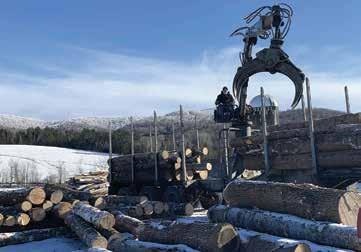
100 vermont almanac | volume 1 v january
INDUSTRY f MARK FOSTER LOGGING AND CUSTOM CUTTING
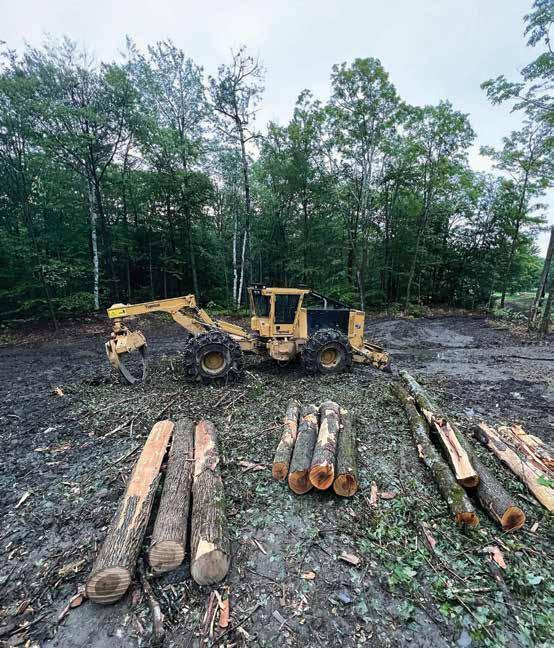
A soggy season. Emerson and Sons Logging equipment parked on June 29, 2023, in Brookfeld. And this was a week before fooding really shut things down around the state.
winter reduced inventory at sawmills as loggers had difculty meeting demand, albeit a reduced demand. Te silver lining, however, was that limited production buoyed prices. Te undersupplied sawmills were forced to keep prices moderately high through the fall and early winter. Cedar, a species that grows in wetter
soils, was very difcult to get to market this winter as those sites just didn’t freeze. Tis kept cedar prices at historic highs, at least through summer 2023, and even caused one northern Vermont cedar mill to shift part of its production to pine.
Te spring season started abnormally dry, creating
stories from & for the land 101
EMERSON AND SONS
LOGGING
expectations of a productive summer harvest season. Tat optimism sank in June with soaking rains. July’s rain events buried it. Te July fooding was certainly more damaging to civil infrastructure than to forest operations, and by the time those foods hit, forest operators had already been dealing with weeks of wet weather. Te continued rain prolonged the bad logging conditions and the grumpiness of forest professionals.
Wood markets remain mixed, though generally have continued their slump since autumn 2022 as demand continues to slide, corresponding closely with economic indicators. Prices for species such as spruce, maple, oak, and birch dropped 30 to 50 percent, while ash remained strong. Pine prices remained excellent through summer 2023, though landowners and operators are wary of pending future challenges. As timber harvesters wait the rain out, sawmills are likely to keep prices just high enough to lure log sellers once harvest operations become more productive.
Diesel prices, which constitute a substantial part

In a year that didn’t ofer too many great opportunities, loggers started early and worked late to move wood when the weather cooperated. March 7, 2023: Te last load of the day for Cunningham Logging and Excavation in Canaan.
of logging costs, have dropped 40 percent from their historic high in 2022, but still remain 150 percent higher than 2020 levels. Te most dramatic and controlling impacts of today’s markets are in lowgrade products like pulpwood. Tis especially afects products like pulpwood because the proft margin is limited even at the best of times, and it’s a long truck ride to a pulpwood mill as there are none in Vermont. A pulpwood log is a log with defects (rot, stain, knots) that make it unsuitable for lumber, and thus it is sold to make paper pulp.
Pulpwood appetites have gone from historic highs to historic lows. Worldwide demand for paper products, especially those made in the Northeast, has decreased, and new mills in other parts of the world are out-competing mills in our region. Te vast majority of trees in our forests are marketable only as low-grade material like pulpwood, and removing them during a timber harvest is an important part of good forest management. If there’s only a market for high quality trees, then they’re the only ones that will be cut, which leaves an impoverished forest. We call this high grading, and it’s not good. Pulpwood markets also allow loggers to use more of the trees they harvest. Often the lower, branchless part of a tree’s trunk goes to a sawmill while the top part goes for frewood or chips but, most frequently, as pulp. As pulp markets disappear, logs that could be sold as pulpwood may end up swamping low-grade lumber, frewood, and biomass markets, further reducing the prices loggers and landowners get.
Vermonters have the privilege of living among some of the world’s best and most renewable wood resources. Forest Inventory Analysis data show that we’ve been managing these resources exceptionally well. We Vermonters use wood, and we have both the knowledge and the means to sustainably harvest it for our needs and the needs of our community.
Summer soil moisture is one of the most important factors associated with tree growth, so maybe there’s an upside to this year’s deluges. It may turn out to be one of the best tree-growing seasons we’ve had in recent years, and if and when things dry and we’re ready to harvest wood, there'll be more of it. For now, in these down times, our hope is that our industry infrastructure and workforce is strong and nimble enough to survive weather and market pressures. Tis year, because we’re all wood users, try giving a logger a hug, they’ll need it more than the trees. —Allan Tompson
102 vermont almanac | volume 1 v january
CUNNINGHAM LOGGING AND EXCAVATION
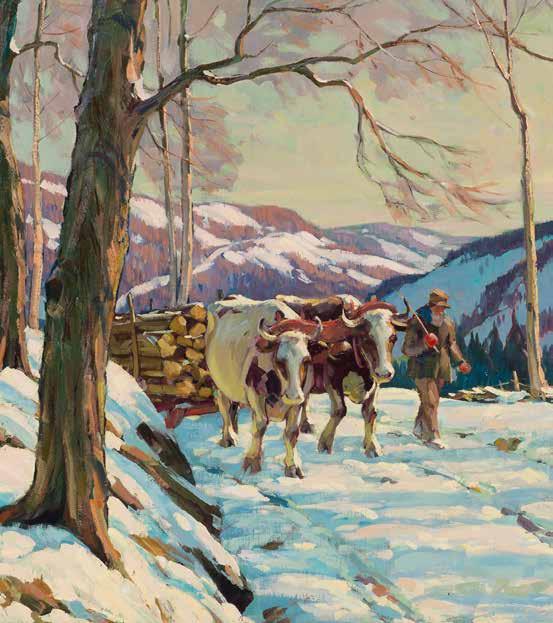
LOGGING WITH OXEN ( 1940 )
Tis oil painting by Leo Blake (1887-1976) was a particular favorite of ours. Blake painted this southwestern Vermont scene in 1940 – many of the paintings in the Orton Collection harken back to this mid-20th -century time frame. “I wanted to keep this art in the state for everyone’s beneft,” said Lyman Orton of the motivations behind his collection. “I didn’t want to see these paintings disappear from Vermont.”
stories from & for the land 103
COURTESY OF THE LYMAN ORTON COLLECTION OF THE ART OF VERMONT


104 vermont almanac | volume 1 v sponsor
When Copeland Furniture began in 1975, our goal was to make products from locally-sourced hardwood. Initially we built cider presses, then butcherblock kitchen furniture and Adirondack chairs, items that were functional and afordable for baby-boomers as they furnished their first homes.
What started as a one-man operation in an old garage in East Corinth has grown into a state-of-the-art company on the banks of the Connecticut river in Bradford. Today, Copeland ofers a line of quality hardwood furniture. Using a combination of leading-edge technology and craft technique, we create pieces that feature classic proportion and modern simplicity.
We still make our furniture out of hardwoods from the Northern Forest. And our facility is setting a gold standard for sustainable manufacturing. Making furniture is energy intensive. And with much of the furniture industry having opted to manufacture overseas, ocean transport of both raw materials and finished products exacerbates the already intensive energy consumption. Our furniture is made in America with American wood. In 2016 and 2021, we built 2 solar arrays that produce electricity equal to almost 100% of what we use.
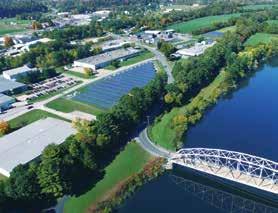
We’re proud to be building award-winning, heirloom-quality furniture in a virtually energy independent factory. And just as proud that this now 45-year-old Vermont company is embedded in the community and providing fulfilling careers for the men and women who come to work here every day.



Furniture Factory Outlet 241 Waits River Rd., Bradford, VT 05033
stories from & for the land 105 sponsor
Copeland
copelandfurniture.com

FEBRUARY
stories from & for the land 107
February
The wet dog month. Go away, go away, go on, git! Te month we want gone because we’ll be that much closer to spring. Te tiny, mousehole month when the dark presses in, when our houses contract. Everything feels smaller, tighter, itchier: the light, the kitchen, my pantry, my patience with wet mittens left in the schoolbags of my daughters.
Te month of missing ski socks. Tese expensive wool socks are only for skiing, purchased in November and handed out to Molly and Pearl with ceremony. Tey cost $25 a pair! Look, aren’t they beautiful! Aren’t they rare! Protect them with your lives! Te ski socks should travel directly from the laundry to the sock drawer to the child’s feet to the laundry to the sock drawer. Tis should be a closed loop. But many are missing by February. AWOL. I name them: Frank, the left foot blue Smart Wool striper, Mary, the right red Darn Tough, Stan and Betty, the best thin wickers. Casey, the knee-high gray veteran of two ski seasons, has lost his partner, Lieutenant Bill. I catch Pearl trying to borrow my perfect ski socks. I’ve had them for years, thin, durable soft wool: Hortense and George. Te heels come halfway up Pearl’s calves. “Take them of !” I shriek. “You are forbidden!” She pouts, “But I don’t know where mine are.” Te odd socks often can’t be re-paired as they are of diferent blends, diferent thickness. It would be like mating dogs and cats. Tey go missing like Pearl’s snakes when the lid is left loose on the tank, and sometimes they are found in the same way, in the same places: under the couch, in the couch, curled in the bottom of a bag, alone, sleeping.
Te month of equations. Will the woodpile last? Te hay? Te propane? I count and multiply and divide. Tese must sufce until May as heavy trucks won’t make it up the mountain road and certainly not our driveway during the April mud season. May glitters in the future. May with the green, uncoiling ferns so green I feel lust. My eyes haven’t seen green since October. In February, I almost can’t remember green. Yet February has its own palette: the crimson arcs of the blackberry canes against the white

108 vermont almanac | volume 1 v february
felds; the ochre-umber-sienna of bracken and sedge in the woods; the mauve tones of snow in moonlight when I take fresh buckets of water out to my horses because the fve o’clock buckets have already frozen solid. But even the most descriptive words inevitably diminish what I actually see at night: the luminous shimmering, the polished silvering, the snow globe stillness. As my horses drink, I feel wonder to be here, a human beholding the mechanics of the universe: the moon refecting the sun’s light as the earth rotates, the immeasurable energy and galactic force winnowing to this precise moment, my hand on my gelding’s shoulder, his thick coat, the water dripping from his lips, my breath frosting the air, an owl in the dark woods beyond the pasture. My gelding sighs, and so do I.
Te month I repair my barn suit with more duct tape. I bought this crucial piece of winter clothing in a thrift store in Lyndonville: a circa 1970s stylish snowmobile suit with a bright, slippery cherry-red outer shell. It’s well-insulated but cut for a woman of signifcantly wider berth and shorter legs. Yet the ample room within means I can put it on over my dressing gown, pull on my giant Lacrosse boots, top of the ensemble with my brother’s 10th Mountain Division olive green hat with ear faps and a Burke Mountain neckie and face the worst blizzard in total comfort. However, there’s a latch in the horses’ feed room that often catches my suit, ripping the faring hips. In December, I plan to repair this lengthening, widening tear – a cozy evening in front of the stove with a needle and thread, listening to a podcast on brain function or, better, conversation with Molly and Pearl about books and art. Perhaps they will read poetry aloud. In January, I move through denial (the rip isn’t that bad), anger (why the hell is that latch right there?), bargaining (Pearl will do the sewing repair if I let her go on Snapchat for 30 minutes), and depression (my children are intellectually illiterate, I haven’t read poetry in years, a grocery store clerk mistook me for an unhoused person whereas I am merely middle-aged and unfashionable). By mid-February, I accept that duct tape sticks remarkably well to the slick, waterproof exterior of the snowsuit. Instead of sewing, I drink wine and watch a police procedural on BritBox while my children further rot their brains with Minecraft.
Te month of snow. I skin up Kirby Mountain with the girls, the steady metronome of our slide and breathe as we ascend. Te turns back down might be easy and smooth in fresh light snow. Or we might struggle in a frozen chop, skis skittering on patches of ice, pitch ourselves up and around in clumsy jump turns, and, if all else fails, engage our hips in a pitiless wedge. Our tracks zigzag among those of porcupine, coyote, mouse, bobcat, snowshoe hare, deer, grouse, and turkey. Crossing a partially frozen stream, we see that an otter commuted this way, her sleek body threading up and over and under the ice. We fnd a wing print in the snow where a blue jay landed, and I’m overwhelmed with joy and sorrow at the relentless, ephemeral nature of existence. Molly and Pearl will go to high school and college and move away. Te snow will melt, revealing the bustling labyrinth of the subnivean. Te mud will slurp, green ferns uncoil, and the trees will release their leaves, summer’s lush bunting. In the middle of July, I will fnd the frst yellow maple leaf and by August my gelding’s burnished copper coat will already be thickening.
By the time we get home, the fre has gone out. As I rife through the kindling box, I fnd Stan, the sock. I introduce him to Casey. Tey make a fne pair, odd but compatible bachelors. As Molly makes hot chocolate, the stove fares and warms. Pearl fnds some summer marshmallows. Te bag was left open, but still they melt and soften in the scalding, sweet milk. February is the month of small, fragile pleasures. —Melanie Finn
stories from & for the land 109
Te Warmth Continues
According to data obtained from the State of Vermont, the average temperature of Lake Champlain increased between 2 degrees and 7 degrees from 1964 to 2009 – the range in that statistic is because there are multiple measuring locations. In the 135 winters from 1816 to 1950, Lake Champlain froze over 128 times. In the 33 winters since 1990, Lake Champlain has frozen 11 times.
Te lake didn’t freeze this winter, and where there was ice in the bays, it was often dangerous. Wayne Alexander, 62, of Grand Isle, fell through the ice on February 9 in Grand Isle State Park and was pronounced dead the following day. John Fleury, 71, of Williamstown, and Wayne Fleury, 88, of East Montpelier, fell through the ice and died on February 11 in Keeler Bay, South Hero.
Ice fshing, with its specialized equipment, is not something you do casually. And so it was hard not to note the men’s ages and assume they’d been doing this for a long time. Likely in the same spot. Probably dozens, if not hundreds, of times fshing there. Intuitively, it just doesn’t make sense that in mid-February there would be thin ice in northern Vermont. And yet here we are.
Basically February was like March. Sugarmakers were reading the tea leaves and racing to get tapped. An educated estimate holds that those who sugar in warmer areas and who tapped by the frst week of February probably made between 25 and 50 percent of their crop by March 1. After a lost January, loggers were wishing they were sugarmakers, as good conditions were spotty at best. You just can’t work efciently or productively in mudseason-like conditions.
Tere was one taste of real winter early in February,
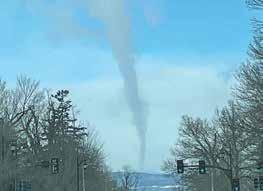
at least for a couple of days. On the 2nd, the temperature in Montpelier reached a balmy 30 degrees; the next day it dropped to 17 below. Tat cold was accompanied by ferocious winds. Next door in New Hampshire, Mt. Washington set the all-time US record for lowest windchill at minus 108.4 degrees on February 4; the air temperature at that time (1:49 a.m.) was minus 47 2, nearly 14 degrees colder than the previous record for that date at the observatory. By February 5, Montpelier was back to 36 degrees. Despite that wicked burst of cold, the month ended up 6.5 degrees above the 20th century mean; 3.1 above the 21st century mean. Meteorological winter runs from December 1 to February 28, and when we lump the seasons together, state-wide temperatures averaged 25 7 degrees, which was 5 4 degrees warmer than the winter of 2021–2022 and 8 6 degrees warmer than the 20th century mean. In the period between 1895 and 2023, only two meteorological winters have been warmer, one in 2001-2002, the other in the winter of 2015-2016.
Our weather summaries from the past three volumes of the Vermont Almanac and saw that temperatures were around average in February 2022, but the month was noteworthy for a substantial ice storm in southern Vermont. In February 2021, southern Vermont got substantial snow and central and northeastern parts of the state ran a snow de fcit. February 2020 was pretty normal.
110 vermont almanac | volume 1 v february WEATHER R
BURLINGTON
A “steam devil” was spotted in Burlington on February 3, as air temperatures made a one-day nose dive above the relatively warm waters of Lake Champlain. NWS




These satellite images, taken by the Sentinel Satellite, show the ice cover on Lake Champlain on (top to bottom) December 2, January 8, February 1, and March 17. We picked the seemingly random days based on the clarity of the images – most days were too cloudy to get a good shot.
stories from & for the land 111
Is it True that No Two Snowfakes are Alike?
When my family moved to Jericho a few years ago, we found ourselves in a very wintery place. A windstorm that December created huge blowdowns and power outages, and after that the snow never seemed to stop.
It all felt right, since Jericho was the home of Wilson “Snowfake” Bentley (1865-1931), a farmer who took full advantage of this wintry place to pioneer the scientifc study of snowfakes. Although Wilson’s father thought he should stick to farming, his mother helped him to get a microscopic camera, a very new and expensive thing at the time. Continually perfecting his technique and always curious, he took more than 5,000 photos of snowfakes during his life, and his work was published by Scientifc American, National Geographic, and in a book, Snow Crystals, that is still in print.
In his life’s work, Bentley famously learned that no two snowfakes are alike. In his own words, “Under the microscope, I found that snowfakes were miracles of beauty; and it seemed a shame that this beauty should not be seen and appreciated by others. Every crystal was a masterpiece of design and no one design was ever repeated. When a snowfake melted, that design
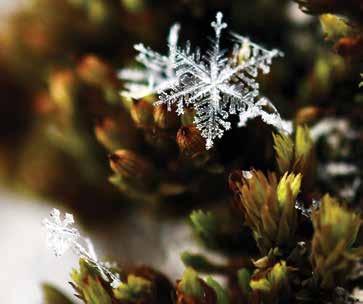
was forever lost. Just that much beauty was gone, without leaving any record behind.”
Nearly a century after Bentley wrote these words, I have reveled in the abundant snowfakes in Jericho and have loved getting quick glimpses of them before they melt back to their watery origins. I have wondered: was Bentley right? Has modern research borne out his claim that each snowfake is unique?
Te short answer is yes. So far, no two snowfakes are alike.
As described in a recent article by Ada McVean of McGill University, each snowfake is formed from around 100,000 water droplets in a complicated process that takes about 30 to
45 minutes under just the right meteorological conditions. Kenneth Libbrecht, a snowfake scholar at California Institute of Technology, has followed in Bentley’s footsteps with more modern techniques. His conclusion, even after creating snowfakes in a laboratory: “ Te question of whether there have ever been identical snowfakes is just silly. Anything that has any complexity is diferent than everything else, even if you have to go down to the molecular level to fnd it.”
So, in Jericho, we love our snowfakes, and we fnd joy in knowing that each one is new and diferent and beautiful.
—Liz Tompson
112 vermont almanac | volume 1 v february NATURE NOTES e
LIZ THOMPSON
A Goldenrod Globe
“Imagine yourself living in a globelike room with greenish walls bulging outward and upward and then arching in to meet above your head. Imagine such a room constructed of succulent, edible material, forming a house that at once provides food and shelter, plenty, and protection.” edwin way teale
Goldenrods are among the native wildfowers that remain visible, above ground, all winter long in meadows and felds. By late fall their golden fowers have faded to tan and the fufy fruits have begun to disperse on the wind. Yet life remains in their stems. Animal life. With the distraction of the vibrant colors of summer and fall now gone, we more easily see the swollen inch-wide balls on the stems of some goldenrods. Inside each of those balls is, or at least was, the larva of a goldenrod gall fy, Eurosta solidagnis
Te goldenrod gall fy evolved alongside and with goldenrods, and it depends on those plants to complete its life cycle. In fact, most of its life is spent inside the goldenrod stem, frst as an egg, deposited in the spring as the new stems are developing, then through the summer, fall, and winter as a larva (in three stages), through pupation the following spring.
When they ultimately emerge as adults, they only live for about two weeks, during which time they mate and lay eggs, and the cycle begins anew.
Of course, nature is never that simple. Te dome seems safe enough, but parasitoid wasps can take it over, co-opting the space to complete their own life cycles. And birds love to peck their way into the balls and eat the tender, sweet, protein-rich larvae. A large, irregular-margined hole in the ball tells that story, whereas the exit hole of the fy is small and clean.
Te goldenrod doesn’t seem to be harmed by the presence of the gall fy. Te yellow fowers bloom as usual; they are pollinated, and they produce fruits, regardless of the presence of a gall. Other kinds of goldenrod galls include the goldenrod elliptical gall, caused by another insect and also found on the stem, and the goldenrod bunch gall, a leafy growth nearer the top of the stem. —Liz Tompson

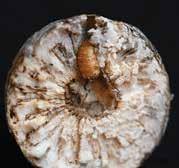
Above: Goldenrod gall fy larva
Below: Adult goldenrod gall fy
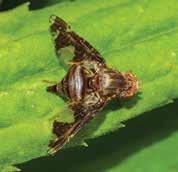
stories from & for the land 113
BOB NOBLE LIZ THOMPSON LIZ THOMPSON
A Guide to Sourcing Raw Milk
According to the CDC, there’s a direct link between an increase in raw milk drinking nationwide and an increase in reports of food-borne illness. And yet, like eating sushi or tartare, thousands of Vermonters know the risks and do it anyway.
Rebop Farm in Brattleboro sells raw milk, and they ofer the following tips for consumers looking to minimize their health risks.
ANIMAL HEALTH : Only consume raw milk if you can confrm that it was milked, handled, chilled, and bottled properly, and that it came from healthy cows. Milk from pastured animals (cows that graze in the spring, summer, and fall, and are fed primarily
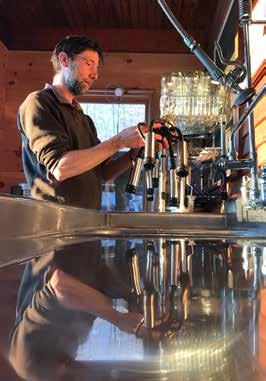
hay, haylage, or baleage in the winter) tends to have a better favor and color than the milk from cows in confnement systems. If you’re purchasing raw milk directly from a farmer in Vermont, their cows/goats/ sheep must be tested for TB and brucellosis, have access to clean water and food, and be housed in a manner that keeps them (and, most importantly, their udders) clean and dry. Each cow needs enough room for comfortable movement with good footing. In Vermont, farmers are required to ofer you a farm tour if you purchase raw milk from them, including a tour of cow housing. Additional tests we do on our farm include Johnes, BLV, BVD, and Neospora. We also vaccinate our cows once a year with a rabies, colostridial, and leukosis vaccine.
FACILITY CLEANLINESS : All dairy equipment should be sanitized before use, rinsed after with lukewarm water, scrubbed in a strongly basic soap, soaked in an acid rinse, and be completely dry between uses. Any dairy farmer worth their salt (including farmers with just one cow or goat) should be able to describe this process, or explain why they deviate from industry norms.
MILK CHILLING : Milk must be chilled to under 40 degrees within two hours after milking. Te native bacteria in milk, even if it is milked into clean equipment from a clean and healthy cow, starts multiplying the moment it leaves the udder. At two hours above 40 degrees, there is an exponential explosion of bacterial growth in milk. Placing freshly collected milk into a half-gallon jar directly into the fridge will never properly chill it. Farmers need to be sure that the milk they sell gets both the chilling and the agitation needed to achieve the proper temperature in the correct amount of time. Tere are many low-tech, low-cost, ways of achieving proper cooling; it need not be a fancy or expensive bulk tank, though that is the most reliable way.
114 vermont almanac | volume 1 v february AT HOME •
Raw milk at Rebop Farm
Maple Baked Custard
Custard provided a simple, delicious use for surplus milk on the subsistence farm of my childhood in Sharon. It is nutritious for growing kids, fortifying for those recovering from illness, and ever so comforting after a long day. —Joyce Amsden
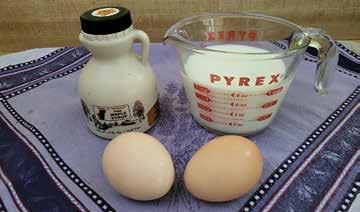

EGG SIZE CHART
Large eggs are the standard in most recipes. Using a diferent size can afect texture, favor, and consistency. If you raise your own chickens, though, or buy from a local farmer who doesn’t grade, you might have eggs that are considerably diferent in size.
A simple, inexpensive metric kitchen scale eliminates the confusion and makes the math
easy. Here is a chart to help you along:

INGREDIENTS
3 large eggs
1 cup milk
¼ cup maple syrup
½ teaspoon vanilla
METHOD
Beat the eggs gently, add the other ingredients, and pour the mixture into 3 glass custard cups, stirring as you go – the syrup tends to settle. Sprinkle very lightly with nutmeg. To cook on the stovetop, use a skillet with a tight-ftting lid. Line the bottom of the skillet with a paper towel or a thin, clean cotton cloth. Place flled custard cups in a skillet. Add about 1 inch water, at least ½-inch below the rim of the custard cups. Bring just to a boil, watching carefully. Cover. Turn of the heat but do not remove the cover. When fully cooled, remove the cover and enjoy! You can also cook it in a 350-degree oven in a baking dish using the same technique.
Simply multiply the number of eggs the recipe calls for by 57
– the weight, in grams, of a large egg. You can then add up the weight of the eggs you have to best match the number. For most recipes, this method will be sufcient. Even graded eggs vary somewhat from one to another, and small variations will not matter. If you need to be precise, you can beat one egg and spoon in or out a small amount until you get it just right.
stories from & for the land 115
JOYCE AMSDEN
Jumbo 71 grams X-Large 64 grams Large ............................... 57 grams Medium 50 grams Small 43 grams PeeWee............................. 35 grams
Dairy with a Twist
KINGDOM CREAMERY OF VERMONT HELPED ONE DAIRY FARM FAMILY DIVERSIFY .
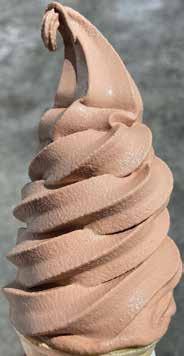

Farm diversifcation usually means growing a new type of crop or raising a diferent kind of animal. For Clair-A-Den Farm in East Hardwick, diversifcation meant investing in stainless steel – lots of it. Jeremy and Leslie Michaud, who run the farm started by Jeremy’s parents, Claire and Denis (hence the farm name), loved dairy farming, but knew all too well the tenuous nature of it. And so they set out to create something that would enable their four sons to keep farming if they choose. Tey decided to take what they knew best – dairy – and fnd a way to add value and a new revenue stream. Tey settled on building their own creamery, right across the road from the farm.
“Kingdom Creamery of Vermont opened in the fall of 2011 – right after Tropical Storm Irene,” says Leslie Michaud. “We had spent the whole previous year doing business-planning, and we had a new baby. So things were a little bit busy.”
Te open production room at the creamery is packed with large pieces of stainless equipment, connected by a maze of stainless piping. “When we frst started, people thought we were making ice cream in grandma’s kitchen. Tis is the real deal here!” she jokes.
Tere was much to learn, says Michaud: “Jeremy and I both have agriculture degrees from Cornell University, so we talked to the people running the creamery there, and we were actually able to buy some equipment from them. And a lot of time was spent learning things online.”
Te couple also had to fgure out exactly which products to focus on. “We knew that the area here was sort of saturated with cheesemaking, so we decided on yogurt and ice cream to start,” Michaud explains. She says those two products go together naturally because skim milk is the byproduct of ice cream production,
INDUSTRY f 116 vermont almanac | volume 1 v february
“so we decided to use that to make a non-fat yogurt.”
Te farm has its own tank truck, which delivers milk from the dairy across the street to the creamery a couple of times a week, depending on the time of year. “We bring the milk here, pump it out, and this is where we separate it – in this big spaceship-looking thing,” says Michaud, pointing to the large stainless cream separator which starts the production process. From there, the skim milk heads in one direction and the cream in another.
“When we’re making a batch of ice cream, these tanks over there are where we take the diferent components – the milk, the cream, cocoa powers, favorings, eggs, depending on what recipe we’re making – and put them together.” A homogenizer creates one uniform mix before a large steamjacketed pasteurizer heats everything to 180 degrees for food safety. Te ice cream is then rapidly cooled by a plate cooler. “We have a fan here and a big block of ice in an insulated room out back that works all year long, no matter what the temperature is,” she explains. At that point, the ice cream is pumped to a holding tank to have favors folded in and await
packaging. (For yogurt production, the temperature after pasteurization is brought down to 110 degrees for eight to ten hours before the cultures are added.)
Kingdom Creamery of Vermont makes a wide variety of its own retail super-premium ice creams, available mainly in stores in central and northern Vermont, but also in a few locations outside the state. Teir oferings include more than 25 favors. [Author’s Note: Majestic Maple is highly recommended, and the maple comes from the farm family’s own 4,000tap sugaring operation in Walden. “I think we’re kind of unique among creameries in that regard,” says Michaud.]
Yogurt is produced for institutional use, such as in school lunches and nursing homes. “We used to do our own retail line of yogurt, but that’s a very competitive market, so we decided to focus on bulk sales in 17-pound containers,” Michaud explains. Te company currently ofers eight favors of yogurt: maple, vanilla, lemon, strawberry-banana, strawberry, raspberry, peach, and blueberry.
“Probably the majority of our work currently is making ice cream mixes – essentially the ice cream
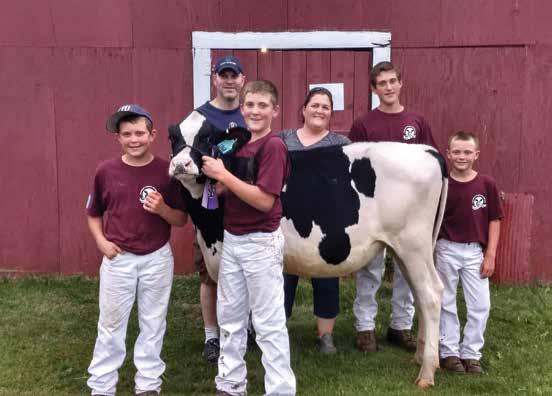
stories from & for the land 117
PHOTOS COURTESY KINGDOM CREAMERY OF VERMONT
Te Michaud Family.
base in a liquid form – for other companies that want to make ice cream. Tey’ll take the mix and turn it into, say, cookies and cream ice cream,” adds Michaud.
“We’ll produce mix for them depending on the fat percentage they want, or whether they want eggs included – these are custom mixes.” In some cases, Kingdom Creamery will co-package fnished ice cream in another company’s pint or half-gallon cartons, but, more often than not, they stop the process at the base mix stage and ship that out to customers in cases or totes (which tip the scales at about 330 pounds).
Kingdom Creamery also produces creemee mixes, in either 5 percent or 10 percent fat content, in three favors: vanilla, chocolate, and maple. Like their ice cream mixes, companies buy their creemee mixes to sell not just in Vermont creemee stands but all over New England and New York.
Four full-time employees are needed to run production at the creamery, which takes place from
Sunday to Tursday each week. All of the products require either refrigeration or freezing, so the creamery building has a huge walk-in space devoted to each. Tat requires substantial electricity, obviously, and Michaud says the electric bills are among the largest of the creamery’s costs. Tere are other challenges as well. Given the extensive network of plumbing and equipment, breakdowns and repairs are a regular part of life – which means that Jeremy must often come over from the farm at all hours of the day to address some mechanical issue or another.
Trucking from the relatively isolated Northeast Kingdom is another ongoing obstacle, says Michaud. “Distribution out of northern Vermont is difcult, absolutely. We can make these products, but the challenge is: can we move them where they need to go in a reasonable timeframe? It is really difcult, especially since Covid, and because these are refrigerated or frozen products.”

118 vermont almanac | volume 1 v february
As fresh as it gets: the dairy is just across the road from the creamery.
BACK AT THE FARM
Clair-A-Den Farm milks about 340 Holsteins at the moment; there are about 800 head on the farm total, including youngstock and breeding stock. Te creamery uses about 25 to 30 percent of the milk the farm produces.
New calves are born almost daily, with the expectant cows moved to a special pen leading up to the birth so they and the new calves can be monitored carefully before and after. “You check for ketosis; you check their rumen to make sure it’s moving; and you check their temperature and their eyes – just make sure they look like they’re well,” Michaud explains.
Tere are also American Milking Devons, a heritage breed of cattle that are being raised to sell. Michaud gestures to a pair of six-year-old oxen. “ Tis is Tom and Brady. Te boys have raised them since they were babies; that’s why they’re so good. Tey are pretty docile.”
Jeremy acts as the full-time manager of both the farm and the creamery. “He works pretty much nonstop,” says Michaud of her husband. In addition to managing the day-to-day of both operations, there’s also plenty of planning to do and regulations that must be met.
Leslie has a full-time job of the farm (“my frst 40 hours a week,” she jokes) with the US Department of Agriculture’s APHIS veterinary services as an animal health technician. With a federal veterinarian, she responds to suspected animal diseases such as bird fu and checks for disease at locations such as auction barns and slaughterhouses.
Te Michaud’s four boys were young when Jeremy and Leslie started Kingdom Creamery, but they’re now old enough to provide substantial help both there and on the farm. Lincoln, the oldest at 18, headed of to Cornell in the fall to study agriculture; Gabriel, 17, is a talented mechanic who helps keep the farm’s equipment running; Morgan, 15, has a special afnity for the creamery, often helping with packaging and single-handedly setting up a local delivery program of milk, ice cream, eggs, and beef during Covid, when he was just 13; and Dawson, 12, is an entrepreneur in his own right, raising and selling meat pigs. On one visit in the summer of 2023, all four of the boys were out haying by themselves, each handling a diferent part of the job. “ Tey’re an integral part of this operation,” says Michaud. “ Tey’re very good at what they do – they’re problem solvers, they’re workhorses,
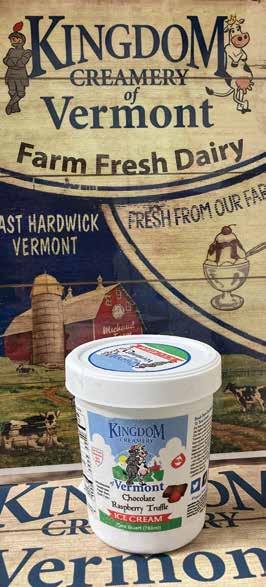
they are farmers. We wanted to raise our kids like this, and we’re proud of it.”
Te addition of the creamery has been a net positive for the farm, says Jeremy. But there’s no getting away from the fact that running the creamery is a tremendous amount of work. He adds, “To get going, “there was a lot of fnancial risk involved.”
“It was scary,” agrees Leslie. “But we were young and ready to dive into something – and we were doing this for our kids – we want them to have the opportunity, the best opportunity they can have, in agriculture and the dairy business. And so here we are.” —Patrick
White
stories from & for the land 119
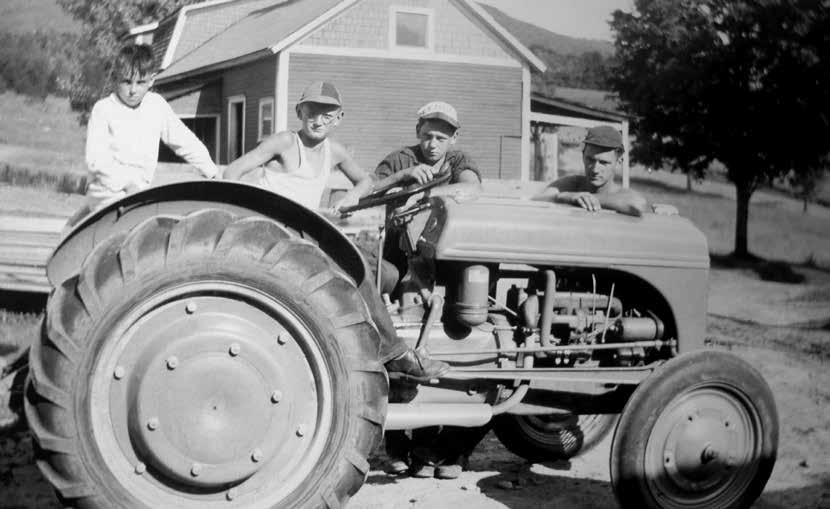
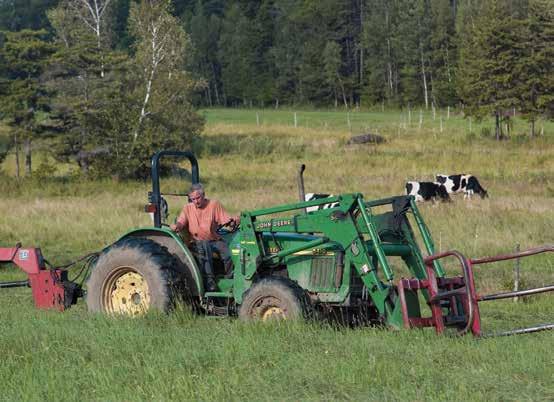
120 vermont almanac | volume 1 v february
From top: George Woodard, Sr. (far right) and his siblings on the farm, likely in the 1940s. George Woodard, Jr., tending to his herd of dairy cows in 2008
Right: Suzanne Woodard in 2023, introducing small-scale raw milk to the farm.
Evolution of a Dairy Farm
TIMES CHANGE , FAMILIES CHANGE , AND FARMS CAN CHANGE WITH THEM .
George Woodard, Jr., an accomplished actor, director, and a bit of a local celebrity, traveled around the state in 2023 to promote his new flm Te Farm Boy. In his presentations, the 71-yearold made it clear that the flm wouldn’t have been possible without the inspiration and lessons learned in a lifetime of dairy farming.
T
e Woodard family’s history with farming goes back to 1912, when George’s grandfather bought a farm in Waterbury Center. “ Te deed said ten cows, some chickens, two horses, and one of ’em ain’t that good,” Woodard said in the comedic speak-singy style he’s known for.
After World War II, George’s parents purchased the farm and increased the herd of cows to 25 Tey farmed for about 20 years.

Te work was hard. “At that time, everything was still a lot of handwork. My father decided in 1961 that they would sell the cows, and he went to work in construction,” explained George.
Te farm was inactive for over 10 years until his mother, Teresa, proposed that her son give farming a shot.
“My mother asked me in the early 1970s if I thought about running the dairy farm, and I said, ‘Well, I hadn’t thought about it.’” George recalls. “I went to Vermont Technical College and did a little work on other people’s farms, mostly haying. I came back in 1973, and the barn was in rough shape because the frost heaves had broken the foundation. We bought 10 cows. Te following year we bought 10 more.”
George’s brother Steve joined the endeavor, and the two started shipping milk to Cabot Creamery in 1975 Tey milked cows together until George moved to California in the early 80s to pursue dreams of being a flmmaker and actor. Te dream had been fostered in high school when George had discovered theater and acting in his senior year.
George was in California for three years while Steve watched over the farm. In the mid-80s, George returned to Vermont on a mission to make flms and perform in his home state, all while milking cows.
“I felt like they weren’t doing anything out there in California that you couldn’t do anywhere if you had a camera, lights, and actors,” Woodard said. “We had done so much work to rebuild the farm back up to where it was a small dairy farm, and I didn’t want to bail on it.”
While George returned to farming, Steve shifted his focus to veterinarian work and helped on the farm when he could because, as George says in old Vermont vernacular, “he lived down the road a piece.”
George said his brother was one of the frst vets to incorporate homeopathic medicine on conventional dairy farms. “He was at the head of the organic movement when it became popular in the mid-90s and had a foot in the door, you might say, for the
stories from & for the land 121 f
understanding of homeopathy, so there were a lot of farmers who would call him about what to do,” George notes.
Steve died of cancer in 2011 at 54. His daughter, Suzanne Woodard, is keeping her father’s legacy of homeopathic medicine alive as she builds a new business on the farm – a micro apothecary.
Suzanne moved to her uncle’s farmhouse in 2019, a year before he decided to stop milking cows. George made the decision to stop shipping milk after losing his milk contract with Horizon Organic as they left the Northeast, and because of the difculty of farming with an aging body.
“I was going to let it go because my knees were old,” George recalls of his thinking even before losing the milk contract.
Suzanne and George downsized the farm with a plan to milk a couple of cows and sell the raw milk directly to consumers and also get a herd of beef cows. Suzanne created a line of herbal tinctures called Loomis Hill Botanics, made from plants grown on the farm.
“She’s a go-getter, and she works hard, and she wants to be here, and that’s a big part of it,” George said. “She knows how to hay and milk cows, and it’s good because it gives me a little more time so I can take of for an evening and go show the flms.”
“ Tis farm is a special spot and I feel fortunate to live here. My father and uncle grew up here, and their many years of hard work made this farm what it is today,” said Suzanne. “Vermont agriculture is noticeably changing; we see farms disappearing and my biggest passion is to not let that happen to this farm. My uncle George has taught me that there’s magic and creativity in what may appear like mundane work, and that hard work is very satisfying.”
She says that the move to herbal products, smallscale raw milk and beef, not to mention a new generation, is exciting: “Change is inevitable, and I don’t have a concrete plan for the future of the farm in place, but what’s happening is an organic passage, and keeping cows grazing on pasture and the farm operational are very important to me.”
George said he’s optimistic generally about the future of small-scale farming, despite everything he hears in the news.
“Dairy is the best thing in the world. Small dairy farms work. Tey actually work better than bigger ones, but it’s been drummed into people’s heads that
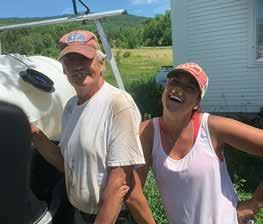
Suzanne goofng of on the farm.
you have to get big,” George said. “Big farms never get out of debt. When you stay small, you can get out from under it after 10 or 15 years.”
He is saddened by the loss of culture that occurs when small farms go by the wayside.
“ Te people that sufer the most when we lose small farms are the neighbors who don’t get a chance to actually help with some of that,” George said. “If you’re a neighbor of a small dairy farmer, maybe you’re able to do a little work to come and help with a little haying, feed the calves, and learn how to milk. If you’re a neighbor of a big dairy farm, you’re probably not going to get a chance to do that.”
George said that milking cows for over 40 years was likely the most important thing he ever did, not just because of all it gave his community but because it taught him how to be a flmmaker.
“When you’re a small dairy farmer, the one thing you have to know is how to do everything; you have to do animals, repair machinery, be a bit of an electrician, a carpenter, everything,” George said. “When it comes to being a small flmmaker, you have to know everything. You have to know how to direct actors, composition, lighting, how the camera works, and how to tell a story visually…I don’t really consider myself a flmmaker because it’s not something I really made a living at. I still consider myself a dairy farmer. Dairy farming gave me the knowledge that’s required to do the other stuf.”—Laura Hardie
An earlier version of this story focusing on George Woodard’s second feature flm was published by the online newspaper Waterbury Roundabout in February 2023
122 vermont almanac | volume 1 v february
George and
SUZANNE WOODARD
George Woodard’s unique approach to flmmaking is refected even in how he casts them. For his latest, “ Te Farm Boy,” he began by attending local high school theater productions.
“We found Grace Woodruf in a high school play over to Harwood in ‘Oklahoma,’” Woodard said recently in an interview at his Waterbury Center farm.
“She was a sophomore, she was one of the dancers, but I could tell that she was focused and had a good look,” he said. “We found out where she lived, which is right down at the bottom of the hill where I hay. And I knew her folks!”
Fortunately, they gave permission.
“She came up and talked with me, and wanted to do it, so we said OK. And she’s pulled of some pretty amazing stuf. She can look 16 in the morning, you change her hair, you change her costume, she changes her attitude, and she becomes a 21-year-old young woman. It’s amazing.”
So, he’s at it again. In 2023 Woodard premiered his second feature flm, another milestone in the Waterbury Center dairy farmer’s amazing career that has included community theater, Hollywood flm roles, and Vermont comedy tours.
Set in 1944, “ Te Farm Boy” is a story about trust, integrity, and standing behind your word. It remembers a time when war took young boys away from their homes and returned them as heroes. Calvin Dillard, played by
Te Farm Boy
Henry Woodard, is a milk-truck driver living on a small hillside farm in Vermont. He falls in love with a girl he meets at a barn dance, and then gets drafted into the U.S. Army. Calvin comes home for two days’ leave and marries his sweetheart.
Calvin is then shipped of to the war in Europe. His convoy is attacked, and Calvin is left for dead. He is found by a French woman who nurses him back to health and accompanies him on a successful escape to freedom.
For Woodard, it’s all about the story. “Some of this is loosely based on my folks, and that’s where I get the ideas – they’re good stories,” he said. “I just have such a great respect for my parents that I think I want to try this. I can’t do a big Battle of the Bulge thing. Tat’s fne, because I’m looking more at the human aspect of one character.”
Te movie is in two sections, and the frst is on the home front, the second in Belgium (the woods above Woodard’s farm).
“You’re introduced to the boy, the boy’s family, the girl, the girl’s family, and the adventures they have during their little courtship,” Woodard said. “And then he goes of to war.”
“But it’s not like we jump into the war. You really get to know those characters in the frst part because it’s important for the story. Both of the women in this movie, for the movie to work, have to be absolutely wonderful women.”
In most flms, if there are two women and one man, or vice versa, you know what’s going to happen because one of them is not so nice.
“You know, because that’s how they write the stuf,” Woodard said. “But in this flm, both of the women are absolutely fantastic and wonderful. I also don’t want to make something that is obvious. I like to have some little things in there that are unexpected.” —Jim Lowe, theater critic for Te Times Argus, where this review originally appeared.
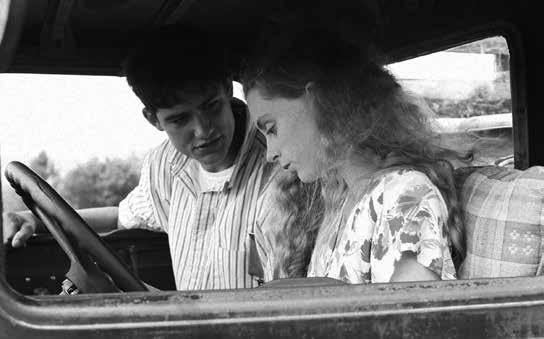
stories from & for the land 123
A still shot from “ Te Farm Boy”

Te Narrative of Seth Hubbell
In the late 1700s, colonist Seth Hubbell cleared a few acres to farm in Wolcott, a feat he accomplished with two tools: an ax and a hoe. Hubbell’s slender 1824 memoir spans his homesteading hardships: dead oxen and cows, ruined crops, illness, and ever-present hunger. Despite these challenges, the optimist farmer boasted in his later years a lineage of seventy-four souls. Hubbell, his two wives – Betsy and Saloma – and various descendants are buried in Fairview Cemetery along Wolcott’s section of Route 15. Today’s trafc and contrails would be foreign to Hubbell, but the mountain ridges seen from his gravesite remain the same.
In 1999, the late poet David Budbill, also a Wolcott resident, wove Seth Hubbell’s experiences into his own poetic rendition of smalltown Vermont titled Judevine. Of Hubbell and his peers, Budbill remarked:
“ Tis never-ending dream of freedom and bread.”
Budbill’s words, perhaps, ring true far beyond Vermont’s early colonial days.
Te following text from Seth Hubbell’s memoir has been abridged, but the original style and grammar largely retained.
124 vermont almanac | volume 1 v february
A LOOK BACK •
In the latter part of February, 1789, I set out from the town of Norwalk, in Connecticut, on my journey for Wolcott, to commence a settlement and make that my residence, family consisting of my wife and fve children, they all being girls, the eldest nine or ten years old. My team was a yoke of oxen and a horse. After I had proceeded on my journey to within about one hundred miles of Wolcott, one of my oxen failed, but I however kept him yoked with the other till about noon each day, then turned him before, and took his end of the yoke myself, and proceeded forth in that manner with my load to about fourteen miles of my journey’s end, when I could get the sick ox no further, and was forced to leave him with Tomas McConnel, in Johnson, but he had neither hay nor grain for him. I then proceeded on with some help to Esq. McDaniel’s in Hyde Park: this brought me to about eight miles of Wolcott, and to the end of the road. It was now about the l0th of March, the snow was not far from four feet deep, no hay to be had for my team, and no way for them to subsist but by browse. As my sick ox at McDonnell’s could not be kept on browse, I interceded with a man in Cambridge for a little hay to keep him alive, which I backed, a bundle at a time, fve miles, for about ten days, when the ox died. On the 9th of April I set out from Esq. McDaniel’s, his being the last house, for my intended residence in Wolcott, with my wife and two eldest children. We had eight miles to travel on snowshoes, by marked trees no road being cut: my wife had to try this new mode of traveling, and she performed the journey remarkably well. Te path had been so trodden by snowshoes as to bear up the children. Esq. Taylor, with his wife and two small children, who moved on with me, had gone on the day before. We were the frst families in Wolcott: in Hyde Park there had two families wintered the year before. To the east of us it was eighteen miles to inhabitants, and no road but marked trees: to the south about twenty, where there were infant settlements, but no communication with us, and to the north, it was almost indefnite, or to the regions of Canada.
I had now reached the end of my journey, and I may say almost to the end of my property, for I had not a mouthful of meat or kernel of grain for my family, nor had I a cent of money to buy with, or property that I could apply to that purpose. I however had the good luck to catch a sable. Te skin I carried ffty miles, and exchanged it for half a bushel of wheat, and backed it home. We had now lived three weeks without bread, though in the time I had bought a moose of an Indian, which I paid for by selling the shirt of my back, and backed the meat fve miles, which answered to subsist upon. I would here remark that it was my fate to move on my family at that memorable time called the “scarce season,” which was generally felt through the State, especially in the northern parts in the infant settlements. No grain or provisions of any kind, of consequence, was to be had on the river Lamoille. I had to go into New Hampshire, sixty miles, for the little I had for my family, till harvest, and this was so scanty a pittance that we were under the painful necessity of allowancing the children till we had a supply. Te three remaining children that I left in Hyde Park, I brought one at a time on my back on snowshoes, as also the whole of my goods.
I moved from Connecticut with the expectation of having ffty acres of land given me when I came on, but this I was disappointed of, and was under the necessity soon after I came on of selling a yoke of oxen and a horse to buy the land I now live on, which reduced my stock to but one cow, and this I had the misfortune to lose the next winter. Tat left me wholly destitute of a single hoof of a creature … but there was a door opened. I was informed that a merchant in Haverhill was buying snakeroot and sicily. Tis was a new kind of trafc that I had no great faith in, but I thought to improve every means or semblance of means in my power. Accordingly, with the help of my two oldest girls, I dug and dried a horse-load, and carried this new commodity to the merchant, but this was like most hearsay reports of fne markets, always a little way ahead, for he knew nothing
stories from & for the land 125
about this strange article, and would not even venture to make an ofer, but after a long conference I importuned with the good merchant to give me a three-year-old heifer for my roots, on certain conditions too tedious to mention. I drove her home, and with joy she was welcomed to my habitation, and it has been my good fortune to have a cow ever since. Tough my faith was weak, yet being vigilant and persevering, I obtained the object, and the wilderness produced me a cow.
•
When I came into Wolcott my farming tools consisted of one axe and an old hoe. Te frst year I cleared about two acres, wholly without any team, and being short of provisions, was obliged to work the chief of the time till harvest, with scarce a sufciency to support nature. My work was chiefy by the river. When too faint to labor, for want of food, I used to take a fsh from the river, broil it on the coals, and eat it without bread or salt, and then to my work again. Tis was my common practice the frst year till harvest. I planted that which I cleared in season, with corn, and an early frost ruined the crop so that I raised nothing the frst year, had again to buy my provisions: My seed corn, about eight quarts, cost me two and a half yards of whitened linen, yard wide, and this I had to go twenty miles after. Tough this may be called extortion, it was a solitary instance of the kind, all were friendly and ready to assist me in my known distress, as far as they had ability. An uncommon degree of sympathy pervaded all the new settlers, and I believe this man heartily repented the act, for he was by no means indigent, and was many times reminded of it by way of reproof.

My scanty supply of bread-corn made it necessary to improve the frst fruits of harvest at Lake Champlain, to alleviate our distress, it being earlier than with us. Accordingly, on the last days of July, or frst of August, I took my sickle, and set out for the lake, a distance of better than forty miles. When I had got there, I found their grain was not ripe enough to begin upon, but was informed that on the Grand Isle they had begun their harvest. I was determined to go on, but had nothing to pay my passage. I fnally hired a man to carry me over from Georgia, for the small compensation of a case and two lances that I happened to have with me, but when I had got on to the Island, I found I was still too early. Tere was no grain ripe here, but I found
126 vermont almanac | volume 1 v february
the most forward I could, plead my necessity, and staid by the owner till I got one and a half bushels of wheat, and worked for him to pay for it. It was quite green: I dried it and set out for home, but my haste to get back prevented my drying it sufciently. I found a boat bound for Mansfeld mills, on the river Lamoille, and got my grain on board, and had it brought there free from expense. I got it ground, or rather mashed, for it was too damp to make meal. I here hired my meal carried on to Cambridge borough for my sickle, and there got it ground the second time, but it was still far from good meal. From the Borough I was so fortunate as to get it home on a horse. I was a fortnight on this tour. My wife was fearful some accident had happened, and sent a man in pursuit of me, who met me on my way home. I left my family without bread or meal, and was welcomed home with tears, my wife baked a cake, and my children again tasted bread. •
I had the good fortune to buy on trust, the winter after I lost my corn, of a man in Cambridge, twenty-four miles from home, twelve bushels of corn, and one of wheat. Tis, by the assistance of some kind friends, I got to Esq. McDaniel’s. I also procured by digging on shares in Hyde Park, twelve or thirteen bushels of potatoes. Tis grain and potatoes I carried eight miles on my back. My common practice was one-half bushel of meal, and one-half bushel of potatoes at a load.
Being destitute of team for four or fve years, and without farming tools, I had to labor under great embarrassments, my grain I hoed in the frst three years. After I raised a sufciency for my family, I had to carry it twelve miles to mill on my back, for the frst three years, this I had constantly to do once a week. My common load was one bushel, and I generally carried it eight miles before I stopped to rest. My wife at one time sold her shirt to purchase a moose hide which I was obliged to carry thirty miles on my back, and sold it for a bushel of corn, and brought the corn home in the same way.
Te winter after I came on, we had a remarkable snow, the frst of consequence that fell, it was full two feet deep. Our communication was with the inhabitants of Hyde Park, and it was necessary for us to keep the road, or rather path, so that we could travel. We were apprehensive of danger, if we did not immediately tread a path through this snow. I was about out of meal, and had previously left a bushel at a deserted house about fve miles on the way. I agreed with Esq. Taylor, he being the only inhabitant with me, to start the next day on the proposed tour. We accordingly started before sunrise, the snow was light, and we sunk deep into it. By the middle of the day it gave some, which made it still worse, our snowshoes loaded at every step, we had to use nearly our whole strength to extricate the loaded shoe from its hold. It seemed that our hip joints would be drawn from their sockets. We were soon worried we could go but a few steps without stopping, our fatigue and toil became almost insupportable. We were obliged often to sit down and rest, and were several times on the point of giving up the pursuit, and stop for the night, but this must have been fatal, as we had no axe to cut wood for a fre, our blood was heated, and we must have chilled. We fnally, at about dusk, reached the deserted house, but were in efect exhausted. It seemed we could not have reached this house had it been twenty rods further, so terrible is the toil to travel through deep snow, that no one can have a sense of it till taught by experience. Tis day’s journey is often on my mind, in my many hard struggles it was one of the severest. We struck up a fre and gathered some fuel that lay about the house, and after we had recovered strength, I baked a cake of my meal. We then lay down on some hewn planks, and slept sound till morning. It froze at night, the track we had made rendered it quite feasible traveling. Te next day I returned home with my bushel of meal.
stories from & for the land 127
Sometime in the month of March, it began to rain, and was a very rainy day and night. Te Lamoille was raised, the ice became rotten and dangerous. Te man of whom I purchased the grain was so good as to take his team and carry it to the mill. Te owner of the mill asked me how I expected to get my meal home. I answered him as the case really was, that I knew not. Te feeling man then ofered me his oxen and sled to carry it to the Park, and I thankfully accepted his kind ofer. He then turned to the miller, and directed him to grind my grist toll free. While at the mill a man requested me to bring a half hogshead tub on my sled up to Johnson. By permission of the owner of the oxen, he put the tub on the sled, and it was a Providential circumstance, for when I came to Brewster’s branch, a wild stream, I found it broken up, running rapid and deep. At frst I was perplexed what to do. To go across with my bags on the sleds would ruin my meal. I soon thought of the tub, this held about half of my bags, the other half I left on the shore, and proceeded into the branch and crossed with safety. Tough I was wet nearly to my middle, I unloaded the tub and returned into the branch, holding the tub on the sled, but the stream was so rapid, the tub being empty, that in spite of all my exertions, I was washed of the sled and carried down the stream, holding on to the tub, for this I knew was my only alternative to get across my load. At length I succeeded in getting the tub to the shore, though I was washed down the stream more than twenty rods, sometimes up to my armpits in the water, and how I kept the tub from flling in this hasty struggle, I know not, but so it was. Te oxen, though turned towards home, happily for me, when they had got across the stream, stopped in the path till I came up with the tub. I then put in the other half of my load, and succeeded in getting the whole across the branch, and traveled on about three miles and put up for the night. Wet as I was, and at that season of the year, it is easy to conceive my uncomfortable situation, for the thaw was over, and it was chilly and cold. In the morning I proceeded for home, came to the river, not being sensible how weak the ice was, I attempted to cross, but here a scene ensued that I can never forget. When about half across the river, I perceived the ice settling under my oxen. I jumped on to the tongue of my sled, and hastened to the oxen’s heads, and pulled out the pin that held the yoke. By this time the oxen were sunk to their knees in water. I then sprang to the sled, and drawed it back to the shore, without the least difculty, notwithstanding the load, and
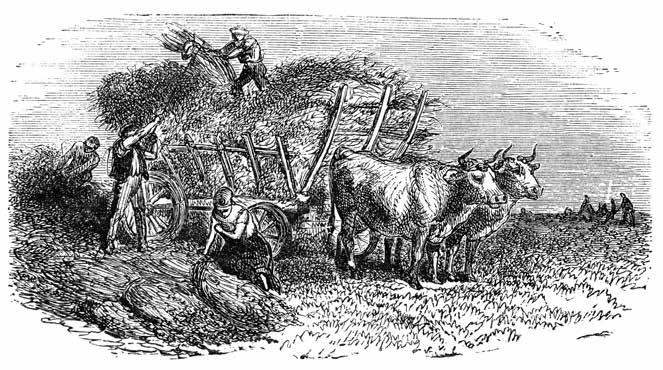
128 vermont almanac | volume 1 v february
•
returned to my oxen. By this time they had broken a considerable path in the ice, and were struggling to get out. I could do nothing but stand and see them swim round. Sometimes they would be nearly out of sight, nothing scarcely but their horns to be seen, they would then rise and struggle to extricate themselves from their perilous situation. I called for help in vain, and to fy for assistance would have been imprudent and fatal. Notwithstanding my unhappy situation, and the manner by which I came by the oxen. I was not terrifed in the least. I felt calm and composed. At length the oxen swam up to where I stood, and laid their heads on the ice at my feet. I immediately took the yoke from of their necks, they lay still till the act was performed, and then returned to swimming as before. By this time they had made an opening in the ice as much as two rods across. One of them fnally swam to the downstream side, and in an instant, as if lifted out of the water, he was on his side on the ice, and got up and walked of, the other swam to the same place, and was out in the same way. I stood on the opposite side of the opening, and saw with astonishment every movement. I then thought, and the impression is still on my mind, that they were helped out by supernatural means, most certainly no natural cause could produce an efect like this, that a heavy ox, six and a half feet in girth, can of his own natural strength heave himself out of the water on his side on the ice is too extraordinary to reconcile to a natural cause, that in the course of Divine Providence events do take place out of the common course of nature, that our strongest reasoning cannot comprehend, is impious to deny, though we acknowledge the many chimeras of superstition, ignorance, and barbarism in the world, and when we are eye-witnesses to such events, it is not for us to doubt, but to believe and tremble.
•
A painful circumstance respecting my family I must here mention. In the year 1806, we were visited with sickness that was uncommonly distressing, fve being taken down at the same time, and several dangerously ill. In this sickness I lost my wife, the partner of my darkest days, who bore her share of our misfortunes with becoming fortitude. I also lost a daughter at the same time, and another was bedrid about six months, and unable to perform the least labor for more than a year. Tis grievous calamity involved me in debts that terminated in the loss of my farm, my little all, but by the indulgence of feeling relatives I am still permitted to stay on it. Tough I have been doomed to hard fortune I have been blest with a numerous ofspring, have had by my two wives seventeen children, thirteen of them daughters, have had ffty-one grandchildren, and six great-grandchildren. When I refect on those past events, the fatigue and toil I had to encounter, the dark scenes I bad to pass through, I am struck with wonder and astonishment at the fortitude and presence of mind that I then had to bear me up under them. Not once was I discouraged or disheartened: I exercised all my powers of body and mind to do the best I could, and left the efect for future events to decide, without embarrassing my mind with imaginary evils. I could lie down at night, forgetting my troubles, and sleep composed and calm as a child. I did in reality experience the just proverb of the wise man, that “the sleep of the laboring man is sweet, whether he eat little or much.” Nor can I close my tale of suferings without rendering my feeble tribute of thanks and praise to my benign Benefactor, who supplies the wants of the needy and relieves the distressed, that in his wise Providence has assisted my natural strength, both of body and of mind, to endure those scenes of distress and toil.
Adapted from “ Te Narrative of Seth Hubbell” (1824), Released May 2003, History of Lamoille County, Vermont
stories from & for the land 129
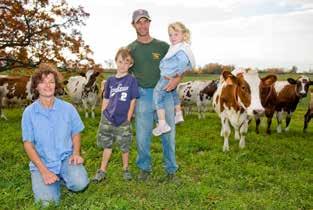
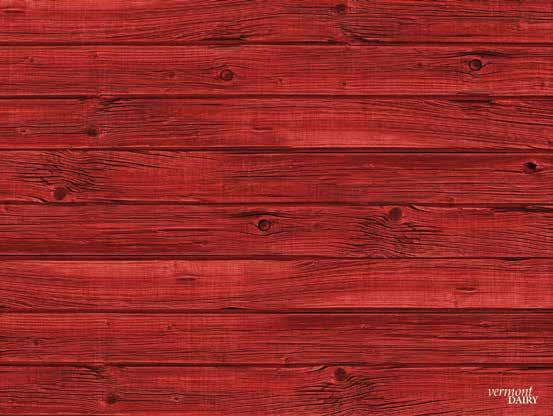
“Vermont Dairy Farmers feed us, tend the land, protect the environment and support their local communities. The Vermont Dairy Promotion Council and the Agency of Agriculture encourage you to support our dairy farmers by visiting VermontDairy.com to explore the many ways to purchase Vermont made dairy products and fnd a — Anson Tebbetts | Vermont Secretary of Agriculture visit VermontDairy.com

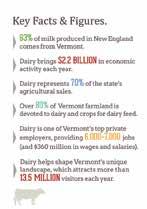

130 vermont almanac | volume 1 v sponsor TODAY
EVER
MORE THAN
MILK MATTERS
local farm to visit.”

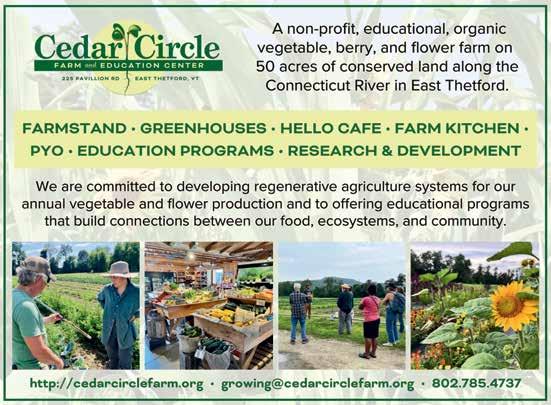
stories from & for the land 131 sponsor
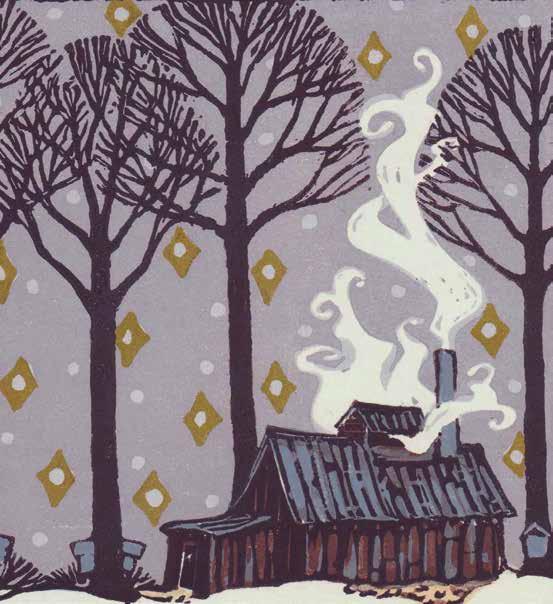
MARCH
stories from & for the land 133
Ice Pond
Athena spent yesterday in restless ill temper, herding Tafy around the pasture like an imperious bored queen. Under a seductive spring sun, the snow is melting in icy, frisky little rivers that fow down from the felds. Te call of the frst spring ride is irresistible. Athena is standing in the barnyard, hind leg cocked, eyes half-closed, easy to catch. I dress in britches, turtleneck, down vest, feece, and outer shell, the latter to repel the long guard hairs that she has begun to shed. I lead her into the stall and begin to curry her long coat. Athena dances against the pressure of the grooming tool, so I try to be both vigorous and gentle with my touch, massaging her long muscles as well as scrubbing her old stale coat.
Gradually, she relaxes into the full-body massage and stops her nervous weaving. After combing her mane and tail, I turn to her facial hair. I use the small clippers to trim her whiskers and the long hairs under her halter and chin, sculpting her silhouette so the fneness of her bones can be seen again. I toss on the white feece saddle pad and the old English saddle; as the girth is cinched, she stands stoically, unlike some horses who turn and try to bite, sometimes savagely.
Leaving the paddock area, Athena adopts an instinctive vigilance. As we cross the property boundary and turn toward the village, her eyes are huge and her head moves constantly, trying to take in the new sights, sounds, and smells. Her ears fick and she is bouncing on the tips of her hooves. She has elevated her body and is rising in motion, her head a full nine feet of the ground. She feels enormous and buoyant, like a kite at the end of a long white string.
We have several intense “conversations” about which direction we want to head. I opt for the village. She agitates for home. Tis is a crucial battle of wills on our frst ride out. Over the winter, Athena has gotten accustomed to her alpha mare status, but when you are on the back of a horse, it is imperative that you establish yourself as the alpha, otherwise a willful horse like Athena could whirl, twist, and buck you of, dumping you unceremoniously in the middle of the road before galloping back to stand next to the pasture fence with her herd mate.
134 vermont almanac | volume 1 v
march
I use my voice to soothe her fears and my legs and body to keep her moving forward. As we proceed in dancing fashion down the road, she forgets about stopping and whirling and begins to take in the sensory stimulations around her. Te sound of Peter’s Brook, full with snow melt, rushing parallel to the village road. A barking dog. Passing cars, some driving by slowly, giving us wide berth, others speeding by, heedless of the keg of equine dynamite I am sitting on.
Athena feels like a coiled snake ready to spring. I try to relax in the saddle, sinking my weight down and back, keeping my legs quiet and urging her forward, my hands light but ready if she chooses to explode. I try to remain calm and use a soothing voice, riding out this stage of delirious headshaking and prancing until she regains her sensibility.
A friend stops in her car to invite me over after the ride. “Hey, lady on the horse,” her son calls. We ride through the small village, past the post ofce, general store, antiques center, candle shop, and two quaint restaurants. Visitors from out-of-state are relaxing on the front porch of the candy store, enjoying the new sun. Tey watch Athena’s tall dark beauty in quiet awe as she and I dance by. Athena is quivering with barely controlled equine energy and raw power, and I continue my calming, low, nonsensical, one-sided conversation. Te only things between disaster and me are the thin leather reins and the confdence of my body’s reassuring signals.
We turn left at the old Federated Church onto a long stretch of deserted road. When I let her trot to use up some of the bound-up energy, her head fags even higher, chin jutting stubbornly in the air. I gather the reins tighter. She’s fghting my hands so I remind myself to resist pulling constantly against her mouth. Her trot is a jagged, reckless gait that threatens to detonate into a mad gallop. I alternate pulling her in a frm, seesaw motion and then relaxing my hands. Perhaps she senses my heart is in my mouth; it is only my bravado that convinces her not to fall to pieces.
My job this frst outing is to show her that all this is normal. To remind her that no ferocious wild jackals lurk behind the bushes waiting to attach themselves to her jugular vein. She needs to be shown again that venturing away from the barn is a fun thing; a healthy thing, too, with lots of new interesting objects to look at and think about. All creatures need change and stimulation. Besides, she is getting fabby and crabby, the universal winter curse.
Athena begins to settle as we follow Ice Pond Road past the 1730 colonial and turn south onto Warm Brook Road. She is listening to me now, not so dangerously insane, not so out-ofher mind. To prey animals such as the horse, everything is potentially threatening, especially in new surroundings. Sounds are magnifed; a piece of paper blowing from the side of the road becomes an attacker. A rock or lump of ice becomes strangely ominous. Te horse’s natural instinct is to use its legs for self defense – to fee frst, then check things out from a safe distance.
We turn around for home at the end of the road. I am careful to give her the “reverse” signal when she least expects it so she doesn’t get the idea that heading for the barn is her idea. All part of the head game I’ve got to play in order to stay in control.
Turning for home is tantamount to dangling a grain bucket in front of horses. She collects her muscles and her head springs up from its relaxed position. Her racehorse blood cannot stand any more of my restraint; she is literally vibrating with power and desire. She grows to ten feet tall and begins to fy. I call upon all of my horsemanship to defuse the situation, deciding that instead of fghting a clearly losing battle to make her walk, we will compromise and do a little canter to use up a margin of her energy.
Athena responds to my nonstop voice and we alternately walk and trot the rest of the way home without further commotion. As we near the barn at the top of the hill, Tafy’s heartwrenching calls echo through the valley, Oh, where have you gone? Athena’s returning bugles tremble. Here I am! I am home, my friend. We turn into the feld before the barn where Tafy can see us. Te minute they are in each other’s line of sight, both animals visibly relax. As do I. We are home. —Margot Page
stories from & for the land 135
Remarkably Consistent
March often features big swings in the weather as winter fghts for dominance with spring. March 2023, however, was noteworthy for its remarkable consistency. No one felt this more than Vermont’s sugarmakers, whose whole trade depends on the weather.
In southwestern Vermont, where I sugar, we had fve days when the temperature got modestly above 50 degrees, and one day when it stayed in the 20s; every other day the highs fell somewhere in the 30s or 40s. On 12 days of the month the daytime highs and the nighttime lows were within 10 degrees of each other. On 30 out of 31 nights, the temperature dropped below freezing. Tis is textbook good

Clearing sap lines after an epic mid-March snowstorm – the largest of the season, particularly in southern Vermont.
sugaring weather, and from a quality perspective, it was a textbook-good year. (See page 144 for a statewide summary.) We – and seemingly every other sugarmaker I spoke to – made lots of light, great-tasting syrup. Tis makes sense because warm temperatures mean an increase in microbial activity, which at a certain point begins to afect syrup quality and favor.
What’s interesting is that the textbook-good weather in our woods didn’t mean a banner year for quantity. We had an average season in terms of volume produced, not a record season. And what kept it from being a record season was the fact that it froze almost every night. “Wait,” you’re thinking. “I’ve been told my whole life that freezing nights and warm days are what sugarmakers want.” And that’s true, but it’s only partly true. Another dimension to yield involves a vacuum system, which every modern producer employs. And you don’t see substantial gains with vacuum when the sap is fowing well. In other words, vacuum really pays of when the sap weather is not ideal – on day two, and three, and four of a run when the trees haven’t frozen and have yet to recharge. In 2020, our best year ever, it only froze three times in fourteen days during the second and third weeks of March. But we pulled sap through the lines on all fourteen of those days, and on 11 of them, it was fowing 24 hours a day. Tis year, during that same two-week window in the heart of the season, sap started fowing when it got above freezing in the morning, and then the fow stopped when things froze up each and every night, usually between sundown and midnight. I suspect that lost time was the diference between a season-total average of 28.2 gallons of sap per tap in 2020 and the 24 7 gallons of sap per tap we averaged in 2023. To be clear, I’m not complaining. If given a choice, I’d rather have a cool year like this one than a warm year like 2020, because when things freeze at night, a sugarmaker gets to sleep. Any sap that wasn’t boiled during the day stays
136 vermont almanac | volume 1 v march
WEATHER R
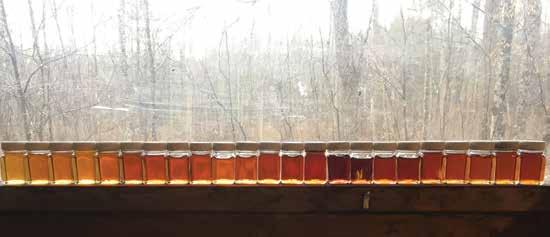
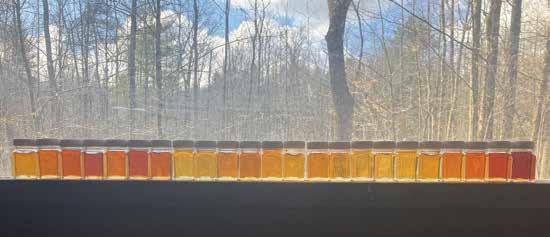
We take a representative sample of the syrup we make on a particular day and put it on the windowsill of the sugarhouse. Note how the syrup was notably darker in 2020 (top) – the weather borne out in the color.
pristine. It’s fun making light syrup. When it’s 50, or God forbid 60 degrees, and the sap’s running through the night, a sugarmaker is running, too, racing the clock to get the sap boiled before it turns of-favor.
In this month of consistent weather, the one notable outlier was a ferce mid-March snowstorm that buried southern Vermont. Forty-inch-plus amounts were recorded in Readsboro (42 1), West Brattleboro (41), and Landgrove (41). Some of the top accumulations
farther north were 31 3 inches in Ludlow, 27 inches in Weston, 26 inches in Danby Four Corners, 25 5 inches in Greensboro, and 24 inches in Warren. Te deep snow was the consistency of fne sand. A friend from Guilford wrote and said: “March snow, four feet when drifted. And soft. I sank on snowshoes and could barely lift my feet to turn around. One neighbor described swimming in the snow to reach another. I watched this.” —Dave Mance III
We looked back at our weather summaries from the past three volumes of the Vermont Almanac and saw that March 2022 was 2.8 degrees warmer than the 21st century average and a banner sugaring year for many producers in northern Vermont. March 2021 was 4 degrees above the 21st century mean and had 5 days of record-breaking heat. March 2020 was also 4 degrees above the 21st century mean, with sugarmakers (including this one) complaining about 50 and 60 degree weather.
stories from & for the land 137
NATURE NOTES
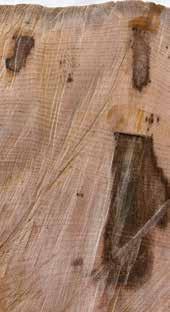
IN THE OLD DAYS , most sugarmakers drilled 7/16-inch tap holes in their maples, and we often drilled deep. Today, most of us are drilling 5/16-inch holes, and the holes are not nearly as deep as they used to be. You can see this change in the accompanying photo of a tree cookie. Te larger stain represents the old style hole, which the tree’s rings suggest was made in 1989. Twenty-one years later the tree was tapped in almost the same spot with the smallerdiameter spout, called a health spout. As you can see, the smaller, shallower hole leaves a dramatically smaller area of stained wood. And with a vacuum system, the little hole likely produced twice as much sap as the larger hole did.
—Dave Mance III
IF YOU SPEND TIME under a maple tree when the sap is running, you may get sap dripped on you from a broken twig above. A less tactile way to observe the sap dripping from wounds in the canopy is to look for dark spots on a section of dry pavement under roadside maples. During March 2023 in southwestern Vermont, there seemed to be a lot of spots on the pavement, resembling a shotgun blast pattern. Tis may have been the result of one of the wet snow or ice events in the preceding months that broke of small twigs. —Mike White
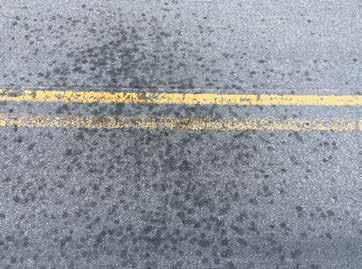
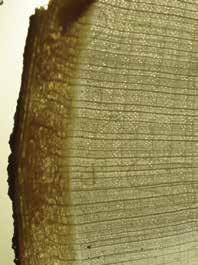
IF YOU ’ RE TRYING TO VISUALIZE SAP FLOW in a tree, this image that Mark Isslehardt captured of sugar maple xylem will help. Te xylem vessels (white circles) conduct liquid –that’s where the sap fows during sugaring season. Te dark brown horizontal lines are ray parenchyma that serve as starch storage. Sugar is stored in the rays and loaded into the xylem through an enzymatic process.
138 vermont almanac | volume 1 v march
MARK ISSLEHARDT
e
1989 2010
A Little Skunk Oil Goes a Long Way
There is nothing like the fresh smell of a spring morning, unless, during the previous night, a skunk skulked about your neighborhood. Te striped skunk is armed with just a teaspoon of odoriferous oil in its two anal glands, but a little bit goes a long way. Tese smelly yet charming mammals have recently been emerging from their winter burrows, and March marks the peak of the striped skunk breeding season. After surviving the winter cozied up in underground burrows in a state of torpor, skunks are on the hunt for a mate. Striped skunks are polygamous; males will mate with multiple females, while females will only mate with one male.
Skunk oil research has been
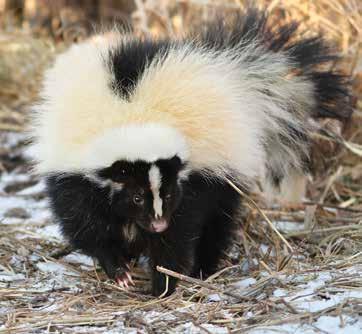
going on for over a century as scientists have tried to determine what makes the stuf so potent that it can drive a bear away. Way back in 1896, Tomas Aldridge at Johns Hopkins University showed that humans could detect the smell at just 10 parts per billion, the equivalent to detecting just one drop of it diluted into a medium-sized backyard swimming pool. More recently, William Wood, a chemist from Humboldt State University, pointed out that a number of chemicals have been incorrectly attributed to skunk oil over the years, and his work has now given us a reasonably complete understanding of the chemical compounds and how to neutralize them.
Te scent-gland secretion is a yellow oil composed primarily of volatile compounds known as thiols and their derivatives. (A thiol is a compound distinguished by its sulfur-hydrogen bond.) Most of us immediately recognize the smell of ethanethiol (also called ethyl mercaptan), a common thiol added to otherwise odorless propane gas so we can easily smell any leaks. Another thiol creates the “skunky” smell of beer after exposure to ultraviolet light. Te thiol derivatives present in skunk oil are not particularly odoriferous, but they are converted to far more potent thiols when they react with water.
Te good news, if you encounter a skunk on an evening walk, is that skunks are reluctant to use their oils. With only enough for a half-dozen sprays at most and a 10-day period required to manufacture more, skunks will only spray if they absolutely have to. In an attempt to avoid spraying, skunks often give warnings. First, they show their striped white back to warn you. Tis is followed by threatening behaviors, like stomping with both front feet, sometimes charging forward and then edging backward, dragging their feet, and hissing. If all this fails, watch out.
Each spray gland has a nipple, and skunks can aim and direct the spray using highly coordinated muscles. A skunk can spray up to 25 feet and hit something fairly accurately up to 7 feet away. When there is a target, they can direct a fne stream right at the victim’s face. When being chased, a skunk will instead emit a foul cloud for the predator to run into.
Te one predator that remains undeterred by the odiferous oil is the great-horned owl. Te small size of the olfactory lobes in their brains suggests that they have a very poor sense of smell. Some individual owls can downright stink of skunk, a common complaint among wildlife rehabilitation workers. Teir nests can even smell of their musky meals. —Kent McFarland
stories from & for the land 139
•
How to Tap a Tree
“Making good tapholes is the most important thing a sugarmaker does each year,” says Abby van den Berg, a research associate professor with the Proctor Maple Research Center in Underhill Center.
Most sugarmakers know this, and yet there’s an odd disconnect in the reality that the job is commonly subbed out. Often this is done out of necessity – one person can only tap so many trees. In other cases, it’s in deference to tradition, when tapping is a family or a social afair that’s always been done a certain way.
Tis all made us want to bear down on the basics and produce a refresher, short and to the point, that a sugarmaker could share with family, friends, and new employees.
USE THE RIGHT BIT
T
ere are plenty of areas where a sugarmaker can skimp and buy the generic equivalent, but a good drill bit is not one of them. A proper tapping bit, available through most maple equipment dealers, has a sharper angle and more twist than the ones in the hardware store; it also has larger futes, which leave cleaner holes. A rule of thumb is that a new bit will drill around 2,500 quality

holes, but if it gets nicked, it’ll be less than that. Always carry two and swap one out if it’s damaged.
MAKE A PERFECT HOLE
Once your bit is seated in the drill, double check the alignment and be sure the bit spins true. Chucks do wear out and start to wobble, which means it’s probably time for a new drill. Square your body to the tree and use two hands to drill the hole. Drill at a slightly upward angle or straight into the stem, and make it perfectly round. An expensive drill attachment called the Precision Tapper, which stabilizes things, has gained popularity in recent years. Some sugarmakers swear by it. Some swear at it.
MAKE THE HOLE IN THE RIGHT SPOT
Every time you make a taphole, the tree compartmentalizes the wound and creates a channel of

Te bottom spout is properly driven, the middle one partially overdriven, the top one completely overdriven.
“non-conductive” wood that runs an inch or two to either side of the hole, and maybe eight or ten inches above and below the hole. Tose numbers are averages –you’ll fnd tree cookies where the wound channel is more or less than normal. Tis stained wood is compromised and won’t be productive. Mark Isselhardt with UVM Extension did a study in
140 vermont almanac | volume 1 v march AT HOME
MARK ISSELHARDT/UVM EXTENSION
MARK ISSELHARDT/UVM EXTENSION
Te proper tapping bit is the one on the left.
which he intentionally tapped wound channels, and those taps averaged 75 percent less sap than clean holes in white wood. Some sugarmakers mark their tapholes with paint, so they’re easy to see the following year. Some tap in a uniform zigzag or spiral pattern, which in theory takes the guesswork out of where the holes are.
HOLE DEPTH HAS A BIG EFFECT ON YIELD
Proctor recently did a threeyear experiment to study how a taphole’s depth afects yield. On average, syrup yield from trees with 1-inch-deep tapholes was 62 percent of the yield from trees with 1 5-inch-deep tapholes. Te yield increased by 20 percent when the holes were drilled to 1 75 inches in depth. Tere were no additional gains for going deeper than 1 75 inches. Based on that study, there’s no point in going any deeper than 2 inches – it’s all downside after that. For mature trees in healthy sugarbushes, 1.75 seems like the sweet spot. But production should be weighed against the reality that a hole is a wound; the deeper you go, the more non-conductive wood you’ll create in a tree. You want to be sure you’re not trading short-term sap gain for a longterm problem. It’s also true that, in an old sugarbush, the deeper you go, the better the chance you have of hitting non-conductive wood in a tree. Study the wood shavings that come out of the hole in every tree you drill. Tey should be white. If you’re hitting brown wood with some regularity, it’s an indication that you need to change your tapping practices.
SET THE SPOUT CORRECTLY
Don’t use a hammer to set a plastic spout – it’s too much tool, and an overdriven spout can signifcantly reduce your yield. (One study, using one brand of spouts, showed a 40 percent loss from overdriving.) Use a rubber mallet, or special aluminum tapping mallet, or even a pine board – something you’re
comfortable with and that has give to it. Once the spout goes in the tree about ⅜-inch, the sound of the mallet hitting the spout will change and become lower – when you hear that, you’re just about there. Check yourself as you go – the spouts should be frmly in the hole, but not so frmly in the hole that you have trouble pulling them out of the tree.
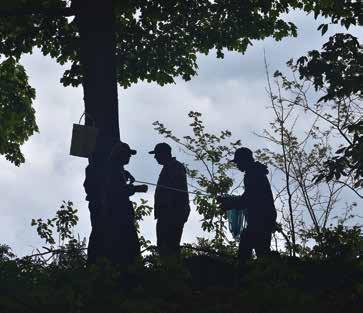
Sugaring School
This past spring, University of Vermont Extension Maple Program and Shelburne Farms partnered with Future Farmers of America and Vermont’s Career Technical Education Centers to hold the fourth annual Vermont Maple Career Development Event. A total of 53 students registered from eight diferent schools. Individual students took part in four areas: syrup grading, tapping skills, tool/ftting identifcation, and general knowledge. Te team competition required groups of students to correctly measure tree diameter to the nearest 0.1 inch, identify where a taphole could be placed, install a functioning lateral line using industryaccepted techniques, test the system with water, and leave the woods free of trash. North Country Career Center (Newport) fnished in frst place, followed by Cold Hollow Career Center #3 (Enosburg), and Green Mountain Technology and Career Center (Hardwick). —Mark Isselhardt
stories from & for the land 141
MARK ISSELHARDT/UVM EXTENSION
Paper Snowdrops for Springtime
Like most of us, after winter slides into mud season, I get antsy for evidence of spring. First place I look is the little patch out back that is home to a clutch of snowdrops (Galanthus) that reappear year after year in spite of extreme weather or boots in the snow. Te 3-inch stems and tapered blooms look like little white fairy lanterns on shepherd hooks, dainty and fragile yet so resilient. Teir stems and leaves are as thin as blades of grass.
One year I decided to make my own little snowdrops out of paper so I could bring them inside.
Paper fowers are an old craft tradition popular with the Victorians and most often made with German
crepe paper. If you want to make lots of paper fowers, there are good sources online for materials that are well worth the investment. Tis time I used ivory-colored book paper from a vintage book in my collection. Old book paper is pulpy, which makes it pliable, and it loves glue. If it’s too old and brittle, it’s going to be hard to work with, so I avoid paper that breaks or cracks when it’s folded. And I look at the text to be sure it’s suitable. One page out of an old thrifted novel from the 40s will give you lots of petals and many snowdrops.
To make your own snowdrop, you just need a pencil, foral wire, white glue, sharp scissors, wire snips, and foral tape. —Charlotte Lyons
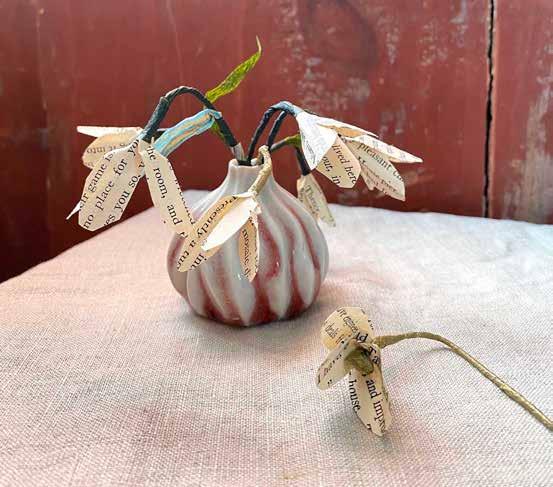
142 vermont almanac | volume 1 v march •

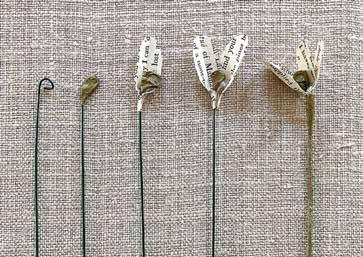
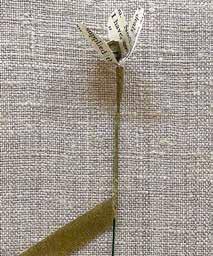
1. Trace the template onto paper. Use it to cut out 3 petals from book paper. Gently fold and crease each one lengthwise.
2. Bend the top of a 5-inch piece of foral wire so it resembles a tiny loop for the fower center. Tear a small piece of sticky foral tape and wrap it around the loop, then pinch it. Te warmth in your fngers makes it sticky.
3. Add a scant dab of glue to the bottom of one petal inside the crease. Set the taped loop onto the petal. When dry, add another petal just beside the frst. And then a third so that the petals surround the loop center. Allow to dry thoroughly.
4. Tear of a 6-inch length of foral tape. At the base of the fower, fold the tape end back onto itself. Angle the tape 45 degrees and gently wrap the wire (think candy cane), holding the tape with your left hand, pulling gently as you turn the wire with your right hand.
5. You can add a leaf cut from a water-colored book page or a thin piece of tissue paper. I used a piece of marbleized tissue from a gift wrap. Decide on placement and add another tape wrap to join the leaf base to the wrapped stem. When fnished, bend the stem gently so it mimics the natural form of the snowdrop. Repeat the process for more! Cluster the stems in a little vase with a small neck.
stories from & for the land 143
1½"
snowdrop petal template
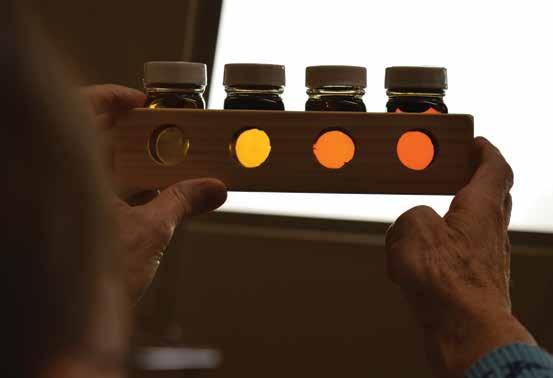
2023 Vermont Maple Season Review
While it’s true that average yields of syrup produced per tap have increased steadily over the past 30 years, the weather during the narrow period of sap collection we know as “sugaring season” continues to have an outsized role in determining if it’s a good season, a poor season, or something in between. Perhaps it’s this knowledge that informs the saying amongst sugarmakers who have been at it for a while: “if you have seen one sugaring season, you have seen one sugaring season.”
Overall, the 2023 maple season failed to meet many producer’s expectations, largely due to less-thanideal weather during March and April. Tis comes in contrast to the previous season (2022), which saw
better conditions for sustained sap fow at operations across the region. Vermont’s 2023 crop as reported by USDA-National Agricultural Statistics Service was just over two million gallons of syrup, down 20 percent compared to 2022. Some context is needed, though: at the statewide level, compared to a fve-year average, production was down just below 2 5 percent. Many Vermont maple producers reported most of their crop was made up of good quality syrup and that sap sweetness was generally average or slightly above average. Tis observation might help explain reports of a higher proportion of the 2023 crop being in the lighter color grades of syrup (Golden/Delicate and Amber/Rich) compared to other years.
144 vermont almanac | volume 1 v march
INDUSTRY f
Te 2023 season saw many producers making high quality, lighter-grade syrup.
Local climate was a major factor in 2023, with warmer sugarbushes producing more than those in colder settings.
Te trend of larger operations beginning to tap in December continued in the leadup to the 2023 season. Tere are practical reasons for early tapping: if you’re tapping 50,000 trees, and an employee can tap 200 trees a day, it’s going to take a 3-person tapping crew 83 days to fnish the job. But the trend receives a lot of attention when the sap is running in January and February and the syrup barrels are flling up.
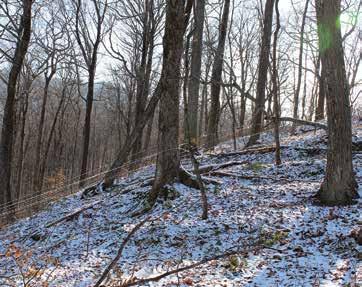
A producer in Bennington County reported on February 15: “I can’t remember a year like this. It’s not uncommon to get little hiccups in February, where you’ll a get a two- or three-day warm spell. But it’s been sustained good sap weather for a few weeks now.”
Sugarbush site characteristics (elevation, aspect, and topography) often play a role in determining how well sap fows in a given location. In seasons such as 2023, site plays an important role, whereas other years (2022) location seems to have less of an impact. Tis year, we asked a group of maple producers if their sugarbush was generally warmer, colder, or about the same as producers around them. A follow-up question asked how close they came to reaching their anticipated total production. Perhaps not surprisingly given the predominantly colder temperatures seen across Vermont in March, maple producers who reported having sugarbushes that were generally warmer than others around them came closest on average to reaching their anticipated total (96 percent) compared with those with relatively colder woods, who averaged only 77 percent of their anticipated crop. Perhaps even more striking is the range in production between those with colder woods and warmer woods. Tose who reported having warmer sugarbushes saw production from 91 percent of the anticipated total to over 100 percent. Contrast that with the wide range reported by operations with colder woods, (everything from 50 percent of their anticipated crop up to 96 percent). A caveat to this is that some producers who reported having colder woods than their local peers
About the same Colder
nonetheless did alright because they hailed from generally warm areas (southern parts of the state or the Champlain Valley); it was the colder sugarbushes in parts of the state with generally colder temperatures (Essex, Orleans, and Caledonia Counties in particular) that struggled to come close to making a full crop. To illustrate this point one step further, by the third week of March, producers in generally warmer areas had produced over 50 percent and in some places over 75 percent of their target production, whereas colder areas were struggling to reach 10 percent of their anticipated crop.
In the end, Vermont made enough pure maple syrup to once again remain the largest producer in the US and represent half of all the syrup made in this country. Overall syrup quality was good, demand for natural ingredients such as pure maple syrup remains strong, and whether we wanted it or not, 2023 was another opportunity to remember that climate and weather play important roles in the production of this unique non-timber forest product. —Mark Isselhardt
stories from & for the land 145
PERCENT OF ANTICIPATED CROP MADE IN 2023
Warmer
50 60 70 80 90 100
How Vermont Became
Astate is a constructed thing – lines drawn on maps by settler colonists, cartographers, and surveyors. Yet Vermont is bound by lines that are geographic as well as human – a river to the east, a lake to much of the west. What’s inside those lines? Where does a land come from?
Tere are many places to begin the story; this one will start when Earth formed, about 4 56 billion years ago. After coalescing out of the disc of dust and gasses that spun around our young sun, Earth began its life as a big, roundish hunk of mostly molten rock. Over the next few hundred million years, oceans formed from condensed water vapor that steamed out of those rocks, along with some water from bombarding comets. But it took another billion years or so for the frst dry land to appear on our planet. Slowly, over time, volcanic islands emerged from the seafoor. Tose islands grew out of chunks of oceanic crust, defned by sutures, and became what we now know as tectonic plates. Over time, these plates shift and shufe, with a few hard and fast rules: When denser oceanic crust pushes up against less-dense continental crust, the ocean crust always loses and sinks back into the earth’s deep mantle; when continental crust meets
continental crust, both “win” in an epic pileup that leads to the formation of mountains and intense heat and pressure, which change old rocks into new ones. Because of this shift and shufe and these few rules, early volcanic islands moved around, smacked into each other, and coalesced into the frst small continents.
Great! Now we have continents, which means we can fast-forward a few billion years and move closer to the present, into the Paleozoic Era. By this time, starting 541 million years ago, much had happened. Life had evolved and become complex. Seaweeds flled the oceans, along with swimming, crawling, and squirming animals. Life on land probably consisted mostly of bacterial and fungal crusts, but that would change soon enough, as well. By this time, the pieces of continental crust that make up today’s Adirondacks and the core of the Green Mountains had already formed during a mountain-building event called the Grenville Orogeny. Tis ancient mountain range was the result of continental collisions, and it led to the metamorphism (changing due to heat and pressure) of earlier sedimentary rocks and the seemingly random appearance of igneous rocks from deeper within the earth.
But if you had walked of the
slopes of the not-yet-towering Greens during the Cambrian and Ordovician Periods (between about 540 and 440 million years ago), you would have walked right into a tropical ocean, not New Hampshire. Everything east of the Greens and the Berkshires today just . . . wasn’t there. And even on the western side of the Greens, the continental crust had sunk, letting seawater food in. With the sea came sediment, drifting down through the ancient water onto what would eventually become our state –sands that turned to sandstones, muds that turned to mudstones. And in these ancient oceans, life! Only a handful of remnants of this life still survive in Vermont today, in thin slivers of unaltered marine sediments that were deposited and preserved on the ancient coasts of Vermont. Te most notable are the Ordovician reefs of the Champlain Islands, but there are more well-hidden spots where trilobites, manysegmented arthropod relatives of modern lobsters and horseshoe crabs, can be found as well.
Te story of Vermont is a story of collisions, and the one that formed the Greens and the Adirondacks was just the frst. Starting around 450 million years ago, another set of volcanic islands crawled across the ocean, moved by the conveyor belt of
146 vermont almanac | volume 1 v march
A LOOK BACK •
subducting ocean crust. Tis island chain piled up against the coast of Vermont in a mountain-building continental accretion event known as the Taconic Orogeny. Tis event is, as you may have surmised, responsible for the formation of the Taconic Mountains in the southwestern part of the state. It is also responsible for adding a lot of continental crust to the eastern edge of the state, pushing the coastline closer to its present-day position. About 75 million years after the Taconic Orogeny began, the most recent (yet still so ancient!) in this long series of accretionary events happened: Te Acadian Orogeny is responsible for the formation of the White Mountains in New Hampshire and much of the rest of the Appalachians. While the Acadian Orogeny didn’t make any new mountains in Vermont, the intense heat and pressure that occurred during this event are responsible for the formation of granites in the Barre region and in New Hampshire. And even more importantly, the Acadian Orogeny is the reason the ancient Green Mountains, whose rocks formed hundreds of millions of years earlier, got pushed up through younger rocks and sediments and transformed into their current state. Tis accretionary collision also spelled the end of coastal Vermont: At its conclusion, the world’s continents were sutured together into the supercontinent Pangaea. When that agglomeration began to pull itself apart during the Triassic Period, about 200 million years ago, many regions of thinned crust formed, like windows in pulled dough. One of those windows
tore fully apart to become what is now the Atlantic Ocean, but another turned into what is now the Connecticut River Valley, defning the eastern border of our state.
With the era of giant mountain-building and the accretion of new continental material over, Vermont has since mostly undergone erosion. Over hundreds of millions of years of summer rains and winter snows (and sliding, scraping glaciers), the Taconics, Greens, and Appalachians – once towering, jagged ranges – have been softened into the familiar undulations we see today. In just the last million years, at least eight cycles of glaciation have shaped Vermont’s landscape.
Tese glaciers, the most recent of which began melting just 16,000 years ago, left their mark on the land all around us, from the hulking, erratic boulders scattered through our forests to the long
scratches in smoothed rock faces on the sides of our mountains and hills. Most signifcantly to the lines that bound the state, the melting of this last glaciation left behind what is now Lake Champlain, which was initially connected to the Atlantic Ocean to the north as the Champlain Sea. Over time, as the continental crust beneath it rebounded from the removal of the massive weight of glacial ice, this connection to the ocean was cut of, and Champlain became the freshwater lake we know today. So here we are, somewhere within the bounds of this state of Vermont, defned by lines both natural and manmade. A land formed by powerfully slow and inexorable processes – collisions, oceans, and erosion. A land that is now being altered by processes potentially just as inexorable, but this time rapid in pace and driven by our own species.
—Phoebe A. Cohen
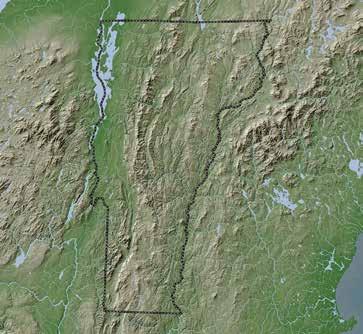
stories from & for the land 147
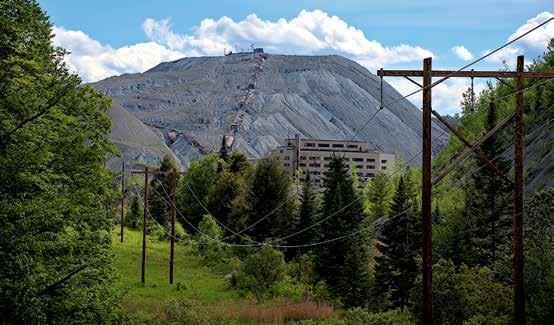
Nothing Good Without a Curse
From a distance, the Belvidere asbestos mine appears as an enormous pale scar on the landscape. Located on Belvidere Mountain, the mine spans Eden and Lowell townships with a complicated story far beyond mere curiosity.
Valued for centuries as a miraculous substance, asbestos was the stuf of kings. A retardant against fre’s ferocity, the snow-white combination of minerals also functions as an insulator. Charlemagne, the famed emperor who ushered Western Europe out of the Dark Ages, was rumored to have used tablecloths woven with asbestos to awe his dinner guests when the coverings were cleansed in a crackling fre.
In 1899, the Tucker Asbestos Company was the frst formal organization in a series of owners that bought, sold, and renamed the Belvidere Mine. By the early 20th century, what was known then as the Gallagher Mine produced asbestos for multiple uses, including theater curtains and fremen’s boots and gloves. Henry Ford’s Model T used Belvidere asbestos for clutch and brake linings.
By World War II, the mine (then the Ruberoid
Corporation) stafed three shifts. In the booming ffties and sixties, the mine’s payroll swelled to 250 employees. In all the reiterations of reorganizing, the mine provided a livelihood for generations of families in towns that lacked economic options. Te land here is primarily wooded and jaggedly mountainous, unlike the fertile farming soils in the Champlain Valley. Te area boasts picturesque Lake Eden, but tourism never truly fourished here, unlike the tonier summer resorts of Manchester and Woodstock.
Asbestos was milled on the site, too. Te quarried rocks were kiln-dried and crushed into gravel. Te gravel was agitated on screen tables to release the asbestos fbers, which were extracted via overhead vacuum pipes. Rotating machines spun and sorted the fbers. Te fnished fber was packed in bags and shipped to consumers, including Dow Chemical and Georgia Pacifc.
In the early seventies, the devastating health efects from inhaling asbestos – lung cancer, mesothelioma (a type of cancer), and asbestosis – entered the public’s awareness. Facing prohibitive safety upgrades, the
148 vermont almanac | volume 1 v march
Belvidere Mountain today, piled high with tailings from the asbestos mining operation that ran here for decades.
LEE ALLEN
mine foundered, and closure hovered. Te workers rallied, however, raised two million dollars (including state and federal funds), and purchased the company. Vermont Asbestos Group, known as VAG, became the largest American producer of asbestos.
Asbestos mining in Vermont hit its death knell just twenty years later, afected by stricter environmental regulation and global competition. Te United States continues to import signifcant amounts of asbestos. When the gates were locked and the miners lost their jobs, the paychecks ceased, but the story of the mine didn’t. After the mine and mill closed, the rock was inert. Was the mine still a signifcant health hazard, or not? For decades, humans and heavy equipment had dug up the earth. Te question was: what to do with that site now? •
In the mine’s operating decades, an extensive road network had been built on the 1,700-acre site. When the mine closed, the roads and culverts were no longer maintained. Erosion from the tailing piles flled wetlands and beaver ponds. ATV afcionados streamed into what became an of-roading mecca. At the same time, Vermont’s weather continued its ravages. At 3,360 feet high, Belvidere is a vertebra in the Green Mountains’ spine, a craggy range of rock and water. Straddling two watersheds – the Lamoille River to the south and the Missisquoi River to the north – water rushes down the mountain north and south.
Te severe erosion attracted the Agency of Natural Resource’s scrutiny, which led to the involvement of

the Environmental Protection Agency. A series of berms and settling ponds were constructed to mitigate the erosion, at a cost of over $1 4 million. However, the EPA was concerned about the airborne health efects of asbestos, too, and pushed to have the mine declared a Superfund site. In practicality, this would mean that the towns of Lowell and Eden would also be smeared with the Superfund label while the cleanup was in progress. Te proposed remediation was far from formulaic. How could a mined mountain be tidied up and returned to stasis? One plan was to raze the tailings, truck in dirt from the other side of the state, and bury the piles. Te logistics of this endeavor are boggling. Was this possible? Plausible? Desirable?
Te EPA and the Agency of Natural Resources insisted a Superfund-sized remedy was required, with an estimated price tag between $250 to $500 million. Te state of Vermont, which ran a defcit at the time, would kick in 10 percent.
What the folks working for the state and federal agencies may or may not have anticipated is that people living in the towns and surrounding area weren’t entirely in lockstep with the Superfund plan. In November 2008, the Vermont Department of Health mailed a study to all Lowell and Eden residents. Tis initial study identifed a statistical increased risk of mortality and morbidity in a ten-mile radius from the mine, based on data from 1996 to 2005. In a pool of nearly 17,000 residents, the study noted fve nonoccupational asbestosis-related deaths. Te study cited only data and wouldn’t – or couldn’t – identify the specifc towns where these deaths occurred. Te proposed Superfund status hinged on this study.
Eden resident and selectboard member Leslie White wanted to know details about these fve deaths, so she spent three days in area town clerks’ ofces searching death certifcates. White identifed four of the fve. Two were miners. One was a dairy farmer who worked part-time at the mine. Te fourth, a shipbuilder, was originally from the Midwest and had been diagnosed with asbestosis before moving to Vermont.
Which left one unknown death.
Debated, also, was the mine’s toxicity. Amphibole asbestos’ long fbers are documented as toxic. Te hazard level of short-fber chrysotile – the type mined on Belvidere – is not fully determined. By the time of the Superfund question, the chrysotile Belvidere tailings were inert. Did the tailings pose airborne
stories from & for the land 149
Early days: the mine circa 1904.
hazards? If so, how much at risk were the surrounding residents?
For years, the mine had ofered the crushed byproduct free to municipalities. Innumerable truckloads were trucked around the northern tier of Vermont. From the ffties through the seventies, it’s estimated that over 92,000 cubic yards were trucked around the state. Underbelly sections of I-89 were constructed from Belvidere rocks. How far would –or could – a clean-up extend?
•
T
ere’s a green thread, too, in the white asbestos story. About twenty years or so ago, botanist Don Avery began trekking from his Morrisville Cady’s Falls Nursery to Belvidere. Zealous about understanding the natural world and collaborating with a University of Vermont graduate student doing thesis research, Avery discovered that every time he visited the defunct site, “I found more weird stuf that nobody had seen before.”
Decades of intensive mining disrupted a mountain that had lain intact for millennia and unearthed rock known as serpentine. Created thousands of years ago when continents collided, serpentine contains ancient ocean sentiment. Mining dug up that serpentine and left it exposed. After miners stripped out the white
chrysotile ribbons, what remained were enormous tailing piles.
Around the globe, unusual plants thrive in disturbed areas: landslides, avalanches, wildfres, roadsides. What appears initially as destruction or sterility metamorphosizes into a creative wonderland. Te Belvidere mine is a colossal human-disturbed area. In a thumbnail, Avery and his botanist companions observed that the mine’s open wound was fertile ground for plants markedly diferent from those growing nearby in undisturbed soil. Native maidenhair ferns thrive in Vermont’s rich forests, including those adjacent to the mine. On the mine’s serpentine soils, however, the western maidenhair fern appeared on the exposed serpentine.
To their surprise, Avery and his companions also discovered a diferent fern, a hybrid between the western and northern ferns, that Cathy Paris, a Field Botany professor at UVM, named the Green Mountain maidenhair fern. Maidenhair ferns are well-named. Lacy, delicate, and like that anachronistic word maiden, far more rugged than appears at brief glance. Avery found all three species growing within 100 feet of each other.
In experimentation, he planted the Green Mountain maidenhair fern in his own garden. Te fern volunteered and began spreading. Why the fern took to Avery’s common garden dirt, he can’t explain. Te plants, he says, are part of the mine’s mysteries – a botanical dream, that no one has been able to explain. •
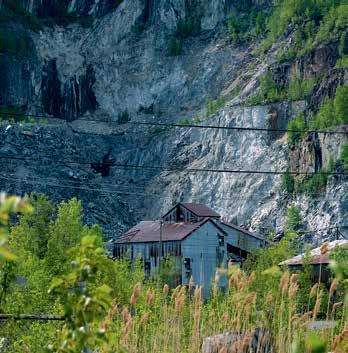
Meanwhile, the Superfund debate raged. After local papers picked up the story about the unknown ffth person in the Vermont Department of Health study, a woman came forward. She believed her stepfather was the unaccounted death. A former shipyard worker in Florida, he had been diagnosed with asbestosis before relocating to Vermont. After community outcry and a resolution passed by the Vermont House and Senate, an amended survey was released the following April that acknowledged there were no data that
150 vermont almanac | volume 1 v march
ALLEN
LEE
people living near the mine were more likely than anyone else in the state to die of non-occupational asbestosis.
Vermont’s governor at the time, Peter Shumlin, agreed that a Superfund clean-up wouldn’t be pursued without approval of Lowell and Eden voters. In 2012, the towns voted overwhelmingly in opposition.
After that, the mine was largely left alone, save for rogue visitors drawn to the terrain for its plants, rockhounding, and of-roading, or simply out of curiosity.
•
At the center of this long-running saga stands the mountain itself, mightier than any individual or group or generation. Drive around a curve in the backroad and the tailings abruptly loom, immense mounds of debris. Vermont is crammed with quaintness – white-clapboard churches and covered bridges, schoolhouses, and monuments – but the mine site is a strange anomaly, with its taint of toxic barrenness, a what’s all this about? In the ffth century B.C.E., Sophocles wrote, “Nothing great enters the life of mortals without a curse.” Asbestos could be seen as a small slip of that great notion, or a metaphor for how we live. Tose decades of mining and milling asbestos yielded a product that went out into the world in ways neither glitzy or sexy but utterly utilitarian. Brakes in our cars and pickups, gaskets and clutches, pipe insulation, and so on. Our world continues to rely on these industrial products, although the origins of their elements are often not readily visible.
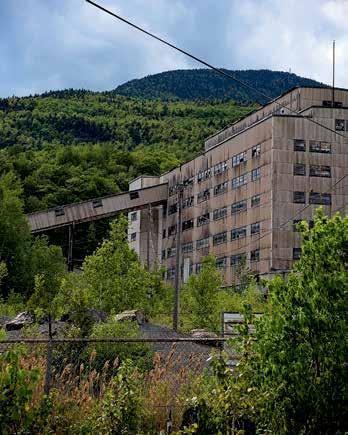
Te mine is not a tourist destination, not on a well-maintained road, and defnitely not open to visitors. In places, the tailings left around the steep, vast perimeter of the inner mine have tumbled nearly to the road, although the heart of the operation is deep within that immense rubble. Tese mountains have been here, as Don Avery said, for over four million years, and lush forests edge right up to the tailings. Te delicate beauty of ferns brushes against gray and green rock scree, stripped through with white. Te white fakes in tiny pieces: chrysotile asbestos, easily shined up in a summer shower.
Today, the Belvidere mine entrance is barricaded, the buildings abandoned. Te sheer size of the site is daunting. Te immense fat-topped piles, scattered with isolated trees and remains of buildings and power lines, transform this terrain into a ghostly gray no-man’s land. Tis is mountainous country, with houses and trailers and hunting camps interspersed in the verdant woods. Te people who live here inevitably have made a reckoning not only with the wilderness and isolated winters, but also the mine.
From the view of a drifting red-tailed hawk or turkey vulture, the mine lies at the nexus of a human conundrum: to extract and to use, to convert and build, with the hidden innards of our planet. At the base of those piles, beavers build lodges. Water trickles and often surges. Te woods creep around with their lush power. And the Green Mountain maidenhair fern? Tose delicate fronds, beautifully crafted with their sweeping petals, sink their slender roots into the earth, claiming ground. —Brett Ann Stanciu
stories from & for the land 151
LEE
ALLEN


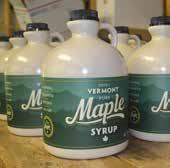
VERMONT MAPLE SUGAR MAKERS’ ASSOCIATION
Founded in 1893, the Vermont Maple Sugar Makers’ Association is one of the oldest agricultural organizations in the United States. Its membership includes sugar makers big and small, as well as others who are interested in supporting the industry and Vermont’s working landscape. The Association works to offer our members benefits and education on industry research and updates, best practices, food safety regulations, product innovations, and more. In addition, we serve as the voice of Vermont maple and share information with consumers across the county and the world.
You can find recipes, news, and information on how to become a member at vermontmaple.org
152 vermont almanac | volume 1 v sponsor

Vermont Evaporator Company
Born in Central Vermont in 2015, Vermont Evaporator Company makes barrel-style, wood-fired evaporators for the backyard sugarmaker.
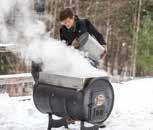
Kate Whelley McCabe, CEO of Vermont Evaporator Company, was looking for an easy way to make maple syrup in her backyard with her family, without the need for a sugar house. Kate and her husband Justin McCabe searched but could find nothing on the market for their modest backyard operation. After trying all the usual tricks, heating on the grill, in a big pot on the stove, and over a propane burner, Kate and Justin put their heads together and the Sapling Evaporator was born.
The Sapling Evaporator is a barrel-style evaporator that is meant to be used outdoors, is light enough for Kate to move around the yard, and uses a bafed stainless steel pan. Kate and Justin have designed the Sapling so that it can be useful in the summer months as a grill, smoker, and even a bread and pizza oven.
The Sapling Evaporators are handmade in Montpelier, Vermont, from locally sourced materials. Kate and her team intend to make sugaring more accessible to everyone.
“We work hard at showing people how easy it is to make syrup in your backyard. Anyone with access to the trees can do it. And then we try to make the process even easier and more fun!”
vermontevaporator.com
Kate still marvels at how much there is to know about sugaring beyond the usual “how-to” focus: “We have a blog that we use to contextualize sugaring by writing about history, science, current events, nature, industry, climate, culinary arts, and literature.”
stories from & for the land 153 sponsor
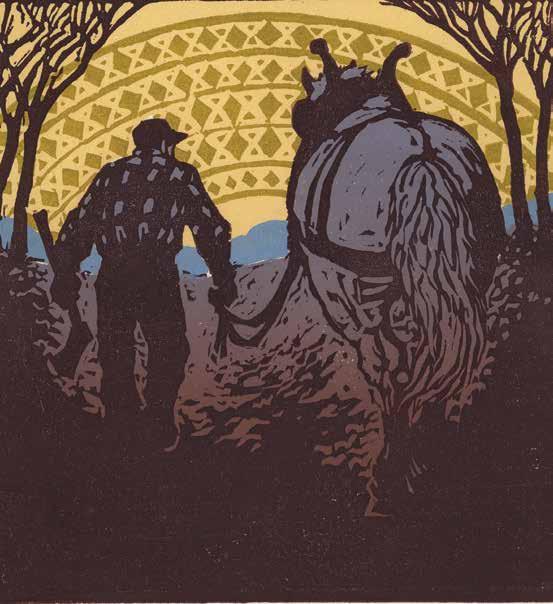
APRIL
stories from & for the land 155
Ephemerals
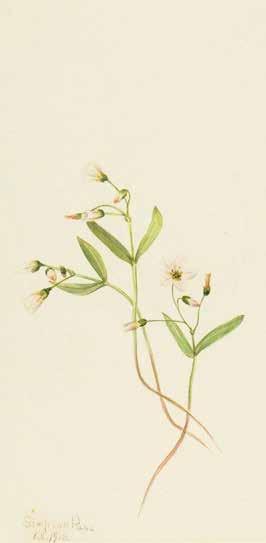
Tonight is the night. After months of thin winter air, a warm breath has blown in from somewhere south, thick with moisture, and at dusk, it begins. From the fen, a single, short eep, like a creaky old door. Ten another, a few seconds later. Te peeper continues for half an hour as the sky darkens and a fne mist falls, and then, miracle of miracles, somebody answers. Tere’s another peep, and another, and soon the night is flled with them, a squeaky jam session.
Spring peepers! We pad across the backyard, no lights, and follow the trail to the fen. We’ve been waiting for this, toeing the party line about how wonderful winter is, keeping a stif upper lip through the March mud, when really all we wanted was stuf happening. And now it is.
We keep quiet and still, but the closest frogs sense our presence and clam up. Farther out in the fen, though, from every reed and willow, they are peeping like mad. Te sound rattles around your brain until you think you might go mad yourself, but it’s a happy spring madness, a bacchanal of mud and sex and blissed-out organisms. It sings to all who will listen that right now, this is the place to be.
Tat’s how we felt when we moved into the old farmhouse 20 falls ago. We arrived just in time to watch the hillsides oxidize, then hung on tight through the dark and cold until spring came. Suddenly there were peeps in the fen and mysterious fowers in the woods. We felt like newbies at an old New England summer colony. Te maples and the robins and the birches had been here for generations. Tis is how we do it, they seemed to be saying. Te house itself had seen 175 summers. We just tried to ft in.
Te peeps pipe down at dawn. We follow the trail past the fen, listening to the churr of red-winged blackbirds camped out on last year’s cattails. In the woods, we search for spring ephemerals – the tiny ground-huggers that make the briefest of appearances. With no leaves in the canopy, the mossy ground glistens with light. We stoop to examine trout lilies, their leaves speckled like brookies. Here’s a patch of pink-veined spring beauties, intensely perfumed if you get your nose right down next to them. We even spot some Dutchman’s breeches, their pufy white petals like pantalooned acrobats in mid-split.
Let’s face it: A month from now, when lilacs
156 vermont almanac | volume 1 v april
MARY VAUX WALCOTT / SMITHSONIAN
and crabapples are drenching the landscape in scent and color, these pipsqueaks wouldn’t merit a second glance. But right now they are the only game in town – which, of course, is their whole plan. Tese little forest fowers live their entire life cycle before the trees have leafed out. Sprout, fower, get knocked up, go to seed, disappear. Te sun is all theirs, as are the few pollinators. In a few weeks, we’ll never know they were here.
Te ephemerals have always seemed like the weirdest residents of the summer colony: arrive when it’s still nasty out, and then vanish just as things are getting nice. Why not stay all summer like the robins and the roses? But the more springs I get to know them, the more I learn the lesson they have to teach.
As we climb the muddy trail through the woods, signs of time are everywhere. Old cellar holes. Centurion apple trees. Slate-lined springs dug by some determined soul. From the top of the hill, we look down on our house and felds. Anywhere I dig in those felds, I come up with cans, wires, and old tools. We live atop the scraps of an earlier culture.
Heck, when we bought the place, the fagstone basement was flled with the knickknacks of that earlier culture. For decades the house was occupied by a couple who ran the local hardware store, and they were serious pack rats. Quirky and colorful, they were a local institution … and then they were gone and forgotten, a mossy headstone in the country cemetery, their reign as evanescent as this year’s spring beauties.
Beneath a stand of ash we discover a carpet of white bloodroot blossoms, their leaves wrapped around their stems like capes. When I see these plants pushing their noses up through the last bits of frost, I picture the Vermont of 12,000 years ago, when a warming world thawed the glaciers and released the land. For 90,000 years before that, this place was dead.
When the frst humans arrived, chasing the caribou that were chasing the tundra, there were still no trees, just rocks and sedge. We predate the forest.
Hike Mount Mansfeld above treeline and you’ll get a sense of that landscape. Te frst trees – coldloving spruces and frs – didn’t arrive for millennia.
Hike Mansfeld a thousand feet lower and you’ll get a sense of that landscape. Keep dropping toward the valley foor and you’ll be fast-forwarding history as the birches and aspens arrive, then beech and maple.
Sometimes I play that history in my mind, the mile-high rivers of ice bulldozing the earth, then retreating in a gush of silty meltwater, the frst shrubs popping up and the caribou herds fowing across the land, human hunters behind them. Ten, as the sun and moon whir overhead and the snows come and go, but mostly go, the frst trees pioneer the tundra, and soon the new forests march up the river valleys and over the hills, all the species of the mixed woods swirling together and jockeying for territory, water welling up through bedrock to form the fens, frogs fickering in and out of existence like specks on an old movie reel, and then, late in the flm, the settlements come up the same river valleys, men with axes clacking like windup toys, grasses and sheep chasing the forests back to the most inaccessible slopes, towns edging out from the rivers, until, in the last few seconds of the flm, the men with axes disappear, the sheep disappear, the old houses melt into the earth, and the forests come fowing back down the hillsides and over the cellar holes.
And here we are, the latest arrivals to this wild interglacial happening. Like all recent arrivals, we assume that everyone else has been here forever. But we’re all newbies. Us, the old hardware couple, the honeybees and dandelions before them. Even the birches. Tese forests are still jockeying for the best plots, and they will continue scrapping as the climate warms. Tey’re still making up the rules as they go. With its glacier-rounded peaks and weathered farmhouses, Vermont can feel ancient, but it is eternally new.
Te next night is even warmer – strangely warm, in fact – and the chorus intensifes. Te peepers start raging at twilight, joined by clucking wood frogs and a piping thrush. We hover on the muddy edge of the concert, listening. It feels like the beginning of something important, but it might just as easily be the end of something sweet. Te point, as the spring ephemerals teach, is to keep your perspective.
In weeks, the peepers will have gone silent and the spring beauties will again retreat into the earth. Not so long after that, we’ll follow. Tings will keep changing, and the next generation to arrive will look around the place and assume what is, is. And they’ll be wrong. It’s never been like this, and it never will be again. —Rowan Jacobsen
stories from & for the land 157
R
More Record Warmth
The weather skewed hot again in April. According to NOAA data, the average temperature in Vermont was 5.1 degrees above the 20th century mean; 3 6 degrees above the 21st century mean. Many places saw their warmest April on record.
Sugarmakers in northern Vermont were hoping to make up for lost time after a cool March, but that was not to be. Warm is
one thing, hot is another. By the second week of April temperatures were near 90 statewide, which thoroughly killed the sap season. Burlington saw two daily record highs of 88 degrees and 85 degrees respectively.
As you can imagine, the warmth threw the phenology all out of whack. Sugar maple trees at the long-term phenology monitoring site at Proctor Maple Research Center in Underhill
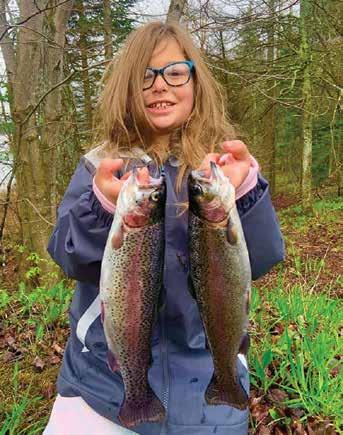
broke bud on April 20, which is 12 days before the longtime average. Researchers noted that “buds were largely dormant until an unusually warm week of weather accelerated development.”
Dafodils peaked in the Champlain Valley by the 20th, and there were reports of blooming tulips in April in warm areas across the state. In southwestern Vermont, we noticed our frst morels of the year on April 26; by
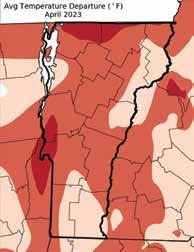
Vermont’s April fshing weather doesn’t get much better than it was in 2023 Fishing guide Jacob Bashaw took his step-daughter, Mackenzie Lawyer, out on the second morning of the season and she caught this beautiful pair of trout while trolling in a canoe on Lake Echo in Charleston.
158 vermont almanac | volume 1 v april WEATHER
JACOB BASHAW
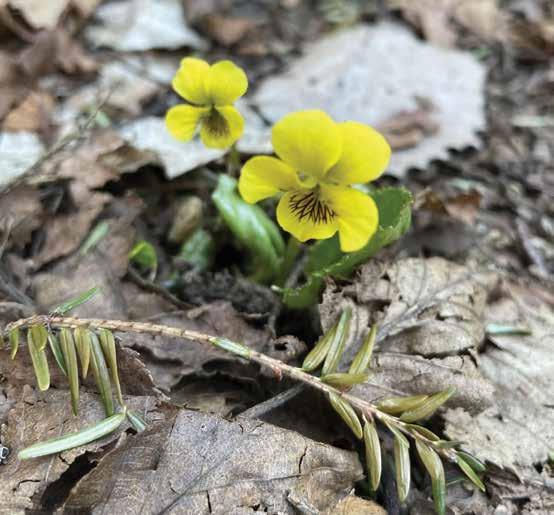
May 3 a frst fush was big enough to harvest and eat. Apple buds were reported maturing to the “late pink stage” in the Northeast Kingdom in mid-April, a week earlier than historic observations. Tis set the stage for an epic freeze-damage event in mid-May.
Te frst week of trout season in Vermont is often an optimistic and aspirational afair, where
fshermen and women drag their kids out into the cold to try to catch lethargic fsh. It’s a rite of spring. Tis year, temperatures during the frst week averaged in the 70s and 80s – it was like summertime and the best frst week in memory to have taken a kid fshing.
It wasn’t an abnormally dry month, but the abnormal heat,
combined with the dry fre conditions that happen every year in that window between snowmelt and leaf out, led to a spate of small wildland and brush fres that continued into May. It was foreshadowing, in a sense; at the time no one had any idea that wildfre smoke from Canadian forest fres would become a recurring theme throughout the summer.
We looked back at our weather summaries from the past three volumes of the Vermont Almanac and saw that April 2022 was a pretty typical month with “normal” averages. April 2021 was warm and very dry. April 2020 was meaningfully colder than normal by an average of 3 4 degrees.
stories from & for the land 159
Teresa Rowe spotted this yellow violet in the woods of northern Vermont on April 15, 2023.
THERESA
ROWE
THE GOLDENROD GALLS
we highlighted in February are just one example of hundreds of diferent kinds of galls found in nature. Tey can be caused by insects, but also by fungi and other organisms. Most are harmless, but as in the case of these bitternut hickory galls, they look atrocious.

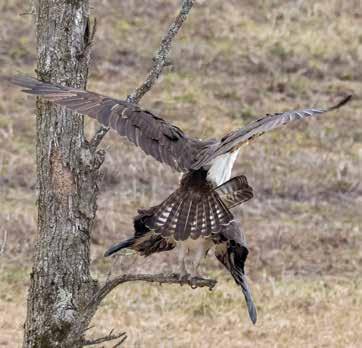
eConsistency in an Inconsistent World
Every year we have the opportunity to witness and compare the timing of the annual spring appearance of plant and animal species where we live. Keeping a journal and noting over a period of years when, for instance, silver maples fower, killdeer reappear, spotted salamanders emerge, can provide valuable phenological information. It can also be a wonderful personal reminder as to when you should keep your eyes open and what you should keep them open for.
As a rule, ospreys return and engage in copulation during the frst week of April in the Champlain Valley of Vermont. I know this only because I’ve jotted down my observations in a journal I’ve kept over the past 50 years. Each spring I religiously review past years’ journal entries for where I am currently living. Tis year’s review made me aware that chances were as good as they get for witnessing raptor courtship this week. A trip to a local osprey nest confrmed that they had indeed returned. Two hours of waiting was rewarded with the accompanying photograph. (Tey copulate an average of 160 times per clutch, so luck was in my favor.) If you’re fortunate enough to live in the same area for a long time, journaling can be an invaluable tool for the naturally curious. —Mary Holland
160 vermont almanac | volume 1 v april
NATURE NOTES
LIZ THOMPSON
MARY HOLLAND
Naming Names
The development of genetic analysis has greatly expanded the feld of taxonomy. Tis has led to a better understanding of how species are related and a reorganization of the phylogenetic tree of life – a frustration for folks who learned taxonomy decades ago! As more is learned, species’ scientifc names shift, and where they ft in the taxonomic structure shifts. Tis is especially true with plants. For example, our dogwoods (red osier, bunchberry) were once all in the genus Cornus. Although Cornus is still a genus, the dogwoods in Vermont are now classifed as members of one of four newly created genera. Te dogwoods did not change families, they’re still in the Cornaceae Tis is not the case with our maples. Once recognized as being in their own family, Aceraceae, they are now classifed as members of the soapberry family, Sapindaceae. Guidebooks may not contain current Latin names and family afliations. Te Native Plant Trust’s Go Botany website is a great resource for current information, and it includes previous species’ scientifc names for cross-referencing. —Mike White
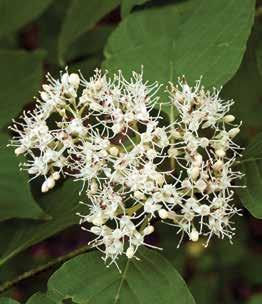
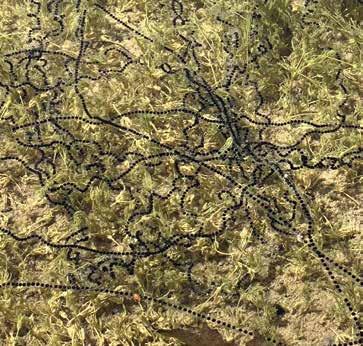
THESE STRINGS OF LITTLE BLACK DOTS you might see in an April pond are toad eggs.
HEAVY - BODIED AND SOMETIMES 3 INCHES LONG , these giant water bugs (Lethocerus americanus) are sometimes attracted to lights and can be alarming as they bomb around in the night. Most often they are found in ponds or slow-moving marshes and streams. When hunting, they inject venom into their prey and then suck out the juices – frogs and minnows beware.
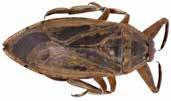
stories from & for the land 161
CHARLES WOHLERS / CC
Alternate-leaf (or pagoda) dogwood: formerly Cornus alternifolia, now Swida alternifolia
AT HOME
•
Edward Koren, 1935–2023
Ed Koren was known around the world as an accomplished artist and cartoonist, with his work appearing perhaps most prominently in Te New Yorker magazine from 1962 until the time of his death this April. But in Brookfeld, which he called home since 1978, he was known simply as a friendly, generous neighbor and dedicated member of the volunteer fre department for more than 30 years. “He was born in New York and frst came to know and love Vermont while attending a theater camp in Waitsfeld as a teen,” his wife, Curtis, told us.
Koren’s easily recognizable pen-and-ink drawings feature somewhat beastly creatures with over-sized noses and wild, shaggy hair. Often there is humor behind his doodlings, and as longtime New Yorker cartoon editor Robert Mankof explained, “ Te humor has humility. It doesn’t think it’s going to change the world, but it still thinks it’s worth telling you how strange the normal really is.”

In many cases Vermont – both its residents and visitors – take center stage. “He took notes while out and about, returning to his home-studio in Brookfeld to gently satirize the Vermonters he encountered,” wrote VT Digger editor-in-chief Paul Heintz in a memorial story. He did the same with those in the big cities. In all cases, his favorite target was pretentiousness.
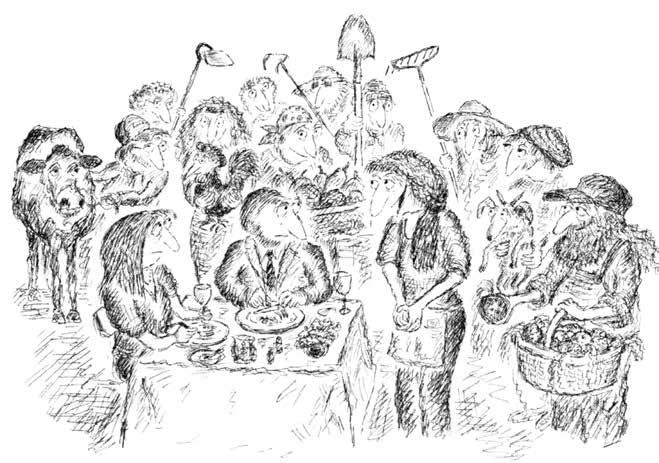
“We think it’s terribly important that you meet the people responsible for the food you’re eating tonight.”
162 vermont almanac | volume 1 v april
ED
OF
KOREN; COURTESY
CURTIS KOREN

IFrittata
had two people from back South ask me “what’s in season?” last April. Tis is usually a great question to get me talking, but in the moment I only responded with a heavy sigh: “Nothing but what’s in greenhouses and a few storage crops.” Only afterwards did it dawn on me: How could I forget eggs? Te glorious butt-fruit of our sassy yard birds that all but disappear in winter before making a glorious resurgence with the lengthening days.
One of the many beautiful things about a frittata is that it’s exceedingly fexible – an easy pantry meal for the of-season, but still a lovely way to use some of your bountiful produce in more productive seasons. It’s such a no-recipe recipe, I think I’ve distilled it down as good as I can. Just don’t undercook or overcook it. —Olivia Piepmeier
INGREDIENTS
eggs, depending on how big your pan is and how many you have (with a 12-inch pan, you need at least 6 eggs for a thin frittata, but 9 would be very reasonable, 12 would be very generous)
milk/cream, optional, usually a small amount
fat of choice – butter, olive oil, or the fat from a meat being used are my go-tos salt & pepper, to preference a cheese of some sort (it could technically work without it but why would you do that?)
veggies and/or meat, chopped or whatever in an amount that’s not so much that the pan is covered
METHOD
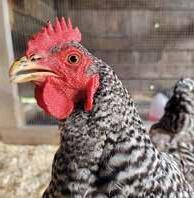
Preheat the oven to 400. I like to start by dealing with the eggs – perhaps because mine are fresh out the hen and I gotta wash them, so I do that and go on and crack them in a bowl. Unless the veggies and/or meat are freshly cooked some other way, they need a warm-up at least. Melt the fat in a cast iron pan and either warm up or cook the meat and/or veggies. If it’s greens of some sort, I would wait till the end of the cooking process. While the above is happening, I usually go on and mix the eggs (and milk/cream if using), cheese, and salt and pepper. When whatever add-ins are done, pour in the egg mixture. Tilt the pan to get everything distributed nicely. Make sure the burner isn’t hotter than medium and put a lid on (or something to trap heat). Let this cook for at least 5 minutes, maybe less if you have a thin one, more if it’s thicker. Te goal is to get at least the sides looking solid. Remove the lid and put the pan in the oven. Timing depends on thickness. Te goal is for it to be totally cooked through but not rubbery.
stories from & for the land 163
ART BY
OLIVIA
PIEPMEIER
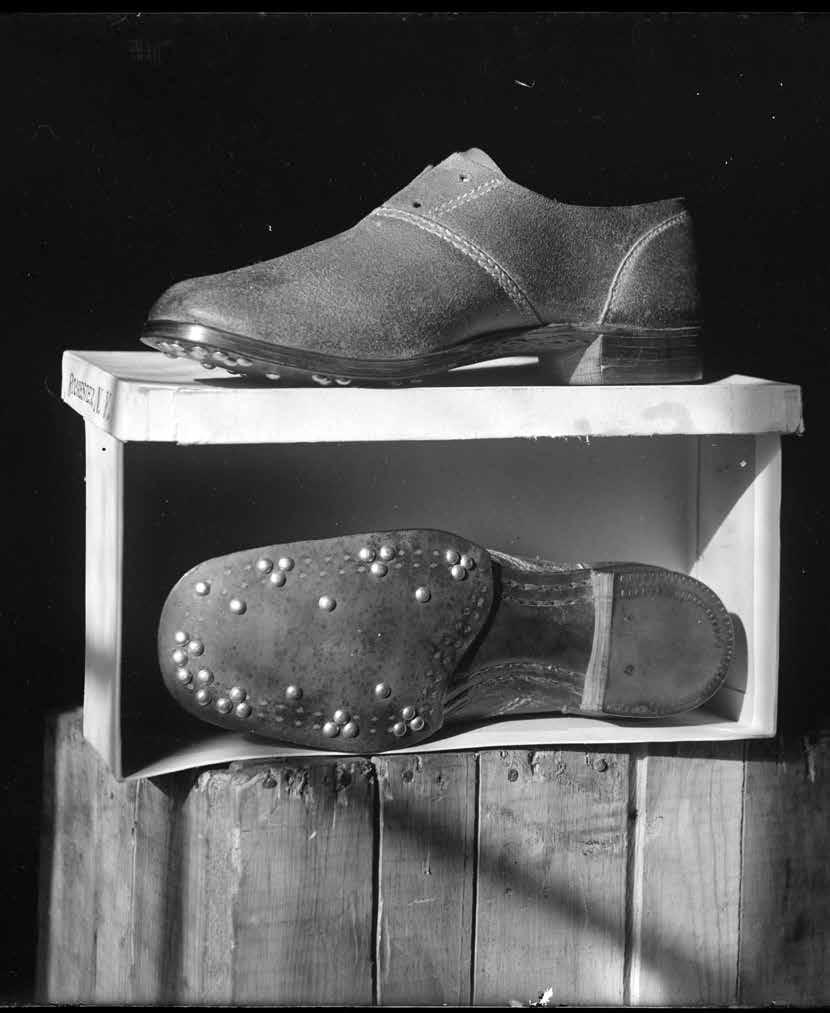
164 vermont almanac | volume 1 v A
• april
LOOK BACK
Te Magic Shoes
Growing up, my family was among the many poor people in Chelsea, mostly in the hills. Once a month or so, the government gave out commodities. Te cornmeal usually had little worms that foated on top when you cooked it. It would gross me out. I would eat just a small amount, usually a teaspoon with raw milk and maple syrup. Tere was also canned meat – no telling what was in that. Te meat was fried like Spam. Split pea soup was the worst of the worst. Te soup had bugs in it.
Te church people also came and brought clothing, books, shoes – used things, sometimes in need of repair. When I was about six, my mother found a pair of shoes for me that were a little bit large. Te shoes were put away. A year and a half later, I found them and shined them up. Hot diggity dog. Te shoes were a thing of beauty, and I knew I would have to dance for somebody.
Tat autumn, one morning I woke early, trying to fgure out what was special about the day. Te sun was shining through the window and casting a light on the walls. I fnally remembered I decided this was my dancing day. I heaved the old quilt of the bed and leaped to the foor.
I knew breakfast was going to be gruel or oatmeal. I really didn’t care for either one. But my mother said that was better than having nothing.
Tat morning, I put on a dress that was rather small, but I didn’t care. I was going to have a wonderful day. I headed down the stairs and ate. Ten I gathered my books, lunch pail, and my magic shoes. I said goodbye to mother and the dog, and blasted out the door to wait for the bus. Te bus was not actually a bus, but an old car that my uncle had. It was old but worked. My uncle came to a screaming halt, jumped out the door, let the little kids in and then the bigger kids, jumped back in himself, slammed the door, and we were of. When we arrived at the Chelsea school in one piece, my uncle wished us a great day, and then he put the car into gear and took of like a freight train.
All the kids headed to their home room. I was in
the fourth grade. Te teacher was okay. I put my lunch in the coat room and slid into my seat. I hid my magic shoes in my desk. Te most beautiful shoes that I had ever seen.
Te teacher rose and took a roll call of the students. We pledged allegiance to the fag and had a moment of silence. I was smiling like a big puppy. Without anyone noticing, I slipped on my shoes. I will say, I usually didn’t disrupt a class; I had never been sent to the principal’s ofce, or sat in the corner with a dunce hat on.
Te teacher called my name. It was my turn to put up the fag. I slowly walked towards the front of the room. When I got there, I tapped my foot, and the sound was wonderful. I needed to tap louder. I twirled, in my twirly dress. I got to tapping, and I couldn’t stop. I was a star, I was on stage, I could hear everyone clapping. Tose blue patent leather tap shoes were magic. Tey came to life. I danced for a number of minutes, and I fgured that I could be on Ted Mack or Ed Sullivan.
I did another twirl and heard the teacher’s voice. It was rather loud. I heard the kids cheering me on. Ten the teacher stood in front of me, and I stopped tapping. I guessed my dancing moments were over. I took a bow, and everyone clapped.
My teacher stood in front of me and pointed to the door. She told me to go to the principal’s ofce. I went upstairs and sat in the hall on the hard bench. I knew now what it felt like to be a star. Was it worth it to get in trouble? Yes, it was.
Te principal came out of his ofce. He said, “You have never caused any trouble. Why today?” I held up the magic shoes and smiled with all my might. He handed me a note to take home, and I was sent back downstairs to my classroom. I spent the next couple of days inside with no recess. Tat wasn’t so bad.
I did give my Dad the note. He signed it and grinned. He held out his hand, and I gave him my magic shoes. He took the taps of. I felt sad at frst, but I knew, for a moment, I had been a star. —Shirly Hook
stories from & for the land 165
“GOne Year, One Teacher, 30 Teens in a One-Room School
AN EXPERIMENT
uilford isn’t even a town anymore! It’s just a collection of roads,” a gray-haired woman shouted during a 2006 public meeting about zoning. Territorial sovereignty had provoked discord in Guilford since 1782. (“I, Ethan Allen, do declare that I will give no quarter to the man, woman, or child who shall oppose me and unless the inhabitants of Guilford peacefully submit to the authority of Vermont, I swear that I will lay it as desolate as Sodom and Gomorrah, by God.”) Nevertheless, that woman’s outcry stayed with me. I began visiting elders to portray their old hometown, where I’d lived for nearly 40 years. From interwoven stories of youth full of gusto and certainty, I wrote a play for voices. Tis excerpt concerns a particular teacher, Mr. Paul Ladd, cooped up in an “experimental” one-room school with 30 feisty teenagers, in 1950
BEA GARLAND , “absolutely Guilford,” child farm-hand, bar waitress, school bus driver, factory worker, answering service operator, working mother of three sons and a daughter. She has always been one to speak her mind.
I went to Higley School for six years. Seventh and eighth grades, kids from all over town were bused to Weatherhead Hollow School in Guilford. It
was an experiment, a disaster. Te teachers they hired were young males, just out of college, who didn’t know the word “discipline.”
We had one teacher, I remember, Mr. Paul Ladd. When the bus left in the morning, we were good little kids for the frst two hours. Well, when he rang the bell for recess, everybody bolted out through the doors, the windows, the bathroom window.

We all grabbed our lunches and disappeared.
Up on the hill, up on the mountain, we’d venture, and eat our lunch. He would ring the bell, and we’d ignore him. We always had a look-out, a diferent one every day. If the look-out saw Miss Eddy, the Superintendent, we’d come running down the hill into the school and be sitting like little angels before she arrived. Mr. Ladd would just sit down, too, and read a book. He never let on.
KEN LYNDE , “backroads wanderer,” founder of a thriving three-generation well-drilling business, lived with his wife Pat on the family farm that his father consolidated back in the twentieth century. Ken died in 2021.
From Hinesburg School, we went on to the Consolidated School for the seventh and eighth grades. Tere, you got to know kids from all over town. It was good for interaction. Before
PHOTO
WOODWARD 166 vermont almanac | volume 1 v april •
BY JEFF
high school, each school did its own thing.
At the Consolidated School, we had a pond up back. During the noon hour, we’d sneak up and steal Mr. Holden’s muskmelons when they got ripe. Tey was right next to us. He fgured he’d better not say too much. He knew what was going on. We ate what we wanted and left the rest. Better than to have us go up there and tear them all up. As for school, I hated every moment of it. I’d rather be putting in corn or cutting wood. So, we helped ourselves to the melons and that sweetened things up a bit.
I’ll tell you something funny about Mr. Ladd. [Years later, after Mr. Ladd had moved out of Vermont.] My son Gary was working as a mover. Down on the Cape, he pulled in to get fuel. Ten he took in his credit card and gave it to the guy behind the counter. [Te guy] read what was on the credit card and said, “Was your dad Ken Lynde? I had him as a student in seventh and eighth grade.” He might have told him I was a handful, and he was probably right.


ED PETRIE , “With me, if I could get a wrench in my hand, I was in Heaven, but I wasn’t much good at school.” A gifted barnyard mechanic, and a bachelor, he lived alone in the house where he was born until his death in 2021
Mr. Ladd, he was the best teacher in all the years I went to school! He could explain things so we could understand. I think he was a World War II veteran. I couldn’t swear to it. He was a big tall fellow, six- or six-and-a halffoot-tall. And he liked music. Ida Bradshaw, the music teacher, would get so mad she couldn’t see straight when she got done with us. We didn’t care nothing about her type of music. We liked southern country music and that’s what he taught. I’ll tell you there was a piano in the schoolroom. When he got behind it, he could make that piano all but dance. And then, when it was storming and we couldn’t go outdoors, we’d shove all the desks into corners, Adele Baker, Melody Squires, Nancy Morrill, and I don’t know how many others, and at the noon hour after lunch, we’d have a square dance.
Mr. Ladd took us on feld trips. We went up on Warren Yeaw’s farm, on the way to the Franklin’s Farm on East Mountain. Well, my knees were never good. So, Nancy Morrill was wearing slacks with a belt around her waist. I grabbed her belt to help me along. She didn’t like that much so she turned around, grabbed my shirt and yanked it. All three or four buttons came of. I don’t remember much more than that. We just went on our way afterwards.
I’ll tell you the big thing that happened at school. One lunch time, we came back in from outdoors. Margie Morrill was sitting down, and all of us were raising hell. Mr. Ladd went to say something, and Margie said to everyone, “Shut up! Te monkey wants to speak!”
He grabbed her and paddled her backside, and sent her back outside. When she came back in later, she said, “ Te spanking didn’t hurt me as much as my pride.”
When that story got home with the kids, everyone was going to ship out Mr. Ladd. But we told our mother the true story. She was on the school board.
A few nights later, there was a meeting over to the school. Mr. Baker, who was also on the school board, he spoke to mother about getting rid of Mr. Ladd. Mother said, “Nope, the kids came home and told me what happened.”
As far as she was concerned, the girl deserved what she got. So, they just let things alone, and Mr. Ladd stayed on.
He was a great teacher. Tat was the only year I learnt enough
stories from & for the land 167
to get by on. I would guarantee it. I was never good at math, but I was always interested in the town history. He tried to teach world history, too. Me, I didn’t care what was going on somewhere else.
NANCY
MORRILL RAGLE and her husband Tom bought the family farm on Melendy Hill from her parents in 1970. She describes herself as “world citizen, environmentalist, mother of seven fne children, matriarch of a family without boundaries.”
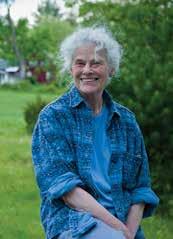
Te seventh and eighth grades got together at the Weatherhead Hollow School. We were a lively bunch! My sister Marjorie was up to mischief all of her life. We had these cod liver oil pills provided by the State. She put hers on top of the wood stove. It really stank. I remember Ed Petrie and I had a tussle on top of the hill. I grabbed his shirt and all the buttons ripped of, and we rolled down the hill. I was very proud to have ripped the buttons. Te kids were cheering us on.
We had the most fabulous teacher, Mr. Ladd. He was a sensitive, sweet person, my favorite teacher, all my life. I suppose he was out of place in that school and maybe I was, too. Perhaps I was already aiming in a diferent direction, and he kept me at it. I’ve always been drawn to farm life but also to painting and poetry. I do know that he appreciated that in me, and it made me reciprocate. I loved my classmates and I never felt I was better, but I did feel diferent.
He was a sensitive man, always trying to be so kind. I can see him in my mind, tall, slim, dark-haired, with big thick glasses. He was young, maybe 30 or a little younger. I wonder if Mr. Ladd is still around. I’d love to be able to tell him he was a pivotal person for me! •
Mr. Paul Revere Ladd, Jr. graduated from Harvard University in 1942, and benefitted from an extraordinary musical education at Longy School of Music and Berkshire School of Music. Ladd and his wife, Eva, young idealists, settled among notable back-to-the-landers near Jamaica, Vermont, until the rumor of “wife-swapping” sent them packing. Before Guilford, he’d taught at Pine Cobble and Buxton, progressive private schools in Williamstown, Massachusetts. At age 30, Mr. Ladd spent one school year with 30 teenagers, then moved on.

168 vermont almanac | volume 1 v april
PHOTO BY JEFF WOODWARD
Nancy Morrill Ragle as a child atop a hay truck.
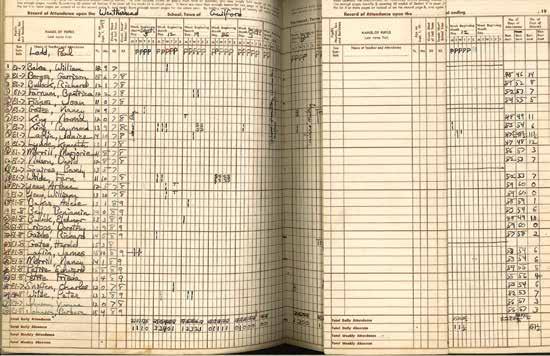
By the second half of the 20th century, the era of Vermont’s rustic one-room schools was winding down. According to the Eighteenth Biennial Report of the State of Vermont Board of Education, “[t]he United States of 1950… has twice been a decisive influence in the military defeat of the forces of brutality. It has emerged with the tremendous responsibilities and opportunities of leadership of the forces of humaneness in a divided world.” A modern education should promote understanding in special areas: “alcohol education, atomic energy, aviation, citizenship, conservation, driver education, international relations, preparation for marriage, the United Nations.” Such changes would require a new generation of “well-qualified teachers working under favorable conditions.”
Mr. Ladd was one such erudite
mentor. The consolidated 7th and 8th grade “experiment” folded after one more year. Guilford Central School opened for kindergarten through eighth grade in 1957
•
Decades later, Ladd recollected Guilford. “In the early 1950s… one of my students submitted the following ‘essay’: My grandmother walked into the kitchen, and there was the goat, standing on the kitchen table eating the butter she had just made. My grandmother grabbed a broom, and the goat bolted through the door into the front hall and ran up the stairs, with my grandmother, broom in hand, after her. At the top of the stairs was an open window; the goat leapt through it onto the porch roof. My grandmother was so angry she shut the window. After catching her breath, she went down the stairs, walked into
the kitchen, and there was the goat, standing on the kitchen table, eating the butter she had just made.”
•
Mr. Paul Revere Ladd, Jr., pursued what pleased him: husband, father, gardener, carpenter, high school physics teacher, devout composer of pastoral music. After leaving Vermont, he and Eva raised 10 children in a 30-room Rhode Island “summer house” designed by the notorious Stanford White. Ladd enjoyed a settled, experimental life on a 10-acre organic farm with his huge family and their Jersey cow named ‘Bos.’ He died in 1998, age 78
•
Nancy Morrill Ragle rested in her recliner days after an ablation. News of the legendary Mr. Ladd took 73 years to arrive, but it did her heart good. —Verandah Porche
stories from & for the land 169
•
PHOTO BY JEFF WOODWARD
A Pocket of People
Drive Route 16, an asphalt jugular feeding the Northeast Kingdom, a little too quickly or maybe distracted by glancing for otter or eagles along the Lamoille River, and you might miss Greensboro Bend entirely. For a heartbeat of a stretch, the highway and the Bend’s Main Street run on opposite sides of the Lamoille River. Ten the two converge, and Route 16 swallows up Main Street. A few miles north, the highway skirts the river’s headwaters, Horse Pond, and rushes through farms and thickety evergreen forest.
Te Bend’s Main Street is a straight shot vaguely reminiscent of midwestern frontier towns. Built of wood and not brick, former storefronts are now converted to apartments, fanked by yards cluttered with broken down debris. Tere’s plenty of clapboard in this village, not quaint white, but patchworked with brown, faded yellow, bare board dulled to gray.
In a tiny park opposite the defunct railroad station, a sign proclaims the Bend “built by the railroad” in 1872 – at 150 years old, almost a brand new town by Vermont standards. All of this – the date, the vanished trains, the peeling clapboards – is true, but the mere tip of truth, a trick where we see, all too often, only what’s plain before our eyes. It’s a fact that humans laid the railbed and pounded down the tracks, but the river that’s just beginning to gain strength and width in this valley and the forested hillsides shaped the town’s story, too. Te land here was formed by millennia of sliding glaciers and moving water, an accrual of sand and pebble and stone too slow for a
human eye or lifespan to witness. Te village rose here because people envisioned a place where the quickness of human life would ft into the intersection of the patient and ever-present movement of land and water. •
Just a few generations ago, in 1872, like the rest of the country, Vermont was reeling from a bloody war fueled by ideology and economics. Post-war, the growing vigor of industrialism’s internal combustion engine and the sudden shrinking of geography (how swift metal wheels were compared to leather boots) promised an expediated pass into the looming 20th century. Eyeing the future of freight and passenger rail, the St. Johnsbury and Lake Champlain Railroad calculated that the fastest and most proftable route from Portland, Maine, to Ogdensburg, New York, cut through northern Vermont, up the St. Lawrence River and into Canada. Te route skipped around Greensboro Village, which had been established on a hillside before the Revolutionary War.
Te town selectmen wagered the railroad was the future and wanted in. Greensboro’s river valley, a halfdozen miles downhill and occupied by two farms, was a prime location. Coupled with two men who were building a sawmill, the town contributed a whopping $18,000 or $20,000 (records claim varying fgures) to the rail construction, a sum appreciable to a small town. In exchange, the St. J. & L.C. laid a northward loop between Hardwick and St. Johnsbury. History claims the railroad architects created this curve to access a less daunting grade to Walden Heights. Te cash certainly didn’t deter. Te riverbank’s swampy cedars were cleared. Te crook swooped around what became known as the bend in the tracks.

Te railroad entered this farming and logging and wild land with a rush. Before the trains, people traveled by water, hoof, and boot. In a variation of “build it and they will come,” rail transformed a patch of wilderness from a pipedream into Greensboro Bend.
170 vermont almanac | volume 1 v april
Greensboro Bend rail station, circa 1905

silent movies and a pianist, dancing, and dinners.
•
When Greensboro Bend grew, the growing was fast – moving, moving, moving – powered by a trifecta of rail, water, and intersecting roads, but driven also by human desire and optimism. Along this bend of track, a pocket of people dug cellar holes, spaded gardens, birthed babies. With wood cut by the sawmill, they built dry goods and feed stores, a school, a box factory, a potato warehouse, a foundry, Protestant and Catholic churches. A hotel sheltered workers and roving salesmen. A three-story hall entertained with
In those busy decades, the Bend was noisy. Long before electricity was strung out to the rural areas, hill farmers clattered their milk cans daily to the creamery – a chatterbox social hub – by horse and buggy, then by truck. Milk, butter, and ice blocks sawed from Caspian Lake (up the hill in Greensboro Village) were shipped to cobblestone Boston. Potatoes and Christmas trees were sent south in vast quantities. Grains were shipped in via freight cars, and the miller carted those grains to his grist mill (also in Greensboro Village). Te telegraph banged news in and out of the village. Cotton and ribbon, cofee, canned fruit, medicines, and plenty more arrived, too. In the back of Pope’s store, a millinery opened – a now
stories from & for the land 171
Separated by a river: Main Street (left) was bypassed when Rt. 16 (right) was constructed
UVM PLACE
quaint word that obscures its signifcance as a female center. Children romped through village backyards with an unsupervised freedom that seems wistfully nostalgic these days.
Te steam engines devoured water and wood, later coal. On one side of the tracks, coal was dumped into cars from an enormous shed. A water tower flled by the river fed the engines. Cattle and pigs were fenced in felds and then shipped to slaughter. Four trains a day with freight and passenger cars steamed through town – a number that seems farfetched in volume now. People paid 15 cents to shop in Hardwick or a whopping dollar and one cent to go to St. Johnsbury to visit a dentist or friends, or traveled farther to picnic along Lake Champlain’s shores. In those days, no one owned an automobile. Former elementary school principal Janet Travers, in a typewritten history of the Bend for the Greensboro Historical Society, noted that the Morrisville station, a few stops west, was esteemed for its lunchroom pie. When the
whistle cried, the conductor checked that travelers were satisfed and onboard before the train rolled out.
In retrospect now, like childhood, the days of patience and pie were brief.
But over time, the outside world – as it did to small towns everywhere – changed this place. Rattling milk cans were replaced by state-mandated bulk holding tanks, and trucks began collecting milk from isolated farms. Farmers no longer gathered and swapped stories each day at the creamery. Nearby Hardwick and Woodbury, once Granite Kings, sufered severe declines after World War I as cheaper cement replaced stone. As families purchased automobiles, passenger service waned. Why pay for a ticket when you could drive a brand new acquisition?
A number of things contributed to the St. J.& L.C. line’s demise. Derailments and wrecks were common, requiring diminished speeds – a creeping 10 mph and slower in more treacherous areas. Heavier engines and freight cars outstripped what the aging tracks could
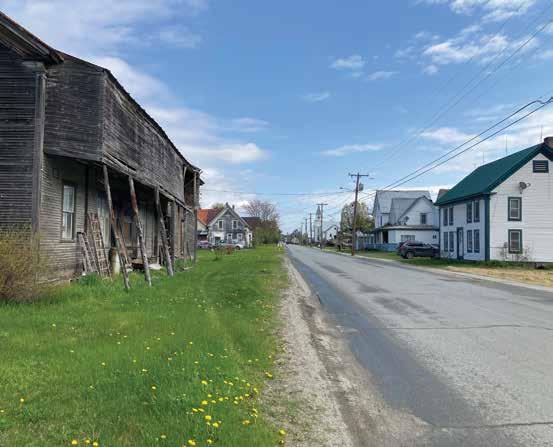
172 vermont almanac | volume 1 v april
Main Street, Greensboro Bend, April 2023
reliably bear. Te spur line to Woodbury’s quarries was ripped up and sold for metal salvage to supply the World War ii efort. After two attempts to abandon the line, a shufing of ownership, and public outcry, the state fnally purchased it in the Vietnam War era.
As rail dwindled, pavement fourished. In the 1950s and ’60s, the mighty Eisenhower interstate system imprinted the country with long-haul trucking. Similarly, Vermont upgraded its highways and constructed Route 16 on the opposite side of the river from the Bend. Designed for 20th century speed and efciency, the highway rewrote the gentler curve of the old roads. Despite the villagers’ vehement objections, the new Route 16 knocked Greensboro Bend ineradicably of the main map.
•Te last milk train pulled out of the Bend in the 1960s
Since then, Main Street has sufered from a series of fres, dwindling upkeep and repair, wages incompatible with infation, drug use, escalating property taxes, and wastewater requirements that are often prohibitive in cost. It’s no longer possible to open a storefront and start a business, or throw up a dance hall or apartment building.
Life stories are rarely clear cut, and a town’s story never simple. Along the swoop of metal tracks, the railroad built and united the Bend. A kid late for dinner wouldn’t need long to run from one village end to another. Memories of living in this sprungup cluster of wooden buildings refect a profound sense of how well people knew each other, working and living and intermarrying. A time when backyards were communal property.
But the railroad drove a wedge through the town, too, in ways that weren’t immediately evident. Greensboro Village, high on the hill, away from sooty cinders and fears about foods, thrived with a summer community of academics and clergy. Te clear, glacial Caspian Lake suited the leisure class who had time for contemplation and refection. A golf course was built. Among its many well-known landowners, the National Book Award novelist Wallace Stegner is buried in a town cemetery along its shores. Meanwhile, the folks in the Bend kept the trains and roads open for these vacationing Village families, carrying luggage and keeping dinner tables lush with potatoes and milk. Te Bend was formed by numbers: pounds of potatoes and butter, blocks of ice, gallons
of milk, board feet of lumber. In both Greensboros, geography has shaped the people as much as we’ve shaped the land. Tose who are born into families where the enchanting lake twinkles in the summer know the water as a source of inspiration and delight. But those who dwell along the river inevitably learn to regard water with a wary respect, a deep-in-thebones knowledge of how rivers can and do rise and food, raging far mightier than human constructs of metal and cement.
•
Last fall, on the railbeds it now owns, the state opened the Lamoille Valley Rail Trail to travelers on foot and bike, ski and snowmobile. Te 93-mile trail crosses the northern part of the state where tracks once where laid. In a strange caveat, the metal trail bridges are removable, should the trains ever reappear. Foolhardy or visionary? Te outcome might be long delayed on this question. For now, the trail winds where the trains once rolled, along rivers and through backyards. At the southern end of Greensboro Bend, above the felds where cattle and pigs were once corralled before heading to slaughter, the trail begins the climb to Walden Heights. At this vantage point, the tracks’ narrow bend and clustered village are pieces in the striated landscape of dark forest, fowing river, highway, surrounded by the low hills knocked down by glaciers eons ago.
In the 150 years since the initial jubilant train rides, the Bend has worn its groove deeply into this riverside, so many decades of so much living. In the pandemic, Jen and Landon Tompson, Smith’s Store proprietors, purchased a moveable creemee stand from a Hardwick owner. Tey rolled the stand north on Route 16, paid for their permits, strung up lights, and opened the stand’s shutters. Tese days, on summer evenings, the frog archipelago choruses, crystalline notes in the amphibian melodies of community, the insistence of the living to lean into this northern land’s brief summer. Te village children and teenagers, their weary parents, the elderly, and curious visitors, amble in and ponder vanilla versus chocolate, sundae versus cone. Teir chatter mingles into the sonorous wild songs, the rustle of crepuscular creatures, the slink of raccoon and fsher, and the drone of Route 16. Listen, and you’ll hear the myriad layers of this world slide and shift, warp and waft, making and remaking how humans live in this place. —Brett Ann Stanciu
stories from & for the land 173
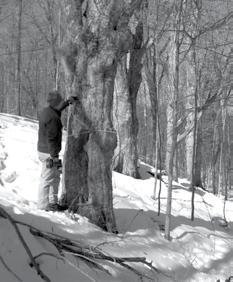
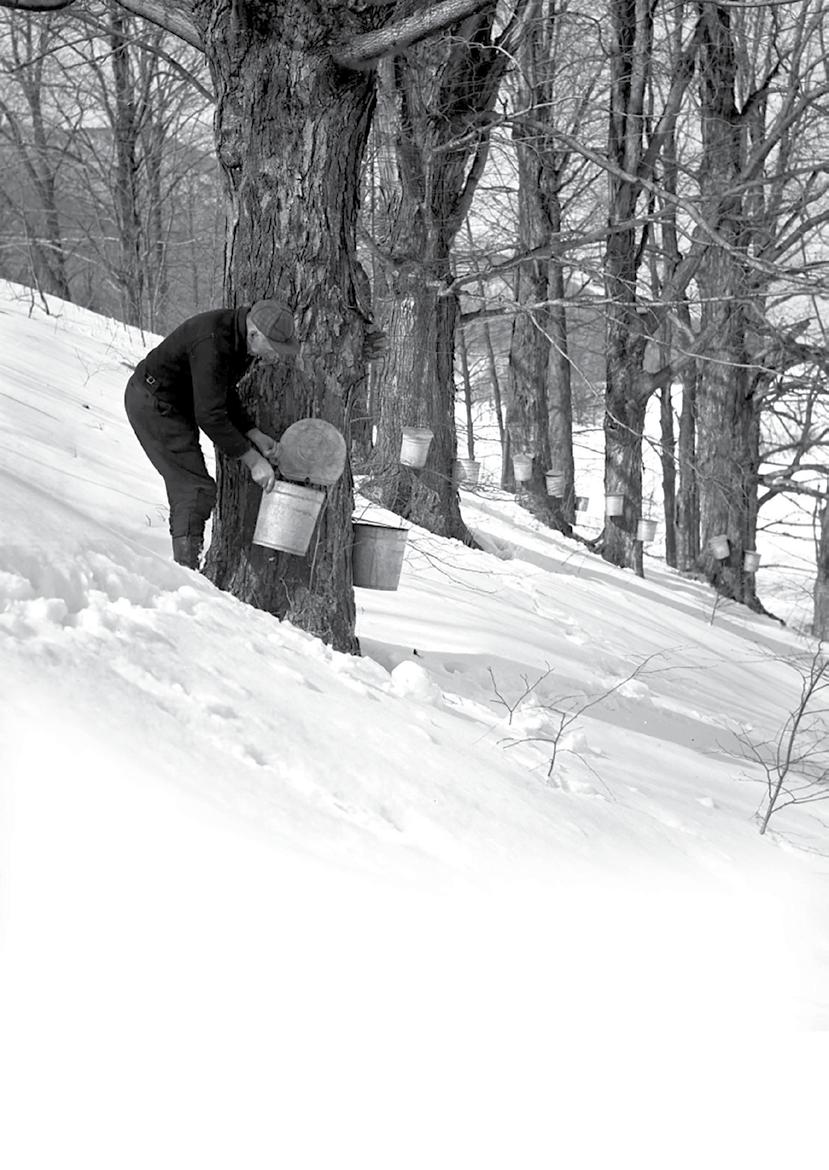
Here’s to family breakfasts.
Here’s to food that tastes like the place it came from.
Here’s to craf that’s passed down through the generations.
Here’s to local products made by local people.
Here’s to the resilience that keeps rural industries afoat.
Here’s to the hope, and ambition, and hard work behind new endeavors.
MANCE FAMILY TREE FARM is proud to support the Vermont Almanac.
We Ship! Order today at mancemaple . com
174 vermont almanac | volume 1 v sponsor
Tapping in 1947
Inset: Tapping the same tree in 2014
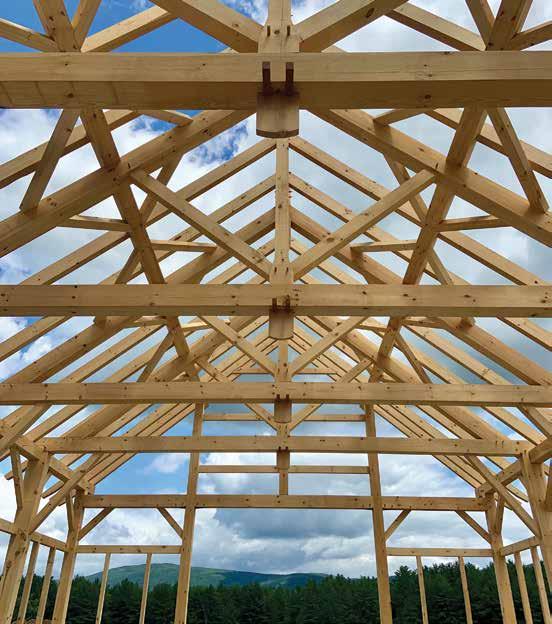
stories from & for the land 175 sponsor Goosewing Timberworks designs and builds custom timber frames in our small shop in Lincoln, Vermont. we are passionate about crafting beautiful, durable structures from local materials, and we are proud to be part of the local forest economy. (802) 318-8664 / @goosewing_timberworks / goosewingtimberworks.com

MAY
stories from & for the land 177
Green Burial
We buried our mother on May 13. Tat simple sentence usually evokes a discreet and careful preparation of her body by professionals, a cemetery grave discretely dug by strangers, a cofn carefully brought to the grave and lowered by others, words of refection spoken by others, and the grave discretely flled by others. In our case, none of this was true. We dug, we prepared her body, we carried her, we lowered her into the ground, and we flled the grave, all on her own farm.
After moving to Corinth in 1988, our mother made it clear that she wanted to be buried on the farm. Moreover, she did not want any wood or cloth wasted in the process. She wanted to decompose directly into the earth. To me, this was quintessentially Vermont: a culture that celebrates the deep roots that connect people to the land, is skeptical of corporate control, and, above all else, values the self-reliant practical over the store-bought pretentious.
Our mother absorbed those values from two near-opposite places. Her respect for traditions and deep roots came from a childhood far from Vermont. She grew up in Amsterdam, in a home whose furniture and paintings had been handed down through generations of her ancestors, some of whom could be traced back to the 13th century. What was not inherited was locally produced or purchased directly from the baker, the cheesemaker, the butcher, the cabinet maker.
In her early 20s, marriage brought her to California, where she was surrounded by the 1960s protests against the corporations that seemed opposed to the interests of the people. Te movement to reject corporate-driven consumerism resonated with our Dutch mother. Unfortunately, the economic success of California in the 1980s brought luxury houses literally to the doorstep of the simple homestead life that she was building with her husband. It drove her out of California.
When our mother moved to Corinth shortly after her 50th birthday, it was like coming home. She could live in a culture that celebrated her values of practicality and self-reliance. She immersed herself in the existing community and bought cheese from the cheesemaker, meat from the farmer, cups from the local potter. When it came to death, she made it clear that her burial, too, should honor those values.
She developed leukemia in the spring of her 76th year. Medical treatments prolonged her life for a year – time worth everything that came with the treatments. But around the frst of May, our mother accepted that there was nothing more the doctors could do, and she chose to spend her last days surrounded by her husband, children, and grandchildren. She died on May 12, at home in a room overlooking her fower gardens, surrounded by vases of the tulips that made her native Holland famous.
After the hospice nurse flled out the death certifcate and left, we were alone with the body of our mother to implement her values: practicality, roots, and self-reliance. Her husband started his excavator and dug a grave at the edge of a pasture; her body would nourish one of the oldest maple trees on her farm.
She had specifed no cofn, even homemade, considering it a senseless waste of wood. Similarly, she had requested only a simple white cotton nightgown for clothing. On the day after her death, we enveloped her in one of her mother’s plain cotton tablecloths, with its essence of a thousand Amsterdam meals, lifted her onto a single plank of wood, and took her out of the house for the last time. Her fve children and husband carried her, with her daughters-in-law and grandchildren behind.
Te path to the grave was mostly across hayfelds, but our frst 50 yards was along a stretch of the road. I finched a little at the thought of what a passing motorist might
178 vermont almanac | volume 1 v may
say, then realized that the few motorists on this dirt road would know her well enough to understand and respect the purpose of our small procession.
We had mown a 10-foot-wide path through the vigorous spring growth of the pasture. Tus, our walk up to the grave was on a smooth carpet of green, with taller grass on either side. We arrived at the edge of the grave without any stumbles and without the distractions of other graves, passersby, or the sound of nearby trafc that we would have found in a cemetery. Our only intruder was a dive-bombing redwing blackbird, perhaps irritated at our nearness to his nest.
Our attempt to use the “professional” approach to putting her into the grave felt more likely to result in an unceremonious drop than a graceful lowering, so we abandoned the supporting ropes that we had brought along. Instead, two of us jumped into the grave and lowered her to its bottom.
We had scoured the felds, forest, and especially our gardens and those of friends for fowers and blossoming branches. For about 10 minutes, we tossed fowers into the grave, the grandchildren particularly taking great pride. She was quickly covered in forsythia, love-in-a-mist, Russian sage, hydrangeas, conefowers, daylilies, globe thistle, and, of course, dozens of tulips. Instead of a cofn to obscure the body with an illusion of protection from the dirt, my mother was enveloped by fowers that would return with her to the earth.
Before adding the soil back to the grave, we paused. Tere was no professional with prepared remarks, no appointed leader to guide our thoughts. We listened to “American Tune” by Paul Simon, a song about my mother’s adopted country that deeply resonated with her, and then we each were free to refect in our own way. I felt overwhelmed more by the strength, beauty, and calmness that surrounded us than by the sadness of why we were there.
Taking turns with the shovels, everyone helped fll in the grave. We left a mound and a temporary marker. Later, we would commission a local stone mason to create a headstone to mark the grave and a bench on the hill overlooking the spot where she rests.
In burying our mother in the way that she wanted, my gratitude for her and her life was amplifed. Even in death, she had helped me free myself from self-imposed constraints. I learned I could do more than I had thought possible. She literally taught me and helped me grow until she was resting in her grave. —Stephen Devoto

stories from & for the land 179
R
Te Great Freeze
The average temperature in May 2023 was within a half degree of the 20th century mean. But it was 2.1 degrees below the average of the last 22 years, so let’s just go ahead and call it a slightly cooler than average month. Tis is the frst cooler than average month we’ve reported in Volume iv, and the frst we’ve had in the state since January 2022, 17 months ago. Most days were sunny, with highs in the upper 60s and low 70s. If that’s your idea of perfect summer weather, and if you live in Vermont it’s likely you feel that way, May was a very pleasant month.
Te month was noteworthy for how dry it was. It seemed like all month long the 10-day forecast on our phone app was just a bunch of sun icons. Most places ended up about two inches behind their average rainfall. In Burlington, only 64 inches of rain fell between May 3 and June 1. From an agricultural perspective, it was great tractor weather. But from a growing perspective, it was hard to keep transplanted seedlings upright. Early crops emerged but then languished, stunted by the
lack of water and susceptible to insects and early fungi, which capitalized on the stress. We’ve heard farmers extolling the necessity of irrigation again and again since we started this project, and this month reinforced it. Whether you were a farmstand with 100 acres of mixed veg or a home gardener with a 10 x 10 plot, you needed to water this May.
Snow season in Vermont runs from October through May, and when fnal records were compiled, most parts of the state ended the season with a defcit. Burlington got about 15 inches less snow than it does in an average year. Snow disappeared from the stake on the top of Mansfeld about 10 days earlier than average. Parts of southern Vermont were at record-low snow depths through the traditional snow months, but the winter average was skewed by the monumental March snowstorm, which restored things to an extent. Te last of the natural snow disappeared from the top of Glastenbury mountain in southern Vermont around the second week of May, which seems about right.
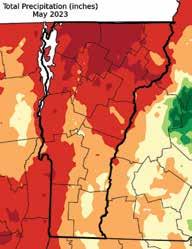
Te big weather story of the month was the epic freeze on the night of May 17. Certainly news of a hard frost on that date isn’t earth-shattering. But because of the warm winter, so much of the natural world was a week or two ahead of where it should have been at the time, which made this exactly the wrong time for fruit blossoms. As a general rule, if the temperature falls to 27 degrees for an hour, orchardists can expect to lose 10 percent of their crop. If it falls below 25 degrees for an hour or more, a loss of 90
We looked back at our weather summaries from the past three volumes of the Vermont Almanac and saw that May 2022 was the fourth warmest May on record. May 2021 was warm and dry and featured high elevation snow on both the frst of the month and Memorial Day weekend. May 2020 was most noteworthy for a freak Mother’s Day snowstorm that dumped more than 10 inches in some parts of southern Vermont.
180 vermont almanac | volume 1 v may WEATHER
percent is likely. Newark hit 18 degrees that night; Corinth 20, West Braintree 21. Traditionally warmer spots were not spared. A farmer in the Connecticut River Valley reported 21 at ground level. Just north of Bennington, the low around midnight was 24 6, and it didn’t get above freezing until around 9 the next morning.
Tere’s not a lot you can do with these cards. Nora Lake and her husband Chris Polashenski, who own Sweetland Farm in Norwich, sprayed water on some of their trees through the night; as an experiment they also sprayed some intermittently, and left a control block with no spray. Te blossoms on the trees that were sprayed saw about a 15 percent survival, though the accumulated ice caused some
damage to foliage and broke an occasional branch. While the fower petals remained intact on the unsprayed trees, no ovaries survived the frost. Lake, speaking to a reporter from the Valley News, said it was the orchard’s “best year of blossom ever, and that’s what makes us so heart sick over it.”
Some apple and grape crops – especially those in low-lying areas – were decimated. Terry Bradshaw, associate professor at UVM’s Extension Fruit program, said that in 25 years of working with fruit crops in Vermont he’d never seen such extensive freeze damage. Te USDA declared all 14 counties in Vermont “primary natural disaster areas,” meaning farmers who received damage were eligible for assistance. Fortunately some orchards and
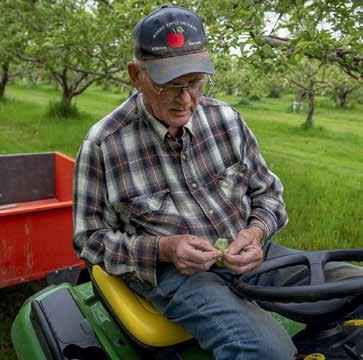
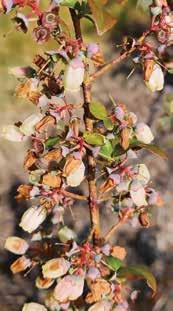
Blueberry bushes in Vermont were hit hard by the May frost, but the blueberry crop turned out to be plentiful at many farms.
berry farms escaped the worst of the damage and ended their seasons with decent crops.
In the forest, the trees that leaf out early – like maple and poplar and birch – were largely alright. But late leafers that were still breaking bud and expanding, notably oaks, ash, and beech, were hard hit. Black walnut and black locust took it very hard, too. Many trees experienced signifcant-to-total defoliation. Te trees re-leafed, but there was special concern in areas that had experienced signifcant spongey moth defoliation over the last few years. As a general rule, a healthy tree can shake of a defoliation event and persevere. It can probably weather two years of defoliation in a row. After three straight years of defoliation, bets are of
stories from & for the land 181
John Adams of Adams Apple Orchard & Farm Market in Williston inspects the brown center of a frost-damaged apple bud on May 24, 2023
GLENN RUSSELL
GREEN MOUNTAIN ORCHARDS FACEBOOK
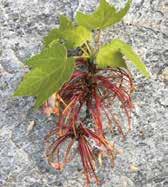
IT SEEMED THAT EVERY SPRING - FLOWERING WOODY PLANT HAD A SUPER BLOOM THIS SPRING . Tis may be most true for red maple, also known as soft maple. Te red maple fowers emerged in April but fully developed in early May. Red maples were especially notable on hills and mountains, as their red crowns were obvious among the emerging green foliage. By the end of the month, as other trees sported full green foliage, the red maple crowns remained red- or tan-colored. Tis was caused by the huge numbers of red and tan seeds that were developing; meanwhile the trees had put little energy into developing leaves. Tis red maple twig, collected at the end of the month, has just six small leaves and nearly 100 seed pedicles. Te few seeds remaining on this twig, and others observed on the ground, indicate that the seeds are small. It may be that the trees produced too many seeds and did not have enough energy to fully develop all (or any?) of them. —Mike White
eSpring Beauties
If you look closely at a patch of fowering spring beauties on a sunny May day, you’re quite likely to see a fuzzy little bee packing her pollen baskets with bright pink spring beauty pollen. Te lives of this bee – the spring beauty mining bee – and this fower are tightly entwined. Te bee feeds exclusively on the nectar and pollen of spring beauty fowers (Claytonia caroliniana is shown here) – nothing else. Both the male and female adults fuel up on nectar and the female bees take pollen to underground tunnels that they have excavated. Balls of pollen are stashed in little chambers and the female bee lays an egg on each one. Tere’s got to be enough pollen for each larva to grow, form a pupa, and emerge as an adult 11 months later. And this emergence must be just when that pink pollen is once again available.
You might think that a bee on such a tight schedule would be at work non-stop, but no, the spring miner bee only goes to work when it’s warm, typically between 10 a.m. and 2 p.m. on sunny days. And she doesn’t venture out when it’s rainy.
And the fowers? Tey close when it’s too warm. Tey are predominantly pollinated by this bee species, and fowering lasts for less than a month. As we know, May weather can be fckle at the best of times. Happily, so far, this precarious arrangement has worked beautifully. Where there are rich northern hardwood sites, quite often there are both spring beauty fowers and spring beauty mining bees. —Virginia Barlow
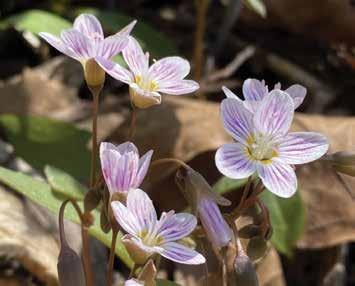
182 vermont almanac | volume 1 v may NATURE NOTES
MEG MADDEN / CC –INATURALIST
MIKE WHITE
Te Mushroom Hunting Equivalent of a 12-point Buck
I’ve seen photos of enormous fushes of “fre” morels out West, where thousands of mushrooms sprout from the blackened earth to the delight of foragers. But back East generally, and in Vermont specifcally, I’ve never seen anything remotely like this. In 20-plus years of actively hunting, I’d say the best fushes I’ve seen consist of around 25 to 50 mushrooms, and while they sort of grow together, they’re generally associating with a variety of trees in a relatively large area. Under a good morel tree, you might fnd six or eight mushrooms, and you hit the big numbers when there’s a bunch of good morel trees growing together.
Tat perspective broadened this year, when my six-year-old daughter found me in the kitchen and informed me that she’d found some morels at the edge of the yard. Tere was a big elm there that died a few years back, and this winter I cut the multi-trunked stem down before it could start to drop branches. Sure enough there were morels there: in a 50-foot radius around the tree, and it was the only tree in the area, we picked 109. And we left 30 percent or more.
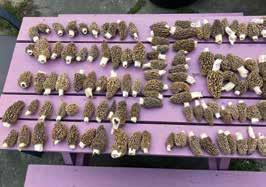
I’ve heard rumors of these epic fushes, but I always fgured they were exaggerated. I’ll be more willing to believe going forward.
In my experience, morels that associate with live ashes and live apples tend to fruit consistently but sparsely. It’s the recently dead elms that tend to throw of big fushes, and they’re often something of a last hurrah. I’m not at all sure that there will be any next year in this same spot, but I’ll let you know.
—Dave Mance III
A MARSUPIAL POUCH : Te Virginia opossum (Didelphis virginiana) is North America’s only marsupial, and is found farther north than any other marsupial in the world. Like the kangaroo and koala, the female opossum possesses a pouch that acts as a nursery for her young. After a very brief gestation period of 11-13 days, up to 20 embryonic young, each the size of a honeybee, climb (witnesses say it’s more like “swim”) from the birth canal into the pouch, where 13 cream-colored teats are waiting. Te mother helps by licking the hair leading into the pouch, providing a moist path for the young to follow on this frst long and arduous journey. Once a young opossum latches onto a teat, the teat swells in the opossum’s mouth, helping it to remain attached for a little over two months, during which time the opossum receives nourishment and continues its development. When they are too large to be contained in the pouch, the young leave and are often seen hitching a ride on their mother’s back. Tis photo shows the interior of a female opossum’s pouch. —Mary Holland
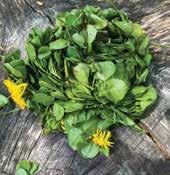

THIS PHOTO SHOWS THE CONTENTS OF A TURKEY ’ S CROP . A bird’s crop is a little pouch in the throat where they store food, a useful adaptation for a prey species that often has to eat hastily and then run. Te ladino clover in this crop isn’t surprising, but the profusion of dandelion blossoms was interesting to us.
stories from & for the land 183
MARY HOLLAND
Tillage Radish
Acubic foot of wet winter snow can weigh 30 pounds. Raindrops fall to earth at a speed of about 20 miles per hour. When the soil’s bare in your garden, the dirt takes the full brunt of this force and compacts. Compacted soil is degraded soil – there’s an old saying that bare soil is like a house without a roof.
If you’ve got heavy, compacted soil in your garden, and many of us do, you might try using tillage radish to loosen it. Te seed goes in in late August or early September, after you’ve harvested a crop. Te foliage will form a fast-growing roof, and the plant will scavenge nitrogen and hold it for you over winter. Te obscenely big radish helps alleviate compaction by both physically drilling into the compaction layer, and also by rotting down over the winter and increasing the soil’s organic content, which is the long-term fx to the compaction problem. Come May your soil will stink, but the microbes – and your transplants – will love it.
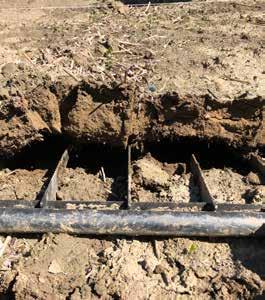
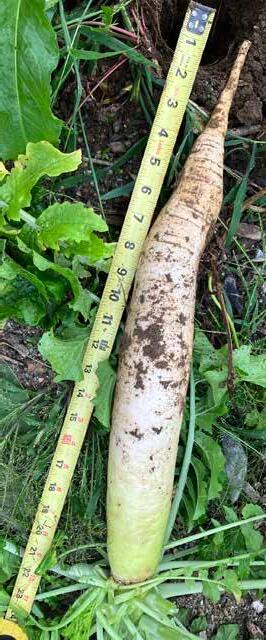
AT HOME • 184 vermont almanac | volume 1 v may
Left: Compacted soil in a spring garden. Right: Tis mature radish was 21 inches long; 16 of that was below grade.
Plant it High, it Won’t Die; Plant it Low, it Won’t Grow.
This spring, avoid the number one mistake people make when planting a tree: planting too deep. It’s natural to want to get the root ball way down into the soil in order to keep the transplant stable, but doing so may actually kill it.
Whether you dig a sapling from your woods or purchase one from a nursery, look at the base of the trunk – you should see a soil line on the bark, letting you know the depth that the tree was previously growing at. Just above that soil line, you’ll notice that the trunk gets a bit wider.
Tis “root fare” must be visible above ground; dig your hole so that the tree sits at least that high. If you plant too deep, this fare will be underground, exposed to constant moisture and deprived of oxygen, which afects the tree’s ability to “breathe.” Te same goes for mulch; if you plant high
enough but then bury the fare in a volcano of mulch (unfortunately a common practice), the tree once again sufocates. Also, keep in mind that the rather loose soil in the new hole is likely to compact and sink a bit over time. A tree on top of a little mound will be just fne.

TEA HERBS are attractive in the garden, easy to grow, and a pleasure to use. Many can also be brewed into delicious herbal teas.
Chamomile is one of the most popular herbal teas and is easy to grow. Choose German chamomile (Matricaria chamomilla), which is less bitter than its relative, Roman chamomile (Chamaemelum nobile). Sow seeds, pressing gently into the surface, about four weeks before the last frost. Chamomile reseeds readily, so you can expect your patch to return every year.
An herb you may already have in your garden that makes a lovely tea is lemon thyme (Tymus citriodorus). It is a perennial in many Vermont locations. Look for plants at your local garden center, as this herb can be difcult to start from seed.
Anise hyssop (Agastache foeniculum) has licoricescented leaves, and is a short-lived perennial that is loved by bees, butterfies, and hummingbirds. Te seeds need cold stratifcation and light to germinate. Sow them about four weeks before the last frost, lightly pressing them into the soil.
If you prefer your tea with an added sweetener, try growing stevia (Stevia rebaudiana). Stevia can be difcult to start from seed, so check with your local garden center for a plant. Both fresh and dried stevia
leaves can be enjoyed in your teas.
Perhaps the most versatile herb you can grow for herbal teas is tulsi, sometimes known as holy basil. Tulsi (Ocimum tenuiforum) is an herb native to India that is well known for its delicious favor and adaptogenic properties. Adaptogens are plants that promote overall wellbeing by helping your body respond to tiredness, stress, and anxiety. Tulsi is easy to start from seed. Seeds can be started indoors about four weeks before the last frost and transplanted in the garden after all danger of frost has passed. —Andrea Knepper. Reprinted with permission from UVM Extension.

stories from & for the land 185
TTU
Writers preach what they need to hear, which is to say our sermons, more than not, refect our personal shortcomings.
But sometimes, when we’re lucky, we get out ahead of ourselves and live what we preach. Tis happened to me during opening day of May’s turkey season when I shot a turkey and then gave myself permission to feel it: an act that can be surprisingly hard when you’re sneaking in a few hours of hunting on a weekday before work in a culture that prides itself on its ability to never stop.
I’m proud to say I appreciated the moment and gave the rest of the day to it.
I watched the turkey die, even though that’s the part hunters hate. I didn’t walk away and come back after the wing beats had subsided. Instead, I said a prayer
Life Rafts
and sat on the wet earth, feeling happy and sad and being present.
When I left the woods, I took the time to show the turkey to my father – the man who taught me to hunt. It was a simple act that resulted in simple joy. We took pictures, even though kill shots feel a little silly at age 47. For a moment, we were a boy and his dad again.
Before processing, I showed the turkey to the cat, who slunk towards it with dilated pupils while making a sound I’d never heard before. He later buried the ofal and cached the head and gizzard in a crack in a tree stump and then spent three days guarding his treasure.
I butchered the bird slowly, working the joints with a knife so the exposed bone ends were impeccable. I packaged the breast meat for poaching, deep frying, and making pounded turkey
cutlets; I saved the drumsticks, thighs, wings, heart, liver, and gizzard separately for braisetype recipes like the one below. I thought of Joe Herman who taught me how to cut meat elegantly years ago.
I plucked the wing feathers, so my daughter and I could make quill pens to dip into black walnut ink. I thought of the traditional Abenaki culture in Vermont that’s been and continues to be a source of knowledge about living in tune with the earth.
Te process carried over into the afternoon. I stayed in the moment, putting these thoughts on paper instead of getting back to work.
Te point is, I think I did things right. I share this not out of smugness, but because I’ve fallen short in the past. I’ve never disrespected an animal I’ve taken as a hunter, but I have

186 vermont almanac | volume 1 v may •
whizzed through the endeavor as if it were a trip to the grocery store, processing in a hurried manner that did not sufciently honor the life. When I learned to hunt in the 1980s, it was a fairly common practice to rip the breast meat of a bird and call it good enough. I know better now. I took this chance to atone and pass on a better way to the next generation.
Writers humor themselves by thinking their words might infuence the world, but usually the best we can do is give a reader something they recognize so they don’t feel alone. I ofer this to other turkey hunters in a sense of fellowship.
If there is something meaningful here for non-hunters, perhaps it’s the observation that difculty feeling goes hand in hand with difculty paying attention; both challenges are epidemic in our culture. Work never stops. Adult responsibility never stops. Te expectations we place on ourselves and on others never stop. Te torrent of information we absorb through our computer screens never stops. Yet, in these food waters that bombard us foat the important events that give our lives meaning – some of them big, like our children being born or our loved ones dying – lots of them little, like killing a turkey on a spring morning and feeling connected to our animal selves – but, man, are they crucial. It’s probably not too maudlin to extend the food metaphor and call the important events life rafts. It’s on us to recognize them and seize them when we can.
—Dave Mance III
PAVO
DEL MONTE (“ MOUNTAIN TURKEY ”)
Tis recipe for turkey dark meat was inspired by Hank Shaw’s “Turkey Yucatan,” which was in turn inspired by David Sterling’s Pavo del monte en k’ool rojo.
INGREDIENTS
Kosher salt and maple syrup for brining at a ratio of 3 tablespoons salt and 3 tablespoons syrup per quart of water drumsticks, thighs, wings, gizzard, and heart of wild turkey. (Save the more delicate breast meat from your bird for a diferent recipe.)
100 grams achiote paste (you can buy this online – it’s important)
2 teaspoons smoked salt
2 tablespoons bear grease (see Volume I of the Almanac for instructions) or vegetable oil
⅓ cup Seville orange juice (or substitute 2 tablespoons orange juice, 1 tablespoon lime juice, 1 tablespoon grapefruit juice)
SAUCE
2 heads garlic
1 yellow onion, quartered
3 paste tomatoes, sliced in half lengthwise
2 tablespoons bear grease or vegetable oil
1 tablespoon oregano & 2 sprigs cilantro
50 grams achiote paste cornstarch
METHOD
Brine the turkey for a few hours then drain. Ten mix the next four ingredients together, pour them over the turkey, and marinate in the fridge overnight.
Fire up a wood-burning grill and char the garlic, onion, and tomatoes. You’re looking to put char marks on the outside of the vegetables, not cook them. Same goes for the turkey pieces, which you’ll char next, then set aside.
To make the sauce, coarsely chop the charred tomato and onion. Remove the garlic skin and add the charred cloves. In a Dutch oven, sauté the vegetables in the bear grease or vegetable oil over medium heat for about 5 minutes, then remove from heat and put in a blender or food processor. Add the oregano, achiote paste, cilantro, paprika, and a cup or so of water. Puree until more or less smooth.
Put the turkey pieces into the pot and cover with the sauce. Rinse the blender out with water and add that water, too. Te turkey pieces should just be covered. Bring to a simmer and add salt to taste. Cover the pot and simmer gently over low heat until the turkey is tender –about 90 minutes for a jake, as much as 3 hours for an old Tom.
When the turkey is tender, the sauce should be thick. If not, add cornstarch to thicken until it’s BBQ-sauce-like. Lift the meat from the bones (being sure to remove the drumstick tendons) and serve in the sauce topped with a homemade garden salsa and crumbly Vermont cheddar. Serve on corn tortillas or over rice.
stories from & for the land 187
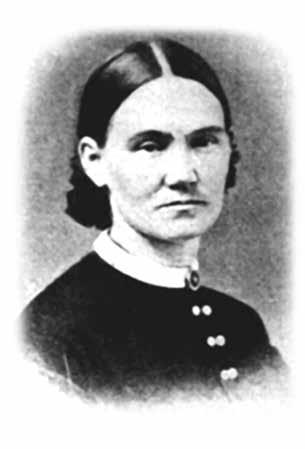
An Undaunted Woman
THE STORY OF AMANDA COLBURN FARNHAM FELCH
In 1921, when the Women’s National Foundation proposed to incorporate a Hall of Remembrance in Washington, D.C., each state was tasked with choosing one woman to represent their state. Vermont chose Amanda Colburn Farnham Felch, a Civil War nurse from Glover.
Amanda was one of the frst women to become a Civil War nurse and became one of the most trusted, traveling to wherever the need was greatest. Trough a special act of Congress, she was one of the frst women to receive a Civil War pension, this at a time when it was difcult for many veterans to obtain one, and almost impossible for a woman.
So, why has no one heard of her?
I frst learned of Amanda from a book called Women at Gettysburg by Eileen Conklin. Tus began a 10-year search that led to some astonishing discoveries, including learning that Amanda had grown up on the same farm where I now live on the South Albany/West Glover border.
It was as if Amanda reached across a century and a half, to tap me on the shoulder and say, “Tell my story….”
Amanda Matilda Colburn was born in West Glover on November 12, 1833, the same night as the Great Meteor Shower of 1833. It is estimated that a quarter of a million meteors were seen over North America that night.
She was the frst child of Ira Colburn, Jr., and Celana Cisco. Ira was a great reader of history and gave his children the best of schooling.
Ira and Celana had three more daughters, but in 1840 Celana died after giving birth to a son, Henry. With no grandmothers or nearby aunts to help, Amanda became a surrogate mother to her three sisters and her newborn baby brother.
She was six and a half years old.
It was Amanda’s close relationship with her brother that would alter her life 21 years later. With the fring on Fort Sumter on April 12-13, 1861,
188 vermont almanac | volume 1 v may A LOOK BACK •
Vermont Governor Erastus Fairbanks was one of the frst to respond to President Lincoln’s call for troops, wiring Lincoln that “Vermont will do its full duty.” Amanda’s brother Henry was one of the frst enlistees from Glover. Teir father, distraught over Henry’s enlistment, convinced Amanda to go with Henry, to watch over him. Tey were all in Company B of the Vermont 3rd Regiment, with Amanda listed as hospital matron.
Te 3rd Vermont Regiment assembled at Camp Baxter, St. Johnsbury, and was mustered into service for three years. As in the other Vermont regiments, most of the men in the 3rd Vermont were farmers. Tey were strong and used to hard work, traits that would stand them in good stead in the months and years ahead.
Troughout early 1862, in the feld and at feld hospitals, Amanda nursed the sick and wounded, and she marched with the soldiers, which was unusual, as most nurses were assigned to hospitals, not to the front. In late August, she accompanied a detachment of sick soldiers to hospitals in the north, returning to Washington, D.C., on September 14. When she was refused a pass, Amanda went to Secretary of War Edwin M. Stanton, and managed to get not only her pass, but also an order for an ambulance. Most Civil War ambulances were four-wheeled wagons with suspension springs, stocked with medical supplies, and built to carry 4-6 men on stretchers, with several more seated.
Amanda received her ambulance on the 15th and immediately began the 75-mile journey to Antietam’s front, arriving early on the 17th while the battle was in progress. On the feld, she performed her only surgery, using button-hole scissors to remove a Minié ball from under a soldier’s shoulder blade.
In the winter of 1862-63, Amanda was appointed Matron in Charge of the Second Division Hospital of the 6th Corps, and cared for the wounded from Chancellorsville. On the road to Gettysburg, she gave her seat on the wagon to wounded soldiers and walked 34 miles in one day, arriving on the battlefeld at the end of the second day, where she worked all night with no sleep, caring for the wounded.
A few days before the Overland Campaign began, Amanda was ordered to report to Washington, D.C., and specifcally to Dorothea Dix, who was in charge of all the female nurses. Amanda appeared in “bloomers.” Miss Dix appraised her and said, “Mrs. Farnham, the
dress you wear is abominable . . . and I do not wish any of my nurses to dress in that manner, but you came highly recommended, and . . . you can wear it if you choose.” From that time until after the war closed, Amanda was one of Miss Dix’s most trusted nurses, and was charged with duties and commissions at the front that Dix would trust to no one else.
Amanda cared for the wounded from the Wilderness and Spotsylvania. Her brother Henry was seriously wounded in the Wilderness, a musket ball entering his left eye and exiting by his left ear. Henry survived and went home, but he would live only eight more years, dying in 1872 from infammation of the brain due to his war wound.
It was after Cold Harbor, when thousands of wounded were being brought in, that Amanda instituted one of her innovations. She saw the unsustainability of burning all used bedding and clothing, and initiated a laundry system to clean and reuse those items, at the same time organizing and giving gainful employment to formerly enslaved women.
After the war, Amanda married Marshall Felch and went on to be a pioneer and homesteader in Colorado, a partner with Marshall in the nascent feld of paleontology. She was recognized for her contribution to the Colorado women’s sufrage movement. She defed convention and the restrictive boundaries set for women of her time. Her life provides a lesson on service, as well as the value of a pioneering spirit, courage, determination, resilience, and self-reliance.
Te Vermont Brigade, in comparison with other famous brigades, has been largely overlooked or underrated. Te Vermont Brigade took part in 30 major battles, marched over 2,000 miles, and lost 2,544 men (28 85 percent of their ranks). Twenty-fve members of the Vermont Brigade earned Congressional Medals of Honor. Numerous generals called the Vermont Brigade the best brigade in the entire Army – the one they had the highest confdence in.
Like that of the Vermont Brigade, Amanda’s service has been underrated and forgotten. Like the soldiers, she didn’t go to war for fame or glory, but to do what she could for her country and her country’s soldiers. Like them, she did her duty.
I believe that is how she would most like to be remembered. —Natalie Kinsey
stories from & for the land 189
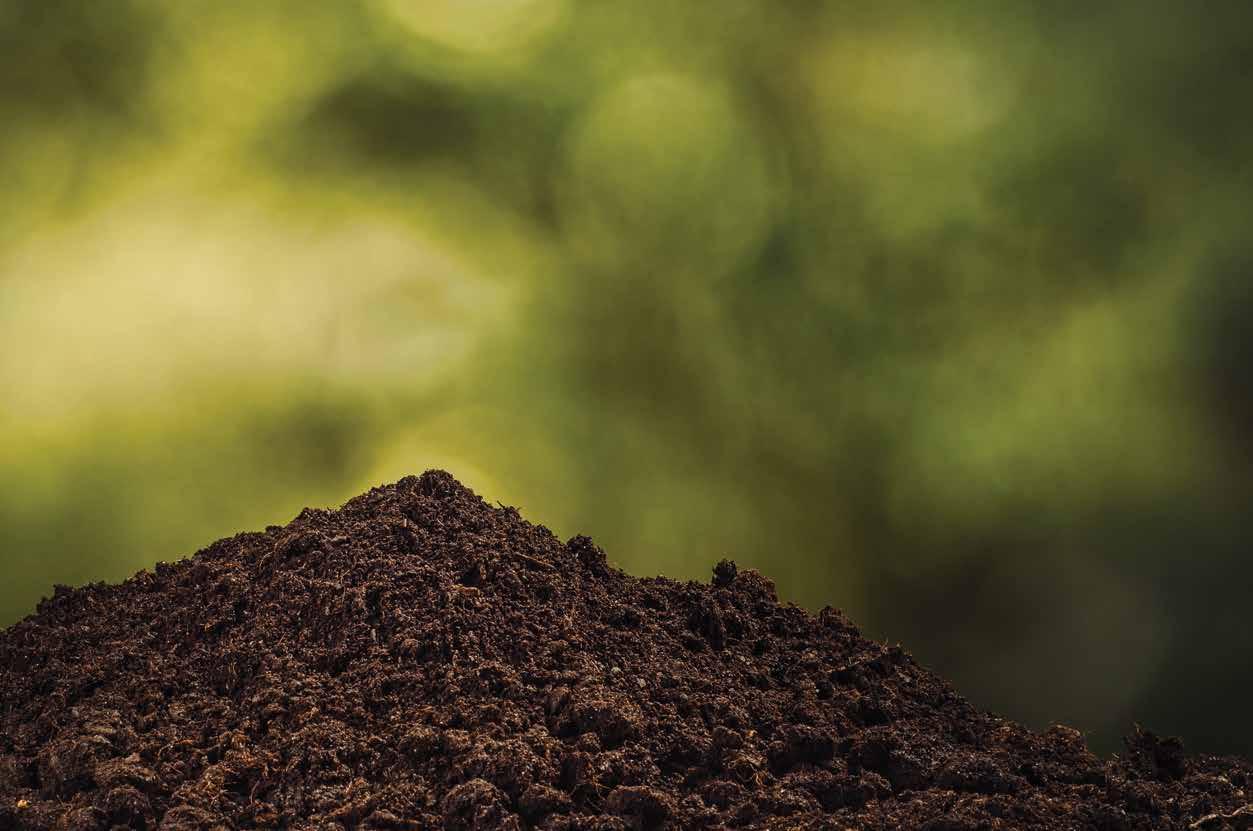
Pioneering Human Composting
190 vermont almanac | volume 1 v may

I’ve never wanted to be buried in a casket with a vault and all that – it just seems unnatural. I’m a sheep farmer, and we occasionally will have to compost the remains of an animal. I would often say, only half-jokingly, that I kind of liked that idea for myself, but I didn’t want my husband getting into trouble for planting me in the manure pile! So as a former state legislator, during the 2019-2020 biennium, I introduced a bill in the Vermont legislature to allow for the composting of human remains in the state, a process that is technically called natural organic reduction.
At frst, people’s reactions were that it sounded disgusting. Frequently, when you deal with the death industry, there’s always a little bit of hesitancy about new things. I reintroduced the legislation in the 2021-2022 biennium, and luckily it started to catch some attention. As we started taking more testimony, many people began to change their minds, and the bill ran up against very little opposition and was signed into law. Currently, human composting is also legal in Washington, Colorado, Oregon, California, New York, and Nevada.
So, the road has been paved for human remains to be composted in Vermont. We’re just waiting on a business in the state that will ofer this service; it has to be done properly – you can’t just put a body in a manure pile. In Washington State there’s a company called Recompose that provides human composting services – they actually hired a lobbyist to support the legislation here in Vermont. In their process, bodies are placed in kind of a cradle with soil and bacteria, where they’re kept at a certain temperature and break down naturally. What’s left is essentially soil. Te way that company explains the process, “ Te body and plant material remain in the vessel for fve to seven weeks. Microbes power change on the molecular level, resulting in the formation of nutrient-dense soil.”
I see the cycle of life and death on our farm, and I think the process of composting is actually quite beautiful. If we have a mortality and bury the animal in the compost heap, I’ve watched, especially during summer months, and have been amazed at how quickly it breaks down. I fnd it miraculous. Occasionally what’ll happen is the fies will get down in there, and then they start laying eggs, and there’ll be this swirling mass of maggots. Some people are really turned of by the concept of maggots, but I see it as somehow a lovely process – more lovely than being buried with a whole bunch of stuf that never decomposes.
Before natural organic reduction was permitted in Vermont, cremation was my choice. But then I thought about all the BTUs that would be required. As a farmer, I’m more comfortable with the concept of composting – Earth to Earth. Te other thing that really inspired me is that there’s only so much land, and to take up a whole lot of space with cemeteries might not be all that practical. Composting just seems to make a lot of sense. Plus, the family gets back a bag of soil – a pretty huge bag of soil, actually. It could be donated to a farm or used to fertilize trees. I would want my family to put me on my garden. You can put my name on a gravestone somewhere if you want, but don’t worry about the burying part. —Carolyn Partridge
stories from & for the land 191
Eternal Ecosystem
We’ve come to call it the Windchapel grove. It’s a stand of Norway spruce, planted around six decades ago by the logging company that owned the land at the time. Although not native to Vermont, these thin conifers, rising 40 to 60 feet from the ridge below Drinkwater Hill, mark one of my favorite places in Vermont Forest Cemetery. It is almost always windy here. Te thick, short needles of Picea abies (“the spruce that is like a fr”) catch that wind, drawing from it long, slow, deep, almost respiratory sibilants that make me hold my own breath and listen.
My husband Paul and I have spent the last 10 years dreaming of building a cemetery on this 56acre parcel in Roxbury, and the last three getting it ready to open in September of 2023. It is Vermont’s frst dedicated natural burial cemetery. Modern conventional burial practices involve embalming and the use of concrete vaults, whereas natural burial allows the body to return to the ecosystem in an aerobic process.
Tere is nothing new about natural burial; this is
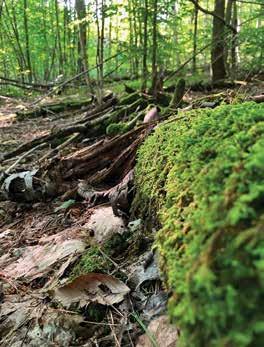
“Part of what makes Vermont Forest Cemetery diferent is that it’s not just a place on a map, but an ecosystem.”
the way all people were buried prior to the rise of embalming in the US in the wake of the Civil War. However, best practices of modern natural burial incorporate our knowledge of soil, silviculture, and environmental science. Modern natural burial grounds began to pop up in the US in the 1990s, and there are now over 150 Te vast majority of these are “hybrid,” meaning that they are conventional cemeteries that allow for natural burial on certain portions of the site. Nationally, there are only a few that operate as “conservation” burial grounds, partnering with environmental groups to ensure the land is protected to the highest possible degree, in perpetuity. Tat is the approach we took.
Proponents of natural burial think the process ofers advantages over modern burial practices. During a natural burial, the body of the deceased is bathed, often by loved ones, and kept cool until the time of interment, but there is no embalming or other form of preservation like there is in a conventional burial. Te body is then placed in a biodegradable container – like a pine cofn, a willow basket, or a linen shroud – and lowered gently to rest on pine boughs, leaves, and other green matter.
A natural burial doesn’t add carbon to the atmosphere like a cremation does. Cremation involves placing a body in an industrial furnace running at 1,800 degrees for three to fve hours; this process releases as much as a quarter-ton of carbon into the atmosphere. Te ashes have a pH of 11 4 and add no value to the soil because they are mostly inert salt – the calcium and phosphorus are locked in by the heat of the process.
PAST AND PRESENT
Part of what makes Vermont Forest Cemetery diferent is that it’s not just a place on a map, but an ecosystem: a community made up of trees, animals, plants, and myriad living things, as well as the soil, water, air, and stones that make up the landform itself. From the southern ridge, visitors catch a glimpse of the long view into the main range of the Greens, Burnt Mountain prominent on the horizon. Behind them, the headwaters of the White River pool and fow down a narrow cut. In the village of Roxbury, the water turns toward the main branch of the White in Bethel, joining the Connecticut River in White River
192 vermont almanac | volume 1 v may
VERMONT FOREST CEMETERY
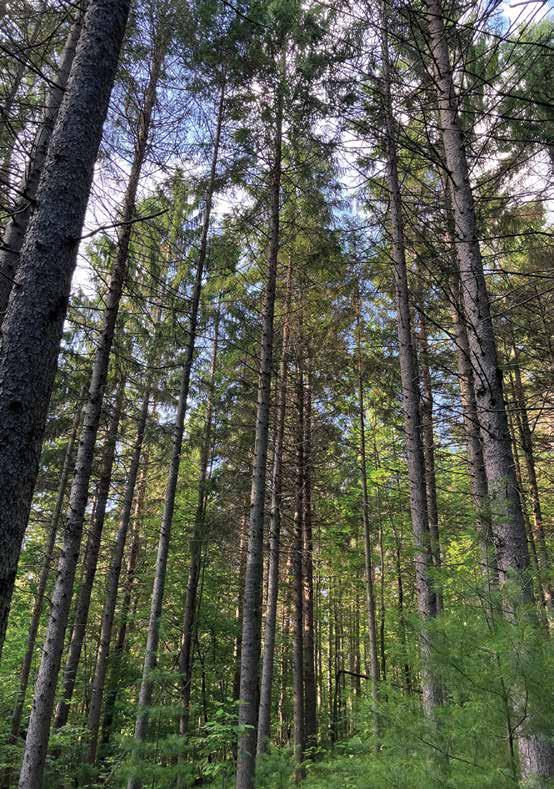
stories from & for the land 193
VERMONT FOREST CEMETERY
Te Windchapel grove
Junction and emptying into the Atlantic in Long Island Sound far to the south. In the other direction, the headwaters of the Dog River rise and fow out to the Winooski, into Lake Champlain, and up the Richelieu to the mighty St. Lawrence, which drains through the Cabot Strait between Newfoundland and Cape Breton Island into the Atlantic far to the north. Tis place exists on one of the six continental divides of North America: a point of balance between the Great Lakes and Atlantic Seaboard watersheds.
If you followed the Tird Branch of the White River toward Four Corners, where the original settlers built the town of Roxbury, you’d come to the Orcutt Cemetery. Dating to the late 1700s, the little plot holds stone markers memorializing the names, dates, and memories of those frst Roxbury inhabitants. Teir burials would have been traditional for the time and yet entirely consistent with natural burial practices. Te graves at Orcutt cemetery were dug by hand to a depth of three to four feet (“six feet under” is apocryphal to the time of the plague in Venice – any Vermont gardener can attest to the fact that digging that deep is far too much work.) Bodies were most likely dressed in simple burial clothing and placed in a pine box. Many of the original markers would have been made of wood and lost with time.
It’s taken a long time to get back to these practices of centuries ago. Te 2015 bill legalizing natural burial grounds in Vermont required a minimum burial depth of fve feet for adult bodies, which would have made it impossible for best practices to be used. Five feet is perfect for vaults but makes no sense ecologically. In natural burial, we dig no deeper than four feet so that the body and its bacteria can remain in contact with the active layers of the soil, where oxygen, moisture, warmth, and soil bacteria aid in recycling the body’s elements. Te miraculous mycorrhizal network, made up of fungi in a mutually supportive relationship with the roots of growing things, absorbs, flters, and transports these elements as nutrients for the forest. In natural burial, the body is not just fguratively but also literally returned to the Earth.
Fortunately, in 2017 the mandatory minimum burial depth was adjusted from fve feet to three and a half feet. I spent the next three years working with cemetery commissions to promote the introduction of natural burial areas, and eventually seven natural burial areas were added to cemeteries in North Hero, West Brattleboro, and throughout Washington County.
Since that time, natural burial options have been added at a number of additional cemeteries in Vermont.
CONSERVATION AND CEMETERIES
My favorite area of Vermont Forest Cemetery is what we call the Riverchapel, a mix of beech, river birch, and red maple that form a green roof over a little cascade. It lacks the serenity of the Windchapel portion of the property or the stark wildness of the southern ridge, but here I can feel the sunlight as well as the wind; I can walk the same path a thousand times and see something diferent every time. Noticing how nature has shaped this land for millennia, day by day.
It’s this sense of deep time, of being a part of something that will outlive me, that often grounds me amid the whirlwind of lobbying the Legislature, getting permits, fundraising, giving talks explaining natural burial, and all of the thousand and one things involved in starting a forest cemetery. Tere will be generations of human beings in intimate relationship to this forest, giving the bodies of their loved ones to nourish the land as it nourished them in life.
Natural burial is an option for every Vermonter now. Whether it’s here, or at a specially designed area of a conventional cemetery, or on one’s own land, people can choose to honor their role in the ecosystem. And with a recent bill formalizing Vermont’s commitment to conserve 50 percent of Vermont’s forests by 2050, natural burial is ready to take its place as a conservation tool. We can turn Vermont’s woodlands into living memorials: trees nourished, land conserved, the space uninterrupted by headstones or mowed lawns. I hope the creation of Vermont Forest Cemetery inspires a movement in this state and that people are moved to create additional natural burial grounds that meet the needs of their communities.
I truly believe that natural burial is one of the most profound ways we can connect to what it means to live in this world. Coming together in service of returning the body to the earth ofers us a unique opportunity to remember that although our lives are short, they change the people we love and the planet we live on. We are not, as we too often imagine, separate from the natural world.
When I return my body to the soil, the elements that once were me will become a part of maple, of birch, of cinnamon ferns, and mole salamanders. Tere’s a serenity in that for me. —Michelle Acciavatti
194 vermont almanac | volume 1 v may
May Day
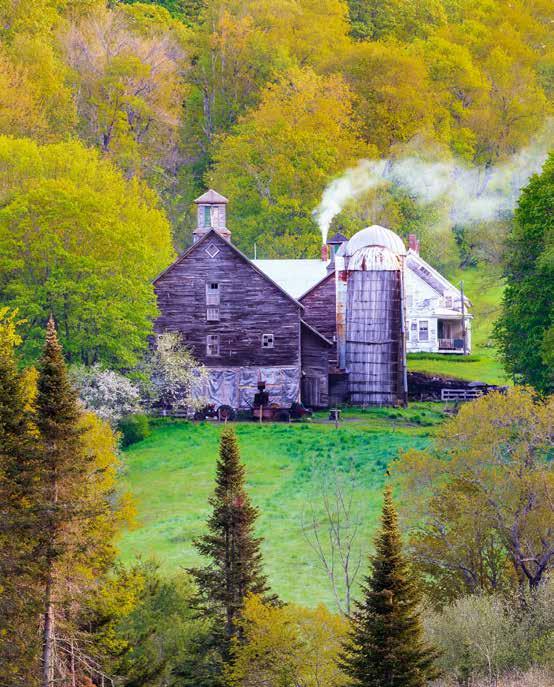
Lisa Lovelette captured this shot of an East Montpelier farm on an early May morning. She told us she was drawn to the scene because it “illustrates the unpredictable transition from winter to spring…. Although the landscape is transitioning from brown and gray to fresh, bright green, there is still a chill in the air necessitating a fre to make cold houses cozy and warm.”
stories from & for the land 195
LISA LOVELETTE

196 vermont almanac | volume 1 v sponsor

stories from & for the land 197 sponsor

JUNE
stories from & for the land 199

EDGARTON ’ S MILL ( 1950 )
Tis oil painting from the Orton Collection shows an old country sawmill at the foot of Rupert Mountain, though it could have been painted in a hundred places in the Vermont of a half-century ago. Te painting is by Beatrice Jackson (1905-1991), who lived in Dorset. As art appraiser Barbara Melhado (1937-2016) eloquently put it in For the Love of Vermont (the just-released book about Lyman Orton’s art collection): “Enjoy these glimpses into the not-so-distant past. Te buildings … may be gone, but their memory persists, and can act as a benchmark for what we want in the future.”
200 vermont almanac | volume 1 v june
COURTESY OF THE LYMAN ORTON COLLECTION OF THE ART OF VERMONT

BELDEN HILL : JUNE INVENTORY
Popsicle-orange newts jut out of pebbles after rain: watch their stillness or silly waddle.
Down in the gully: a score ago, someone had fung the body of a buck, one haunch gone, head hacked for a trophy.
Look! in three days, each cell and sinew had fed the biome, dung beetle to eagle: a tuft of fur left by miraculous scavengers.
Wild strawberries, starry blossom to red fruit, in a month above gravel: tart-sweet, may be gritty tiny hearts.
Birdsong weaves over us; S. holds aloft Merlin, app not raptor. She i.d.s hermit thrush, scarlet tanager; indigo bunting; sound to search:
fame-swatch, patch of sky in the canopy; never the reclusive futing thrush.
Wind towers on the spiny horizon: wing-blades (after cataract surgery) power gratitude.
Of-leash dogs roll in their own pleasure.
Smoke from Canada holds back— Greylock greets Monadnock.
Te summit register: hand-stitched, archival inks, annular rings—
birthday, yahrzeit, murder of wonder; sketches, homage: saving our breath for posterity….
Open poppies on the roof garden of a solitary dreamhouse.
— Verandah Porche
stories from & for the land 201
R
Surreal Skies
The dry weather rolled over into the early part of June, and we heard from farmers who said they didn’t take a frst cut of hay when they normally would because the felds were too dry. And then they didn’t get to cut because the rest of the month was too wet. Tat was pretty much the month in a nutshell.
While the two extremes left people feeling whiplashed, the numbers averaged out to be about normal. NOAA data had us to within 0 4 degrees of our 20th century average temperature, and within a quarter-inch of the long-term average rainfall.
Besides June’s pendulum swing from dry to wet, the big weather story was the smoky air. A blocking ridge of high pressure caused Canadian air to stream south from the 3rd through the 10th, then again towards the end of the month; at the time, more than 3.5 million acres of the North Woods was on fre. It was on a scale that ranked among the worst in history, and it occurred before the traditional fre season even
began. By mid-August, an astonishing 34 million acres in Canada would be estimated to have burned – that’s more than fve Vermonts. Smoke from the fres poured into the Northeastern US, all the way south to Georgia, and even across the Atlantic to Europe. Here in Vermont the air was thick and hazy and smelled like a wet campfre. Sunrises and sunsets were surreal afairs – the sky had an apocalyptic feel. We all became familiar with air quality alerts.
It’s not uncommon for the boreal forest to burn, and when it does it really burns – Canada’s policy is to let fres go unchecked unless they’re threatening settlements, and much of northern Canada is sparsely settled. But the scale and severity of these fres was unprecedented.
Our friend Naomi Heindel, with the North Branch Nature Center in Montpelier, has ties to the James Bay region, which was ground zero for many of the Eastern fres. She put us in touch with Alan Saganash, a Cree hunter and trapper who lives there.

202 vermont almanac | volume 1 v june WEATHER
June 25, 2023: a smoky haze across Waterbury Reservoir.
JEFF WHALEN

He told us:
“ Te amount of forest lost is mind boggling. I’ve seen forest fres almost every year, but these, which started in the latter part of May and burned all of June to the middle of July, were like: ‘Wow.’ I’d never seen anything like it all my life. About 29 percent of our Waswanipi Eeyou Istchee burned. [Editor’s Note: Eeyou Istchee translates to “ Te People’s Land.” Tere are nine Cree communities in the region that share an area that’s around 27,000 square miles in size.] I am still trying to absorb the loss of our hunting grounds, in which 36 of our 62 traplines were afected by the fres. [Editor’s Note: In Cree society, no one owns property, per se, but the land base is broken up into family hunting territories, called traplines. Tey average about 280 square miles each.] Never seen a whole trapline burn until this year. It’s devastating when you think about the loss of good wildlife habitats, the wildlife that perished, our waters polluted. But all you hear on the news is about the loss of volume to the forest industry! Tese
wildfres burned like 10 years of annual harvest plans; approximately 20 million cubic meters of wood! Tat is incredible to think about.
To actually see the forest fres, and be caught in smoke, and actually feel the heat is a frightening experience. We got caught in the Quevillon fre, which was the second-biggest fre on Eeyou Istchee. It was a small fre at frst, and it just got bigger by merging with other fres. Tat fre was almost 500,000 hectares! [Editor’s Note: Tat’s over a million acres – it would be like if Bennington and Windsor counties both burned, plus another 176,000 acres.] We got evacuated twice this summer, once to Quebec City and the second time to Trois Rivieres. Not a very good summer. We had to wear masks when we went out, but could take them of when we went in. Quite the opposite of Covid 19 procedures!”
We looked back at our weather summaries from the past three volumes of the Vermont Almanac and saw that June 2022 was close to normal in both temperature and precipitation. June 2021 was hot and dry with two bouts of record-breaking heat. Whereas this year June was marked by a very dry then very wet dynamic, June 2020 was marked by a very cool then very warm dynamic.
stories from & for the land 203
A summer of smoke: map of wildfre activity as of June 28
SLUGS ARE HERMAPHRODITES and can reproduce by themselves or with a partner. When two slugs mate with each other, they each play the role of both sexes. First, sperm is exchanged with their male genitalia. (At times, the penises become entangled during mating and the slugs may bite them of in order to free themselves, a sacrifce known as “apophallation.” From then onward, the apophallated slugs are only able to reproduce as females.)
Te white substance you see in the photograph is sperm from both slugs. After the male part is done, the female part kicks in, as each slug takes its partner’s sperm into its body, and each heads of to lay eggs and die shortly thereafter.
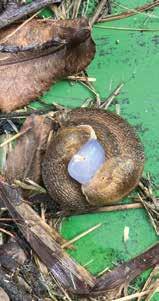
NATURE NOTES
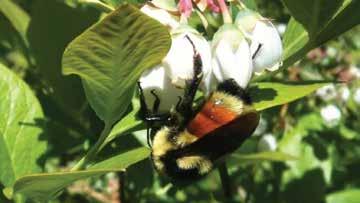
eBuzz Pollination
It’s not news that pollinating insects are increasingly scarce. It’s also well understood that more pollinators result in more blueberries. But a few years back, scientists at the Gund Institute at UVM were the frst to fnd that how well a fower is pollinated makes a diference in the size, number, and the ripening time of the resulting berries.
Wild bee species are what make the diference. Honey bees, as I noticed myself during the many decades when I had bees, don’t really like blueberry fowers, largely because they can’t get to the pollen very well. Te pollen in a blueberry fower is sealed within its anthers and is only released by buzz pollination Tis occurs when a visiting insect grabs onto a fower and vibrates its fight muscles. Te anthers have only a small opening, so it takes a good shake at a certain frequency for the pollen to come out. Many bumble bee species (which, like honey bees, live in colonies) and many solitary bees have fgured out how to buzz to get pollen from blueberries. Inadvertently, they then take some of this abundant powder to the next blueberry fower.
Te family that includes blueberries (Ericaceae) and the one tomatoes are in (Solanaceae) have many members that only release pollen when buzzed. Rewarding specialized pollinators is a good strategy for a plant. Freely available pollen is more likely to be wasted when a generalist pollinator heads of to visit a diferent species next.
In the recent Vermont study, PhD student Charles Nicholson and members of his team collected pollen from blueberry fowers by vibrating them with an electric toothbrush. Tey then brushed this pollen onto more than 5,000 blueberry fowers. Tese perfectly pollinated fowers outproduced naturally pollinated ones and ripened two and a half days earlier, suggesting that a greater abundance of wild bees could signifcantly increase both yields and berry quality. —Virginia Barlow
204 vermont almanac | volume 1 v june
UVM
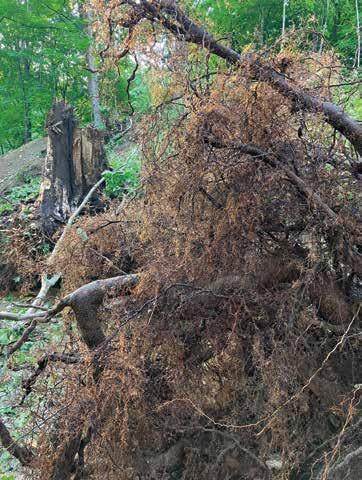
DURING THE GROWING SEASON , tree roots are covered with absorbant root hairs that look like, well, hair. Te visual allows you to imagine how the roots take in nutrients and water; it also shows you how delicate the whole system is.
I OFTEN WONDER HOW PLANT POPULATIONS change through the years, but without data my observations are only anecdotal. For example, it certainly seems like there is more white snakeroot (Ageratina altissima) (below) and purplestemmed angelica (Angelica atropurpurea) than there was even 10 or 15 years ago, but maybe it’s just an inaccurate observation that I falsely reinforce, similar to how when you get a new vehicle you notice that make and model on the road more.
—Mike White
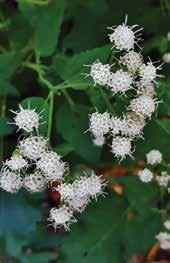
SCIENTISTS HAVE BEEN TRAPPING AND COUNTING MOSQUITOES in Vermont since 2009, and in June, they were documenting twice as many mosquitoes as usual. By August we were thoroughly inundated. Tey were still going strong in early October.
stories from & for the land 205
BEZIAT / CC
MATTHEW
Editor’s Note: Te following two stories were written by Paul Revere Ladd, Jr., and published in his book Grow Good Food – see the story on page 166 to learn more about Paul.
Interplanting
There are many traditional patterns for getting big production from a small garden. Native Americans did, and still do, interplant beans and corn, and corn and squash. Here is a tradition we have used for many years: Tree furrows about a foot apart are made in a bed. Carrot seed is sown. In the same furrows dill seed, about a foot apart, and radish seed, four to six inches apart, is sown. Te three furrows are covered with soil about half an inch deep and the soil compressed by walking on it. Midway between the planted rows, two furrows are made. In these, open head or leaf lettuce is sown, the seed covered half an inch deep, and compressed by footsteps. By midsummer, the dill umbels will be aloft to cut for salad, or later for seed, their shade so insignifcant that it doesn’t afect carrot growth. A number of authors have suggested that dill has a negative efect on carrots. I have planted carrot beds simultaneously in diferent parts of our garden, with and without dill, and have seen no diference.
Tis may not be the end of the story. You may pull the carrots in midsummer and replant the bed with a fall crop, like kale, beets, lettuce, or spinach. Or, you may plant a fall crop between carrot rows in July and harvest large carrots in September, permitting
Mthe succeeding crop to take over the bed. If the fnal crop is spinach or kale, it may last into winter. Managed in this way, the bed will have produced fve crops. —Paul Revere Ladd, Jr.
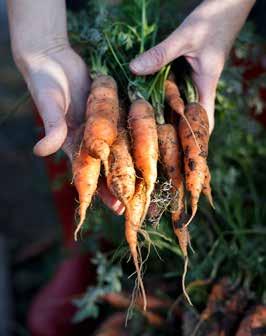
Death to Potato Bugs, Results Guaranteed
any years ago, while we were grading apples, Everett Harwood of Bennington, Vermont, told me the following story: “During the great blizzard of 1888, a door-to-door salesman knocked on the kitchen door. After being given a chair by the stove and a cup of cofee, he made his sales pitch and made one sale, a product labeled ‘A Death To Potato Bugs, Price One Dollar, Results Guaranteed or Your Money Back, Do Not Open Until Ready to Use.’ When potato bugs appeared the following summer, the package was opened. It contained three items: a little wooden block, a little wooden mallet, and an instruction sheet.” —Paul Revere Ladd, Jr.
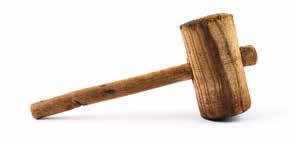
206 vermont almanac | volume 1 v june AT HOME •

Pea Shoot Salad
Over the years, I’ve crossed paths with pea shoots in CSA shares right when summer begins. So I now associate pea shoots and this recipe, adapted out of an attempt to use them up, with the start of summer.
I’m also partial to this dish because it represents my shift to locally centered cooking and eating. In 2020, I was living in Massachusetts, alongside too many people, staying in my little downtown apartment as much as possible, and feeling overwhelmed and fearful of the outside. Te excuse to drive out of town and pick up a bunch of fresh, local, seasonal food each week was a gift in more than one way. My kitchen has never been the same, and, dare I say, the easy access to good, real food is one of the many reasons why we decided to become Vermonters.
Before writing this, I assumed I knew exactly what pea shoots were – the tops of snap peas! I envisioned folks snipping of the tops of the plants to encourage growth. Hilary Minerd at Windingbrook Farm on the Straford/ Sharon line gently corrected me. Like micro greens, pea shoots are typically grown in trays, though they can be sown in the ground. Te shoots are harvestable in as little as a week since they’re the frst bits of plants that rise above the soil. Tey provide farmers, both hobbyists and professionals, the opportunity to grow something quickly that packs a lot of favor and nutrition into a tiny space.
So, my association with pea shoots as a summer food is not entirely accurate. Luckily, this is a lovely complement to something fatty – fsh, steak, hot dogs, or whatever – and functions as a great potluck/cookout side. Te brightness of the miso, shoots, and beans lifts that fattiness to something more complex. Perhaps you’ll also fnd a reason to associate this with summer.
—Olivia Piepmeier
INGREDIENTS
2 tablespoons white miso (or just eyeball it; I haven’t tried it with brown miso, but that might also be fne)
4 tablespoons unsalted butter garlic cloves, fnely chopped (I’m someone who typically uses one head of garlic when a recipe calls for any garlic, so I deem this a “to preference” ingredient)
3 cups (or 2 15-oz. cans) white beans-of-choice rinsed and drained (I highly suggest toasting fennel seeds and including the toasted seeds while your beans cook or adding to canned beans.)
A big handful of pea shoots (or stray from the recipe and use arugula or another zesty, leafy green)
3 to 4 small radishes, thinly sliced (optional, they provide a zesty crunch but, for a non-radish fan, not integral to the experience)
Black pepper, to preference
METHOD
In a small bowl, whisk the miso with ¼ cup water until dissolved. In a large skillet or a medium-tolarge size pot, melt the butter over medium until foamy. Immediately add garlic and stir for about 30 seconds. Add the beans and coat in butter. Add the miso water and cook for about 5 minutes to combine favors and warm everything. Remove from heat, toss in the greens (and radishes, if using), and stir. Add pepper and sample for any needed additions. Serve warm or cold. Note, this tastes better as time goes on and the favors meld.
stories from & for the land 207
OLIVIA PIEPMEIER
Unexpected Crops in Vermont
What do a cranberry farmer and a rice farmer have in common?
(Spoiler: this is not the lead-in to a bad joke.) As Robert Lesnikoski of Te Vermont Cranberry Company and Erik Andrus of Boundbrook Farm have proven, both can grow their crops – and secure a successful market – in the Green Mountain State. Vermont Almanac met with both farmers in early September for the latest scoop.
THE VERMONT CRANBERRY COMPANY – EAST FAIRFIELD
In brown waders and a broadbrimmed hat, rake extended through a groovy red wave, Robert Lesnikoski’s portrait on a can of hard cider doesn’t quite match reality.
Te can is Citizen Cider’s “Americran,” featuring apples co-fermented with Lesnikoski’s cranberries. “So, I’m on the label,” Lesnikoski quips, noting the Burlington-based cider maker

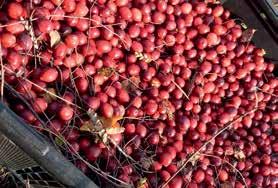
is a long-time, loyal customer. Te reality of harvesting cranberries on his East Farfeld farm? Lesnikoski uses a small walk-behind picker that scoops cranberries of their vines, a
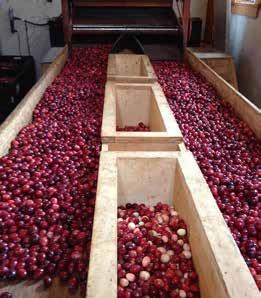
Left: Vermont Cranberry Company’s berries, before and after harvest. Above: Te cranberries are sorted by hand; pristine berries are sold fresh, and those with imperfections are used for other products, like Vermont Cranberry Company’s Super Tart line of cranberry juice.
INDUSTRY f 208 vermont almanac | volume 1 v june
method called dry harvesting. Tat’s opposed to the more conventional method of wet harvesting, where a farmer foods a cranberry bog and skims the foating berries of the top. But not much about Lesnikoski’s cranberry farm is conventional.
Since launching Te Vermont Cranberry Company in 1996, Lesnikoski remains the frst and only commercial cranberry grower in Vermont. “My initial attraction was that there’s really only 1,400 cranberry growers in North America. It’s really small,” Lesnikoski says. “And there really is no factory-manufactured equipment [for the industry]. All of our equipment is from the 1950s and 1960s, so you end up building and fabricating pretty much everything. Tat’s one of my strong interests in life; I am a metal fabrication person, so I basically build everything we need.”
It all started after Lesnikoski left work in logging (he originally moved to Vermont to attend forestry school) and realized cranberries were in a boom period. So he re-contoured the former dairy farm that he’d bought in the early 80s – for cranberries. Over the past 27 years he’s grown cranberries on three acres (recently downsized to two acres) of constructed bogs, averaging about 16,000 pounds of cranberries per acre annually.
“It’s a little bit of force-ft agriculture here, since cranberries rely on acidic sand,” Lesnikoski says. “ Tey grow in eight inches of it, so that’s imported into our cranberry beds, since our sand in northwestern Vermont is pretty pH basic.” Vermont’s climate, on
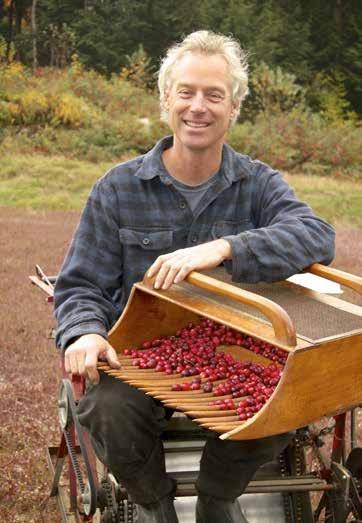
Robert Lesnikoski uses a hand rake (on his lap) to harvest small batches of cranberries from the plants, and a mechanized 1961 walk-behind unit (that he’s seated on) for larger batches.
the other hand, is a natural ft for the crop. Native to the arctic circle, cranberries like a cooler, temperate climate. “ Tey sufer more from heat than from cold,” he says. Last year, Lesnikoski replaced his Early Black crop bed with a variety called Crimson Queen, which is ten times more productive. He also grows a bed of Stevens – the major commercial cranberry variety in the United States.
Troughout the growing season, the Vermont Cranberry Company is a one-man operation. Once harvest time arrives in October, Lesnikoski has parttime help that continues into the packing season, which ends in December. Although for years, Lesnikoski used to sell to 120 accounts directly, over the past fve years he has transitioned to a distribution model. He now works with four distributors
stories from & for the land 209
CRANBERRY COMPANY
VERMONT
that pick up and truck his fresh cranberries to markets, co-ops, and farm stores throughout the state, such as Burlington’s City Market.

“Our business wouldn’t work anywhere else but in Vermont, basically,” Lesnikoski underscores. “Everyone is in it together, and it’s a mutually supportive network of customers, distributors, and vendors.” And for a farmer growing a little-known crop in Vermont, that support network is crucial. Add to that the fact that cranberries can be a fckle crop to farm. All of the rain in 2023 was good for Lesnikoski’s cranberries. “We didn’t have to irrigate as much,” he says. “But crop quality is unknown until after you pick. And we’re not out of hail season yet. Hail can destroy your crop in about three minutes, which has happened a couple of times. It’s not a crop until it’s in the barn.”
In addition to fresh cranberries, Lesnikoski also sells his own cranberry juice, made from seconds and sort-outs, which can be purchased throughout the state and in the New York City metro market. “You’re sorting out
Walmost half of your crop when you’re a fresh-pick grower, due to color and defects,” he explains, “so you need to do something with that. Juice is almost half of our sales now.”
Lesnikoski also sells cranberries in bulk to Vermont businesses Citizen Cider, Boyden Valley Winery, and Mountain Mack Cider Company, which buy them for their fermented products. “I did business with Citizen Cider when they frst started, and their frst order was 120 pounds of berries,” Lesnikoski recalls. “Now, they buy 10,000 pounds a year. It’s been a really great relationship all the way through. I’ve sold cranberries to other companies and they’ve outgrown my capacity, but Citizen Cider has kept that connection.” Bonus: he gets Americran cans to stock his fridge – alongside his cranberry stash – whenever he wants. —Lucy Clark
BOUNDBROOK FARM – VERGENNES
hen Erik Andrus talks about ducks, his face lights up. Sitting at the kitchen table of his Vergennes farmhouse wearing a Boundbrook Farm T-shirt – it depicts a duck diving under water in a rice paddy – Andrus explains that the way he farms rice, “It’s really the ducks that are growing the crop.”
For a period of six to eight weeks each year, Andrus introduces young ducklings throughout his six acres of fooded rice paddies in Vergennes and additional acreage in New Haven.
Te ducks eat weeds – fastgrowing weeds are an issue in rice farming – but avoid the rice leaves, which contain abrasive silica. Tey also help fertilize the crop as they go about their business. “ Tis year, we did a non-duck control plot and a plot with ducks in it,” says Andrus. “Same soil, immediately adjacent, and the diference in the outcome is so stark …” Andrus pauses and then chuckles, “the ducks did such a great job, it’s like, ‘we can’t ever not do ducks again!”’ Now in his 14th year of planting rice, Andrus is the largest rice farmer in the Northeast. Initially,
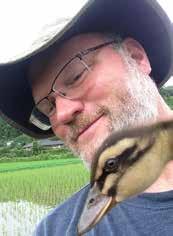
his
210 vermont almanac | volume 1 v june
BOUNDBROOK FARM
Erik Andrus and one of
co-farmers at the rice paddies.
CITIZEN CIDER
Vermont hard cider maker Citizen Cider uses Vermont Cranberry Company’s berries in its Americran cider.
he started out growing wheat on his farm with the intention of supplying his wood-fred bakery with home-grown four. (Just this fall he ended an 18year stint selling artisan baked goods on the farm.) But in 2010 he pivoted to rice farming after coming across researchers who were experimenting with growing Japanese rice varieties in Vermont. Andrus had lived in Japan for a year back in 2000 where he’d witnessed rice farming in Hokkaido – the coldest region in the country. Ultimately, he realized, if Japanese farmers could grow rice with a cool, wet climate similar to that of Vergennes, he could too.
Andrus hasn’t looked back since, especially after coming across aigamo: an ancient Japanese agricultural technique of integrated duck and rice farming. Andrus implemented it on his own farm after reading the book on the practice: Te Power of Duck by Japanese duck and rice farmer Takao Furuno. Andrus traveled to Furuno’s farm in Japan in 2015, establishing a now ongoing relationship with Furuno. “It wasn’t until I started traveling to Japan and developing a friendship and mentorship network with Japanese farmers that we were able to take the lid of of what could be done,” Andrus says. He even equipped Boundbrook Farm
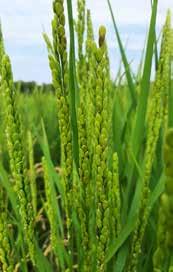
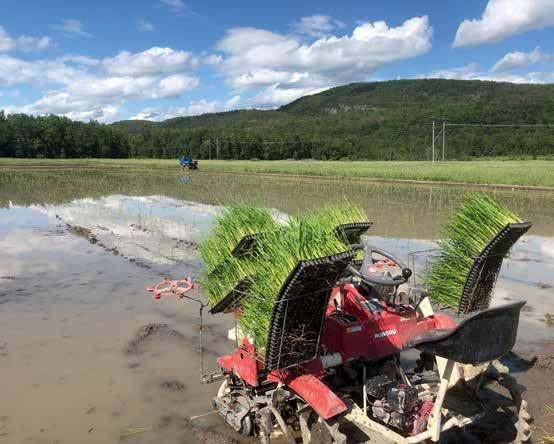
stories from & for the land 211
Not your typical Vermont farm feld: a fooded paddy and a rice transplant machine.
Boundbrook Farm grows varieties of short grain rice from northern Japan.
with the same tools that are used for small-scale rice farming in Japan.
In recent years, Andrus has seen the fruits of aigamo: “To be able to [see] deep green color and an absence of weeds after all of these years we’ve put into it, that’s very satisfying,” Andrus refects. “To be able to raise large swaths of crop that look as good as any feld in Japan … It’s taken a long time to get to this point, but it is gratifying.”
Andrus grows varieties of short grain rice from northern Japan, which he mills upon harvest. Boundbrook Farm has its own small drying and milling facility, just steps from Andrus’ house, where specialized machinery (also imported from Japan) allows him to do all his own processing. In late summer, Andrus was optimistic about the 2023 rice crop that will be harvested in late fall. “I think this year we’re going to break some
records, knock on wood, both per-acre yield and overall yield. It’s been a really good year.”
About one-third of the farm’s rice sales go directly to local households that pick up their freshly milled rice on the farm in late October. (Customers can place an order, in pounds, on the Boundbrook Farm website for white, semi-white, or brown rice.)
Te average order is about 20 pounds of rice, Andrus says, but he also notes that some customers order hundreds of pounds for their whole family for the year. Te rest of his rice is marketed wholesale.
Boundbrook Farm also sells fnished ducks: white Moulard meat ducks, to be exact. “ Tey’re a really good ft for us and do great in the paddy,” Andrus says. “ Te challenge is that there is no USDA slaughterhouse we can take our ducks to [locally], so we have to truck them to New York state and then back again
as fnished ducks.” Fortunately, there’s always a demand for Andrus’ ducks. Tis year, Farmers to You, which distributes around coastal New England, is buying almost half of the fock, with Philo Ridge Farm taking a good amount as well. “I’m sure some chef is going to snap up what’s left,” Andrus adds.
Looking to the future, Andrus is already working as a consultant for Cornell Cooperative Extension on a rice project in New York state. Te aim: to demonstrate commercial techniques for other would-be rice farmers in the Northeast to learn from. “It’s year one for that project, but I think that’s sort of the beginning of building a resource network to help farmers learn and get started in rice farming.” He also plans to spend the winter trying out sake brewing with a potential sake microbrewery in mind.
—Lucy Clark
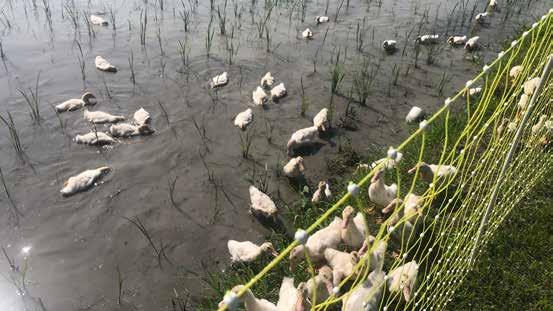
212 vermont almanac | volume 1 v june
Moulard meat ducks do the weeding at Boundbrook Farm.
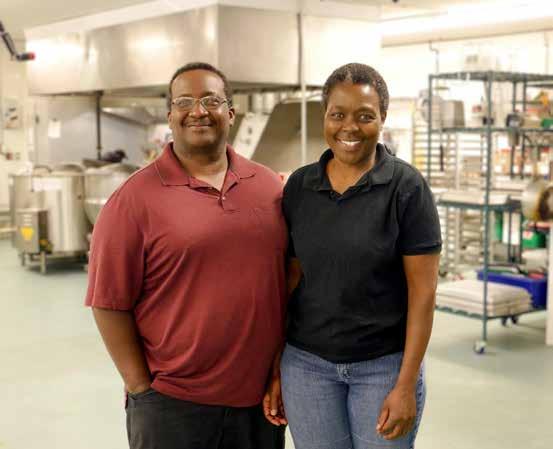
Global Food, Vermont Flavor
They say that food has the power to bring people together. Global Village Foods is proving just how true that is, with its popular menu of ready-to-eat meals and snacks that includes African No-Nut Stew, Swahili Curry Chicken, Black Eyed Bean Kofta, Chickpea Tajine, and other traditionally African dishes – all made here in Vermont. In fact, despite the African origin of these recipes, the Quechee-based company is able to source much of its vegetables and meat from Vermont and greater New England.
“Yes, it’s African cuisine, but it’s still the basic stuf. It’s carrots, cabbage, potatoes, and onions,” said Mel, who co-owns Global Village Foods with his wife, Damaris.
Damaris is a trained chef from Kenya who immigrated to New Hampshire in 1991. She and Mel, who grew up in Memphis, then moved across the river to Vermont and sold traditional African food at regional festivals. As their reputation grew, they formed Global Village Foods, and today, their meals can be found on shelves at co-op grocery stores, in every Whole Foods store in the Northeast, and in the dining hall at the University of Vermont.
Grants from Vermont’s Working Lands Enterprise Initiative and the New England Food Vision Prize helped get the enterprise of the ground and provided the Halls with the resources to source many of their ingredients from farms in Vermont or adjoining New England states. When possible, they prioritize
stories from & for the land 213
Mel and Damaris Hall have found success preparing traditional African dishes using Vermont ingredients.
LAURA
HARDIE
BIPOC and immigrant farmers as a way of paying it forward, Damaris says. It’s a full-circle moment.
“It’s quite exciting to see people who are fairly new to the country doing the things that they like to do,” she said. “And it’s good to say, ‘Hey, we are making a diference; we are buying their products.’ Tat feels good.”
VERMONT GROWN
Te list of Vermont farms currently supplying produce to Global Village Foods includes Cedar Circle Farm in East Tetford, Honey Field Farm in Norwich, Hurricane Flats in South Royalton, and Moon Castle Farm in Topsham. Te Center for Agricultural Economy’s Hardwick-based Farm Connex Program, a distributor of products from Vermont farms to retailers and other wholesalers, is also a partner in supplying assorted vegetables.
“Seventy percent or more of our produce is local from late summer to fall,” Damaris said. “We try to source as much as we can during the growing season, but the growing season only takes us so far. Last year,
we could get carrots and cabbage until January.”
Global Village’s beef is sourced locally year-round through Black River Produce, a food distributor based in Springfeld. Black River sells them beef from Vermont, and then from across New England when Vermont sources are exhausted. So far, Global Village has been unable to source chicken locally. “No one has a chicken solution yet that is price point competitive for wholesale,” Mel said.
Global Village Foods’ team includes one employee dedicated to building relationships with farmers and ensuring their products meet USDA Food Safety Modernization Act (FSMA) standards. Damaris said many farms they work with are organic, which means they generally already meet the checklist requirements. Te challenge isn’t the quality; it’s the quantity. When demand exceeds supply, they’ll search out additional sources of local vegetables. “We’ll go through a farmers’ market and say, ‘Who has extra?’ and swoop up everything and store it and have it available,” Mel said.
Te success Damaris and Mel found in sourcing

214 vermont almanac | volume 1 v june
Making falafel at the Global Village Foods facility in Quechee.
LAURA HARDIE
and selling their products, they say, is largely because of the food culture they found in Vermont. “Vermont has a national brand ethos around clean eating,” Mel said. “Made in Vermont is a prominent feature of what we do.”
Momentum for their business can be traced all the way back to 1997, when Damaris and Mel opened a restaurant in White River Junction called Taste of Africa Karibu Tulé and built a loyal following. A few years later they had a child who was born with severe food allergies. Damaris shifted to an allergyfree menu at home and at their restaurant. “It inspired us to say, ‘How many other people out there are experiencing the same thing that we are in that they can’t fnd anything their child can eat?’ And what can we make for them?’” she said.
As the restaurant grew, the challenge of raising kids and running it became too much. So, the business shifted to catering and selling prepared meals at farmers’ markets and co-ops. Tis was the launching point for creating the Global Village Foods brand in 2016.
Teir ready-to-eat meals contain no additives, preservatives, or artifcial ingredients. Tey’re all allergy-friendly, with gluten-free and vegan options. “Which is how Damaris has cooked all her life,” Mel said.
Just as the business took of, the Covid-19 pandemic caused it to drop of a clif, and Global Village shifted to providing food to community food shelves through the Vermont Everyone Eats! Program. Run by the State of Vermont, it paid businesses like Global Village to provide nutritious meals to Vermonters in need of food assistance.
As the economy rebounded, they shifted their focus to expanding into food service. At the University of Vermont, they provide bulk stews and cases of samosas and falafels for the dining halls. Teir individually portioned meals and snacks are sold in campus convenience stores.
Damaris talked about their plans for growth in campus dining. “ Te dining experience has changed over the years on campus…our food fts into the food stations for ethnic and allergy free.” In anticipation of expanding to more colleges and universities, they recently opened a new production facility in Quechee. Te challenge now is sourcing enough local ingredients and getting their products across the US
“If you talk to any food producer in Vermont,


Te company’s line of ready-to-eat meals (including herb spiced beef samosa, on plate) has attracted a loyal, and growing, group of customers.
you’ll fnd distribution is a problem. It’s hard to get stuf out of Vermont and into Vermont,” Mel said. “ Te next piece of the puzzle becomes fnding the right distributor with the right relationships in the retail channels you’re trying to get into.”
As Damaris and Mel refect on the company’s growth, they’re hopeful their food will unite people as it makes its way from coast to coast. “Nowadays, people are looking for more favors, foods that are more diverse,” Damaris said.
“Good favor and good food know no boundaries,” Mel added. “ Te reality is it’s hard to even defne ethnic food. Tere is an infuence from some global, regional tradition that crosses into almost every aspect of food.” —Laura Hardie
stories from & for the land 215
FOODS
GLOBAL VILLAGE
Te Mysteries of Te Brunswick Springs
Ilove the Northeast Kingdom. I have good memories up that way. I remember my dad taking me fy fshing on the Barton and Willoughby Rivers as a young kid and handing down his wisdom. Later, I’d attend Lyndon State College in Lyndonville and go out backroading on weekends.
Te journey, to me anyways, is always half the fun, and on this particular trip a compadre and I headed for one of the most remote areas of this most remote area of Vermont. We passed towns with increasingly thinning populations, and then turned north onto deserted VT Route 102, which serpentines along the mighty Connecticut River. Te road brought us deep into unpopulated timberlands and little towns that are now smaller than their census counts a century ago.
Our destination was the town of Brunswick, which was little more than a vacant one room schoolhouse, a town ofce building, and two homes. Te surrounding woods are home to Te Brunswick Springs, which, believe it or not, Robert Ripley once hailed as “the eighth wonder of the world.” Tat’s a stretch, but it’s easy to understand the fascination with this place because it’s a true geographical anomaly. Here, six springs, each purportedly with completely diferent mineral contents, bubble forth from a single knoll as close together as the spigots on a soda fountain. Tey fow under the crest of a steep hill before all merging together in an – at the time of my visit – orange,
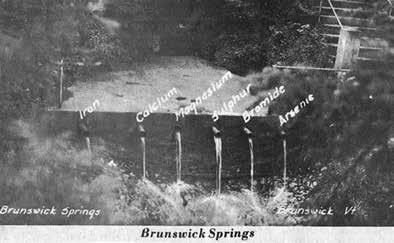
gunky, iron-oxidized spillway draining down into the Connecticut River below.
We brought an old, helpfully labeled photograph of the springs that lists their individual mineral contents: iron, calcium, magnesium, white sulfer, bromide, and if you’re really intrepid, arsenic. •
To Native Americans, the springs were, and still are, considered magical healing waters on sacred ground. Te Abenaki used to make long-distance treks here to beneft from the “medicine waters of the great spirit.”
Reportedly, European settlers discovered the springs in 1748, when Abenakis led an injured British soldier to the springs all the way from Lake Memphremagog. Te soldier had a badly wounded arm that was almost lifeless, and he worried about having to get it amputated. Legend has it that a shaman worked those magic springs over his arm and, miraculously, life returned to the injured limb.
So is there truth to any of these healing claims?
In the late 1800s, Vermont state geologist Dr. H. A. Cuttings attempted to lend a veneer of credibility to the legends by likening the water to the chalybeate waters in Germany, which were sought after to combat skin diseases. A state geologist from New Jersey later tested the springs’ water and observed that the mineral contents weren’t all that diferent from one to another, mostly just a lot of sulfur dioxide. Tat hasn’t stopped the legend among some locals, who didn’t and don’t need evidence or scientifc confrmation of the spring’s healing powers.
If these waters are so miraculous, why are they so obscure today? Part of it might have to do with a curse.
According to local lore, the troubles started when that soldier came back to what is now Brunswick after the French and Indian war. He was so taken by his experience that he wanted to bottle and sell the waters. Te Abenaki weren’t having it, frmly
216 vermont almanac | volume 1 v june A LOOK BACK •
An old newspaper photo with the diferent springs labeled.
objecting to the preposterous sale of something the great spirit gives for free.
Anglo and Abenaki began to fnd themselves in a conficted relationship over the local wonder. At frst, everyone took freely of the waters. But soon that notion of sharing began to corrode. Businessmen made a variety of ofers, but the Native Americans held frm to their decision not to sell. Because being covetous brings out the worst in people, attempted negotiations became hostile, and two Abenakis were killed in the confict. Te story goes that the grief-stricken mother of one of the dead, who also
happened to be a shaman or sorceress depending on the storyteller, retaliated by creating a curse.
In 1790, the frst boarding house to ofer accommodations and easy (uncharged) access to those marvelous waters was built nearby by a Major French. Te number of boarding houses grew to 12, operating on both sides of the Connecticut River, by 1820. By 1845, people from as far away as coastal Maine were making the arduous journey to sample Vermont’s now celebrated healing springs – which, among other things, were advertised as being able to treat a murderer’s row of maladies that included inanimate
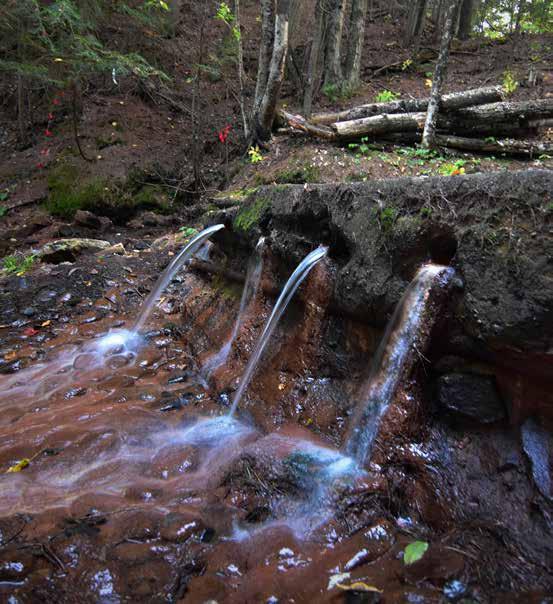
stories from & for the land 217
PHOTOS BY CHAD ABRAMOVICH
limbs, vitality, kidney problems, consumption, and rheumatism.
Charles Bailey erected the frst hotel near the springs in 1860, which he then sold shortly after to local dentist D.C. Rowell. Mr. Rowell named his new endeavor Te Brunswick Springs House, and he would also be the frst person to sell the actual waters when he later opened a bottling plant. If there was a curse, it may have fred the frst of several warning shots in 1894, when Te Brunswick Springs House burned to the ground.
Not to be deterred, the dentist rebuilt somewhere on the bluf between the lake and the river, this time as Te Pine Crest Lodge. When the lodge later collapsed into the river, the springs were put back on the market.
John Hutchins, a successful druggist, real estate agent, mortician, and lumber baron from across the river in North Straford, saw the springs as a can’tmiss business opportunity. He built a brand-new resort hotel, with the waters as part of the levied package. On September 19, 1929, the hotel burned down – gone before it even had its grand opening.
But Hutchins wasn’t the superstitious type, and he rebuilt in an even grander fashion. Te new hotel was a dignifed four and a half stories tall, with 60 rooms featuring plate glass windows. Water from the springs was piped into 30 of them. Reservations poured in, and anticipation for opening day was mounting.
Ten on May 15, 1930 – just a month before the hotel was set to open for business – the night watchman spotted smoke billowing from a storage room. By then it was too late. Te phone lines were already superheated and snapped – cutting of communication while the building went down in a fery wreck.
Again, the willful Mr. Hutchins rebuilt, and by spring of 1931, the new hotel was ready for business – advertised as a “modern city hotel nestling between the White and Green Mountains.” A colorful brochure advertised the “Medicine Waters of Te Great Spirit” and their Native American mystique, which was bolstered by a thematic design scheme of woven patterns and a kneeling brave partaking of the magic fountain.
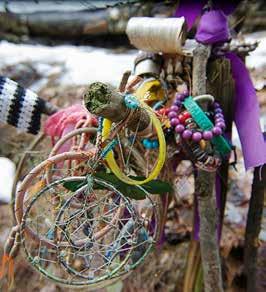
On April 23, 1931, John C. Hutchin’s third and fnal hotel was struck down by an inexplicable inferno. Maybe by this point he had become a believer in the curse, because he never tried to rebuild. In the years that followed, neither has anyone else. •
As we hiked toward the springs, the acrid smell of sulfur told us we were close. Tat was a huge boon, actually, because I had no idea exactly where the springs were. Just that they were on an embankment above the Connecticut. Te springs and the surrounding lands have since returned to Abenaki ownership; a non-proft organization was formed about 15 years ago to purchase it with the help of the Vermont Land Trust. Now, any sort of development near the springs is prohibited.
We walked a bit farther, and our spirits elevated at the discovery of a worn concrete staircase in the woods. Ten, we found more ancient ruins of the former business operations. Another staircase plunged down a steeper pitch to a concrete landing overlooking the springs themselves – we had made it! Four of the six springs were still fowing through the now-rusted pipes; the infrastructure around the other two seems to have completely deteriorated, allowing these springs to return once again to a somewhat natural form
Did we sample the waters? No. While it’s understandable to get inspired by the parables, the code of conduct here is defnitely caveat emptor. Te silence was deep, and the place’s peculiar history lurked and skulked around us. We hastened our pace and headed back to the car. —Chad Abramovich
218 vermont almanac | volume 1 v june
To Native Americans, the springs were, and still are, considered magical healing waters on sacred ground.
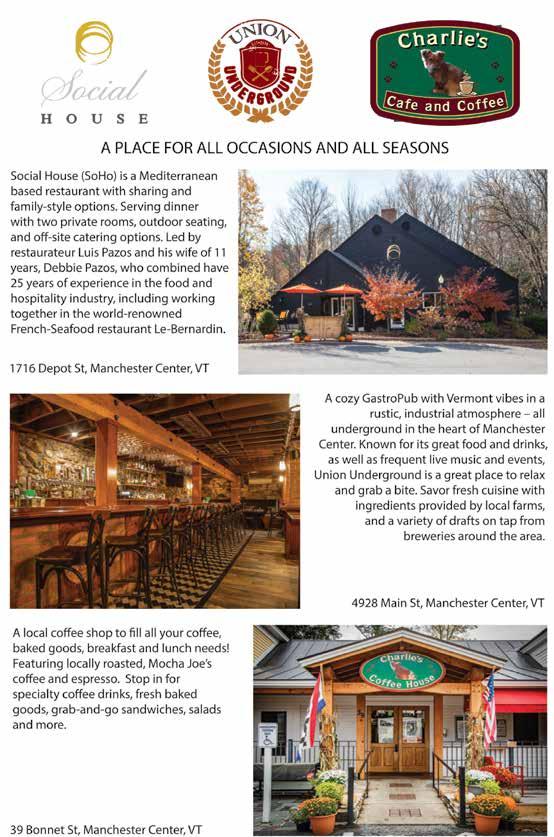
stories from & for the land 219 sponsor
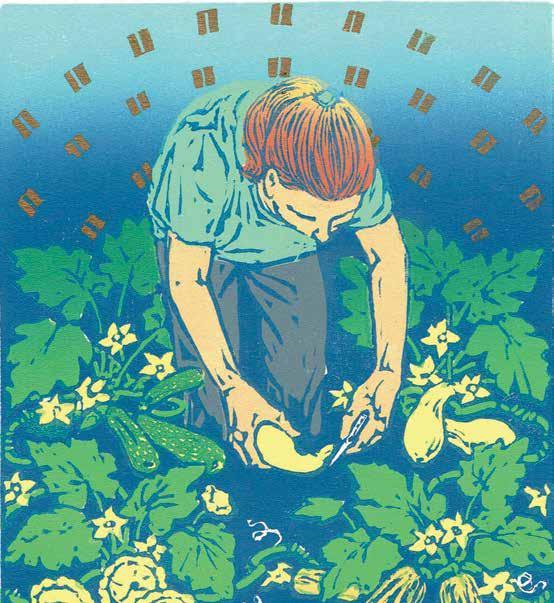
JULY
stories from & for the land 221
Pigments
Throughout the year, this alpine meadow in southeastern Vermont is the source of both my inspiration and my pigments. I make my own inks from this land, and through this act I am able to paint directly in concert with a cross-section of life on this mountain.
It starts in spring with the ink I make from stinging nettles. I walk through our feld, looking closely for the distinct toothed leaves borne opposite along the stems of the nettles. Both the stems and the leaves are covered in stinging trichomes, so I carry a pair of gloves and some plant clippers with me.
Te patch of nettles reappears each spring, somewhere to the right of the potting shed. I gather up a hearty handful, then fnd an old, enameled cast-iron cookpot in the basement to use for my inkmaking. I add just enough rainwater, with a splash of vinegar, to submerge the nettle leaves and simmer them. A distinctly herbal, non-culinary, smell flls the kitchen. I feel the exuberance of being somewhere between a witch and a scientist, flled with wonder at the transformation of plant matter to pigment.

Te colors that a plant presents to the human eye are glorious, but often, these are not the colors they will produce as inks. Terein lies the mystery. Nettle ink is a gorgeous purplish gray. Red rose-petal ink is a syrupy, purplish-brown. Pokeberry ink is an electric pink. Grape-leaf ink is a deep gray. Hopi red dye amaranth ink is a dusty fuchsia. Deep pink hibiscus-petal ink starts out fuchsia and turns to green as it dries.
•
July now, and I feel the damp grass through my sneakers as I move from house to barn studio, which was converted from a pen for our Nigerian dwarf goats, who are long gone now. Te goat pen/studio is on the south side of the barn, with two old windows facing out to the feld. Tere is a side door to the west, which still has the dilapidated goat ramp descending from its opening. One of my favorite herbs, anise hyssop, is poking up through the rotting boards. A six–by-four-foot piece of plywood sits on top of sawhorses for my table. A large, thick slab of glass over the plywood is where I paint.
I open the side door to invite in the breezes and keep myself in contact with the plants, insects, and birds while I paint. In fact, the inks, still alive with organic matter, often attract gnats. I perch on the stool in the doorway between brushstrokes or drying layers and watch. My feet are brushed by the barn cat, who loves the company; a moth futters past the doorway. I leave the spiderweb suspended above my table today. It helps keep the insects from investigating my aromatic wet inks.
I have not been out to the studio for a couple weeks, and many of my inks are moldy from a wet June. I scrape the mold of the tops of some of the inks and use others as they are. Just more organic matter to play with. One aspect I love about working in the barn with natural inks is that when I am done with the raw materials, I can just pour them out on the ground through the doorway. Tey will assimilate and be made into something new.
Before I start to paint, I scurry around collecting brushes, setting out paper, feeling out what palette of inks I want to use today. I take larger jars of ink, sometimes ones that still need the raw materials strained out, and pour a little bit into a small container with gum arabic, a binder. I make small batches of paint to work with for the day. Ten I settle into a quiet space and listen to the ink. Which
222 vermont almanac | volume 1 v july
one wants to go frst? How does it want to move on the page? Does it want to be applied with a big, bulky brush, a long calligraphy brush, or a short watercolor brush? Who is next? No thought, just response. No questioning, just moving.
•
September, when a rhythm returns and the light is golden: plum-colored asters, fre-orange maple leaves. Te feld is flled with goldenrod, milkweed, and tall, blooming mint.
It is only in the last 150 years or so that we have stopped using natural dyes on a large scale, especially in textiles. Te same is true of herbal medicine. Our intimate, entangled dance with nature has been present for most of human existence. Nature has provided necessities, interdependence, and spiritual ground to walk on. I do not reject modern practices by any means, but I do question their deep infuence on our feelings of being cast out of the garden. We yearn for belonging – to feel our wild selves. “Talk to the land,” I tell myself. It is our body, our atoms. We are inside the land, not outside peering in.
I don’t remember the exact day that the mountain became the symbol I would paint, but at some point, as I explored making inks from nature, they wanted to become a mountain.
I build my mountain paintings from the ground up, starting with the base. Te inks are watery and full of movement. Curving and climbing. Sometimes, the mountains look like bodily organs with smooth, solid colors. Sometimes, they bear rocky outcroppings, craggy and precarious. Sometimes, the mountains look like they will topple.
•In winter, my awareness of the ground is heightened. As the underbrush and kaleidoscopic colors disappear, the rock formations begin their song. It strikes me today, as I walk on the woods path, that I am most aware of mountains when I am pulled back from them, looking at them from afar. I forget that every day, I wake up on a mountain.
I do not want to stop making inks this winter, but my materials, with the season’s shift, must change. I read about how to fnd ochre, collecting small samples of soil and soft rock, on my walks, with a knife and a plastic container. I can fnd these pigments on the paths, within rock outcroppings, and along stream beds.
A new ritual is introduced to my art as I take a mortar and pestle down from the high kitchen shelf: the act of grinding and pounding the earth until it is gravel and then powder, the pulverized rubble then sifted through a fne strainer to remove chunks from the dry pigment.
A geologist described the creator of this part of the Americas as a wave of rock that took ten million years to break. Meeting my feet is matter folded together by volcanic activity: ocean mud and sand, limestone, fossils heated and ground away, sedimentary rafts on a foundation of granite. 420 million years ago, this land used to be where Brazil is now, and 200 million years ago, I could have walked to Morocco.
I live in a feld at 1,700 feet on top of a mountain in Vermont. Tis time of year, when the skies are clear, you can look out and see other peaks looking back. —Jessica Weitz
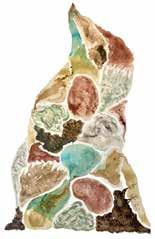
stories from & for the land 223
RTe Great Storm
Looking back, one of the interesting things about the epic July storm was how little fanfare there’d been in the lead up. When Tropical Storm Irene, the last comparable storm, hit in 2011, it had been leading newscasts for a week. Everyone who was paying even a little bit of attention knew it was coming, even if they didn’t know how bad it would be. But the Big July 2023 storm was stealthy. Maybe this impression was because hurricanes garner headlines while thunderstorms do not; maybe it was because the world has been drowning in extreme weather headlines and so we all got kind of numb to them; maybe it’s because we had been so inundated with rain for weeks that we’d tuned the weather out.
Te National Weather Service in Burlington issued press releases on July 9 warning of fash fooding that could be catastrophic. As warnings trickled onto the radio and phone apps that rainfall totals could reach 7 or more inches, a lot of us started asking, “Wait, how much did we get in Irene?” Some of us didn’t learn about the storm until the next day, when frothy brown masses of water began to jump river banks and inundate felds.
Why was the storm so bad? Part of the reason is that the rain fell on already saturated ground. Parts of Vermont had received between 4 and 8 inches of rain between the last week of June and the July 9 storm, which is 150-300 percent above normal.
Part of the reason was the storm moved slowly, stuck behind a blocking area of high pressure over Greenland. Tis was the same pattern that trapped smoke from the Canadian fres in early June. Te storms formed parallel to the front, approaching from the west, but a south wind oriented them south to
north. Storm cells trundled through slowly, one after another, like boxcars on a train. Tings were linear like a train, too, in that certain areas got storm after storm while towns just a few miles away were largely spared the worst of the rain, if not the food, as the water concentrated in the rivers and toured the state.
On July 11, the Otter Creek at Rutland crested at more than 10 feet above food stage; the Lamoille in Johnson at more than 9 feet above food stage; the Missisquoi in North Troy at more than 4 feet above food stage. And of course the Winooski in Montpelier crested at more than 6 feet above food stage, demolishing much of the downtown.
Another reason things were so bad is that when the storm hit there was an abnormal amount of moisture in the atmosphere – ofcially more than an inch above normal. Te moisture came from the tropical Atlantic Ocean, which was at record-breaking water temperatures – one buoy in the Florida Keys showed a reading of 101.1 degrees, which may have been the hottest ocean surface water recording ever. Warmer waters evaporate more moisture, which results in heavier rain. As the climate warms, that line will be cut and pasted into extreme weather stories and repeated again and again. Here’s another one: As air temperature increases, it can hold more water vapor. For every 1 degree C increase, 7 percent more water is carried in the same air volume. Te state department of health reports that annual precipitation in Vermont has increased by almost 7 inches over the past 50 years – that’s the physics of warmer water and warmer air borne out.
In all, between 5 and 9 inches of rain fell on much of Vermont. Some towns saw totals that qualifed as
We looked back at our weather summaries from the past three volumes of the Vermont Almanac and saw that July 2022 was an average year for temperature and precipitation, but was unusual in that it featured an abnormal amount of tornado activity. July 2021 was cool and wet; places south of Rutland experienced double-digit monthly rainfall totals on par with what we saw this year. July 2020 was drier and hotter than normal by a substantial 4.1 degrees.
224 vermont almanac | volume 1 v july WEATHER
500-year storm events – there’s a 0.2 percent chance of one of those occurring in any given year, and yet we’ve had two in the last 12 years. It’ll take years to quantify the damage, but the number will be in the many, many millions of dollars.
Te storm ofcially ended on the 11th – the sky was surreal that night, an otherworldly orange glow. But the wet pattern continued. Tis was such a big event that it was hard for people to shake of. A friend from Montpelier told us that her two-and-a-half-year-old started crying a few days after the food when it started raining again, worried about another food. Tat would be the case in some locations. On the 14th, Ripton got 3 42 inches of rain and a landslide destroyed one home and damaged 12 others. A farmer from the Connecticut River Valley who had largely dodged the main event a
week earlier wrote to tell us: “Our number came up Friday night, with 2 to 5 inches of rain in the neighborhood. Lots of standing water in our felds, fooding in the farmhouse basement, and millions of dollars in damage to roads in Hartland and Woodstock.” A sense of foreboding seemed to permeate everything – the feeling that everyone’s number was going to get pulled sooner or later, it was just a matter of when. Indeed, there was more to come in August.
When July was over, statewide precipitation for the month came in at 300 to 500 percent above average. Montpelier recorded 12 06 inches of rain for the month, obliterating its old record by 4 inches. Despite a noticeable lack of sun, it was the eighthhottest July on record, as well, with tropical-feeling humidity levels for much of the month.
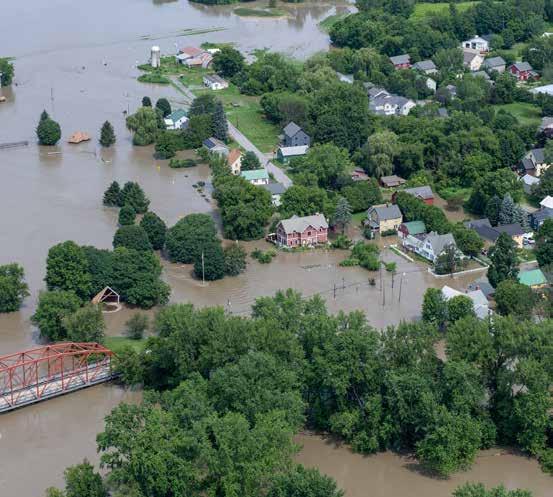
stories from & for the land 225
Senior Master Sgt. Michael Davis captured this photo of Richmond Village from a UH-72 Lakota helicopter during a mission to survey damage and search for stranded residents on July 11.
VERMONT NATIONAL GUARD
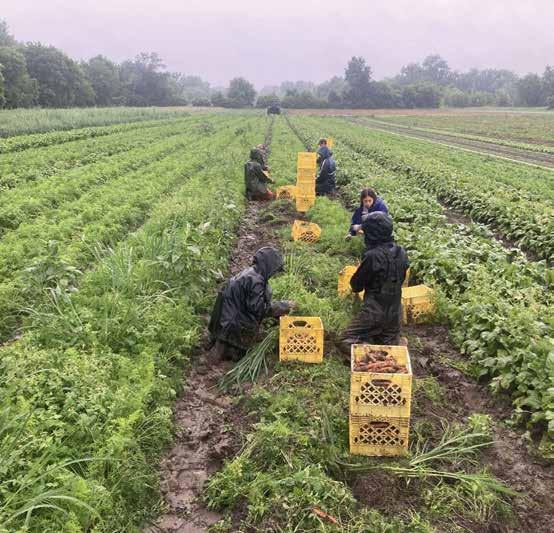
Te rush before the storm: volunteers harvest what they can in already wet conditions on July 10 at Intervale Community Farm.
An Agricultural Catastrophe
The writing was on the wall. Sensing what was coming, an urgent plea was put out on July 10 for volunteers to help harvest whatever produce could be harvested before food waters ruined everything. “Volunteers put on overalls and boots Monday morning and headed over to Intervale Community Farm for an emergency harvest as the Winooski River surged toward food stage,” reported Seven Days on July 10. “By early afternoon, muddy adults and children alike had flled crates upon crates
of beets and carrots. Andy Jones, the farm manager, said they already had plenty of volunteers. But all afternoon, cars kept coming.” Some 50 volunteers arrived to help the collection of farms that call the Intervale home; they harvested in conditions that were already muddy from the summer’s never-ending rains until 9 p.m. It was a community efort to save what could be saved.
Just as predicted, the waters kept rising. “By Tuesday morning, the mood at the Intervale was
226 vermont almanac | volume 1 v july
INTERVALE COMMUNITY FARM FACEBOOK
more somber,” Seven Days updated readers the following day. Rising water from the Winooski River was spreading from garden to garden, destroying crops and farmers’ livelihoods by the minute.
A similar scene played out at farms across the state. Te foodwaters wreaked havoc on every segment of ag: produce that fooded cannot, by federal law, be sold; corn and hay felds were fattened; berry farms were submerged; farms lost barns, coolers, equipment; access roads were washed away. Some diversifed farms experienced all of these. “Pretty much everything in this lower feld here is going to be unsalvageable. All of our corn from this feld, our blueberry plants, apples, pick your own fowers in this section, along with the pick your own herbs here, because it’s all been touched by this contaminated water,” said Kaity Mazza, farm manager at Paul Mazza’s farm in Essex Junction.
Smaller farms in smaller communities were hit just as hard. “ Te season is over for some people,” said Grace Oedel, executive director of the Northeast Organic Farming Association of Vermont, at the time. “And the season is drastically afected for many, many others.”
To help take stock of such widespread damage, the Vermont Agency of Agriculture surveyed the state’s farmers to fnd out just where the damage was most severe and to try to quantify the losses. Te results were tabulated on a running basis via an online “dashboard” – below was the status as of Oct. 2, 2023,
though the state cautioned that “ Te accuracy of this data should be considered incomplete as the Agency believes not all impacted individuals and businesses have yet reported.”
Te data collected were invaluable in terms of understanding the scope of the food damage and directing relief eforts, but the numbers alone can’t tell the story behind the heartbreak sufered at so many farms that saw weeks, months, years, decades of efort washed away in a single storm. Nor can they tell of the spirit that remained after the waters receded.
Just one example was seen at Foote Brook Farm in Johnson, which lost its barn, equipment, and 75 percent of its crops. “We’ve really been in survival mode,” co-owner Joie Lehouillier told Seven Days on August 23. “We have to concentrate on how we make it out of this season alive.” Neighboring farms stepped up, donating produce so that Foote Brook’s roadside farmstand, which was undamaged, could keep operating. With the local grocery store destroyed by the food, the farmstand saw its busiest summer of business in the farm’s 10-year history. And Angus and Holly Simpson, owners of West Farm down the road in Jefersonville, started a GoFundMe campaign that raised more than $60,000 for Foote Farm.
While the losses were substantially more than what was earned or donated, Lehouillier said the outpouring of support boosted her morale: “It makes me want to keep on going and be here for my community.”
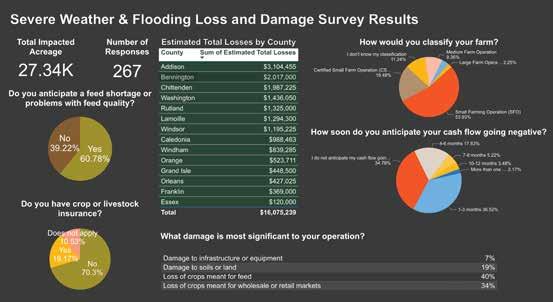
stories from & for the land 227 VERMONT AGENCY OF AGRICULTURE
THE RAIN LIFTED
Te rain lifted and the hazed stifing heat returned, the sky like a tunnel upended and in the wrong place the heat funneling through the whole umbrella of air the rivers swollen, drowning the felds, the streets, the dooryards, the basements, the Statehouse steps, the neighborhoods of washed-out cars, the closed roads, semi-tractor trailers caught in impossible intersections of county turns, teenagers roaring past unmufed and raging, the Winooski fuming over dams and spillways, plowing the buttresses of bridges, the young leaves of corn that in breezes just days before had nodded to me in conversation now lying pale in mud –Like the marsh hawk that sees all below, the water fnds and takes the State.
—Bill Drislane
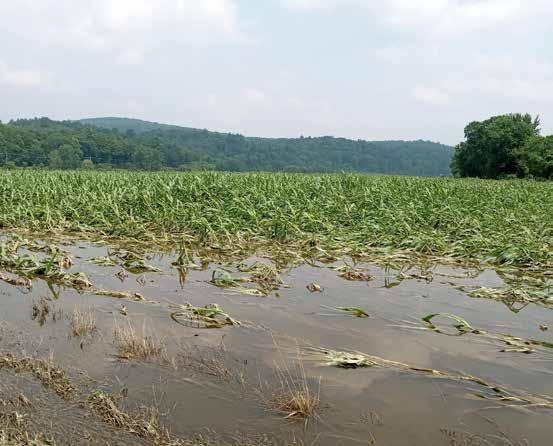
228 vermont almanac | volume 1 v july
MARY WHITCOMB
Flooded corn at North Williston Cattle Company.
Hitting the Town
As it did to so many other towns around the state, the “Great Flood of July 2023” blindsided Middlesex, where I serve as town clerk. Te July 10 and 11 rains washed out every key road in town, leaving 1,800 residents without access to emergency services, power, and other vital resources for more than a day and, in some places, longer. It was a hectic time, with lots of information coming in and out, but a few stories come to mind from those days.
Te Wrightsville Dam in Middlesex – built in 1935 by the Civilian Conservation Corps in response to the historic 1927 food – was in danger of being breached. While the dam did its job and Montpelier was saved from even worse devastation, water fooded our recreation area and backed up into basements.
Homes along Tree Mile Bridge, Rich, and Cross Roads were also severely afected. Tere, foodweary residents heeded warnings and evacuated only to return to destroyed properties. Lower Sunny Brook was particularly hard hit. Resident Brian Montgomery was forced to rescue his young children via three frightening kayak trips during the night, pitching the boat rides as “fun adventures.”
I-89 from Montpelier to Middlesex was closed due to a landslide and water on the highway. Because of this, an American Red Cross supply truck attempted to cut through town roads to deliver supplies to a shelter in Barre, only to be blocked by a family stuck in their car on Center Road. Both the supply truck driver and the family of four (and two cats) spent the night in the Middlesex Volunteer Fire Department.
But perhaps the scariest development was a pond on Zdon Road that was threatening to overfow its banks, potentially destroying life and property on Center and Brook Roads. Further complicating the situation was the impassable state of Zdon, where a culvert had broken through. Had our emergency management coordinator, Paula Otenti, not been checking up on neighbors, it’s likely no one would have been aware of the danger. Te road was quickly and temporarily repaired so earthwork vehicles could get to the pond. Matt Schley, a water-resources engineer who once lived in the area, returned to assist the property owner, thereby averting what could have been a massive disaster.
When it was all over, the Town of Middlesex
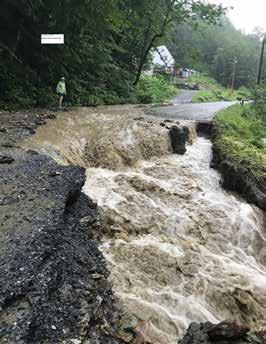
Mile after mile of roads around Middlesex were left impassable.
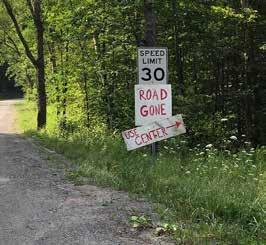
calculated close to $3 million in road damages and more than a dozen property owners in the food zone and foodways applied for federal buyouts of their homes, changing the nature of the town’s riverside forever. —Sarah Strohmeyer Merriman
stories from & for the land 229
JOHN DEMETER
One step beyond “Road Closed” on Brook Rd.

230 vermont almanac | volume 1 v july

Te view – from a kayak – of downtown Montpelier on July 11
stories from & for the land 231
BRYAN PFEIFFER
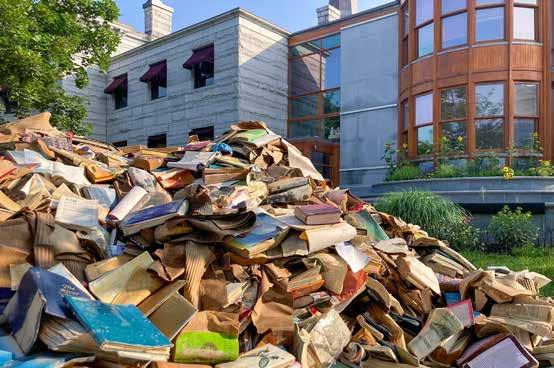
After the Flood
In the days before the terrible food ruined Montpelier, before it devastated our downtown businesses and neighborhoods, I had been visiting now and then with caterpillars living beside the river below my home in the city.
Orange and black and named Baltimore checkerspots, the spiky larvae had been eating and growing on the leaves of turtlehead, ash, and honeysuckle. Soon enough, I had hoped, each caterpillar would stop feeding, become a chrysalis, and undergo one of nature’s great makeovers to emerge as a butterfy fashing its colors on gossamer wings.
But on July 10 and 11 the rains came to Vermont, and the rivers rose to food the caterpillars’ leafy plant community – my downtown community as well. Little was spared. Te waters came for cafes and bars, banks and shops, city hall and the fre station, our two movie theaters and two drug stores, our hardware store and post ofce, and too many homes and apartments.
Te food also came for our literature. Montpelier’s public library and two bookshops were devastated.
At a time when independent booksellers can be, like wildlife and wild places, threatened or endangered, piles of soggy books were, apart from the human sufering, among the more poignant casualties of this disaster.
As soon as the waters withdrew, however, we Vermonters went to work. We mucked out mud from basements of shops and from the homes of families we’d never met. We hauled to the curb soggy belongings and lifetimes of memories. We donated cash from our savings so that businesses and families might recover and rebuild. In community meetings we spoke of resilience and preparations for the next food, which will surely come for more of us on this warming planet.
And yet in the months following the storm, parts of Montpelier remained construction zones. Walking past gutted storefronts on State and Main streets and crippled ofce buildings in the capital district, I feared for the future of my city, even as I recognize that despite our caution or intellect or brute force,
232 vermont almanac | volume 1 v july
Te aftermath at Kellogg-Hubbard Library.
PHOTOS BY BRYAN
PFEIFFER
despite our best-laid plans, none of us can wholly protect what we love and what is vulnerable. No one knows that better than a parent.
As a conservationist, I now know that a city can be vulnerable like a fower or a songbird. Despite my life’s work, I can never completely safeguard the most precious things in nature. Bulldozers will come for the forests. Floating bits of plastic will come for the whales. Fires and foods will come for the butterfies. And for us.
We move onward nonetheless. Although some of Montpelier’s businesses are gone for good and others struggled to return, my battered city nonetheless soon began its resurrection. Displaced merchants sold goods online and at our Saturday farmers’ market (temporarily relocated to higher ground). Shops and eateries began gradually reopening.
But in the weeks after the food nothing was more hopeful and afrming than the return of our independent bookstore, Bear Pond Books. Its reopening was more than a triumph over the brown water and mud and despair, more than a testament to the volunteers and donors who helped Bear Pond’s owners recover. It was a celebration of community, intelligence, and ideas expressed in the force of the written word.
I rode my bicycle to the reopening, where I met up with friends and colleagues. Tere among aisles of books, we talked of art and literature, the rare birds we saw this summer, and what we’d heard about the fate of other downtown businesses. It did not matter
that Bear Pond’s venerable creaky wooden foor was a casualty of the food. Our bookstore was back. I bought two books (including a hardcover copy of Barbara Kingsolver’s Demon Copperhead) and then pedaled toward home.
Along the way, I passed Kellogg-Hubbard Library, which had been heroically providing outdoor computer services and taking book reservations online or by telephone for curbside pickup beneath a big white tent. With the library reopening with a party on Oct. 7, and another book and board-game shop, Te Book Garden, on its way back, I pedaled onward with even more optimism for our capital city and for other fooded communities across Vermont.
I am by nature somewhat cautious about hope. I like to think that I’m neither naive nor defeatist about the human capacity to do better in the world: to be kinder to one another, to end wars and sufering, to avert nuclear annihilation or a more deadly pandemic or the worst of the climate crisis, and to better know and respect the natural world. When I tend to lose faith in humanity, when I become despondent about the world, I often fnd refuge in little things and prosaic moments in nature.
Especially among butterfies.
A few days after the foodwaters had receded from Montpelier, I wandered down to the river to check on the caterpillars. As I had feared, I found none remaining in the muddy vegetation. But as I turned for home, I noticed a splash of orange on the underside of a fern frond. Tese were not caterpillars, however – not anymore. At least two of the larvae had cheated death and accomplished their metamorphosis to become Baltimore checkerspot butterfies going about their business above Montpelier’s new high water mark.
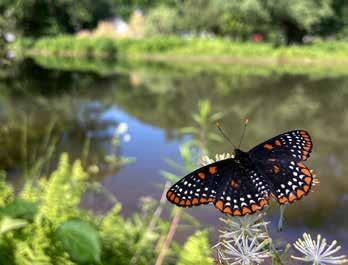
Hope is no mere aspiration that things will turn out well. Hope instead takes our hand, shines a light ahead, and pushes us onward into the messiness and uncertainties of life. Te checkerspots were doing just that. Like the return of our bookstore, these two butterfies were performing a gesture of hope for life persisting beside the river and in my city’s downtown.
Tey were mating. —Bryan Pfeifer Baltimore
stories from & for the land 233
checkerspot along the Winooski.
After more than a decade of planning and construction, with a few segments opening in recent years, the Lamoille Valley Rail Trail fully opened – all 93 miles of it, from Swanton to St. Johnsbury – on May 26, 2023. Just six weeks later, thanks to the July food, it was closed. Governor Phil Scott had planned to bike the entire trail on July 15, but extensive damage to the trail itself, as well as bridges, culverts, and other infrastructure along its path, put a halt to the trail’s frst season of full operation.
Te trail was built on a railbed that opened in 1877 to service the Portland & Ogdensburg Railroad, which connected those two cities (in Maine and New York) and continued operating under several rail companies until the Lamoille Valley Railroad closed in 1994 Te Vermont Association of Snow Travelers began leasing the railway in 1997 for winter use by its members, and in 2006, the Vermont Department of Transportation signed a lease to begin rehabilitating the rail corridor as a year-round trail. Te project began construction in 2013 and cost more than $30 million to complete. Businesses in towns along the trail were counting on revenue from the thousands of bikers, runners, sightseers, and outdoors afcionados who had eagerly looked forward to traversing the state.
In August 2023, 49 miles of the trail was reopened, and in September another 23 miles came back online, allowing users to travel from Swanton to Wolcott and from Walden to St. Johnsbury. As of press time, the 21mile section from Wolcott to Walden is expected to reopen in 2024.
O f the Rails
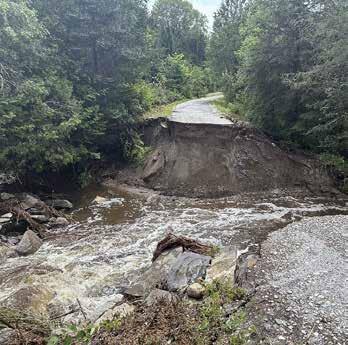
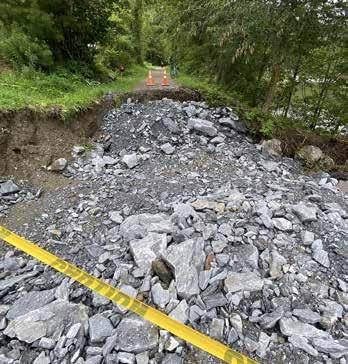
234 vermont almanac | volume 1 v july
BRAD
FERLAND SARAH PEASE
Tese were two of the many photos posted to the “Fans of the Lamoille Valley Rail Trail” Facebook page showing post-food destruction.
Weeping Willow
SHORT FICTION BY
JEFFREY LENT
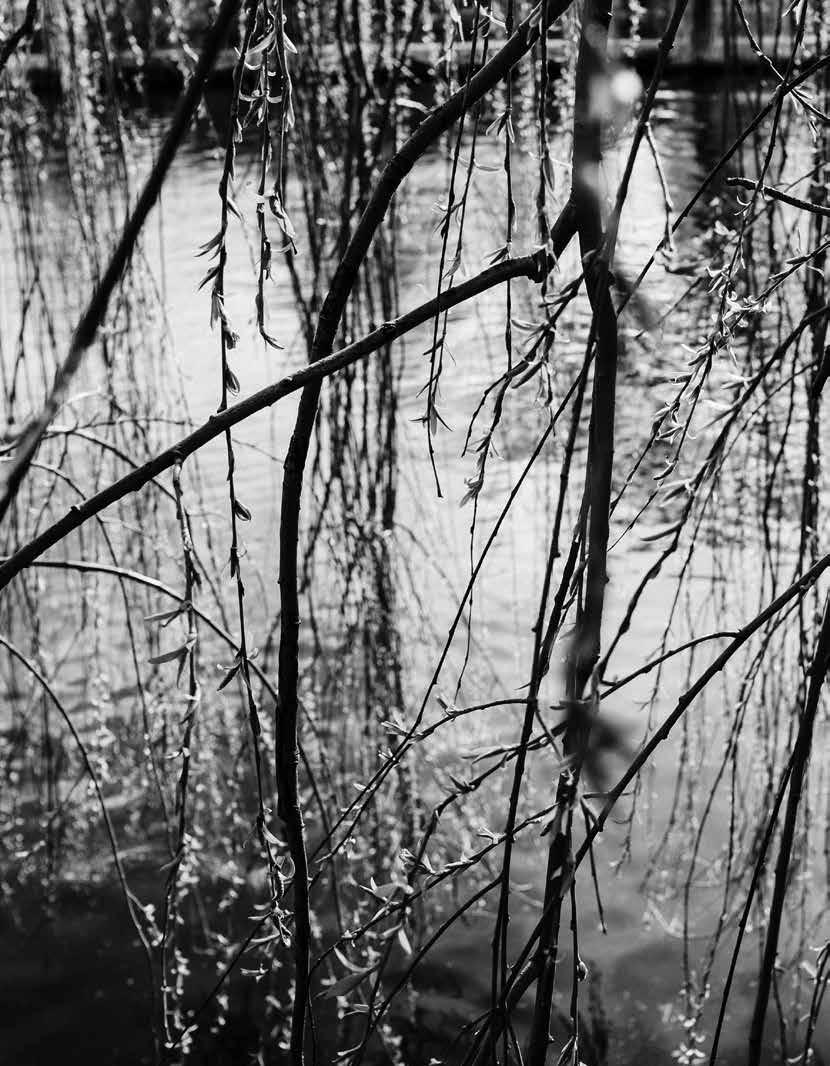
stories from & for the land 235
There was the roaring, the fickering pale streaming of the maddened brook. All twisting upon itself and gone and come again forevermore coming again. Tey were never safe in their beds and she knew it but the one least safe she’d not paid enough attention all the times she ought. Everett saw it behind every bush when all the while it was coiled up waiting within him. She’d taken the slicker of and dropped it behind her. She only knew where she was after running up against the sudden draped branch and near breaking right there and why she hadn’t. She called her Tough Nut, aloud sometimes but only just the two of them and more often in her head, without thought just there where she stood. Her squirrel. Her tough nut. How she came into the world, how she was conquering, coming up against it. She’d pull a chair anywhere to climb. Her hands white with milk from the bucket when there’d been milk, been a bucket. Fly of the roof after birds – Mam’s doing, that. Mellie slicked down now to puckered skin, hair like weeds, her struck waist and chest red clamors peeling up behind her eyes. Her wind a broken egg. Te long osier fngers draping down over her wet as rain, the dripping only not pelting. She folded to hands and knees, the mire a balm but cold and she could hear her teeth as she came up against the grooved roughshod of the willow, the bole drawing the closest rain in to run down and so made a small umbrella just above where she knelt. Long empty of prayers, she knelt with no prayers. Chattering bones of her mouth against her jawbone breaking up to her eyes and the tears of sky down over her. She straightened away from the tree still on her knees and lifted her face and hands and arms up even higher and let her mouth open, trying to empty herself once again, all anguish of the world a black hot magnet inside her.
Daylight coming then, night lessening, lifting away to fog, shrouded black willow fronds a curtain around her, the water channeled between the bank and far hillside grown vivid, a frothing dirty surface high toward where she crouched. Sky dulled charcoal a-glower close above. Rain driving slanted kicked up puddles all overfowing toward the brook. No stone where her eyes sought, set back beyond the old ones where the fence ended. Mam told her She’ll be watched over. Mossy bones, the most recent a half century gone, would instruct her how? Sodden cotton worn thin as if nothing at all where she crouched,
her belly pouched down toward her thighs as if dragging down to earth wanting entry. Her bare arms puckered, long welts gone purple down her forearms, fngerbones knotty and nails chewed back, stained with dirt, cobwebs, attic dust, bleeding raw through. Flat shoes split to ruins – from a time long passed to wear dancing and who was that person, where was that woman now – a bitter thing, some mockery of time once ignorant, more ignorant. Waking hours but what hours were not. Crude death heads on tall thin stones smoothed with orange and red lichen, thousands of rainings, once-upon snows – standing before the mirror looking empty back at her under a parchment spread of skin, eye sockets, bone. As if she’d missed something.
Te brook lipped up pouring urgent water over the land, flled with leaves and twigs, then sods and raw peeled jagged branches fipping and twisting and Mellie stood not sure her eyes saw what was before her as the land was tearing free and gone into the water and she began to back away as the ground beneath her feet heaved as if some great animal was burrowing up and the willow tree shook, then leaned clattering as a ball of dirt rose free, a mangled mess of tightly wound roots and soil and the tree caved toward the swollen brook and the crown submerged like a girl dousing her hair, like a girl the long fronds swarmed down the food away from the head of the tree. And the land buckled and split apart under her feet, upending her as the food and the tree pulled everything away from her, a canyon of wet dirt yawing open and some red coursed her nerves and she was ten feet back like a witch hopping a pebble. For a moment her mind was clear as winter ice. For a moment the world was gone strangely quiet, even her own wailing sucked shut.
Te hillside above the other bank of the brook came apart, a sliding heap of dirt and rocks and trees all akimbo, limbs and tops jostling one another then all collapsing into the water. A wave blew up thick and dirty and air washed over her laden with trash as the brook was raised up to a wide current and the water was sudden over her, washing up to her knees, sucking at the bottom of her nightgown and she felt the land giving beneath her feet. And heard rending earth as the bawl of some auger ox and she knew the point of land that held Hazel’s grave was sloughing of to the heedless carry of food. She pulled her gown high on her thighs and lifted a hand to push back her hair and streaked her face with water thick with dirt
236 vermont almanac | volume 1 v july
and turned back toward the cemetery. Te cresting water struck the backs of her knees and bowed her toward the water and she pushed back upright and got her feet solid.
Ahead of her the spire of the Washbourne stone rose grey upon grey and the Tabor tablet likewise was partway clear; otherwise the stones were small rounded charcoal ridges above the water. A bucket twirled between the graves and a barge of beech limb, copper leaves swirled down and hugged tight, caught against Laurent Washbourne’s stone and beyond this the land was torn and gone, the iron rods and bars of the fence twisted and mangled like the rails of ruined railroad tracks. Te small rounded knoll of land rose before her; shivered, then sheared away, vanished as if lifted from sight to some other place altogether. She pushed through between the stones, the rains fully sideways and the wind slashing her hair back and forth over her face. Something nudged against her shins and she pushed it of with a foot and went on. Ten she was out upon the wet grass, her feet slipping and her lungs wracked and she paused and bent, her hands on her knees, the rain drumming her back like fstfuls of small hammers. Te old brook channel was now a frothing wide course, ripping around the new bank of raw soil, crashing up over the boulders of ledge that once tumbled down toward the tender flaments of water. Te rocks rose jagged up against the raw face of granite ledge, twice the breadth of stone as yesterday, making a breakwater, a whirlpool clutched into itself, near separate from the food. And there, caught in a bird’s nest for some ancient water creature, twirling slowly and half submerged, was the narrow small cofn she’d know if her fnger brushed a corner in the darkest night.
In the spare hours before dawn of the day after Hazel died her uncle Cliford had driven in with the cofn laid on blankets in the back seat of his car. “I’d not have you put her in some gimcrack thing made by hands of a stranger,” he’d told everyone without looking at a soul but for the girl washed and laid out on a pair of boards, wearing her yellow summer dress with her hair brushed out down onto her shoulders. Fine-planed and sanded butternut, dove-tailed tightly and lined with a quilt Mellie recalled from childhood, the wood smooth and toned-soft as pulled molasses. Her brother in his shirt and tie, the jacket hanging from his shoulders like a cape. Mellie shaking when he came and put those hands once more upon her.
Mellie strode into the water bold as love, keen on the terrible capsized cargo and her legs were sucked out from under her and she was underwater, spinning then slapping up hard against debris, her mouth flled and eyes wide to the fractured light falling through the water and she reached and tugged hard upon the bleak shadow above her and came up spitting, gasping with her feet churning against the loose gravel below. Her arms wrapped tight, tugging the casket to her breast, turning, churning in place as the current pulled the small end of her burden, kicking mad as a hornet she broke free and came up onto land again. She went to her knees with the cofn before her and folded over it and lay so, her belly over her daughter and her face in the soil, the taste of water as wet rotting leaves in her mouth.
She lifted her hands to the edge and pinned her daughter’s cofn in place and raised up and sank back to her heels. She looked again upon the cist of her daughter, the box of her brother, the nest of Squirrel. Her mind could not hold what she saw so thought only of rocks and the tremendous spill of twisting and turning current. How close it came to being swept away and gone. How she was brought down in the rain to this place at just this moment, how she’d carried herself day after day, frst light and end of day, come down to kneel on the raw earth, the mound sloughed and marked by the rains, the burden held in the earth. And now unearthed and captured within some whirlpool to smash the box apart, tumble that body down into the food. Rescue of a sort.
She rose to her height and stood in the rain. She had never not carried her daughter’s weight. Not either of them and not the boy as well. She could carry any one of them right on down through time, carry them and she would. She bent then, to lift her up, to take her home one fnal time. Te box clutched against her breast, both arms wrapping it. She’d lift it to her shoulder if she could but could not, only hug her close. Some fnal time. Te box smeared with mud and the fne wood cut and carved by rocks and angry waters. She turned for high ground to make way out toward the feld, the orchard, the house and parlor and then thought better; carry it to the barn – set it on trestles to dry and be cleaned there. What new home to be found forever, she didn’t yet know. But she would.
Downstream metal smote metal, some rusted ruptured bell.
stories from & for the land 237
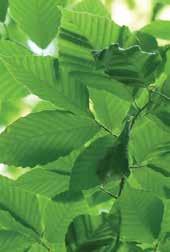
THIS SUMMER , I ’ VE BEEN KEEPING A CLOSE EYE out for the presence of beech leaf disease, frst discovered in Ohio in 2012 and now documented in all northeastern states except Vermont. Te disease, caused by a nematode, causes discoloration and disfgurement of leaves. Te most common early symptom is bands of dark, thickened green tissue running between some of the lateral veins of the leaves, especially visible when the leaves are backlit. Curled, crinkled, or otherwise disfgured leaves or unopened buds are also symptoms. Not much is known about beech leaf disease, but it appears to have the potential to seriously afect our beech population, which is already considerably stressed by beech bark disease. —Mike White
eRegeneration through Violence
Watching the raw power of the river water in the wake of the July 11 foods, it was impossible not to think of the fsh that live there. How, on earth, could a trout survive that? And some do perish, for sure. Jud Kratzer, a fsheries biologist with the Department of Fish and Wildlife, told us that the department expects numbers of small trout to be low in streams this fall and next spring. Smaller trout are weaker swimmers than big trout, so they are more easily displaced by foods. In streams with bad habitat, or where big machines went in and dredged, the recovery could take years, if it happens at all. “One of the big lessons we learned from Irene was that the recovery eforts were much worse for the fsh than the food was,” wrote Kratzer. In good habitats, though, trout populations should bounce back in two or three years. And foods can have positive long-term efects on rivers. Floodwaters scour stream bottoms and enhance spawning areas. As the downed trees and debris become incorporated into the stream channel, the surviving fsh will fock to the new structures. While it’s disheartening to consider the short-term mortality, a food of this magnitude is a great example of nature’s penchant for regeneration through violence.
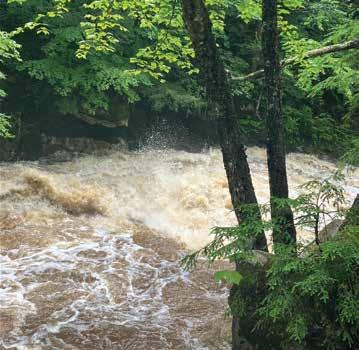
238 vermont almanac | volume 1 v july
NATURE NOTES
OHIO STATE UNIVERSITY
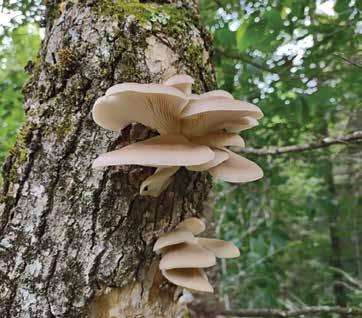
A Nerve Gas in a Lollipop
It’s been known for many years that oyster mushrooms – beautiful, tasty, and common – are able to kill and consume nematodes. Oyster mushrooms live on dead wood, a substrate that is very low in nitrogen, and they frst turned to nematodes for this nutrient hundreds of millions of years ago. Many fungi in the same genus kill nematodes and many nematode species are susceptible.
Tere may be a million nematode species – opinions vary – but all agree that they occur in abundance in every imaginable environment. Tough they are mostly harmless or benefcial, some cause serious illness in livestock and in people (trichinosis, for example). Because of this, the ability of oyster mushrooms to kill nematodes has piqued peoples’ interest.
Te toxin used by oyster mushrooms has recently been identifed, and unexpectedly, it turns out to be a common molecule, 3-octanone, a volatile ketone. It’s the method of delivery that is unusual. Te fungus creates microscopic globes on stalks called toxocysts. Tese hang from the hyphae, which are the rootlike tendrils of the fungus. Inside the globes, 3-octanone is accumulated at high concentration. When a nematode brushes by, the contents are released and the nematode is paralyzed and killed.
Te toxin has been described as a “nerve gas in a lollipop.” Because of its volatility, 3-octanone is not promising as a pesticide – it would just drift away. In addition, oyster mushrooms only bother to make these toxocysts when in a low-nitrogen environment – not a situation usually encountered in fertilized crops or the insides of sheep or cattle.
Whether they are behaving as carnivores or vegetarians, oyster mushrooms are delicious, and in Vermont they can be found from April to November. —Virginia Barlow
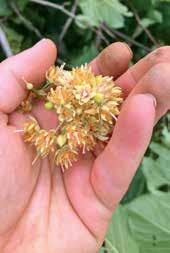
BASSWOODS GROW FLOWERS IN SUMMER TIME – this photo was taken on July 13 – which is much later than most trees. Te smell is powerful and wonderful and the fowers are often full of insects. You can hear the trees, as I’ve often said. Maybe too often.
—Virginia Barlow
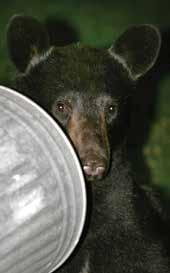
IT SEEMED LIKE THERE WERE BEARS on every patio and in every garbage can this summer.
stories from & for the land 239
MARY
HOLLAND
Golden Chanterelle
Mushrooms in a Pesto Cream Sauce with Chicken, Tomatoes, and Artichoke
Hearts over Fettuccine
It can be hard to generalize a season for a particular species of mushroom – they’re mysterious that way, popping up at times and in ways you’d least expect. But if pushed, we’d say that you can expect the frst fushes of chanterelles to appear around July 1 Te wet weather in June and early July 2023 had foragers anticipating a bumper crop, and in many places, this expectation was borne out.
We asked Ian Vair, a French-trained chef from Rutland, to share his recipe for chanterelles. Vair worked in restaurants around the country before returning to Vermont and building a business around his passion for wild mushrooms.
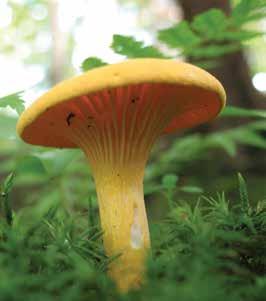

INDREDIENTS
2 ozs. fresh basil
2 ozs. fresh baby spinach
2 ozs. roasted walnuts
1 5 ozs. fresh garlic
¾ cup extra virgin olive oil
½ teaspoon black pepper
1 teaspoon kosher salt
¾ cup Parmesan cheese
8 ozs. fettuccine (cooked al dente)
1 tablespoon avocado oil
16 ozs. chicken breast (1-inch dice)
8 ozs. chanterelle mushrooms (sliced)
8 ozs. artichoke hearts (quartered)
8 ozs. tomatoes (1-inch dice)
2 ozs. heavy whipping cream
METHOD
Preheat oven to 375 degrees and roast walnuts for 10 minutes or until golden brown; let cool.
Chop garlic and lightly sweat on low heat; let cool. In a food processor, combine basil, spinach, walnuts, garlic, olive oil, salt, and pepper, then purée. Add cheese and process until paste-like.
Set pesto aside. In boiling water, cook pasta for twelve minutes or until al dente. Strain and set aside.
In a large sauté pan, cook chicken over medium heat with avocado oil until mostly done.
Add chanterelles and continue heating until chicken and mushrooms are fully cooked. Reduce heat to medium-low, add artichoke hearts and tomatoes, and cook another minute. Add cream and pesto; mix for a minute or two until fully incorporated and sauce-like. Mix in fettuccine and remove from heat. Let cool fve minutes, then serve and enjoy. —Chef Ian Vair
240 vermont almanac | volume 1 v july AT HOME •
Strawberry Renovation
So you planted your strawberries and nurtured them until they were established. Ten you enjoyed fat, luscious fruit in year two. Eager for a repeat in year three, you were let down by berries that were smaller and more difcult to pick. By the end of the season it became hard to even remember the commercial-quality strawberries you impressed your dinner guests with in year two.
It’s time to replant. But since you’re stubborn and frugal, we’ll go to plan B: As soon as the plants stop fruiting, reestablish order in your bed. Te optimum row width at full canopy is 12 or 14 inches, so start culling. If space allows, it’s best to cull the middle of the bed – the original plants – and create two new rows of the younger, more vigorous daughter and granddaughter plants. As you cull, weed.
Once you’ve imposed architectural order, cut the whole bed down to 3 inches in height and remove the leaf litter. Fertilize or add a thin layer of compost. Make sure the plants are watered as they regrow their foliage. Te plants’ fruiting buds form in the fall, so as long as you get on the renovation right after they stop producing in July, you should be all set.
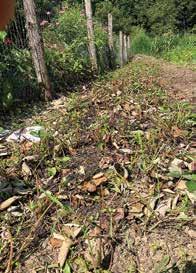
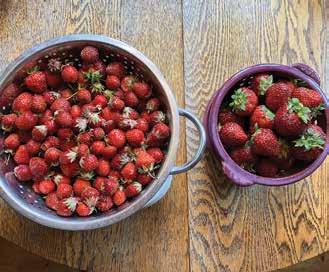
Left: Strawberry bed after its haircut. Right: Te small berries on the left were from three-year-old plants. Te big berries on the right were from two-year-old plants. Quite a diference.
ARTIST JIM SARDONIS was approached by an anonymous donor in March 2022 and asked to make a sculpture that honored health care workers. Te design he came up with, which serves as both a bench and a piece of art, was installed at the University of Vermont Hospital this summer, just of the main lobby. Te piece is titled: “Hearts and Hands – A Tribute to Health Care Workers.” Te bench is made of verde antique marble from a quarry in Rochester; the life-sized fgures on top are made of bronze. Te artist worked with foundries in West Rutland and Randolph to complete the work. At the dedication ceremony, Jim said he hopes, “that my sculpture communicates the love and compassion shown by healthcare workers every day.”

stories from & for the land 241
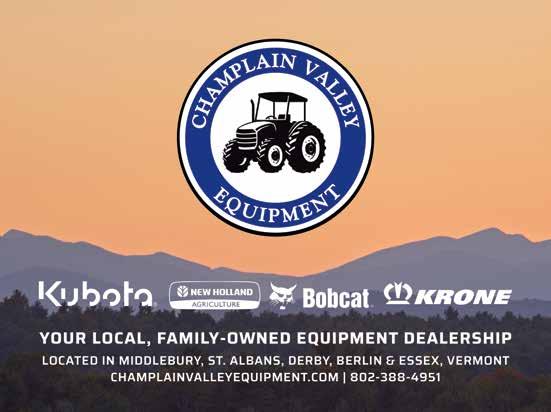
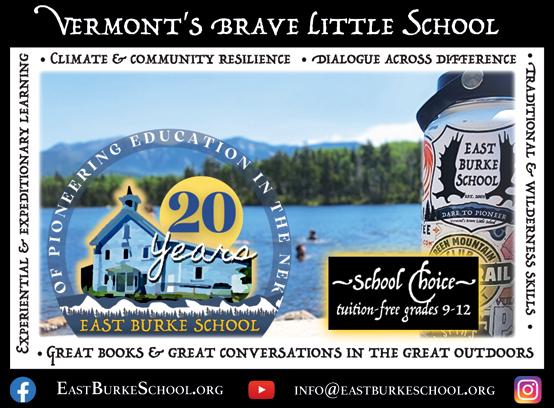
242 vermont almanac | volume 1 v sponsor

stories from & for the land 243 sponsor

AUGUST
stories from & for the land 245
Continuity
I’m blessed that in my corner of Vermont, I can literally step out our back door for a hike. I don’t cross even a maintained dirt road, let alone any pavement, for a long, long time, and I walk on without seeing any dwellings, either, or none beyond the ones I mentally resurrect from their ancient cellar holes. I like doing that.
Unfortunately, much has interfered with my ramblings in recent years. In 2016, a tick-borne horror called ehrlichiosis stuck me in the hospital – including time in the ICU – and made me feel sicker than I ever have in an expansive life. It took me almost a year to get my energy back. Two knee replacements followed in successive years. And then came the Covid pandemic, during which I seemed not to feel the usual hiking urge. I don’t know why.
Tese days my chief motive for staying out of the warm-weather woods derives from that enervating hospital stay. Although at my doctor’s suggestion I keep two tablets of doxycycline on hand in case one of the horrid creatures embeds itself in my fesh again, I’ve remained deathly afraid of ticks ever since that ordeal.
But the proverbial elephant in my autobiographical room, of course, is that I’m now 81 Tis means, for instance, that I’ll fnd myself looking for a stump-seat halfway up a ridge I used to charge up, and I’ll wonder what on earth the problem can be. I used to charge up here! Tere’s still an absurd interval before the light goes on: sure, you did that when you were 50, even 70 ... which you aren’t anymore. I fght to repress that awareness, but there it is.
I’m utterly undeserving of anyone’s pity, I concede, least of all my own. I look around at so many friends who are lapsing into semi-incoherent senility, others who’ve been pushed even farther by Alzheimer’s, and there’s that mounting number of men and women who can’t be seen at all. I’m a very lucky man: not only can I adore my life’s partner, our fve children, and all seven of our grandchildren, but I can also still bushwhack behind my bird dogs, if not with the same vigor; can paddle my canoe or kayak with some authority; can cast my fy rod. And, in however stately a way, I can hike.
Now for some, August is scarcely an ideal hiking month, especially now that with each passing year the climate gets soggier and hotter. On the other hand, those damned ticks are nowhere near as prevalent as they are in spring and early summer, and the vicious biting insects have pretty much gone too. At least at the month’s beginning, the daylight hours linger long enough for me to go out early or else deep into the day, when some cool is available, to ramble around.
Needless to say, there are times Robert Frost’s passage from “Birches” does apply:
…life is too much like a pathless wood
Where your face burns and tickles with the cobwebs Broken across it, and one eye is weeping From a twig’s having lashed across it open.
Te spiders do start getting hyperactive at this time of year, and the trees and shrubs are so laden with foliage as to obscure clear vision now and then. I can trip and fall over invisible deadfalls and holes, and sure enough, an unseen twig will occasionally stab me somewhere.
246 vermont almanac | volume 1 v august
But it is exactly the abundance of foliage that appeals to me. Under the unbroken canopy, I can feel – excuse the cliché – as if I’m back in the womb, protected and safe. Or I can all but imagine myself, despite the sweat, the abrasions, and the cobwebs, having been transported to some unearthly Eden.
Tis foolish delusion is temporary, as it should be. Everything is cyclical, and I know that in my very bones. Frost in the same poem immediately ponders such a matter:
I’d like to get away from earth awhile And then come back to it and begin over. May no fate willfully misunderstand me And half grant what I wish and snatch me away
Not to return. Earth’s the right place for love: I don’t know where it's likely to go better.
Just as the in-the-womb coziness appeals, so can delivery from it. It’s doubtless the imminence of fall and winter that starts me thinking that way. In any case, speaking for myself, that release enables me to celebrate the riches I possess, above all love, and more especially family love. Conscious as I become of their transience, I cherish all the crucial things even more deeply.
I have no notion what becomes of us after the Reaper does arrive, but every so often I get an odd little inkling of continuity, of everything’s starting over, just as what we have contrived to call a year or four seasons has always done. Here’s a bizarre example. For the better part of a decade, I couldn’t fnd my favorite pair of boots. Tey’re rugged enough, but they’re made of the lightest leather possible. I’m scarcely alone in such frustration; the thing we seek must be right at hand, but where? One day as last August waned, red maples in the wetlands beginning to show those heartbreak splashes of color, I found the boots in an unlikely closet, hidden behind boxes of my so-called papers. I let out a whoop, one loud enough to startle our three dogs. Ten I sat down on a porch bench and slid my feet in, rejoicing at how perfectly the boots ft. Merely to wear them was to yearn for a hike.
I hadn’t walked twenty feet, however, before I felt something uncomfortable under my right arch. I went back to the bench and removed the boot. A tiny acorn lay halfburied in the sole. It took a bit of efort to scrape it out, and when I did, rather than ficking it onto the grass, I unaccountably carried it between my thumb and forefnger out into the sunlight.
I took a quick and unexpected breath, in fact a gasp. As that gilded globe shimmered in the radiance, I refected that it had made its way into my boot almost ten years back; that it had waited patiently for my foot to return; that it therefore should prompt me to take certain matters up where I’d left them.
I won’t even try to sort out whether the tears occasioned by this small experience were ones of joy or melancholy, because they clearly involved both – and a whole lot more I’ll never quite understand. I made for the woods. —Sydney Lea
stories from & for the land 247
R
More
Rain
After July’s wet weather, there was nowhere to go but up. August cleared that low bar… but just barely. In Montpelier, 23 days of the month were rainy or cloudy, and only 8 featured sunny conditions. With all the clouds, things were on the cool side. Burlington’s average temperature was around 3 degrees below the 21st century average and about on par with the 20th century average. Te highest maximum temperature recorded in Burlington for the month was 83 degrees. With 4.9 inches of rain, Burlington was also 40 percent wetter than normal. Hardly ideal summer weather. In fact, meteorological summer (June through August) in 2023 was pretty much a wash-out. Te National Weather Service reported that it was the rainiest summer ever recorded, with more than 26
inches falling in towns ranging from Worcester in central Vermont to Peru in the southern part of the state.
In some cases, the continued rains in August were more than just gloomy. Addison County, which escaped the most extreme damage from statewide fooding in July, got pummeled by 5-plus inches of rain on the 3rd, which led to fash fooding in the Middlebury area. (Rutland streets were also inundated.) Te area was under the gun again at the end of the month, when a 1- to 2-inch storm fell on super-saturated soils and prompted a food warning. As of press time, FEMA had not yet determined whether they’d extend the July disaster declaration and provide funds to help cover the August damage.
In some places, farmers struggled with the longterm impacts of all the rain. In late August, Jericho
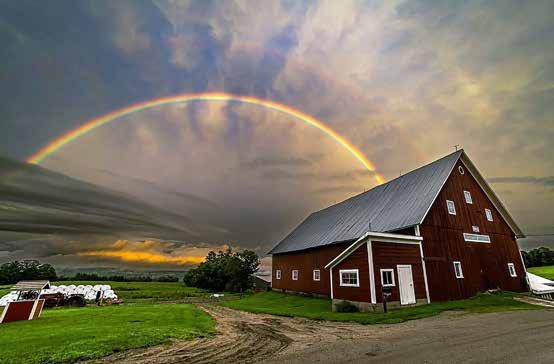
248 vermont almanac | volume 1 v august WEATHER
TIM KIRCHOFF
August’s weather in one photo: Tim Kirchof captured this image early in the month in Lyndonville.
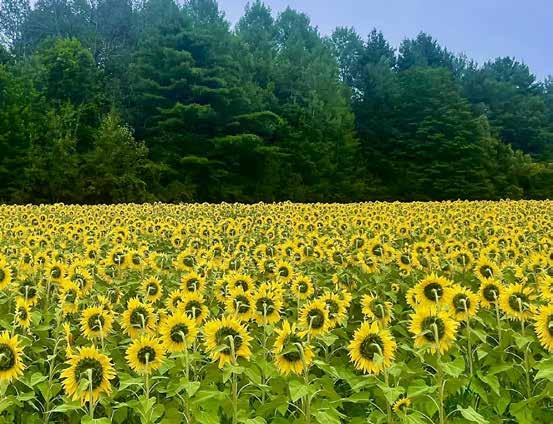
farmer Craig Lang told Vermont Public about how hard it was to simply fnd a window to hay. “We waited, and then waited, waited, waited. And then it just kept raining and raining and raining and raining…. And here we are in August, and we’re still struggling to get a frst cut of from this feld.”
Te shortage of hay, along with signifcant losses of corn due to the July fooding, led to concern about supplies of feed for livestock. “Right now, it’s kind of the number one issue I’m hearing,” Anson Tebbetts, secretary of the Vermont Agency of Agriculture, reported mid-month. “A lot of people are really concerned. Tey’re searching, they’re looking, and they’re nervous, and they want to secure that supply before snow comes.” To assist, the state created an online classifed ad-type forum to connect buyers and
sellers of hay, corn, and alfalfa.
For most of us, the rain was just a nuisance. We noticed that the weeds seemed to handle the cool, wet weather better than the fowers and vegetables that got planted in the garden. Tey fourished, the tomatoes not so much. Te dehumidifers in the basement were running overtime; lawn mowers plugged up and belched great gouts of overgrown grass when there was fnally a window to mow; beach days were few and far between.
Surely parts of the natural world benefted from all the moisture. Water tables that had been depleted by on-and-of drought conditions over the past few years were replenished. Te moss really popped on tree trunks in shaded areas of the forest, a profusion of green that turned the hard vertical columns soft.
We looked back at our weather summaries from the past three volumes of the Vermont Almanac and say that August 2022 was the fourth hottest August on record and abnormally dry. August 2021 was hot and humid. August 2020 was noteworthy for how dry it was, with large swaths of the state experiencing drought conditions.
stories from & for the land 249
Te skies weren’t clear, but the sunfowers were de fnitely shining from this feld in Glover on Aug. 25.
LISA
EL-DINARY
e Floodplain Forests
On a winter night in January, in a basementlevel auditorium adjacent to the Winooski, Montpelier threw a flm festival about living with rivers. Te evening featured kayaking documentaries, student proposals for riverside parks, and nonproft vignettes trumpeting the now wellknown lesson that rivers need “room to roam.”
In July, the river roamed right into the same building. It roamed into the cracks in the subfoor, into the
circuitry of the soundboard, and into the voids between walls. Later, even as the water below evaporated, the wetness roamed upstairs, hydrating third-foor ofce plants enough for mushrooms to sprout in the soil. Sometimes, the problem isn’t so much that rivers lack “room to roam.” It’s that they roam where they please, and often where we’d rather they not.
We’ve anchored ourselves and our delicate towns into the foodplains. But we’re not alone down here.

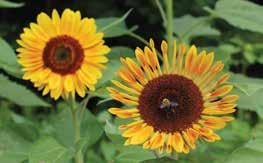
THE ODD TUBULAR PETALS of this sunfower are the result of a mutation that occurs when a “transposable element” (that term refers to a DNA sequence that can move around within a genome) lands in a sunfower’s HaCYC2c gene. If your next question is: how does DNA move around and randomly insert itself into genes? we’d point you to the fascinating and utterly bafing world of transposons, AKA “jumping genes.” You’ll want to pack lunch and bring a dictionary.
250 vermont almanac | volume 1 v august
NOTES
NATURE
T
e foodplain isn’t an empty space containing only a writhing river that annihilates what it touches. Tere’s a thriving relationship here between water, earth, and fora that yields one of the most spectacular ecosystems around. Floodplain forests don’t just tolerate their capricious rivers – they depend on them. And they have much to teach us about living with rivers.
For weeks each year, foodplain forests are underwater. Rivers inundate them deeply enough that you can canoe through without your paddle touching the bottom. During these turbulent weeks, the soil is starved of oxygen, the muddy water hides all sunlight from the fooded plant life, and the current brings wood and icebergs slicing into anything at the waterline. Roots loosen in the saturated soil, making trees vulnerable to tip-up from even mild winds. As the waters recede, anything on the forest foor is buried in inches or feet of sediment.
But those who fnd peace in a foodplain are rewarded with forever-fertile soil. Floodplain forests are among the most lush and enchanting places to explore. Undulating waves of waist-high annuals and ferns swathe the ground. Above, silver maples, ashes, and elms vault their branches into the canopy like fying buttresses in a cathedral.
Te magical feeling of these forests is the product of a suite of adaptations that allows the fora to thrive in disturbance. Carpets of annuals like nettle and jewelweed germinate, live, and senesce in the short period between spring and fall foods. Tese plants invest nothing into wood, extravagant leaves, or other sorts of expensive infrastructure that is susceptible to food damage. Sensitive ferns and ostrich ferns safely store their infrastructure underground in robust, perennial rhizomes from which their fronds grow annually. By contrast, there are few woody shrubs in foodplain forests. Shrub biomass consists mostly of

vulnerable skinny wood lying below the food line. Floodplain trees have other adaptations. Tey grow fast, enabled by the rich soils: cottonwoods and silver maples may be several feet in diameter yet less than a century old. Tey wager that they can gain height and girth quickly enough for their leaves and branches to escape the waterline and for the trunk to withstand damage. Loose, faky bark (as in silver maples) or spongy bark (elms) may provide armor against scouring debris. Tree bases grow stabilizing buttresses to protect against windthrow when saturated soils loosen the roots. Green ash trees grow secondary roots containing air pockets (aerenchyma) to guard against sufocation when their primary roots are underwater. In both ash and silver maple, pores along the stem (lenticels) are unusually large, which allows gas exchange throughout the whole tree, even when the roots are submerged. Silver maple seeds (unlike all other common maples) ripen in the spring – perfectly timed to disperse into the receding spring foods.
We have much to learn from our foodplain neighbors. As Vermont rebuilds, we can look to foodplain plants as our guides. Are our most food-prone businesses light on their feet like nimble annuals, with little overhead and portable inventory? Is expensive and immobile infrastructure protected on upper foors like a tree canopy, or vulnerable like a low shrub? If we’re putting down roots, are they buttressed against water and wind? Are our building systems equipped with physiological adaptations like those in trees?
Just as foodplain forests owe their magnifcence to their rivers, so too are our remarkable riverside towns defned by their proximity to water. Honoring and maintaining the identity and charm of these towns is a matter of embracing and adapting to our place within the foodplain community. —Sean Beckett
RED OAKS SEEMED PARTICULARLY HARD HIT by the mid-May freeze. Both the tender new leaves and any tree fowers that were on the branches got creamed, so it seemed a given to us that there would be no acorns come fall. Ten around August the acorns started dropping and littering the wood roads. What we’d forgotten was that acorns in the red oak family take 15 months to mature, so these nuts were already on the branches when the frost hit. But because of that hard 2023 frost, there might be a red oak acorn shortage in the autumn of 2024.
stories from & for the land 251
Getting to Cornmeal
It is light of digestion, and the English make a kind of Loblolly of it to eat with Milk, which they call Sampe; they beat it in a Morter, and sift the fower out of it; the remainder they call Hominey, which they put into a Pot of two or three Gallons, with Water, and boyl it upon a gentle Fire till it be like a Hasty Puden; they put of this into Milk, and so eat it.
—From the 1600’s-era book:
Two Voyages to New England by John Josselyn
Alove of polenta was the reason we began growing corn. Knowing only that it could not be made from sweet corn, we felt our way through the process and fnally reached the point where my partner Fritz and I could make cornmeal and create consistently delicious polenta.
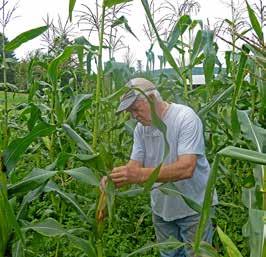
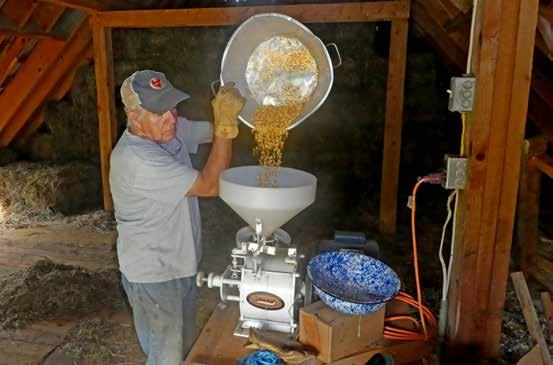
252 vermont almanac | volume 1 v august AT HOME •
Fritz Gross processes a batch of fresh Nothstine Dent cornmeal.
PHOTOS BY CHRIS DOYLE
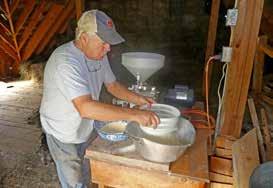
It starts with the corn. After some research and experimentation, we settled on growing Nothstine Dent (zea mays), a northern Michigan heirloom variety. Nothstine Dent is a versatile, high-yield corn that produces a favorful and beautiful cornmeal. Dent corn is the most common corn grown in America, but it’s not usually found in home gardens. Te kernels have a distinctive “dent” or depression on the crown, which gives the variety its name. Nothstine Dent produces seven- or eight-inch, medium-size ears with glossy yellow kernels with white caps. It does well in a variety of soil and weather conditions and generally takes 80 to 100 days to reach maturity. Remember, don’t grow more than one variety in your garden, as corn varieties readily cross with each other, and when that happens, you won’t get what you were hoping for. Te frst step in the process is growing the corn. Te next step is drying it. We leave the corn on the stalk in the feld to dry for as long as possible and hope for a dry, sunny September. It’s generally jacket and glove weather when we fnally harvest. Te next step, continued drying on the cob, is adapted to our circumstances. After removing the ears from the stalk, we strip back the husks and tie the ears in bunches of fve or six on both ends of a length of baling twine; the twine is then hung over the rafters in the workshop so the corn can continue drying. Tere are undoubtedly other ways to dry corn. Te challenge is to dry corn (while still on the cob) in such a way that mice, squirrels, and other corn-eating varmints cannot get to it. Te length of time required to completely dry the corn will vary depending on how dry the corn was when harvested, and the conditions during the drying process. We have always let it dry on the cob for at least a month after harvesting. If the corn is not completely dry before you go to the next step, you will not be able to grind it and it will not keep.
Te next step is removing the kernels from the cob – not as daunting a task as we frst imagined. Tere is a clever, old tool called a corn sheller designed for this specifc purpose. If you can’t fnd one, we have found that properly dried kernels can be easily twisted of the cob with our hands. Once of the cob, if the kernels are dry, they will keep for a long time in a tightly sealed container. We have never tested the limits, but at least two years out our kernels are fne.
We then mill the kernels into cornmeal using a Meadow Mills 8-inch stone burr mill powered by a 1-hp, 60-hertz motor. You can use a hand-cranked mill to grind corn. A quick internet search revealed a range of manual options. We grind corn as needed. Any extra is stored in a plastic bag in the freezer.
—Kerry DeWolfe
POLENTA
Once I had polenta made with freshly ground cornmeal, I realized that all the other cornmeal I had eaten in my life was stale. Here’s how we make it:
INGREDIENTS
One cup of cornmeal
Tree cups of water (or broth)
Optional additions: fnely chopped, lightly sautéed peppers or onions
METHOD
Bring the water to a boil. Gradually stir in the cornmeal. Continue to cook for about 3o minutes, stirring continuously, until the mixture is thick – really thick. In the last few minutes, stir in the sautéed onions or peppers. Ten, you can eat it as is with butter, cheese, or the sauce of your choice. Alternatively, you can pour the mixture into a buttered 9x13-inch baking dish, smooth out the top, cover with plastic wrap, and let it sit overnight (or for at least eight hours). Next, fip the polenta over onto a parchment covered baking sheet. Cut the slab of polenta into squares and separate the pieces on the sheet (so you will get crunchy edges). Bake at 425 degrees for about 30 minutes. After removing the squares from the oven, cover with sauce, cheese, or anything delicious. Polenta is a vehicle for culinary creativity. Starting the process from planting the seed gives us pleasure, and milling on demand produces the fresh favor we enjoy, but the reality is that polenta from store-bought cornmeal works just fne too.
stories from & for the land 253
A LOOK BACK
One of the People
It’s hard not to be entranced by the story of Calvin Coolidge taking his frst presidential oath of ofce. It happened in August 1923, 100 years ago this month. Coolidge had taken two weeks of from his job as vice president to come home and help his father bring in the hay. Just sit with that idea for a minute. You can imagine them moving methodically through felds with scythes, the rhythmic sound of the blade through the grass. Dog-day cicadas buzzing as the afternoon got hot. Te jangle of harnesses and the creak of wood and iron as the hay wagon trundled back and forth to the haymow. Tat night, as they slept, they were awakened by a Post Ofce messenger banging on the door – they had no phone. Tey let him in and learned that President Harding had died, and received a message from the attorney general advising that Coolidge take the oath of ofce immediately. Tey stood in the tiny farmhouse sitting room, by the woodstove, near a walnut desk and a marble table top where the family bible lay open. By the light of a kerosene lamp – they had no electricity – Coolidge’s father, who was a notary public, administered the oath. Tere was no press corps, no aides, no whirling helicopter blades. Tere would have been crickets –the sound of actual crickets – as Coolidge ended the oath with a solemn: “So help me God.”
Tis minimalist origin story is perfectly evocative of a proudly minimalist man and his intentionally minimalist presidency. Coolidge relished his nickname “Silent Cal,” noting that “the things I never say never get me into trouble.” He was aware that silence can be a form of authority: “Nine-tenths of a president’s callers want something they ought not to have; if you keep dead still they will run out in three or four minutes.” His governmental philosophy could be summed up in the following four lines, and note that these four lines comprised his entire inaugural address when he was re-elected as president of the Massachusetts state senate in 1914: “Conserve the frm foundations of our institutions. Do your work

with the spirit of a soldier in the public service. Be loyal to the Commonwealth and to yourselves. And be brief – above all things, be brief.”
One of the downsides of silence is that it allows others to defne you, and as a result, Coolidge’s legacy varies widely. He’s been portrayed as a simple stooge for big business, which is hard to jive with the good relationship he had with organized labor. He was a staunch Republican who frmly believed the federal government should play a minimal role in people’s lives – he loathed the social engineering of his successor, Herbert Hoover. But that’s not to say he thought the federal government should do nothing. In his political career he advocated for civil service, oil slick laws, expanded health care for veterans, women’s sufrage, prison reform, and the old-age pension system that would evolve into Social Security, to name a few of his causes. In his frst year as president he made 30 identifable requests to Congress, many of them progressive.
In some portrayals he’s a do-nothing slacker who famously took three months of to go fshing, which misses the idea that leaving Washington was likely the point. “He resisted Washington,” said biographer Amity Shlaes. “Washington was the city of yes.
254 vermont almanac | volume 1 v august
•
FORBES LIBRARY
Calvin Coolidge at work on the family farm in Plymouth Notch.
Coolidge was the King of no.” Tere was likely an element of tragedy in this resistance, too, as he lost his 16-year-old son, at the White House, while president. A great sadness seemed to consume the later years of his presidency, and he wrote of blaming himself for his son’s death. In reality, the distance that the press corp noted and snarkily attributed to disengagement or disinterest likely had an element of depression in it.
In some circles Coolidge is lionized as a fscal conservative, and he was, to the point that he micromanaged White House expenditures on pencils. Biographer Shlaes points out that when politicians today talk about cutting government spending, they really mean reducing the increase in spending. Coolidge actually cut. In every year of his presidency the economy grew and per capita income grew, and in every year of his presidency the budget number went down and debt was paid of Tere’s something to notice here as our current national debt exceeds $32 trillion.
But besides that, let’s notice Coolidge’s humility, which probably ought to be his defning legacy. As we steel ourselves to endure a whole year of presidential campaigning, let’s remember Coolidge’s quip that:
“It’s a great advantage to a President, and a major source of safety to the country, for him to know he’s not a great man.” In this era of intense political partisanship, where professional politicians hold on to power in cringeworthy and terrifying ways, let’s remember Coolidge’s deeply held conviction that politicians should serve then step away. After serving two years of Harding’s term, Coolidge won reelection easily. He could have run again. Historian Paul Johnson wrote: “Coolidge was never exactly popular – he lacked both personal charm and the slightest desire to develop winning ways – but he was hugely respected. Te Republican nomination was his for the asking and he would have had no difculty in carrying the country in 1928, probably with a greater plurality than Hoover did. He was only ffty-six. But as he told Associate Justice Harlan Stone, ‘It is a pretty good idea to get out while they still want you.’”
Coolidge died four years after leaving ofce. He’s buried in Plymouth Notch in the family plot in a humble grave with just a name and birth and death dates on it. “We draw our presidents from the people,” he said while in ofce. “I came from them, I wish to be one of them again.” —Dave Mance III
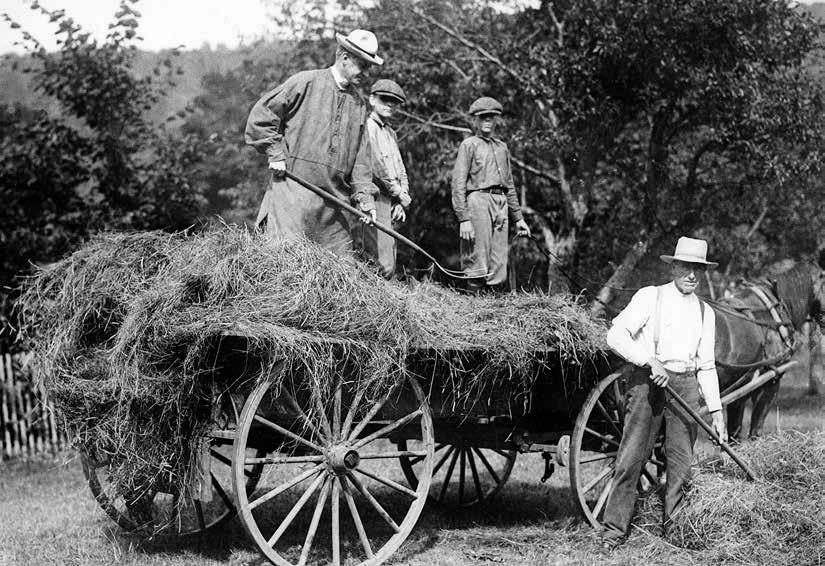
stories from & for the land 255
Calvin Coolidge, standing on wagon with his sons, helps his father bring in the hay.
FORBES LIBRARY
f King Corn
Editor’s Note: A key source of much of the information on corn history in this piece was the late Jack Lazor’s book “Te Organic Grain Grower,” published by Chelsea Green.
The conventional thinking among ethnobotanists is that all the corn you see today, whether it’s a brightly colored ornamental corn, or a tiny-kerneled popcorn, or sweet corn at the farmers market, or feld corn being blown from a combine into a grain wagon – all
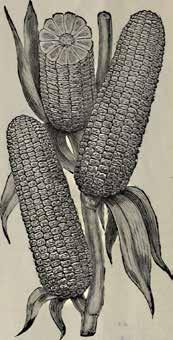
“Crosby’s Early Sugar Corn” as promoted in the 1900 seed catalog of Hopkins’ Northern Grown Seeds of Brattleboro: “ Te great merit of this sort is in its very fne quality, rivaling the Evergreen in sweetness and tenderness.”
of it all traces its lineage back to a wild grass called teosinte, which grows in the Balsas River Valley in southeastern Mexico. And as you might infer from the diversity in this lineage, it’s a plant that aims to please – morphing to adapt to a variety of conditions as humans selectively (and, more recently, genetically) breed it for certain traits. It wants to be domesticated – it needs humans to unwrap it and dry it and spread its seeds around the world.
Traditionally, corn was loosely organized into either fint or four types, each with a geographical preference. Te soft four corns need dry autumn weather, so they were commonly cultivated in the south and in the semi-arid plains. Te harder fint corns were more suited to the eastern US, and when the frst colonists arrived, they were introduced to hundreds of varieties by the Native Americans. (Tere were and are exceptions to both rules.) Dent corn, which is what some people today call feld or cow corn, is a more modern genetic combination of fints and fours, the result of 19th-century crossbreeding.
Te 20th century brought great advances in corn breeding and hybridization. When Calvin Coolidge was president in the 1920s, most of the corn in the
US was still open-pollinated –picture genetically diverse felds full of plants of diferent sizes. Each strand of silk in an ear of corn pollinates an individual kernel, and so open-pollinated ears are themselves diverse. Each year a farm family would pick the best of the crop and save it for the following year’s seed. By the 1940s, geneticists had made a science out of isolating desired traits in a given corn plant, and then backcrossing to produce uniform hybrid seed. Consistency increased, yields increased, favorable traits like stalk strength became a given, and felds started looking like what you see today, where each plant is identical to its neighbor. Farmers went from seed savers to seed buyers.
In the 1920s, American farmers were growing around 20 to 25 bushels of corn per acre. With the early hybrids, this went up to around 30 to 35 bushels an acre. After World War II, excess ammonium nitrate from the munitions industry found its way into farm felds in the form of nitrogen fertilizer, and average yields went up to 50 bushels an acre. Today, a conventional corn grower might average 175 bushels an acre; a state-of-the-art producer can top 400 bushels an acre. Tis is both astounding and
256 vermont almanac | volume 1 v august INDUSTRY
USDA NATIONAL AGRICULTURAL LIBRARY
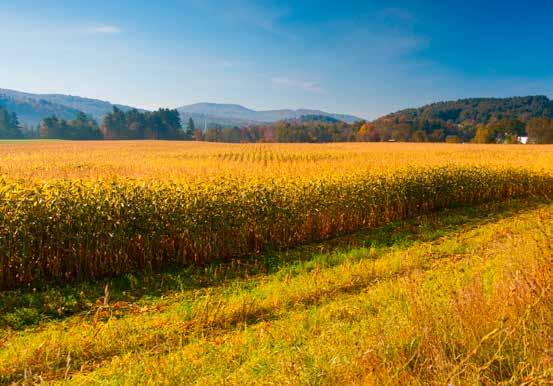
potentially unsettling – like the Icarus legend, the wax on our wings may be starting to melt.
A study in 2021 suggested that the corn belt – an area across a swatch of the midwestern US with arguably the best soil in the world – has burned through a third of its topsoil because of modern corn-growing practices. Adding synthetic nitrogen to soil – a typical general recommendation for corn is 200 pounds, per acre, per year – is like opening a damper on a fre. Te soil roars in response, and in the short term the plant benefts, but organic matter is burned up in the resulting microbial frenzy and the soil hardens. (Another use for ammonium nitrate in World War II was to compact jungle soil to create make-shift landing strips for airplanes.)
Ninety-something percent of
all the conventional corn in the US has been genetically modifed to some degree, and growing it requires annual pesticide and herbicide drenchings. Conventional corn has become something of a pariah – the dark joke amongst organic farmers is that the rotation is corn, corn, corn, corn, condos.
But if you get sucked into the doom and gloom vortex, you miss the reality that almost every farmer loves the land with frsthand intimacy, and they’ve been learning and fguring out ways to do better. Much of the 80,000 plus acres of corn being grown in Vermont are being managed according to best practices, which include a corn-then-hay rotation that allows the land to recover. Experiments are being done with interplanting, where corn rows are widened and then a nitrogen
Corn feld, Stowe
fxing crop, like clover, is grown with the corn. Some farmers are transitioning to no-till techniques which don’t disturb the soil; cover crops can be terminated with an implement called a roller-crimper and the corn direct-seeded into the crop residue. Modern soil and crop tissue sample testing allows farmers to fne-tune fertilizer inputs in a way that doesn’t overdo it; modern equipment allows them to apply what they do use with precision. Tunnel vision on the worst practices and you’ll miss myriad examples of the best. You might also miss the beauty of that golden stripe of corn as it leaves the combine, framed by the orange Vermont hills, the trucks on their way to the dairy barns that have for more than a century helped defne the state.
stories from & for the land 257
DON LANDWEHRLE
Our Corn Heritage: Northern Flints
Corn is a crop of the Americas – not something that European settlers brought with them. And fint corns were the frst types in the northern part of the US –it really was the earliest and most important corn here. Having said that, defning “fint corn” is pretty complicated. Northern fints are an umbrella for a number of diferent types of corn. Generally, fint corns have crescent-shaped kernels, fne stalks, long, thin leaves, and very weak roots. And traditionally they had very long and thin ears, usually located about mid-plant or below, so pretty low. Te ears usually have 8 to 10 rows of kernels. Tis is very diferent from what we see today in conventional corns; dent corns, for example, have up to 16 rows.
Under the umbrella of northern fints, there are the very hard starch types, which is what gives the corn its name. But in other varieties the starch is packed together more loosely, making it more of a four type. And there are sweet corn types – the sugars don’t completely convert to starch, so they’re wrinkled. And then there are the popcorn types, which have a very diferent type of hard starch. Te diference in genetics between these is very slight – just one gene changes. So it’s not as clear cut as saying: “ Tat’s a fint corn.”
At UVM Extension, we’ve grown all the diferent types of northern fint corns in our trials. What we see is that there’s a change in northern fint corns from east to west. Tere’s thought to be two diferent “races” – the northeastern fints that grew here and then the northern fints of the Great Plains. Tese are mostly local adaptations to conditions.
Tere’s still an appreciation for northern fints, especially in food circles. Te four corns, for example, are very popular for making tortillas and chips. Heirloom varieties are still being grown for specialty markets – for example, here in Vermont we have tortilla-makers, like All Souls Tortilleria in Burlington, that are interested in older varieties because they tend to have really good favor. A variety of northern fint seeds is available commercially that some people like to grow in their gardens. And, of
course, our indigenous communities are still growing northern fints.
Tere are two challenges when it comes to preserving northern fints. For starters, corn can be a land-intensive crop – it’s not something you can grow in a small greenhouse – so this is a limiting factor. Te changing climate also presents a risk, as our traditional native fints are adapted to a 20th-century climate. Part of what we’re doing collectively with other researchers and growers across the northern tier of the US is evaluating northern fints so we can breed and select northern fint corn that’s better adapted to a changing climate. —Heather Darby
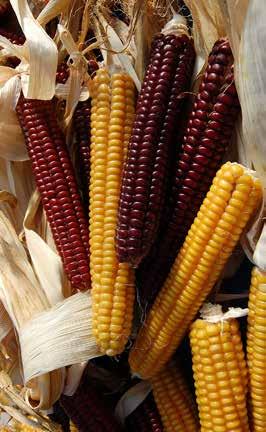
Roy’s Calais fint corn – a historic variety grown by the Abenaki people of the Northeast and Quebec that’s used for milling and as an ornamental.
258 vermont almanac | volume 1 v august f
HIGH MOWING ORGANIC SEEDS
Understanding Silage
By 1850, corn was the second most common grain produced on Vermont farms, with more than two million bushels grown annually. Only oats for horses edged it out in production. Corn was harvested when the kernels were dry, then husked by hand and stored in specially designed corn cribs raised on posts to keep rodents out — the Rokeby Museum in Ferrisburgh has one.
In the 19th century, Germans started experimenting with fermenting chopped green plants using the same process used for sauerkraut. Te still-green plants were chopped, compacted to exclude air, and left to ferment for several weeks. Te silage was so acidic that it preserved itself for months with little spoilage. New England farmers took note of these experiments and started making corn silage in the late 1800s. It had a dramatic impact, particularly on dairy farming. Silage was more digestible and palatable than kernel corn for cows and feeding the whole plant and not just the kernels provided much more food value per acre of corn. Te higher quality feed could also be available all winter, signifcantly boosting milk production year-round.
As local farmers continued to experiment, silage storage methods evolved. At frst, a few adventuresome farmers built underground pit silos. When it proved too hard to lift the silage out, they tried above-ground wooden silo rooms built in a barn corner or separate structures
outside the barns. Unfortunately, the silage in the corners of these square spaces spoiled. By the early 20th century, farmers tried eightsided (or more), some of which can still be seen today.
As the average farm herd increased tenfold from the late 1800s to the late 1900s, the need for silage increased. Concrete became cheaper and farmers began building round concrete silos, still considered the classic by many. But the most modern silos are the large blue metal Harvestores that are virtually airtight and better preserve silage.
In recent years, many Vermont dairy farmers have moved away from using upright silos and instead use three-sided concrete bunkers. Silage is loaded in the bunkers, compacted by driving heavy equipment over it, and covered with plastic sheets weighed with tires to ferment. Tis year, Vermont farmers grew around 80,000 acres of corn at 19 tons per acre. Much of it was stored in silage bunkers.
—Jane Dorney
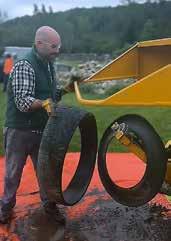
In 2023, the Vermont Agency of Agriculture purchased this Super Slicer sidewall cutter; the goal of the program is to both aid in tire recycling and also to provide tire sidewalls to farms for use on silage piles. Te sidewalls are easier to handle than whole tires and don’t hold water, which can create a breeding ground for mosquitoes.
Ever drive by a farm and wonder about those large mounds covered by plastic and weighted down with tires? Tat’s silage being stored.
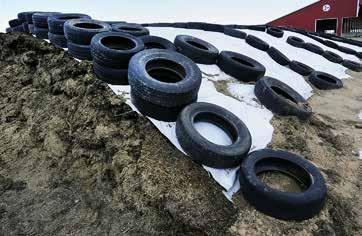
stories from & for the land 259
LIBRARY OF CONGRESS VERMONT AGENCY OF AGRICULTURE
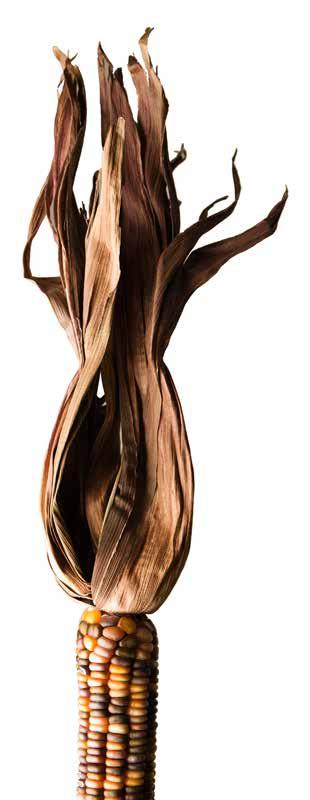
Te Corn Mother
It’s easy when talking about various varieties of corn, and their growing characteristics and fertility needs and yields, to lose track of the sacred value of corn to the Native American people who gave this crop to the world.
We asked Don Stevens, Chief of the Nulhegan Band of the Coosuk –Abenaki Nation, about the importance of corn in Abenaki life and culture. True to the oral storytelling traditions of the Abenaki, he told us this story of “ Te Corn Mother.”
At some point in our history, as Abenaki people kept populating the earth, resources became harder and harder to fnd. A lot of people were going hungry. One day, one of our Abenaki mothers was hearing her kids cry, basically from hunger. She didn’t know what to do. So she went to the Creator and asked for a gift of food to sustain her children. And the Creator said, “Well, such a valuable gift requires a great gift in return.” Because, you see, in our culture, in order to get something, you have to give something – so that everything’s in balance.
She didn’t know really what to do; she was poor and didn’t have a lot. So she went back and thought about it, and kept hearing her kids cry from hunger. Like most mothers, she had such a love for her children that she went back to the Creator and said, “I’m willing to give my life so my kids may live.” Life is the most precious thing I have of mine to give. Te Creator spoke to the husband about her decision and he reluctantly agreed to support his wife’s decision. After all, she is the carrier of life, and death is only a transition from the physical form into spirit. Before that gift was given, she summoned her other two sisters from nearby villages to help her husband take care of the children once she was gone. Once all her afairs were in order, the mother gave her life over
260 vermont almanac | volume 1 v august
to the spirits and her body was buried in a mound. And then, of course, her husband was distraught and saddened. He would bring fsh to her burial site to eat with her because it was her favorite food, and he often wept over her. After several days of this routine, the story tells us that from her burial mound, two plants emerged. One was corn and the other tobacco.
Te promise commitment of the corn: As her stalks began to grow, you would see her ears and hair form. When her hair turned black, it was time to harvest because the promise of food was fulflled. Tis was a sign to her children that they would be able to eat from now until the end of time. Once harvested, the corn husks would be made into dolls to remind them of their mother until the next harvest, when the process would be repeated.
Te other plant that grew out of the mound was tobacco. Te mother never wanted her children to ever be without a gift to give for a prayer or request. If they ever needed something from the spirits or the Creator, they would always have something to give – again, in order to get something, you have to give something. When we smoke tobacco before discussions, it is to ensure that the people who know this story will be telling the truth. No traditional native person would willfully desecrate that sacrifce by speaking untruth after they had smoked the pipe with each other.
Te Corn Mother’s sacrifce was to always make sure we had enough corn to eat and enough tobacco for prayers. Her children had children, and then they had children, and they had children. And now corn is the most prevalent thing in the world – it’s used for food for humans, for animal feed, and other purposes that it wasn’t intended for, like ethanol. However, the prophecy continues to be fulflled, that we would always have enough corn to feed our children.
Te two sisters who came to watch over Te Corn Mother’s children became part of the “ Tree Sisters” story. When each sister eventually passed away, they wanted to be with their eldest sister again and help to continue her legacy of feeding the children. Te one sister became beans and would hug her again by growing up her stalk. Te last sister was always trying to protect her other sisters from being eaten
by rodents, so when she transitioned she became squash, surrounding her two siblings with picky vines to deter critters from approaching. Now you know a little about how “three sisters gardens” came to be and why they are planted together in a mound. Each has their special gift to contribute to each other as family. But, overall, corn is the most important one in our tradition because she made the agreement with the Creator.
What became of the husband and children, do you ask? Well, that is another part of the story and involves the osprey and other birds of prey…. We have various songs and dances based around corn and the growing cycle. I would seek out the native community and attend their harvest festivals to learn more.
I think corn can help teach another lesson, in responsibility. When I talk to our kids at a lecture or an event, I’ll take a piece of corn and put it in their hand. And I’ll ask them, “Well, what do you see?”
Tey’ll say, “a kernel” or “food.” Yes, that’s all correct, but it’s superfcial. When Abenaki look at a piece of corn (based on our traditional stories), the Creator had to give our Corn Mother the initial seeds to be able to feed our people throughout time. When that corn was frst harvested, there was a fnite amount – that corn had to be not only eaten, but it had to be protected and stored so it could be planted the following year. Our ancestors had to keep the critters away from it, and take care of it. Tis routine had to happen every year for as long as that person lived, and then the next generation had to do the same throughout time for thousands of years.
I tell the kids, “ Te seed that’s in your hand has been touched by thousands of your ancestors, who have cared for that. If any one of them would have thrown it away, you wouldn’t have it in your hand and be able to grow it. So not only are you touching thousands of ancestors who cared for it, but also life and creation itself, and the gift of the Creator, to our people to always be able to eat.”
My question to them is, “What are you going to do with that seed? Are you going to throw it away and break that chain of custody or are you going to grow it?” Tink of that awesome responsibility. —Chief Don Stevens
stories from & for the land 261

opening the field
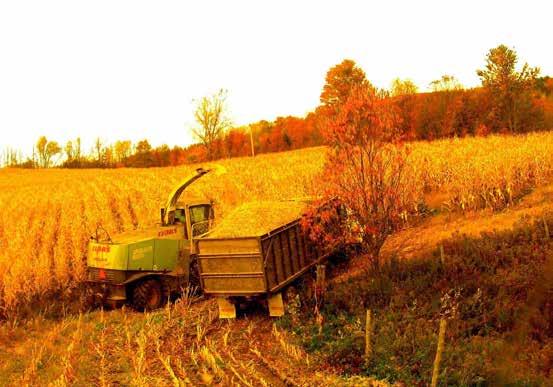
tooley threads the needle
262 vermont almanac | volume 1 v august
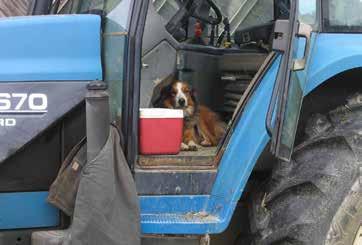
short’s dog
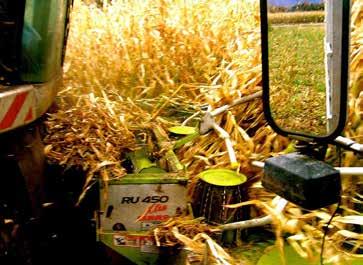
chopping as seen by the trucker
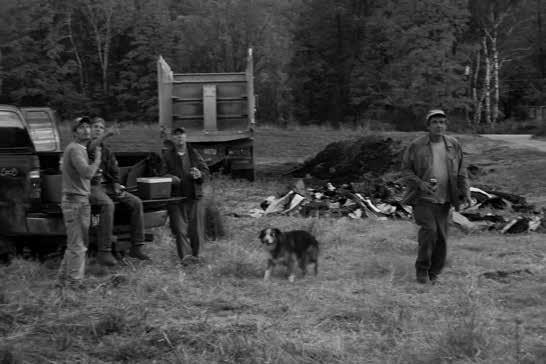
Corn King
There’s a romance to the autumn corn harvest practiced by dairy farm families across Vermont. Our friend Brian Leach shared these photos with us of a 2013 harvest he undertook with Dave Tooley, the undisputed “Corn King” of the Mettawee Valley. “Nobody knows growing corn at scale in this region better than Dave,” Leach wrote. Dave Tooley recently retired, but these images nicely capture a special moment in time.
beers at day’s end”hey, geese!”
stories from & for the land 263

264 vermont almanac | volume 1 v sponsor

stories from & for the land 265 sponsor

SEPTEMBER
stories from & for the land 267
Dear Day in Late September
I am not sure how you will receive this, but I am sure of my need for momentum and a kind of seasonal loneliness, which I blame on you, thus this letter. Anyway, on my mind are the increase of dark and the rows of vegetables out back that have become an embarrassment of weeds. While you are a day in late September, and a day with high humidity and raindrops sitting and not drying or freezing on almost everything, you are also a day with a morning like early June, but with a thinner sun. You are a day with dahlias and dahlias and geraniums, and myrtle underfoot. You were a morning fat with bees and you are all day long a river. Tere is not much else, but I think I am coming to know you. Earlier, I wanted to call you a liar. My windows are open, and the air is lovely and I fear this is a cruel trick. My jackets stand ready. In any case (forgive my impertinence!), I ask for the usual, freedom, still, from sadness. And since there is an increase of darkness, and also this great momentum, I want to tell you I am thinking about closing up shop for the winter. I am settling my accounts. Enclosed, please fnd a brace of birds, which I hope you will accept as payment against last winter’s oil bills. Tere is much to do. Up in the barn, I have spelled out the name of the man I love with crabapples. It is one way to know a man’s heart. I believe in his name, though, like I believe in good gloves. Oh, how we fght the cold with everything we have. Tere are more words here for cold than for snow. Is it cold enough for you? we ask, but words freeze so quickly when it is two clapboards below zero, September. Sometimes it is so cold we just say, Christ! Te weather is coming. Te ducks just few north up the river – just now. I will go now. I am not sure how many animals I can feed through the winter, and there is reckoning to be done. My ledger says things I am afraid to share, even with you. I work on closing up the house. My empty windows should be flled with poems against winter before the day is through.
—Kerrin McCadden
Tis poem frst appeared in Landscape with Plywood Silhouettes.
268 vermont almanac | volume 1 v september
ROn Resilience
The best thing that can be said about September’s weather is that there isn’t much to say. For the frst time in many months, things were relatively benign. A short heat wave during the frst week of the month sent temperatures soaring above 90 degrees. Predictably, a spell of rainy weather followed, but nothing extreme. And the last week of September featured perhaps the nicest stretch of weather of the entire year, with temperatures ranging from the upper 60s to upper 70s, low humidity, and sunny skies. More than one meteorologist commented that this was our reward for enduring a rough weather year.
Tis rough weather year was way bigger than Vermont. More than one pundit also suggested that this was the year that climate change became tangible for people. As of mid-September, the US had experienced 23 separate billion-dollar weather disasters, a record –and there’s still three months left to go.
Te news cycle was a steady stream of crazy weather stories. Atmospheric rivers of precipitation inundated drought-stricken California last winter (parts of the Sierras saw 700 inches of snow) and a 100-square-mile ancient lake, which had been drained for agriculture, came back from the dead in spring. According to Scientifc American, the average American inhaled more wildfre smoke in the frst eight months of this year than during any recent full year. As of press time, Phoenix had hit 110 degrees on 55 days in 2023; a 31-consecutive-day streak of this heat beat the old record by 13 days. Te Maui fre, record 16-foot storm surges in Florida, the extreme weather news just went on and on.
Of course there have always been weather disasters, and of course our 24-hour news cycle bombards us with them, making them inescapable. It’s true that when we marinate in this it can skew our perspective. But none of that takes away from the raw math. As we’ve laid out in the pages of this book, our monthly averages in temperature and
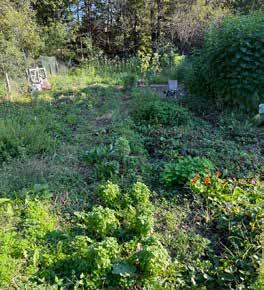
precipitation difer substantially from the averages in the 20th century. And the constant whiplash between extremes is not like the weather those of us who grew up here experienced growing up.
We’re living a new normal now, and there’s a mental toll to this beyond the fnancial toll. We were talking to a farmer in the Upper Valley this summer about the weather, and he said that he used to coach cross-country skiing, but gave it up because constantly worrying about a lack of snow, and improvising to accommodate a lack of snow, began to take all the fun out of it. He said the same thing was starting to happen with his farming. Te lack of consistency and related worry was just killing all the joy. It’s hard to quantify that, but most Vermonters will probably have some sense of what he means. Tere’s all this talk about how to make things more resilient in the face of a changing climate; we’re going to all have to work on our mental resilience, too.
stories from & for the land 269 WEATHER
Late September 2023 –we fnally got some sustained sunny, dry weather.
MARJORIE RYERSON
NATURE NOTES e
Trichomes
Female cannabis fowers have a silvery, speckled surface that makes them look as though they have been well and truly frosted. But it’s not frost, it’s the abundance of trichomes that produces this striking efect.
Trichomes, which are modifed hairs, occur on many plants, but are impressively obvious on female cannabis fowers. Each cannabis trichome has a stalk and a glandular round head which is where cannabinoids are manufactured – along with an array of other metabolites. Male cannabis plants have trichomes too, as do the leaves on both sexes, but they are scarce and not nearly so visible as they are on the female fowers.
It’s within the trichomes that tetrahydrocannabinolic acid (THCA), cannabidiolic acid (CBDA), plus terpenes are manufactured. THC, which is psychoactive, and CBD, which has therapeutic efects, are produced as these acids naturally degrade. Fresh fowers don’t have a lot of THC or CBD but their concentration increases during harvest and post-harvest treatment.
Most people have a passing knowledge of the benefts of THC and CBD to us humans, but what is the value for the plant?
Cannabis fowers in the upper reaches of a plant and fowers in the tropics have more THC than

shaded fowers or those growing in temperate regions, suggesting that it protects the fowers from ultraviolet light. It’s being checked out as a possible sunscreen additive. THC also deters insects and has antimicrobial properties. Curiously, THCA is toxic to the plant’s cells, but keeping it walled of in the glandular head of the trichome in which it was manufactured prevents any cell damage.
Terpenes are aromatic oils that give cannabis its aroma and favor, and they are also produced in trichomes. Te ones in cannabis are used to reduce infammation,
anxiety, and depression in people. Insects are put of by the terpenes in cannabis.
Growing conditions and the genetics of a cannabis plant infuence the types and quantities of terpenes and the amount of THC and CBD that a plant produces. Until recently, the illegal status of cannabis caused it to be left out of agricultural research. Now that it’s more widely accepted and increasingly legal, we may soon learn more about it and perhaps will be able to optimize fabrication of the many products of its trichome factories. — Virginia Barlow
270 vermont almanac | volume 1 v september
When Life is a Sprint
Afew months back I noticed a light green plant outside my ofce window on the second story of a two-story house. It was one-seeded bur cucumber (Sicyos angulatus) – its conspicuously hairy stems and leaves and fve petaled fowers distinguish it from wild cucumber (Echinocystis lobata), whose stems and leaves largely lack hairs and whose fowers have six petals. Both plants are vines – rapidly growing up and over other vegetation, and sometimes buildings.
After noticing it at the height of the upper window, I tracked its growth for a few weeks as it grew several inches per day in many directions, but mostly up, eventually reaching the top of the 22-foot-tall chimney. In August the fowers appeared, followed by insects. Although the fowers aren’t showy, they attract plenty of bees and other pollinators. By September the seed pods were formed and the foliage started to lose some of its vigor. Te already light green leaves became lighter and by the middle of the month some of the leaves had turned yellow or brown – the seed pods were reaching full development and the plant did not require the extra energy.
Te word cucumber in the names one-seeded bur cucumber and wild cucumber is not a coincidence and anyone who has planted cucumber (or zucchini or pumpkin) will recognize the plants as members of the gourd family (Cucurbitaceae). Relatives of these species were frst domesticated by Mesoamericans as early as 8,000 BC. Instead of being bred for fruit production, these wild cucumbers are native species that grow prolifcally without human intervention.
One-seeded bur cucumber and wild cucumber
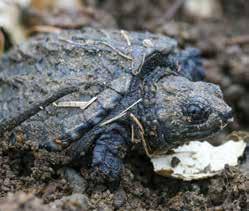
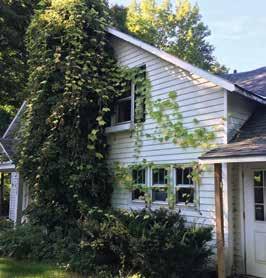
are both annuals; each plant lives only one growing season and new individuals in subsequent years must originate from a seed. And so life is all about becoming established and producing viable seeds in one growing season. Tere is no concern for establishing an extensive root system or woody tissue to support itself, or readying the plant to withstand the harsh conditions of winter.
A strategy that relies on establishing a new generation from seeds each year appears risky. It would seem that a few bad years of seed production or germination would afect the viability of the species. But somehow this strategy has worked for this and many other species for millions of years.
I hope one of the many seeds produced by this one-seeded bur cucumber grows up again next year, as I’d like to track its growth throughout summer and watch the pollinators return. —Mike White
FOR THE PAST THREE MONTHS , SNAPPING
TURTLE EGGS have been buried roughly fve to ten inches deep in sandy soil (depth depends on the size of the female laying them), absorbing heat from the sun-warmed soil. Come September, the relatively few snapping turtle eggs that have avoided predation are hatching. Te sex of the baby turtles correlates to the temperature of the clutch. Temperatures of 73 to 80 degrees will produce males; slightly above and below will produce both sexes; and more extreme temperatures will produce females. Te miniature snappers crawl their way up through the earth and head for the nearest pond, probably the most perilous journey of their lives. —Mary Holland
stories from & for the land 271 MARY HOLLAND
MIKE WHITE
Putnam’s Lightning Fruit Jars
Henry W. Putnam was born in 1825 in Boquet, New York – just across the lake from Charlotte. And after an adventurous early life, which featured traipsing through the jungles of Panama and selling bottled water to prospectors in Gold-Rush-era San Francisco, he randomly moved to Bennington – his wife’s sister had married a man who lived there.
He came to love the place, though. And over the next 35 years, he created an industrial empire in town. One of the products he became known for were Lightning Fruit Jars, more commonly known


as canning jars today. Putnam “invented” the jar by buying the rights to a bottle stopper that was patented by Charles de Quillfeldt and then applying it to fruit jars.
Of course, everybody canned back then, and the jars were a hit. Te glass lids prevented food contact with metal, which made them safer; the lids were also much easier to seal and remove than those on the popular jars of the day. Lightning jars were soon being produced around the country, and Putnam got a cut of everything. Te term “white lightning,” applied to moonshine during the Prohibition era, might take the “lightning” part of its name from the jars, in which the shine was commonly sold. Variations of the glass lid and wire-bale scheme of the Lightning jar were produced for home canning into the 1960s
Between the money he made on canning jar patents and myriad other successful business ventures (his factories produced mop wringers, tacks, and barbed wire, among other things), Putnam died a very wealthy man. And in the spirit of philanthropy that was something of an expectation among the very wealthy back then, Putnam and his heirs gave generously to Bennington. Tey established the hospital, which remains the only hospital in southwestern Vermont, gave Bennington its water system, funded a fre department, and built a magnifcent opera house and hotel on the downtown four corners. His stepson built the mansion/castle that became home to the recently defunct Southern Vermont College.
Te canning jars you flled with applesauce or sauerkraut or cannabis fower this September were probably modern Balls or Masons. But it’s still cool to remember the Vermont entrepreneur whose name is indelibly linked to the endeavor, and the good his fortune begot. —Dave Mance III
272 vermont almanac | volume 1 v september AT HOME •
Henry W. Putnam
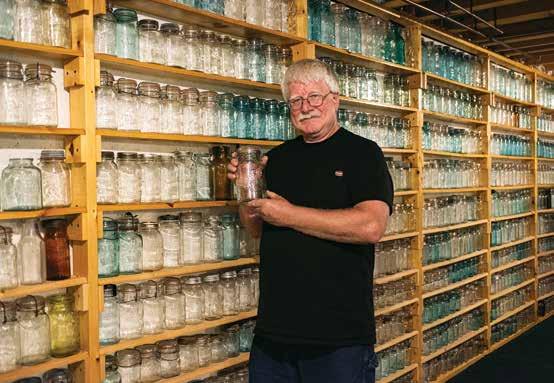
How Much is that Jar Worth?
Canning jar collecting is pretty huge among a certain subset of people – the rarest of the rare jars sell for more than $20,000. And we don’t know of a better collection than the one Bill Funk has in his basement in Chelsea. Funk has been collecting jars for over 30 years and now has about 1,300 of them, no two alike. Ninety-nine percent of these he acquired at yard sales, antique shops, and fea markets around Vermont.
If you’re interested in learning more about the value of the old jars in your basement, Funk suggests consulting the “Red Book” – he calls it the Bible of jar collectors. Te book, which
is self published by Douglas M. Leybourne, Jr., from North Muskegon, Michigan, is continuously updated. We have Volume 12 and it’s almost 500 pages long. But be aware that it’s hard for a layperson to decode the all important color of some jars.
Te jar on the previous page is light blue – in early glass making there was no standardization, so a range of colors were produced naturally based on the sands and alkalis used in the glass-making process. Tere are bubbles in the glass, and a pontil scar on the bottom, which indicates it was handmade. When we fipped through to the Lightning Jar
section (there are more than 150 entries), we were able to narrow it down to a handful of possibilities. But is the color “aqua?” Or “cornfower blue?” Te diference in those prices on certain models is the diference between a $10$15 range and $350-$500
Tere is no ofcial color standardization, so it all comes down to a potential buyer’s eye and the potential holes in his or her collection. As Leybourne points out in his book, “you, the reader and collector, will determine what color a jar is.” Which is to say that the jar’s ultimate worth is determined by what a buyer is willing to pay for it.
stories from & for the land 273
Bill Funk of Chelsea with his impressive canning jar collection.
JOHN
DOUGLAS
So You Want To Try Your Hand At Growing Cannabis . . .
I WANT TO TRY GROWING CANNABIS –WHAT DO I HAVE TO KNOW TO BE LEGAL ?
Currently, adults 21 years of age or older can possess one ounce of marijuana and can grow two mature and four immature plants on private property. “Mature” is usually interpreted to mean “in fower.”
HOW MUCH WILL EACH PLANT YIELD ?
Industry specs suggest that one well-grown plant will yield between 600 and 750 grams of fower buds.
THAT ’ S WAY MORE THAN ONE OUNCE . Yes, yes it is. Te reality seems to be that if you get pulled over and there’s cannabis in your car, it needs to be less than an ounce. But no one is going to check your pantry to weigh home-grown fowers. Our attempts to clarify this with Vermont’s Cannabis Control Board were unsuccessful.
CAN I SELL THE SURPLUS ?
No. But you can give it away. Or trade it away. Rural parts of Vermont are awash in legal, homegrown cannabis. It’ll be interesting to see what this does to the regulated market.
I DID SOME CURSORY RESEARCH AND IT SEEMS LIKE THERE ARE DOZENS OF VARIETIES . WHAT KIND OF PLANT SHOULD A BEGINNER GROW ?
We asked Janet Currie, owner of Vermont Cannabis Products, and she said that a big consideration is timing. Indica varieties are bushy – they look like fat Christmas trees – and mature in 7 to 9 weeks. Tis makes it especially amenable to growing outdoors in our short Vermont summer. Sativas are tall and spindly and generally take 8 to 12 weeks – if you’re going to grow them outdoors, plan accordingly.
IS THERE A DIFFERENCE OTHERWISE BETWEEN SATIVA AND INDICA ?
Conventional wisdom holds that sativa is a heady strain; regular users equate it with daytime use, creativity, and focus. Indica produces a body high
– the old stoner joke is that it puts you in-to-the couch. It’s more nighttime in nature, used for relaxation and to treat insomnia and body pain. Most of the strains of cannabis being grown today are hybrids with both sativa and indica strains in their lineage, but professional growers will know the percentage of each in a plant.
WHERE DO I BUY SEEDS OR PLANTS ?
Seeds are readily available online. Plants (or “clones” in industry parlance, because they’re produced from cuttings) are harder to fnd because legalization is still in its infancy, but soon you’ll be able to buy them in cannabis-related retail stores statewide.
WHAT DO I NEED TO KNOW TO GROW IT ?
Te plants are dioecious, meaning that there are separate male and female plants. If you’re after THC, you want female plants. If you grow a random seed you have a 50:50 chance, so grow a bunch and then cull the males. (You can also buy feminized seeds, which hedges your bet.) When the plants are between 3 and 6 weeks old they’ll begin to reveal their sex – males will develop pollen sacs, which look like seeds. Females will develop pistils, which look like little white hairs.
Once your female plants are up and running, treat them like you would a tomato plant. It’s true that cannabis is tough and can tolerate a variety of conditions, but if you’re going to go through the trouble of growing it, why not provide it with the best growing conditions? Well-drained loam that’s rich in organic matter and has a pH between 6 and 7 is ideal. Stake the plant when it gets big, as many varieties have a tendency to blow over. Don’t be afraid to visit grow/hydroponic stores and ask questions. If you get strange spots on the leaves, there’s a good chance a grow store will have a solution. “Growing cannabis isn’t a secret anymore,” said Currie. “In fact, it has become a wonderful way to connect with all sorts of people.”
Knowing when it’s ready is kind of tricky. As the plant nears maturity, study the trichomes. During
274 vermont almanac | volume 1 v september •
the growing season they’ll be clear. When the plant is mature, they’ll be milky. Tey’ll start to turn brown when they’re over-mature.
Dry the plants like you’d dry herbs, which is to say in a reasonably dark place with good airfow. Ideally the temp will be between 65 and 75 degrees and the humidity level will be between 55 and 65 percent. Most people dry whole branches and then cut of and trim the buds, which contain the lion’s share of the THC. Store your dry buds in a clean mason jar and burp them occasionally. It’s a good idea to add humidity packs.
CALL ME PRUDISH , BUT I ’ M STILL A LITTLE NERVOUS ABOUT TRYING CANNABIS . HOW DO I DO IT SAFELY ?
Be sure to harvest it, cure it, and dry it properly. Te buds can become moldy, otherwise, which is unhealthy. And, as with anything, partake in
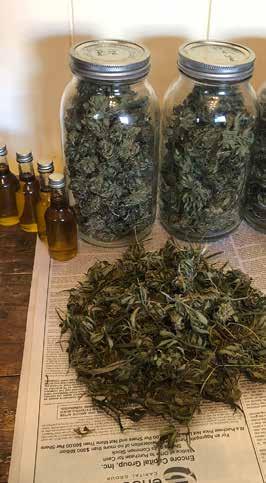
moderation. Modern cannabis hybrids are very potent. As a point of comparison, the marijuana you accidentally inhaled at a Grateful Dead show in 1968 might have been 2 to 4 percent THC; a recreational strain today might average well above 20 percent, some even top 30 percent. Edibles can be especially hazardous, as there’s a lag time between ingestion and when the efects are felt.
SO TODAY ’ S CANNABIS IS HIGHER IN THC THAN IT WAS BACK IN THE 1960 S ?
It’s probably more accurate to say that there’s more high-THC cannabis available today than in the past. Back in the day, given its illegality, marijuana was generally difcult to come by and quality and potency were often quite poor. Te scenes in movies where shady-looking drug dealers were flling plastic baggies with ground up leaves, seeds, maybe some oregano, maybe some lead shavings to increase weight, were in many cases pretty accurate. Occasionally, high-quality and potent marijuana would surface: strains such as Acapulco Gold, Tai Stick (brought home by American soldiers returning from Vietnam) and early forms of sinsemilla (seedless fower) were likely as potent as what’s available today.
ROLLING A JOINT FEELS A LITTLE REGRESSIVE AS AN ADULT ; PLUS I DON ’ T RELISH THE IDEA OF INHALING SMOKE . WHAT ARE MY OPTIONS ?
It’s relatively easy to infuse cannabis in oil or alcohol and take it as a supplement by the dropperfull; you can also use the oil in cooking and passively ingest it that way. Break up some cannabis fowers, put them on a lined baking tray, and heat them at 240 degrees for a half hour or so. (A more elegant and less pungent technique would be to seal and heat them in an immersion circulator if you have one of those.) Cool and grind the batch, then add it to an oil of your choice. Olive oil or coconut oil are two popular mediums. A ratio of 3 5 grams of cannabis to ½ cup of oil is a reasonable starting point. Heat the mixture in a double boiler on the stovetop for 4 to 6 hours, being sure the oil never gets above 240 degrees. Strain it, cool it, and it’s ready to use. Remember to not overdo it. Start by ingesting a small amount and evaluate its efects, which might take 2 hours to kick in.
stories from & for the land 275
INDUSTRY
Cannabis in Vermont
HOW MARIJUANA BECAME LEGAL IN THE STATE
Editor’s Note: the words marijuana and cannabis are both used in this piece and refer to the same plant; see the sidebar “A Note on Names” to learn more.
Vermonters have long been among the highest per capita consumers of marijuana in the US.
Some attribute this to the infux of hippies and other radical youth “going up the country” in the late 1960s and 70s. When the hoped for social revolution failed to materialize, they turned to a more naturebased way of life, with marijuana as one key ingredient.
But decades of prohibition spurred by President Richard Nixon’s 1970 Controlled Substances Act and the subsequent War on Drugs, made cultivation and consumption a criminal ofense, sending many to prison with life-long criminal records, preventing
them from landing college loans, securing home mortgages, or joining the military. Reevaluation of marijuana, both its dangers and benefts, and the failed War on Drugs, started to grow in the 1990s, and so did the tide of normalcy – decriminalization, legalized medical marijuana, and adult use.
Like many states, Vermont went through more than two decades of slow progress on the way to full legalization. Medical marijuana was frst legalized in California (of course) in 1996, when voters passed the Compassionate Use Act. Vermont became the tenth state to legalize medical use of the plant on May 19,

276 vermont almanac | volume 1 v september
f
Vermontijuana Farmstead in Irasburg.
ELI HARRINGTON
2004, when Governor James Douglas allowed Senate Bill 76 to pass but withheld his signature. As a further sign of the trepidation that existed then, the frst medical dispensary didn’t open for another nine years.
Peter Shumlin, governor of Vermont from 20112017, promoted legal cannabis during his tenure. Possession of a small amount was decriminalized in 2013, and in the following years the state incrementally evolved its cannabis policies.
On January 22, 2018, cannabis consumption, that once-criminal pastime, became legal when Vermont passed House Bill 511. Governor Phil Scott allowed Vermont’s cannabis bill to become law without signing it, in part due to concerns over the lack of reliable methods for determining when drivers are operating under the infuence of marijuana, as a Breathalizer test does for alcohol.
Under the new 2018 rules, adults (21 years of age and above) could possess up to one ounce of cannabis and four grams of hashish. Only thing was, you couldn’t buy it or sell it in the state – there was no legal retail cannabis. You also couldn’t grow it, which was very strange in a state that is justly proud of its agricultural prowess.
A year and a half later, on July 1, 2019, home-grown
A NOTE ON NAMES
You’ll see that the words marijuana and cannabis are both used in this piece – they’re efectively synonyms. Cannabis is the plant’s genus name, which doubles as a common name. In most pre-1900 accounts, the plant was called cannabis and it was associated with medicine and textiles. Te slang term marijuana became common in the twentieth century, and the name change came with a perception change (or maybe the other way around), as people began associating the plant with intoxication and vice.
Te etymology of the word marijuana is mysterious. We know it came to America from Mexico, through often hysterical
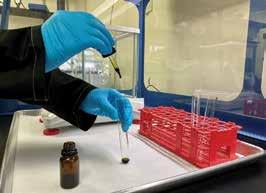
Testing for cannabinoids, terpenes, residual solvents, heavy metals, pesticides, mycotoxins, and microbials at Bia Diagnostics Laboratories in Colchester, one of only a few in-state cannabis testing facilities.
marijuana became legal. On private property, an individual could now legally cultivate two mature plants and four immature plants. In excess of this limit, a person would be subject to civil penalties. Tis law remains in efect today, though it appears virtually unenforceable. Te marijuana a homeowner grows can’t be sold but can be “gifted” to others without criminal penalty – another practice fraught with
prohibition-era headlines like: “Mexican, Crazed by Marihuana, Runs Amuck With Butcher Knife,” which ran in Te New York Times in 1925. But no one is really sure of the word’s lineage. Writer Matt Tompson researched the subject and reported that one theory holds that Chinese immigrants to western Mexico lent the name (the plant itself is Asian in origin); a combination of syllables in Chinese (ma ren hua) might have just become Spanishized into “marijuana.” But it might also have come from a colloquial Spanish way of saying “Chinese oregano” – mejorana (chino). Or maybe Angolan slaves brought to Brazil by the Portuguese carried with them the Bantu word for cannabis:
ma-kaña. Maybe the term simply originated in South America itself, as a portmanteau of the Spanish girl’s names Maria and Juana.
In any case, as we edited the piece, we stayed true to the word marijuana where it referred to the plant in a twentieth-century context. In a modern context, we used cannabis, as that word has less baggage and seems to be in more common usage today.
stories from & for the land 277
BIA DIAGNOSTICS LABORATORIES FACEBOOK
enforcement difculties.
In 2020, the Vermont Cannabis Control Board (CCB) was created and charged with creating the technical and legal framework for cannabis cultivation, administration of the state’s adult-use and medical cannabis programs, and regulation of hemp and CBD product manufacturing. According to its website, “ Te Cannabis Control Board is an independent Commission created within the Executive Branch to safely, equitably, and efectively implement and administrate the laws enabling adult use and medical use of cannabis in Vermont.” Seven “guiding priorities” underlie the regulatory mission of the board: social equity, the legacy market and small cultivators, energy, environment and land use, youth protection and education, consumer protection, medical program services, and public safety.
Te CCB launched the adult-use application process for cannabis licenses on April 1, 2022. Six license types are ofered: cultivators (indoors and outdoors), manufacturers, retailers, wholesalers, testing laboratories, and integrated licenses. Of these, cultivators and manufacturer licenses are broken down into multiple tiers. Te state has placed limits on the number of licenses any one business can hold, seeking to keep retailers and growers small and local.

Te vision is a niche market of small, innovative, and diverse growers and sellers – akin to craft beer breweries. Tere’s a special “social equity applicant” designation, which is designed to involve minorities, people from communities “disproportionately impacted by cannabis prohibition,” and people who were incarcerated for a past cannabis ofense. Te designation comes with discounted fees, low-interest loans, and fnancial support for training and education through Vermont State University’s Cannabis Studies Certifcate Program.
When it comes to retail cannabis sales, a Vermont city or town must opt in. Many communities opted in for adult-use cannabis retail sales or dispensaries –69 as of summer 2023 Te Cannabis Control Board
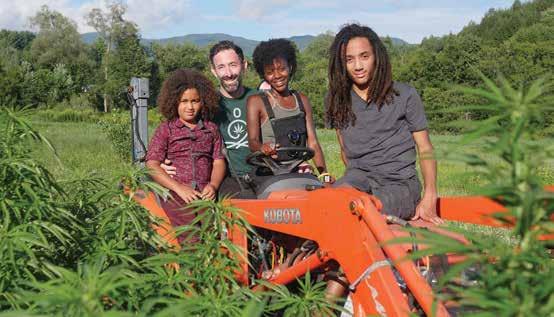
Noah and Marlena Fishman, along with their children, operate Zenbarn Farms in Waterbury Center. Te cultivation and retail operation has also launched the Cannabis Generation Equity Fund to help the BIPOC community gain access to the industry; learn more at zenbarnmj.com.
278 vermont almanac | volume 1 v september
A January 2023 meeting of the Cannabis Control Board.
ZENBARN FARMS
has recommended that cities and towns opting in on retail cannabis should receive 1 to 2 percent in share back funds from the state’s cannabis taxes. Te recommendation is expected to pass in the legislature, but it’s too early to tell how much tax income will be realized, overall or by each town. Te Control Board estimates that in 2025 alone retail sales in Vermont will be $244,313,908 – almost a quarter-billion dollars.
On Saturday, October 1, 2022, almost fve years after the passage of H. 511, Vermont became the eleventh state to allow retail marijuana sales. Cannabis dispensaries opened their doors that early fall morning to enthusiastic consumers eager to be among the frst to purchase legal cannabis (among other related products) in the Green Mountain State.
As of this writing, there are 56 retail dispensaries in the state, more than 300 small cultivators (25 of which are hemp cultivators), a few large growers (both indoor and outdoor), and dozens of processors and manufacturers. Testing remains a bottleneck – there are only three in-state testing laboratories – though the CCB is creating its own lab at Vermont Technical College to stem the backlog. Labs test the microbial parameters and limits for chemical and biological contaminants, including restricted pesticides, fertilizers, heavy metals, human pathogens, residual solvents, molds, fungi, and moisture content. THC potency is also measured for accuracy in product labeling.
To date, 24 states and the District of Columbia (and US territories Puerto Rico, Guam, the Northern Mariana Islands, and the US Virgin Islands) have some form of legal recreational (or “adult-use”) cannabis. Globally, countries that have legalized cannabis cultivation, sale, and consumption at the federal level include Uruguay, Canada, Georgia, Malta, Mexico, South Africa, Tailand, and Luxembourg. Dozens more have decriminalized cannabis and more than 40 countries allow for some form of legal medical cannabis.
Te legalization process for marijuana has been very slow, spanning decades. Yet it doesn’t seem that long ago that possession of even a small amount would get you thrown in jail. In some states, it still does. But the times, they are a-changin’, and it’s just a matter of time until the federal government legalizes marijuana at the national level, allowing open commerce, research and development, social equity, and the normalization and acceptance of this longmaligned plant. —Philip Lamy
THE CANNABIS ECONOMY
Leafy, a leading cannabis industry organization, reported that there were more than 400,000 fulltime jobs in the legal cannabis industry in 2022 – a number growing at an average of 280 new jobs daily. According to its “Jobs Report,” this marked the ffth consecutive year for jobs growth greater than 27 percent. So-called “plant-touching” jobs include cultivating, harvesting, processing, testing, retail sales, and jobs dealing directly with the plant. “Back ofce” jobs needed in all industries, including this one, such as accounting, legal services, compliance advisers, security, consulting, and construction, are also in demand. Indirectly, there are jobs in advertising and marketing, social media, public relations, packaging, and professional association management. According to Marijuana Moment, 2022 tax revenues from cannabis totaled $3 8 billion nationally. Market Watch, quoting a study by Te Marijuana Policy Project, reported that since 2014, when Colorado and Washington State initiated the adult-use market, state tax revenues from cannabis have reached $10.4 billion. Forbes (June 2021), citing New Frontier Data, detailed how the legal cannabis market in the US is expected to reach $43 billion by 2025. And a new analysis from the Congressional Budget Ofce projects marijuana legalization would generate $8 1 billion in tax revenue over a decade. Now the ffth most valuable crop in the United States behind corn, soybeans, hay, and wheat, the $6 2 billion (as of January 2022) wholesale value of cannabis topped that of cotton, rice, and peanuts.

stories from & for the land 279
Ceres Collaborative, a medical and recreational cannabis dispensary in Burlington.
GLENN RUSSELL
Navigating Vermont’s Legal Cannabis Marketplace
AN ORGANIC FARMER ’ S PERSPECTIVE
When recreational cannabis sales became legal last October, growers, consumers, and advocates celebrated. Many, myself included, saw an opportunity for Vermont to create a cannabis industry that prioritized small local growers and makers, advocated for ecological cultivation practices, and meaningfully addressed the historical oppression and violence cannabis criminalization has brought underrepresented communities. However, the rose-colored glasses were soon to come of Since 2018, my husband and I have operated a
diversifed hemp and medicinal herb farm on the Randolph-Brookfeld town line that sells hempderived CBD and herbal wellness products. In 2019, after weeks of preparation, our then four-acre farm received its organic certifcation with the support of Vermont Organic Farmers, the local USDAaccredited certifying body for Vermont’s agricultural producers. Organic certifcation is a north star for our enterprise. We are committed to regenerating and amplifying the biodiversity, soils, and natural resources that surround us. As a certifed farm, we are bound
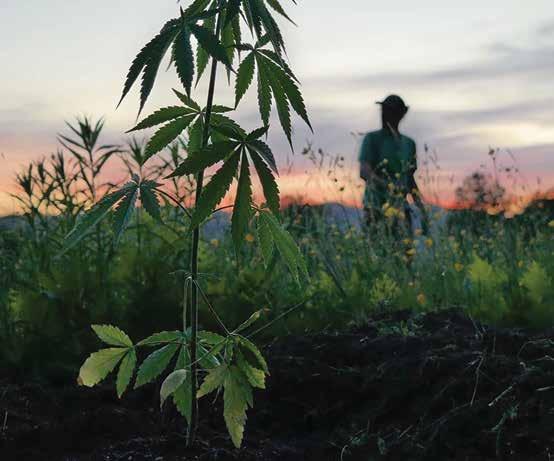
280 vermont almanac | volume 1 v september f
HILLSIDE BOTANICALS
Organic hemp growing at Hillside Botanicals.
by a legal defnition of accepted practices, standards, and requirements that are defned and enforced by the National Organic Program. Maintaining our certifcation requires rigorous oversight to ensure compliance; it includes annual on-site audits, as well as detailed record-keeping on all yields, inputs, and sales. It’s a signifcant investment of time, money, and energy; however, many certifed operations, like us, beneft from an increased level of value, consumer trust, and transparency.
Fast forward to early 2022. We, along with many energized growers, began the process for prequalifying as a regulated mixed-tier cannabis cultivator. After four years of running a fully compliant organic hemp operation, we felt we had the systems in place to navigate the new industry and successfully move from hemp to high-quality THC-rich cannabis. We knew the cultivation and processing requirements intimately because cannabis and hemp are the same exact species. We also knew that we would be able to grow a safe product, given our familiarity with growing hemp without synthetic inputs and pesticides. Our years of organic compliance had also prepared us for the array of reporting requirements, traceability and testing standards, and other compliance activities set forth by Vermont’s Cannabis Control Board (CCB). We entered the licensing process with a handful of questions and assumptions, but wrote a successful application, submitted the required materials, and received our pre-qualifed status.
In the meantime, another farm season began. Working with the organic certifcation agents and inspectors at Vermont Organic Farmers, we soon realized it would be impossible to participate in Vermont’s cannabis industry as a certifed organic farm without signifcant changes to our business.
When a farm begins the organic certifcation process, a producer must demonstrate that the land and soils intended for organic cultivation have been free of non-approved substances (fertilizers, pesticides, herbicides, fungicides, and other amendments) for at least three years. A land history afdavit is required, complete with records of any land management practices from current and past owners. Further, the producer must submit lists of any amendments, seeds, and other inputs used on the farm so that certifers can review them against a national list of approved and prohibited substances, which gets updated annually. Tis process ensures that no prohibited
substances commingle with organic crops or valueadded products. Strict requirements also apply to any spaces where organic crops or products are processed or stored post-harvest, which must be inspected during an annual audit.
How does this play into cannabis entering an organic farm? As a federally illegal substance, cannabis cannot be considered an approved input by national or local certifers. Trough a series of inquiries and conversations, we learned that if cannabis were to be introduced to any cultivation beds, processing spaces, or storage locations on our farm then we would fall out of compliance, thereby risking the organic certifcation we work hard to maintain and that defnes our farming practices. Even without changing any of the organic-approved inputs and methods we use, any cultivation beds in which the cannabis plant is introduced would no longer be viable as organic for at least the next three years. It would also require separate processing infrastructure to prevent commingling in our drying shed, where we dry and process the other organic herbs coming out of our felds. Needless to say, parceling out our limited cultivation areas, making infrastructure investments, such as constructing another drying building and storage space, and risking the organic certifcation for our other crops gave us pause. Further, it felt philosophically difcult for us to consider releasing our organic certifcation, as it’s something we are proud to uphold as a symbol of our commitment to growing in ecological partnership with the land.
As of this season, we are still proudly one of Vermont’s many organic farms. We have let go of our intentions to move into the regulated cannabis market for the time being. Tis was a difcult choice, especially considering the economic potential for our small organic farm. Yet, for us to uphold the integrity of our practices and beliefs, we feel it’s most efective to focus on supporting a movement that will help reclassify cannabis on the national level. Our hope for the future is that organic farms can someday bring cannabis into their enterprises without having to compromise their certifcations. Locally, we are still advocating for a market that centers small local growers and businesses, and we are fnding our own indirect ways to participate in the industry. Our favorite method to date? Leading workshops on how to grow cannabis with organic practices.
—Sarah A. Shaw
stories from & for the land 281
Is a Hemp Fiber Industry Possible in Vermont?
There’s a wealth of history in Vermont related to fber production, which is evidenced in the many shepherds, spinners, dyers, woolen mini-mills, and weaving schools that call our state home. It has not been easy for those of us who keep this cultural heritage alive, especially amidst the fallout from NAFTA and CAFTA – trade deals that efectively outsourced this work. But no one has had it harder than hemp producers and processors. As the state, and to a slower extent the country, reevaluates its relationship with Cannabis sativa, there’s hope that we can remember how to grow fne fber from the plant, in addition to the fowers, as was done for centuries before prohibition.
Over the last three growing seasons I have been working for the University of Vermont Extension program growing hemp for fber on our research farm. Prior to my joining the team, hemp fber was grown but never processed. It was as if we were growing apples but never tasting them: how would we know if we had a quality product if we weren’t sampling the yield?
Fast forward three years, and three sets of mandated fngerprints and background checks later, and our fber knowledge has grown by leaps and bounds. Tis year we received a USDA CARE grant to increase our fber program from one trial to fve. Now we’re researching everything from varieties, to seeding rates, to harvest dates, to multi-year crop rotations. Woven prototypes made from each years’ crop serve as a testament to the strides that have been made in our agronomic practices from one season to the next – they get better and better. Many folks from both inside and outside of the region have contacted me for samples, and, given that I’m doing the fber extraction myself, with just my hands, I haven’t been able to keep up with the demand. Recently, our fber was evaluated for quality at the NC State Wilson College of Textiles, and of the fve highest-scoring domestic hemp samples, two of them were ours. We know we have the potential for a viable, thriving industry in our region, and several stakeholders have been identifed, but processing equipment beyond
centuries-old hand tools simply do not exist in our region. In fact, there is no set of machines that takes the plants from stalks to long staple yarn in the entire western hemisphere, a veiled opportunity that could be serving countless industries nationwide.
 Te UVM Extension research farm.
Te UVM Extension research farm.
282 vermont almanac | volume 1 v september f
Te climate of Vermont is ideal for growing hemp, even in the face of a changing climate. All bast fbers (fax, hemp, jute, nettle, etc.) must undergo a retting process after harvest. Tis occurs in mid-August; a time of year when we are very likely to have the necessary humidity, dew, and rainfall, while other areas of the country are experiencing drought or even wildfres. But with all I now know about growing hemp fber, I can’t in good faith ask farmers to take the risk of growing it until we have infrastructure in place so that stakeholders, consumers, and businesses


stories from & for the land 283
UVM EXTENSION
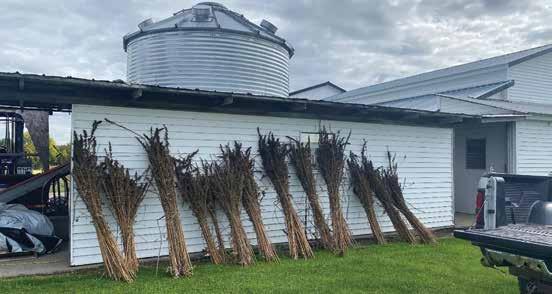
may pay growers appropriately for their hard work.
Perhaps by now it is becoming clear that we are in dire need of bast fber processing equipment in our region.
A hemp stalk is composed of two types of material: the bast fber, which is the outer layer (like bark) from which textiles and cordage are made. Te inner woody core is called the hurd. When processing bast fbers, the frst action is to separate the bast from the hurd. Tis can be done using a machine called a decorticator. Once we have this piece of equipment, we have clean hurd fber, which can be turned into myriad commodities, including pulp for paper, mulch, animal bedding, and a green building material
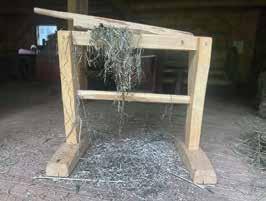
known as hempcrete, to name a few. Hempcrete is generally not structural like concrete, but it is carbon negative, incredibly fre resistant, and insulating. Tis is absolutely the best future building material for any areas at risk of wildfre – a torch can be held directly to it with your hand placed on the opposite side at no risk. (Don’t try this with concrete!) Local green builders in our region currently source their hurd fber from Europe, Canada, or the Midwest. I am often asked if I have any to spare.
Vermont could have a thriving, regionally scaled bast fber mill, that would serve both the state and the rest of northern New England. I envision that a processing mill would be able to fund itself in this stepby-step approach that would begin as a decortication facility and allow for growth over something like a 10-year time frame, with regionally grown textiles as the ultimate end goal.
One thing I’m sure of is that we will see the working landscape of our region shift to include more felds of hemp and fax rotated amongst the sprawling acreage of corn and soy within our lifetimes. If nothing else, inserting hemp into rotation felds would sequester more carbon than current conventional rotation crops, and clean the soil through bioremediation at the same time. Sometimes it feels as if everything around us is changing rapidly – except for us. Adopting hemp as a commodity crop is an essential adaptation in a changing climate. —Laura Sullivan
284 vermont almanac | volume 1 v september
Hemp on the fax break from the Old Stone House Museum in Brownington. Modern processing equipment is needed to create a viable hemp fber industry in Vermont.
Field-retted hemp bundles drying before storage.
Cannabis sativa has been cultivated for at least 14,000 years, making it one of the world’s oldest domesticated plants. And for most of that time, its fber was as important as its fowers. Colonial farmers started growing hemp in the 17th century, including in Vermont. Drafts of the Declaration of Independence, the US Constitution, the Bill of Rights, and Betsy Ross’ frst fags were all made of hemp. Te plant was used for twine, rope, clothing, rope-walks, even currency. As prohibition ends and we rediscover the plant’s potential, there’s a wealth of 21st-century products waiting to be made.
Janet Currie, of Orwell, has a hand in pretty much every facet of the state’s cannabis industry these days, but it’s the plant’s
Back to the Future
fber potential that makes her most excited. When we visited her 1830s farmhouse, she showed us hemp products – straws, utensils, cups, bowls, plates, and carryout containers – that are 100 percent compostable, part of a joint venture with a Hungarian company called Vilhemp USA. Currie sources the raw hemp fber that’s used to make the company’s resin granules.
She’s also a grower. Tis summer she partnered with Jef Sheldon and grew 100 acres of hemp fber in Fair Haven. Tey seeded with a no-till drill in May at a rate of 50,000 seeds per acre, and harvested in early August, about 70 days after planting. When we spoke, the plant material was at the old Proctor Marble Museum building in
Proctor, where she’s working with Travis Samuels, owner of Zion Growers, on processing. Bales of hemp average around 800 pounds in weight, and the hemp fber therein has a value of around 15 cents a pound. If grown properly, a farmer can expect 5 to 10 bales per acre.
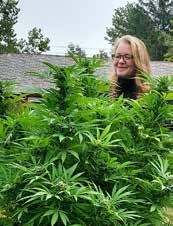

stories from & for the land 285
Te raw hemp stalk and fber in the center of the picture is used to make the products you see around it. Top right: Janet Currie.


286 vermont almanac | volume 1 v sponsor


stories from & for the land 287 sponsor
Casella’s Waste Systems 196-197
Cedar Circle Farm & Education Center 131
Champlain Valley Equipment 242
Charlie’s Cofee House 219
Co-operative Insurance Companies 287
Copeland Furniture 105
East Burke School 242
Goosewing Timberworks 175
JK Adams 82
Lodge at Taconic Ridge 264
Mance Maple 174
Meadows Bee Farm 287
North Branch Nature Center 37
North Country Organics 104
Onion River Press 286
Phoenix Bookstores 286
Preservation Trust of Vermont 36
Salvation Farms 131
Social House Restaurant 219
Sterling College 37
Stillwater Forestry 82
Union Underground GastroPub 219
Vermont Agriculture Department 130
Vermont Compost Company 83
Vermont Coverts 36
Vermont Evaporator 153
Vermont Fish & Wildlife Department 59
Vermont Maple Sugar Makers Association 152
Vermont Public 243
Vermont Renewable Fuels 265
Vermont Woodlands Association 104
Willing Hands 130
We’re immensely grateful to the above sponsors who help make this work happen.
Tanks to the Jack & Dorothy Byrne Foundation and the Vermont Arts Council for their supporting grants. Tanks, too, to the hundreds of people who have donated to the cause. Your generosity makes Vermont Almanac possible.

288 vermont almanac | volume 1 v sponsor index






































































































 BY
BY



































































































































































































































































































 Te UVM Extension research farm.
Te UVM Extension research farm.









